
10 Best Places to Visit in Nepal in Monsoon

Nepal is one of the finest natural abodes on the whole planet, and it is blessed with some of the best places to visit in the monsoon. It is famous for its diverse landscape and spectacular panoramas that attract trekkers, hikers, and adventure enthusiasts from across the globe.
Adventure lovers can spend their days exploring the various peaks and pass the time in serene and beautiful valleys. Many adventure sports are also offered here to make the monsoons more entertaining. Adventure lovers should not miss the chance to explore the various trails that circle the base of the Himalayas Mountains during monsoons.
Table of Contents
List of the Top 10 Places to Visit in Nepal in Monsoon:
1. trishuli river.

Trishuli River is a great place to visit if you love adventure and want to see the adventurous side of the Himalayas. The Trishuli river provides a fantastic opportunity for adventurers to see the incredible glacier while enjoying the natural beauty around this river.
The Trishuli river is one of Nepal’s most popular destinations for day trips, kayaking, rafting, and camping. It is a great place to visit. It originates through a forest valley. You can also make short weekend trips to this place, as it is only 3 to 3.5 hours away from Kathmandu. It offers a peaceful retreat from the hustle and bustle of the city.
From this natural wonder, you can see the Himalayan peaks and valleys. It’s also a great place to spend vacations with friends and family. You can enjoy various sports and activities during the monsoon months like hiking, trekking, and rafting. You can enjoy water sports and swim in the beautiful rivers and waterfalls.
Highlights : Renowned for its white-water rafting, the Trishuli River offers thrilling rapids and beautiful scenery.
Best Time to Visit : While rafting is generally best during the dry season, the monsoon can offer more challenging rapids for experienced rafters.
Tips : Ensure you book with reputable rafting companies that provide safety gear and experienced guides. Be prepared for higher water levels and stronger currents.
Activities : White-water rafting, kayaking, Mountain climbing, Fishing and camping by the riverside.
View the more most famous tourist places to see in Nepal
2. Kathmandu Valley

The best place to spend your monsoon vacations in Kathmandu is the valley. It is fun to visit the valleys of this stunning Himalayan region during the monsoon season. The region is home to many attractions and exciting places. There are many things you can do in the valley to make your visit memorable.
Kathmandu Valley is located in central Nepal. It also houses 7 of the 10 UNESCO World Heritage Sites, making it the best place to experience the monsoon in Nepal. You can experience many cultures, foods, monuments, and traditions while traveling to Kathmandu . The feeling of walking through Kathmandu’s wet streets is fantastic.
Read also: What to See in Nepal in October
Highlights : Home to UNESCO World Heritage Sites like Swayambhunath, Pashupatinath, and Boudhanath, along with vibrant markets and rich culture.
Best Time to Visit : Monsoon rains can be heavy, but mornings are often clear. The valley is lush and green during this time.
Tips : Carry an umbrella or raincoat, and plan visits to outdoor sites during early mornings. The rain can bring out the beauty of the temples and gardens.
Activities : Bungee jumping, Paragliding, Hot air Ballooning, Sightseeing, temple tours, shopping, and enjoying local cuisine.
More about Kathmandu Valley:
- 10 Popular Reasons to Visit Kathmandu
- 10 Most Famous Historical Monuments In Kathmandu
- Best Places to Enjoy Local and Street Shopping in Kathmandu
- ‘Maitri Bus Sewa’ service between Delhi and Kathmandu (Nepal) will resume shortly
- Air India Announced Weekly 3 Flights Between Delhi and Kathmandu

Pokhara is the perfect place to welcome people with an irresistible attraction. Trekkers, mountaineers, and adventure lovers will find this destination very special. Monsoon in the Himalayas is always appealing, no matter what season. It is a great time to take a vacation in the Himalayas.
It is a little bit cold season, but it is also excellent. Every moment of your Himalayan monsoon trip will be cherished. Pokhara has many unique places to visit. It is one of the most beautiful valleys within Nepal. This beautiful valley is located in the Kaski region in the western part of Nepal.
Pokhara is also called the “ City of Lakes “. There is much natural beauty, including caves, rivers, and waterfalls. The monsoon season is a great time to visit the city. The hills, mountains, and scenes become clearer after heavy monsoon rain and create a beautiful atmosphere.
Tourists love to trek in Pokhara during monsoons. They don’t want to miss the beautiful sunrise and sunset. Phewa Lake and Shanti Stupa are some of the most beautiful spots in Pokhara.
Highlights : Known for its stunning lakes, like Phewa Lake, and proximity to the Annapurna range, Pokhara is a gateway to many treks.
Best Time to Visit : Monsoon brings heavy rainfall, but the surrounding greenery and waterfalls are spectacular.
Tips : Enjoy boating on the lakes and visit caves and waterfalls, which are more vibrant during the monsoon.
Activities : Mountain biking, Boating, visiting Devi’s Fall, exploring Mahendra Cave, and paragliding on clear days.
Check out the top 9 reasons why you should Visit Pokhara

Lumbini is known as the birthplace of Gautam Buddha. It lies in the Rupandehi region in the western part of Nepal. Here, you can see the most beautiful monasteries that represent different Buddhist sects. It was built by Buddhist countries such as Thailand, Myanmar, and Vietnam.
Lumbini is also a world heritage site that UNESCO has listed. Tourists can enjoy the monsoon greenery of Lumbini , even though it is a holy site. It will make your sightseeing tour more appealing. Lumbini has many famous attractions like Maya Devi Temple, Eternal Peace Flame, Tilaurakot, and Ashoka Pillar.
Highlights : The birthplace of Lord Buddha, Lumbini is a spiritual site with monasteries, the Maya Devi Temple, and serene gardens.
Best Time to Visit : Monsoon makes the gardens and monasteries more lush and peaceful.
Tips : Wear light, breathable clothing and waterproof footwear. Early morning and late afternoon visits are recommended to avoid the heat.
Activities : Explore monasteries, Rent a bicycle, Pilgrimage tours, meditation, and exploring the Lumbini Development Zone.
Find out the 10 Most Popular UNESCO Heritage Sites in Nepal
5. Khumbu Valley

The moment you start to visit Khumbu in monsoon, it will seem that the world is coming to an end, and that is precisely how it feels in the Khumbu Valley. It’s an exotic place where you can enjoy a serene atmosphere, verdant green valleys, picturesque mountains, and many other exciting things.
If you are an explorer and want to discover everything in detail in Khumbu valley, then the monsoon season is the right time. The valley is located in northeastern Nepal’s Solu-Khumbu district. It is home to Mt Everest as well as many other substantial Himalayan peaks.
There are numerous lodges in the valley. Some lodges were built by Sherpas, which act as guides and help foreign climbers and trekkers reach the summits. This region includes the famous Tengboche Buddhist monastery, Sagarmatha national park, and its buffer zone. It is one of the most popular and beautiful places in Nepal.
Highlights : Gateway to Everest Base Camp, the Khumbu Valley offers stunning mountain views and Sherpa culture.
Best Time to Visit : The monsoon season is off-peak for trekking, but the valley is less crowded and more serene.
Tips : Be prepared for wet and slippery trails. Ensure you have proper trekking gear and check for landslides or trail conditions.
Activities : Boat ride, Everest base camp trek, camping, Trekking, visiting monasteries, and experiencing Sherpa culture.
Read also the Top 5 Trekking Destinations in Nepal
6. Upper Mustang

You should be ready for the monsoons and Upper Mustang. It is one of the most sought trekking spots in the country. You will be able to discover the diverse flora, fauna, and landscapes of the Upper Mustang during the monsoon on your trip.
It will be a good idea to visit monsoons at low rainfall to enjoy the area’s natural beauty. You will enjoy an unforgettable time trekking in the Himalayas during your motorbike tour to the upper mustang in the monsoon. The Upper Mustang trip has been voted the best in Nepal.
You can find more diverse cultures here than in any other area of Nepal. It was once the ancient trade route between Nepalese and Tibetan. Before 1992 the visitors were not allowed to enter this ancient kingdom. This place is unique and remote, making it more mysterious than other places in Nepal.
However, Upper Mustang is often considered the desert of Nepal. Although it doesn’t rain in mustang, the rain shadow during the monsoon makes windless active. This allows for a more enjoyable trip and showcases the incredible beauty of nature.
Highlights : A rain-shadow region, Upper Mustang remains relatively dry during the monsoon. It offers unique landscapes, ancient caves, and Tibetan culture.
Best Time to Visit : Ideal for monsoon travel as it receives little rainfall.
Tips : Obtain the necessary permits in advance. Prepare for high-altitude conditions.
Activities : Trekking, Motorbike tour, Walkthrough Jomsom, Marpha, exploring ancient monasteries, and visiting the walled city of Lo Manthang.
Top 10 Reasons to Why You Should Visit Nepal Once in Lifetime
7. Annapurna Circuit

It is a land of beautiful valleys full of tempting attractions and well worth the effort. You can explore and visit beautiful destinations at the Annapurna circuit in the Himalayas. If you want to enjoy your holiday in a serene and beautiful environment, then you can visit the Annapurna circuit during the monsoon season.
The well-known trek among tourists is the Annapurna circuit trek. You will be able to see a diverse climate with a complex topography and stunning views of snow-capped mountains, waterfalls, and lush greenery on an Annapurna tour .
It is located in Nepal’s western mountainous region. You can also explore other fascinating cultures, traditions, and castes. In the lower regions of the region, you will find Hindu culture and Buddhists in higher areas.
Although there is less rain in the Annapurna, the tracks are still wet. You need to be aware of it. If you go on this trip in the monsoon, your eyes will be captivated by the natural beauty and breathtaking vistas.
Highlights : One of the world’s classic treks, the Annapurna Circuit offers diverse landscapes, from subtropical forests to alpine meadows.
Best Time to Visit : The monsoon brings fewer trekkers and lush greenery, but trails can be slippery and some parts prone to landslides.
Tips : Use local guides who are familiar with the monsoon conditions. Ensure you have waterproof gear.
Activities : Annapurna circuit trek, Mardi Himal trek, Ghachok trek, Trekking, hot spring baths in Tatopani, and exploring remote villages.
10 Interesting Facts About Boudhanath Stupa, Nepal

Many tourists flock to Chitwan for the stunning scenery and picturesque views, especially during monsoons. You will find both serene and picturesque places to visit here. You can trek here during monsoons to discover the hidden regions of this scenic paradise.
Chitwan is located at a distance of 150km in the southwest of Kathmandu. There are many popular attractions in Chitwan. Chitwan National Park is UNESCO’s natural World Heritage Site. It is Chitwan’s most popular spot. It also contains other attractions like Ranipokhari lake, Jalbire waterfall, and Shiraiculi hill.
Chitwan National Park is home to rhinos, musk, and spotted deers, as well as monkeys. There are 68 species of mammals in the park and 544 varieties of birds. Monsoon is the best season to see peacocks dancing and other animals moving about.
Highlights : Chitwan National Park is famous for its wildlife, including rhinos, tigers, and elephants.
Best Time to Visit : Monsoon brings lush greenery and more active wildlife, but some parts of the park may be flooded.
Tips : Choose accommodations that offer guided safaris. Wear insect repellent and light clothing.
Activities : Elephant ride, Cultural programs by Tharu communities, Jungle safaris, bird watching, and canoeing.
Suggested the packages for Chitwan National Park

Monsoon is a moderate climate for all seasons. It is ideal for trekking, mountaineering, and trekking tours. Dolpa is one of the most popular trekking routes in the state. Dolpa was an area under British rule in the past. However, it was merged with Nepal after independence.
It is now a part of Nepal. The view of Phoksundo Lake and the mountains Sisne, Dhaulagiri make it a beautiful landscape during the monsoon. Due to the difficult transport and complicated geography, Dolpa trips can be more adventurous than other places.
Everybody who has been on a Dolpo tour has admired the beauty of the area and praised it. There are many cultures, ethnicities, and castes that you can visit as well as fascinating places.
Highlights : Remote and rugged, Dolpa is home to the stunning Shey Phoksundo Lake and unique Tibetan culture.
Best Time to Visit : Monsoon makes access challenging, but the region’s rain-shadow areas remain accessible.
Tips : Prepare for remote trekking with proper gear and supplies. Local guides are essential.
Activities : Putha Hiunchuli trek, visit upper Dolpa, Trekking, visiting monasteries, and exploring Shey Phoksundo National Park.
10 Most Popular Monasteries in Nepal
10. Bandipur

Bandipur is located in western Nepal’s Tanahun region. It is a beautiful place to visit in Nepal during the monsoon. It is made up of old-fashioned houses that were converted into restaurants. There are also temples and beautiful views of green hills, forests, and impressive valleys.
Monsoons bring spectacular sunsets and sunrises. The trekking trails on hills can become slippery after a heavy monsoon, but the views are still beautiful. You can also take part in adventure sports such as paragliding or hiking during the monsoon. The joy of walking through streets lined with traditional buildings and foundations is a way to feel like you are in an old city.
Highlights : A picturesque hilltop town, Bandipur offers panoramic mountain views, traditional Newari architecture, and tranquil ambiance.
Best Time to Visit : Monsoon enhances the natural beauty with lush greenery and clear post-rain views.
Tips : Enjoy morning and evening walks to avoid daytime showers. Explore local markets and temples.
Activities : Sightseeing, Hiking, Paragliding, Trekking, and cultural tours.
Conclusion:
The beautiful mountain and lush green valleys make it an ideal place for trekking and photography. You can also enjoy some adventurous sports in this pleasant environment. The hotels and restaurants are situated mainly nearby the streams and rivers, which provide you with a memorable experience of your tour in Nepal .
Find the below tour packages and book Nepal tour at best price with Tusk Travel:
- Mount Everest Sightseeing Flight in Nepa
- 3 Nights 4 Days Nepal Package
- 4 Days Kathmandu Tour Package
- 4 Nights 5 Days Nepal Tour Itinerary
- 5 Nights 6 Days Nepal Tour
- North India With Nepal Tour
- 8 to 10 Days Nepal Tour
- 18 Days Rajasthan and Nepal Tour
- India Nepal Wildlife Tour
Frequently Asked Questions:
1. What are the 10 naturally beautiful places in Nepal?
Some of the naturally beautiful places in Nepal are Pokhara, Lumbini, Annapurna Region, Chitwan National Park, Rara Lake, Langtang Valley, Gosaikunda, Mustang, Sagarmatha National Park, and Manang.
2. Which is the most beautiful place in Nepal?
Pokhara is often considered the most beautiful place in Nepal due to its stunning lakes, mountain views, and serene environment.
3. What are the best places to visit in Nepal during the monsoon season?
The best places to visit during the monsoon season in Nepal include Pokhara, Chitwan National Park, Lumbini, and the Kathmandu Valley.
4. What is the best place to travel in the monsoon season in Nepal?
Pokhara is one of the best places to travel during the monsoon season in Nepal due to its beautiful lakes and waterfalls, which are especially vibrant during this time.
5. What is the coolest place in Nepal?
The coolest place in Nepal is often considered to be the higher altitude regions like Everest Base Camp and Annapurna Base Camp, where temperatures remain low even during the summer.
6. What is the hottest place in Nepal?
The hottest place in Nepal is the Terai region, particularly areas like Biratnagar and Janakpur, which experience high temperatures during the summer months.
7. Which place receives the most rainfall in Nepal?
Pokhara receives the most rainfall in Nepal, making it very lush and green, especially during the monsoon season.
8. What is the best climate in Nepal?
The best climate in Nepal is found in the hill regions, like Kathmandu and Pokhara, where the temperatures are moderate and pleasant throughout the year.
9. When does the monsoon season start in Nepal?
The monsoon season in Nepal typically starts in June and lasts until September.
10. Which is the most visited place in Nepal?
Kathmandu is the most visited place in Nepal, known for its rich cultural heritage and historic sites.
11. What are the famous tourist places in Nepal during the rainy season?
Famous tourist places during the rainy season include Chitwan National Park for wildlife viewing and Pokhara for its lush landscapes and waterfalls.
12. What are some beautiful scenes in Nepal?
Beautiful scenes in Nepal can be found at places like the sunrise view from Sarangkot in Pokhara, the terraced fields of Bhaktapur, and the tranquil Rara Lake.
13. Which is the best place to visit in Nepal for couples?
Pokhara is an ideal destination for couples due to its romantic lakeside settings and scenic views.
14. What are the best places to visit near Kathmandu during the monsoon?
Near Kathmandu, places like Nagarkot and Dhulikhel are great for monsoon visits, offering panoramic views of the Himalayas and lush green hills.
15. Is Nepal good to visit during the monsoon season?
Yes, Nepal is good to visit during the monsoon season for those who enjoy lush landscapes, fewer crowds, and a quieter experience in nature.
About The Author
Tusk Travel Team
Related posts.

7 Best Religious Places to Visit in Nepal

The Currency of Nepal (Traveler tips for Money Exchange)
Leave a comment cancel reply.
Your email address will not be published. Required fields are marked *
Save my name, email, and website in this browser for the next time I comment.
Travelling Mandala
Monsoon Season in Nepal: Weather and 13 Best Things to Do

Are you wondering what monsoon season in Nepal is like?
You’ve come to the right place as I live in Nepal and have spent a couple of monsoon seasons in Nepal before. So, if you are wondering if it’s worth visiting Nepal during the monsoon season, here is everything you need to know!
Monsoon (June-August) is the off season in Nepal but there are still many things you can do. It is not the best time for trekking but you can immerse yourself in the art, architecture, food and visit lots of attractions the country has to offer.
Some of the best places to visit in Nepal in monsoon are cities and towns. Kathmandu, Pokhara, Bandipur, Tansen and Janakpur are some of the best places to visit during monsoon.
Here is all the information on how to prepare for travelling in Nepal and activities you can do during the monsoon season in Nepal!
When is Monsoon Season in Nepal
The monsoon season typically runs between June-August, however, it can start earlier/later and end in mid-September too.
The weather patterns are slightly unpredictable each year, thus, the monsoon can start earlier or be delayed. Recently, the monsoon lasted even until the end of September, so it is good to check the current weather news.
Nepal Temperature in Monsoon
The temperature in Nepal during monsoon is very hot and humid. The weather forecast may say it’s 30-35 Celsius degrees but due to the humidity, it feels much hotter.
It is especially true in the Tarai Region of Nepal (in the southern part of the country, close to the border with India), that gets the hottest and most humid temperatures.
Does it Rain All Day During the Monsoon Season in Nepal?
No, it does not rain all day during the monsoon season in Nepal. Usually, it only rains for 1-2 hours in the afternoon or evening and the rest of the day is hot and humid.
Pokhara is one of the places in Nepal that receives the highest level of rainfall, so if you travel to Pokhara, you are likely to experience more rainfall.
What to Pack for Travelling During Monsoon Season in Nepal
- Waterproof shoes
- Light rain jacket
- Light clothes (as it will be hot and humid)
- Sleeping bag
- Nalgene water bottle
- Lifestraw water bottle
Best Things to Do During the Monsoon Season in Nepal
1. trek in the rain shadow region of nepal: mustang.
Mustang is in the rain shadow region of Nepal, this means that it does not (or rains less) here during monsoon. Jomsom in Lower Mustang can be reached by bus from Pokhara. From Jomsom, you can go on day hikes to other nearby villages such as Muktinath, Marpha or Kagbeni.
You should still check the weather forecast and be careful about travelling to Lower Mustang. For example, in 2023 Kagbeni (one of the villages in Lower Mustang) got flooded from all the rainfall. So even though Lower Mustang is in the rain shadow, the weather patterns can still be unpredictable.
2. Explore the UNESCO World Heritage Sites in Kathmandu

There are 7 World Heritage Sites in the Kathmandu Valley including Buddhist stupas, Hindu temples and three Durbar Squares (“royal palace squares”) that used to be buildings of the royal family.
The heritage sites are: Kathmandu Durbar Square, Patan Durbar Square, Bhaktapur Durbar Square, Boudha Stupa, Pashupatinath Temple, Swoyambhu Stupa and Changu Narayan Temple.
🌧️ Check out the best rainy day activities in Kathmandu here!
The world heritage sites offer a glimpse into the history and architecture of Nepal. The Bhaktapur Durbar Square is also referred to as a “living museum” as you can see how the temples and old palace buildings have integrated into everyday life.
3. Explore Cities and Towns in Nepal
Apart from Kathmandu, there are many other cities to explore in Nepal. The weather may not be the best and you will not get clear views of the Himalayas but there are still lots of activities to do.
3.1 Tansen (Palpa)

They say the weather is pleasant all year round in Tansen! It does not get too hot during the monsoon and does not get too cold during winter. So it is an ideal place to visit during the rainy season in Nepal.
- Main attractions in Tansen (Palpa): Rani Mahal (the “Taj Mahal of Nepal”), Shreenagar Hill and Tansen View Tower, Tansen Durbar and Museum, and Palpali food.
Check out my travel guide to Tansen here!
3.2 Bandipur

Bandipur is a charming little town where you can see beautifully preserved Newari architecture. It has chill, outdoor cafes and restaurants, which make it feel like you are in France or Belgium.
- Main attractions in Bandipur: Thani Mai Temple, Siddha Gufa (the biggest cave in Nepal), Bandipur to Ramkot hike , cafes and restaurants .
Check out my travel guide to Bandipur here!

Gorkha is known as the place where the former King of Gorkha, Prithvi Narayan Shah is from.
Prithvi Narayan Shah is significant in Nepali history as he was the king that started the unification of various kingdom into one unified Nepal (in the 1760s). Gorkha is also where the Gurkha soldiers originate from.
Gorkha can be reached in about 5-6 hours from Kathmandu and it is less visited by tourists. Although it is likely to be cloudy during the monsoon, if the weather is clear, you have beautiful views of the Himalayas from the Gorkha Durbar.
- Main attractions in Gorkha: Gorkha Durbar and Gorkha Museum, sunrise and sunset views
Check out my travel guide to Gorkha here!
3.4 Janakpur

Janakpur is famous for Mithila art paintings and its Hindu temples, such as the Janaki Temple (Janaki Mandir).
Janakpur is located in the south of Nepal, so it is very hot and humid during monsoon. Nevertheless, the main attractions can be covered in one day and it is a good place to visit during monsoon.
- Main attractions: Janaki Temple, Mithila paintings, Indian street food and sweets.
Check out my travel guide to Janakpur here!
3.5 Pokhara

Although Pokhara is one of the places in Nepal that gets the highest level of rainfall during monsoon, if you are visiting Nepal, you should not miss out on Pokhara.
Pokhara is one of the most popular tourist destinations in Nepal and there are so many things to do, even if you don’t go trekking or hiking.
- Main attractions: World Peace Pagoda, boating, hiking, Annapurna Cable Car to Sarangkot , museums , Davis Falls, caves .
Check out my travel guide to Pokhara + 🌧️ best rainy day activities in Pokhara here!
4. Chill in Chitwan and Spot Rhinos by the Riverside

Chitwan is a popular place in Nepal for jungle safaris and wildlife spotting . However, the rainy season is not really a good time to go on jungle safaris . This is due to that the grass grows very tall from all the rain. Thus, it is very difficult to spot any wildlife inside the national park at this time.
Sometimes they even stop the jungle safaris for a few weeks during the monsoon because the trails become impassable due to all the rain. So if you visit Chitwan in July which has tends to have the highest rainfall, be prepared that you may not be able to go on a safari.
However, Sauraha (the main tourist town in Chitwan) is located by the Rapti River where many rhinos and elephants come to drink and cool down during the heat of the monsoon. Thus, you have the biggest chance of seeing wildlife by the riverside during the monsoon.
Sauraha is a chill, relaxing town with lots of restaurants and cafes. They have also built hotels and restaurants by the riverside, so you can just chill there and possibly spot wildlife.
Check out my travel guide to Chitwan here!
5. Learn to Cook Nepali Dishes

Immerse yourself in Nepali culture and learn to cook some Nepali dishes!
Some of the most popular Nepali dishes include dal bhat and momo which you will find in plenty of restaurants to try first. Both dishes come in veg and non-veg options, including buff meat which is the most popular type of meat in Nepal.
There are various cooking classes that you can sign up for. There is a cooking class on AirBnB Experience that I recommend. They hold the cooking lessons in Patan, so if you join for a morning cooking session, afterwards you can even check out the Patan Durbar Square.
The best part is that you get to eat everything you cook and you also get the recipes at the end. I even signed up my brother here for a class when he visited me and he loved it.
6. Go on a Cable Car Ride

Cable Cars are not the first thing that comes to mind when people think about Nepal. Surprisingly, there are a good number of cable cars in the country that are a great day trip activity.
Although, if you go on the cable cars during monsoon season, the views from the top will be cloudy and you will not see the mountains.
Still, the cable cars are a great option for an activity and usually, once you get to the top of the cable car, there are some other activities you can do apart from the mountain views.
- Chandragiri Cable Car (Day trip Kathmandu)
- Annapurna Cable Car to Sarangkot (Day trip from Pokhara)
- Manakamana Cable Car (Day trip from Kathmandu)
7. Check Out Museum Exhibitions

Is it raining and not sure what to do? Check out a museum exhibition and learn about the art and culture of Nepal!
Kathmandu has some really great museums that are perfect for a rainy day: Museum of Nepali Art, Narayanhiti Palace Museum, Aviation Museum, and the Music Museum of Nepal among others.
The museums in Pokhara are also a great place to learn about the history of mountaineering, and the history and culture of the Gandaki Province (where Pokhara and the Annapurna Range is located).
8. Learn to Make a Thangka Painting

Thangka paintings originate from 2,500 years ago and they are Tibetan Buddhist paintings. There are different types of thangkas that you can paint or buy, and each painting depicts a topic related to Buddhism. These can be an excerpt from Buddha’s life or mandalas used for meditations.
Most of the Thangka painting shops and schools are located in Bhaktapur and Patan. There are options to sign up for a day class or even longer ones (depending on how much time you have).
The teachers will help you select a painting of your choice that you can finish in the amount of time that you signed up for. I did a one day class in Bhaktapur at the Lama Thanka Painting School that I can recommend.
Check out what it’s like to take a Thangka Painting Class in Bhaktapur .
9. Take a Vipassana Meditation Course

Vipassana meditation is a form of Buddhist meditation.
The Dhamma Shringa Vipassana Meditation Centres can be found all around the world and they hold free 10-day vipassana courses frequently throughout the year. If you like meditation or interested to learn more about it, Nepal is a good place to give it a go.
The vipassana courses are completely free and you also get free accommodation and food throughout the course.
I must say, the vipassana meditation technique is very strict and you really have to motivate yourself to get through the 10-day course.
I somehow pushed myself through a 10-day course in 2023 and here you can read about my experience of what it’s like to take a vipassana meditation course in Nepal.
10. Chill at a Swimming Pool

The weather gets very hot and humid during the monsoon season in Nepal, so what’s better than chilling by the pool on a hot day?
It does not rain all day long in Nepal, so you can even go for an outdoor swimming pools on a sunny day.
There are also many indoor swimming pools, which can be an option in case it is raining. Some swimming pools in and around Thamel include: Aloft Hotel, Hotel Shanker, Mulberry Hotel.
11. Watch a Movie at the Movie Garden Pokhara

The Movie Garden is a chill place to watch movies in Pokhara. It is an outdoor cinema but they also have seats that are covered in case it rains. They play one movie in the evenings and it usually start around 7 pm. The place has a small bar so you can order drinks and snacks too.
12. Zen Out at a Singing Bowl Session
Tibetan singing bowls are a big thing in Nepal. There are many shops selling singing bowls and places where you can sign up for a session.
Many of the singing bowl schools also organize trainings where you can sign up and learn the ins and out of holding your own singing bowl session.
If you are interested to try a singing bowl sessions, there are 2 places in Kathmandu that offer free singing bowl sessions for those that are interested:
- FREE: Nepal Singing Bowls and Healing Centre : every day: 9:45 am, 4:30 pm
- DONATION-BASED: Nirvana Singing Bowl : every day: 10 am, 5 pm
13. Visit the Caves and Waterfalls in Pokhara
Pokhara has caves and waterfalls that are especially beautiful to visit during monsoon.
Generally, outside of monsoon season, there is not much rain so the water levels can be very low. However, during monsoon season the waterfalls and rivers get full of water and offer a much better experience.
Some of the places in Pokhara worth checking out is the Gupteshwor Mahadev Cave (it is a cave but there is a waterfall inside which gets full of water during monsoon), Davis Falls (it is a small waterfall that is otherwise not so spectacular outside of monsoon season) and the Seti River Gorge .
Reasons to Visit Nepal During the Monsoon Season
#1 less tourists.
People usually say that during monsoon season, the only foreigners you will find in Nepal are the ones that live here. Many times it is true, but you can still find the odd traveller here and there. So visiting Nepal during monsoon season is in a way more authentic.
- Con: On the other side, less tourists also mean less travellers to buddy up with. In case you are travelling solo and looking to make travel friends, it will be more difficult during this time.
#2 Lower Prices and Discounts
The monsoon season in Nepal constitutes as the low season when fewer tourists visit Nepal. Due to this, there will be many discounts in hotels and trekking gear shops.
As the hotels run at low capacity, booking ahead is not so crucial during this time. Check out booking.com for prices, or you can also just show up at the hotel and inquire about the prices.
#3 Apart from trekking, there are still many things to do!
Most people come to Nepal for trekking, however, trekking is not recommended during this time due to the rainfall and possible landslides.
Don’t worry, Nepal has so much to offer apart from trekking, so check out my list of the best things to do below.
Is it Safe to Trek During the Monsoon Season in Nepal?
Trekking is not advised during monsoon in Nepal due to the rain and landslides. During the rainy season in Nepal, there are also lots of leeches on the trail that make trekking or hiking very uncomfortable.
Check out Upper and Lower Mustang if you are keen to do some day hikes in Nepal. Mustang lies in the rain shadow region of Nepal, so it can be a recommended alternative where you can go on day treks/hikes during monsoon.
Festivals During the Monsoon Season in Nepal
Nepal is full of holidays and festivals all year long. However, there are the least number of festivals during the monsoon season.
Nepal follows a lunar calendar, meaning that the dates of holidays change every year – but more or less they fall around the same time/month.
The biggest Nepali holidays ( Dashain and Tihar ) are celebrated after the monsoon season ends.
🎆 Check the festival and holiday calendar for Nepal here!
Festivals in Nepal in June
Ropai festival.
The Ropai Festival celebrates the rice planting season in Nepal. It usually falls at the end of June. Most of the farmers finish the planting of the rice seeds by this time, and through the celebration, they wish for good rains for the rice seeds.
People play in the muddy rice fields on this day and if you are in the countryside during the Ropai Festival, you will see and may also be invited to join the festival.
Festivals in Nepal in July
The dates of holidays changes every year as Nepal uses the lunar calendar. Nevertheless, usually none of the holdays fall on a date in July.
Festivals in Nepal in August
August is a bit more lively when it comes to festivals. There are usually 2-3 festivals in August, depending on how the lunar calendar is each year.
Nag Panchami
‘Nag’ means snake in Nepali and so Nag Panchami is dedicated to snakes. On this day, devotees offer prayers to snakes in order to be protected from snake bites.
Janai Purnima
‘Janai’ is a sacred thread worn by Hindu men and during Janai Purnima they change this thread. The changing of the thread is believed to purify the person and protect from negative influences.
Gai Jatra is celebrated by a procession of people wearing masks and costumes. People who have lost family members in the past year join the procession. Depending on the lunar calendar, this festival can be in August or September.
The Teej festival is celebrated by women to pray for their husbands’ wellbeing. In Nepal, once the woman is married, they traditionally move in with their husbands. During Teej, women also return to their parents’ home to celebrate with their mom and sisters.
Depending on the lunar calendar, this festival can be in August or September.
Shree Krishna Janmashtami
Shree Krishna Janmashtami is dedicated to celebrating the birthday of Lord Krishna. Depending on the lunar calendar, this festival can be in August or September.
Bus Travel During Monsoon Season in Nepal
Travelling by bus during the monsoon season in Nepal can be a bit trickier. The buses still go as scheduled, however, there is a much bigger chance of landslides on the mountainous roads.
The landslides can cause long traffic and delays, so it is good to consider that the travel time might take even longer during this time of the year.
Where To Stay In Kathmandu
Looking for a place to stay in Kathmandu? Check out my top recommendations for every budget:
📍Budget: Rest Up Hostel
📍Mid-Range Hotel: Bodhi Boutique Hotel
📍High-End Hotel: The Dwarika’s Hotel
Nepal: Month-by-Month
Not sure about when to visit Nepal? Check out my month-by-month guide for Nepal:
- Nepal in January
- Nepal in February
- Nepal in March
- Nepal in April
- Nepal in May
- Nepal in June
- Nepal in July
- Nepal in August
- Nepal in September
- Nepal in October
- Nepal in November
- Nepal in December
Nepal: Seasons
Want to know more about visiting Nepal during different seasons? Check out my seasonal guides to Nepal:
- Spring Season in Nepal
- Monsoon Season in Nepal
- Autumn Season in Nepal
- Winter Season in Nepal
FAQs: Monsoon Season in Nepal
When is the monsoon season in nepal.
The monsoon season generally starts from June until September. However, due to changes in the weather patterns, it can still be unpredictable. For example, it can start earlier in May or in late June. The ending of monsoon is also not so fixed, it can be over at the end of August or be delayed until mid-September.
How often does it rain during the monsoon season in Nepal?
It actually does not rain as much as most people think. The mornings are usually clear and it rains a few hours in the afternoon. Kathmandu generally has much better during monsoon, with just a few hours of rain in the afternoon/evening. The weather in Pokhara is much worse and it rains much more.
Is it worth visiting Nepal during the monsoon season?
Yes, it is totally worth visiting. Although, trekking is not advised during this time, there are lots of other things you can do in Nepal during this time.
Can I go trekking during monsoon season in Nepal?
Trekking is not recommended during the monsoon season in Nepal. Due to the rainfall, there is a risk of landslide on the trails that make it unsafe to go trekking. In addition, the trails are full of leeches during this time which make it very uncomfortable to be trekking while trying to get rid of the leeches.
What are the best places to visit in Nepal in monsoon?
Trekking is not advised during monsoon season in Nepal, so the best activities are exploring the art and culture of Nepal by visiting its towns.
The monsoon season in Nepal typically runs from June to mid-September. The beginning of June is still not as rainy so it is still a good time to go trekking in Nepal.
July and August receive the highest rainfall and trekking during this time is not recommended due to the rainfall and possible landslides.
If monsoon is the only time that you can visit Nepal, don’t worry because there are still many things to do and places to explore.
The monsoon starts to come to an end in September, however, there can still be rainfall and cloudy skies. So, if you are planning to trek in Nepal it is better to plan it from the end of September onwards.
Nepal Trip Planning
Book your flight to Nepal: Check out Skyscanner or Kiwi.com to find the best flights deals! Book Your Accommodation for Nepal: Are you looking for accommodation? Booking.com has everything from budget to luxury accommodation. For the cheapest places, check out Hostelworld.com . Book Tours and Activities for Nepal: GetYourGuide and Viator have a vast number of tours and day trip activities all around the world. Check out their website and book your activity! Get Travel Insurance for Nepal: It is always good to be on the safe side when travelling. SafetyWing is one of the most affordable international travel insurance and you can book it even after you have already started your trip. Get Your Travel Cards: Whenever I am abroad, I always use travel cards Wise and Revolut . They have multiple currencies available, you can use it in shops and restaurants. The great thing is that they have the best exchange rates! Looking for other tips to make travel easier? Check out my complete list of travel resources that have been my go-to companies when abroad or planning a trip.
Nepal Quick Guide
Can i get a visa on arrival for nepal.
Yes! Almost all nationalities can get a ‘Visa on Arrival’ once landing at the Tribhuvan Airport in Kathmandu (check eligibility here ). Getting a Visa-on-Arrival for Nepal is quick and easy. Read here my full guide on getting a Visa on Arrival for Nepal .
Should I get a Nepali SIM card?
Yes! Once you arrive in Nepal, it is recommended to get a Nepali SIM card.
SIM cards in Nepal are cheap and easy to get. There are daily, weekly or monthly data plans – all at an affordable cost. For more information, check how to get a SIM card in Nepal here.
Are there any useful mobile apps I can use in Nepal?
Yes! There are a couple of mobile apps that come handy when travelling in Nepal, including taxi apps, offline maps for trekking, booking accommodation and travel cards.
Check out my list of the most useful mobile apps to have in Nepal .
Can I exchange money in Nepal? What about ATMs?
Yes! Thamel (where most tourists stay) has many money exchange shops as well as ATMs.
There is also a currency exchange shop at the airport but the rates are better in Thamel. Read here all about currency exchange and ATMs in Nepal .
Is it safe to travel by bus in Nepal?
The roads are dangerous but generally yes (best to travel by a tourist bus)!
I would say road travel in Nepal is generally dangerous due to the road conditions. The roads are narrow and go through mountainous areas. The tourist buses in Nepal have the best safety, so if possible, make sure to book tourist buses when travelling in Nepal.
Overall, the roads might look dangerous but the drivers are used to the road conditions in Nepal so the tourist buses are a safe choice. Here is everything you need to know about bus travel in Nepal .
Can I drink the tap water in Nepal?
No, you cannot drink the tap water in Nepal .
The tap water is unsafe for drinking in Nepal. It is not only foreign tourists that should not drink the tap water in Nepal, even Nepali people who were born and raised in Nepal do not drink the tap water .
Can I book bus tickets online in Nepal?
Yes! It is possible to book bus tickets online in Nepal however, I recommend it for those staying in Nepal for 3+ months.
It is not possible to book bus tickets online using an international bank card but only through registering on a Nepali digital payment app eSewa. If you are staying long-term in Nepal, read here my step-by-step guide on how to book bus tickets online using eSewa .
Do they speak English in Nepal?
You might wonder “ Do they speak English in Nepal? ” It depends on where in Nepal you are. In big cities (Kathmandu, Pokhara, Sauraha/Chitwan) or trekking routes (Annapurna, Everest) that have many tourists, you will easily get by speaking English.
If you are in remote Nepal where not many tourists go, people usually will have little or no English. Here is a quick list of useful Nepali phrases to know while travelling in Nepal .
Similar Posts

April in Nepal: Weather + 10 Best Places to Visit

Nepal in September: Weather + 4 Best Places to Visit

Autumn Season in Nepal: Weather, Trekking and 10 Best Places to Visit

Rainy Season in Pokhara: 10 Best Rainy Day Activities

Nepal in November: Weather + 9 Best Places to Visit

Winter in Nepal: Weather, Trekking & 10 Best Places to Visit

Things to do in monsoon - Rainy Season Tour & Trek in Nepal
- Last Updated on Jun 4, 2024
Nepal experiences a peaceful period for tourist activity during the monsoon season. However, despite the rain, numerous activities and tours remain accessible for enjoyment. A key benefit of journeying through Nepal at this time is the lower tourist presence, affording the chance to explore and relish the surroundings in tranquillity.
June , July , and August witness substantial rainfall, leading to damp days. Yet, if precipitation holds an appeal, many options exist for engagement during Nepal's monsoon. Expeditions such as the Kathmandu Valley Tour offer a delightful opportunity to experience monsoon travel.
It's not just brief tours that offer enjoyment; extensive ventures like the Nepal Heritage Tour also provide a delightful avenue for traversing Nepal's wonders.
Starting in mid-June , peaking through July and August , and tapering off in early September, the monsoon ushers in rain, humidity, and elevated temperatures across much of Nepal. While it's true that mountain vistas often hide behind clouds, temperatures turn less comfortable, daily rainfall prevails, and even leeches emerge, it's still a prime period for trekking.
Monsoon brings its own charm - the coziness, sipping hot drinks, enjoying books, watching films, revamping rooms, besides the window moments, and soaking in the rain. Indoor activities have their allure. Yet, Nepal's picturesque setting is incomplete if you only stay inside. The true delight is outdoors, whether after the rain's pause for the day or amidst a gentle drizzle. These slight sprinkles can't halt the Monsoon joy Nepal offers. Rain or sun, Nepal has it all. So, these outdoor suggestions can come into your list of things to do in monsoon during your time in Nepal.
Table of Contents

Kathmandu City Tour - 6 Hours

Kathmandu Half Day Tour - 3 hours Sightseeing

Annapurna Circuit Trekking | Avoid Road | Follow Trekking Trail

Upper Mustang Trek | Group join trek for 2024-2025
A rainy day in kathmandu .
Many people might believe that a rainy day and a pleasant trip experience are unrelated, but you can still have a great time even when the sky is a drab blue and the ungracious clouds stream down huge globules of rain. On a rainy day in Kathmandu, get your rain gear and go visit the following locations:
A rainy day in Kathmandu discloses a delightful blend of local street foods and unique charm . As the heavens release their watery bounty, the city's culinary scene comes alive with various delectable treats, offering a sensory adventure unlike any other.
Head to the bustling streets to savor mouthwatering momos , those steaming dumplings filled with succulent meats or vegetables , perfect for warming your soul on a rainy day. Crispy pakoras , deep-fried and brimming with spices, create a burst of flavor, completing the soothing sound of rain.
As you wander through the rain-kissed streets, you'll encounter cozy tea stalls offering a variety of aromatic teas that provide comfort and warmth. Let the subtle spices in masala chai or ginger tea revitalize your senses as you watch the world go by from under your umbrella.
So, while the rain may seem daunting at first, a day in Kathmandu on such a day unveils a culinary and cultural experience that will leave you with cherished memories of vibrant street food and the magical ambiance of a rainy day in this enchanting city.
Take A Tour Around Kathmandu Valley-
The capital of Nepal , Kathmandu, stands apart from any other town worldwide. Its stunning structures contrast starkly with the lively atmosphere that fills the streets. The scent of incense breezes from stores as street vendors peddle their wares, and people go about their daily lives amid magnificent temples and carved sculptures. For centuries, Kathmandu competed with Bhaktapur and Patan as rival royal cities, which now exist almost side by side.
Known as the city of Temples , the Kathmandu Valley is home to the renowned World Heritage Sites . Monsoon is an ideal month for exploring this valley. With fewer visitors, the heritage sites remain uncrowded, allowing ample time to study each intricate detail. Among the top sights in the Kathmandu Valley are Swoyambhunath Stupa , Kathmandu Durbar Square, Patan Durbar Square, Bhaktapur Durbar Square, Boudhanath Stupa, and Pashupatinath Temple . Each site in Kathmandu Valley has religious and historical significance.
For those with extra time in August, consider visiting some honorable mentions, such as Chhauni Museum, Chandragiri Hills, White Gumba, Kapan Gumba, Shivapuri National Park , Garden of Dreams, Narayanhiti Royal Palace Museum, Namo Buddha , Budhanilkantha, and many more.
Other popular activities to do around Kathmandu- Bungee jumping, Paragliding, Hot air Ballooning, and Short treks around the Valley.
Short Tour to Pokhara Valley
Pokhara , like Kathmandu, has a variety of worthwhile destinations nearby. With less pollution, Pokhara is arguably the most picturesque valley in Nepal. This valley, located in the Kaski area of western Nepal, is well known for having numerous lovely lakes. Similarly, Pokhara is sometimes referred to as the city of lakes .
The city, too -boats many caves, cascades, streams, hills, mountains, adventurous locations, and natural beauty. The location provides you with a lot to enjoy during the storm. In addition, the fantastic Mt. Machhapuchhre is also quite close to Pokhara, as are three of the ten most notable mountains on earth (Annapurna I, Dhaulagiri, and Manaslu). The entire mountain range, slopes, and circumstances become more clear and leave behind a pleasant mood after a heavy downpour of the storm.
Travelers enjoy setting off early during a storm in Nepal to catch the hopeful dawn and go on to various locations.
Phewa Lake, Shanti Stupa, Davis Fall, Sarangkot, International Mountain Museum, Gupteshwor Cave, Poon Hill, etc., are just a few of Pokhara's beautiful locations . Mountain climbing, cycling, bungee jumping, paragliding, sailing, and other activities are also available in Pokhara. In addition, during the downpour, rice is planted in Pokhara.
Pokhara is the ideal location in Nepal, whether during the monsoon, dry season, summer, or spring. Pokhara, also known as "Cherapunji" in Nepal, receives more rainfall than other areas. However, the morning and the day are often calm and clear, whereas the evening is when the rain typically pours down in torrents.
Pokhara offers breathtaking beauty, adventure, first-rate accommodation, and delicious food. The locations combine luxury with nature, and the streets resemble a more laid-back Thamel . Cycling, boating , sightseeing, cave exploration, and even a quick getaway are all options.
Popular activities to do: Mountain biking, Paragliding, Boating, Shot Trekking, Taking a hot air balloon ride
Visit Lumbini- The Birthplace of Lord Buddha
The birthplace of Gautam Buddha - Lumbini , is one of the most important Buddhist sites. Also, it's a breathtaking place to visit during the monsoon time too. Lumbini will impress you with its beauty and tranquillity whether you believe in it. We can honestly say that you will be speechless during your whole time there. For the best experience, book yourself a short trip to Lumbini- Lumbini Buddhist Circuit Tour- 7 Night 8 Days .
The birthplace of Gautam Buddha, Lumbini, is located in Nepal's western Rupandehi area . The most stunning monasteries from many Buddhist sects may be found here. Buddhist nations like Thailand, Myanmar, and Vietnam constructed it.
UNESCO has also included Lumbini on its list of world-historic sites. Tourists may still enjoy Lumbini's lush monsoon vegetation despite being a sacred location. Your sightseeing excursion will become more alluring as a result. Lumbini's well-known landmarks include the Maya Devi Temple , the Eternal Peace Flame, Tilaurakot, and the Ashoka Pillar . Just keep in mind to remove your shoes before you enter the temples.
A popular activity: Rent a bicycle and explore rural terrain, Explore monasteries, or sign up for a meditation class.
Visit Bandipur
Bandipur is renowned for its Newari culture and Siddha Gufa (Caves) . The hilltop village of Bandipur will transport you back in time with its picturesque row homes, ancient temples, and monuments in the Monsoon season. It is indeed one of Nepal's most beautiful and desirable tourist destinations.
Bandipur, once a thriving center for clothing manufacturing and a commercial halt along the road between India and Tibet, is now a quiet town with just one main thoroughfare. The town is a subdued and well-liked tourist attraction because of the great Neoclassical home. These reminders of its former splendor and breathtaking vistas of the Himalayas.
Due to the plenty of boutique hotels and homestays, tourism generates a fresh economic mini-boom despite the fall in business brought on by eliminating malaria in the Terai and constructing the Prithvi Highway in the monsoon months. Here, the Himalayas can be seen in all their splendor and are framed by limestone peaks that rise romantically, as if they had dropped out of a Chinese brush painting.
Elephant bath time in Sauraha
Nepal has both the monsoon and summer seasons simultaneously. This means that Sauraha's elephant bathing season is at its finest when you visit in the Monsoon/ Summer months.
Sauraha (pronounced So-ruh-hah) is one of those unstoppably successful locations where Nepal appears to thrive. It is magnificently located on the banks of the Rapti River. Sauraha, a mix of hotels, restaurants, and retail establishments dispersed along arid roads at the jungle's edge, provides simple access to Chitwan National Park.
Some of Sauraha's elephants are carried to the Rapti River during elephant bathtime for a thorough cleaning, and visitors can participate in the experience for a modest price. Most visitors agree that taking part in an elephant bath is one of the nicest things to do in Nepal. Mahouts urge the elephant to sprinkle you with cool river water as you sit on its neck. For the best experience, book Chitwan Luxury Safari Tour - 3 Nights 4 Days .
Try Local Local cuisine
Nepal, particularly Kathmandu, is celebrated as the budget food capital of Asia. Regrettably, its recognition rests not on Nepali cuisine but pseudo-Western fare, as most Tourist eateries thrive on staples like pizza, fries, sizzling steaks, and apple pie. Yet, a diverse range of dishes awaits discovery beyond the well-trodden paths.
Momo, arguably the most famed Tibetan dish, graces the upland regions of Nepal. These dumplings are filled with meat, veggies, and ginger. They're steam-cooked and served with zesty tomato sauce and a comforting bowl of broth.
Tea, known as "Chiya," follows a traditional preparation method of boiling tea dust with milk (Dudh) and water, generously sweetened with sugar (Chini). A touch of ginger, cardamom, or pepper enhances the brew. In tourist establishments, you'll be presented with a teabag for "black" or "milk" tea, but if you desire the authentic version, specify "Nepali" or "masala" tea.
The Nepali capital, Kathmandu, has an impressive variety of street food vendors, cafes, bakeries, restaurants, bars, and pubs serving food from around the world, as well as regional favorites like “Dal Bhat Tarkari” (dal, rice, and vegetable curry) and momos (steamed or fried dumplings), as befits one of Asia's top backpacker hubs.
But before you depart, make sure you sample some of the local Kathmandu Valley Newari food . Even though most Nepalis are vegetarians, several Newari cuisines heavily contain meat, including buffalo, goat, and wild boar. Try baji (beaten rice with a texture akin to rolled oats) and Choila (hot, grilled buffalo strips).
Admire the Janaki Mandir
Janakpur, a Terai city famed for its connection to the Hindu epic Ramayana, boasts a striking temple, the Janaki Mandir. This beautiful marble temple, built in the elaborate Mughal style, is devoted to the goddess Sita , believed to have been found there as an infant. The temple comes alive in the early evening when illuminated with lights and resonates with gentle hymns.
Worshippers gather at Janaki Mandir in Janakpur, a splendid Mughal-style structure , paying homage to the legendary lovers Ram and Sita. The temple's history dates back to 1657 when a golden image of Sita was found on this spot. The present building, a fusion of plaster and marble, was constructed in 1911 by an Indian queen.
Inside is a courtyard and an inner sanctum where priests conduct rituals twice a day, revealing an intricate silver shrine behind a curtain. Non-Hindus are welcome to observe these rituals. The temple's magic is most captivating at night and early morning when the devotees gather in the warm lamplight.
Visiting Chitwan National Park
With approximately 500 rhinos living in the Chitwan National Park , sightings are almost certain during your visit to Chitwan National Park in Monsson. Recent efforts at tiger conservation have also been quite adequate, and it is currently believed that there are much more tigers in the park than the 120 that were counted there in 2013 .
The park has 68 animal species , including four deer species, a sloth bear, a leopard, and a langur. With 544 species identified, Chitwan is Nepal's most significant bird sanctuary. Over 150 different species of butterflies may be found in the park, along with two different varieties of crocodiles.
While taking a jungle walk, a boat trip along the Rapti River, or a Jeep safari, discover the variety of species that inhabits Chitwan National Park. On this escorted Wildlife Jungle Safari , explore the undiscovered routes that wind across the hills under the shadow of the Himalayas.
The public park in Chitwan is a popular place for tourists to stroll. Therefore, we advise tourists to go between February and May . At that time, the old grasses are consumed, and new grasses are planted so that more animals may be seen from a distance.
Chitwan is about 150 kilometers from Kathmandu Valley. The district is incredibly hot because it is in Nepal's Terai region .
Trek to Everest Base Camp
When you first arrive at Khumbu during monsoon season, it will appear as though the world is ending, and that is exactly how it feels there.
Given the significant risk of landslides and floods, monsoon is undoubtedly not Nepal's greatest trekking season. However, if you want adventure and like to be lost in a dismal, wet, and foggy atmosphere, you might consider hiking to Everest Base Camp in the rainy season.
You may find trekking more challenging during the wet season. Weather changes every hour, constant rain, and water everywhere, the trails are slick, and there is occasionally a possibility of landslides and challenging terrain. However, if you have ever witnessed a monsoon in all its splendor, you would understand there is no other season like it.
The trail won't be as congested this time, and you'll have more time to take in the Everest Region .
Trek to Annapurna Region
Another popular viewing trip in Nepal is the one to Annapurna in the monsoon season. When visiting Annapurna, you receive a unique viewpoint of the region's varied geology, snow-capped mountains, waterfall views, and lush green flora.
The Kali Gandaki River valley, inhabited by Thakalis , is the deepest in the world. The Annapurna Himalayan region is serene on the day you will be there.
Additionally, you may explore other fascinating civilizations, locations, and behaviors. In the lower areas of the district and upper areas, you will culture Hindu and Buddhist cultures , respectively.
Although there is less rain during the Annapurna storm, the trails are still wet in some way. Nevertheless, if you go on this adventure, your eyes will glance at the typically lush landscapes and spectacular sights.
White Water Rafting - A Thrilling Monsoon Activity
Although most famous as a trekking destination , Nepal also offers world-class white water rafting (and kayaking), with plenty of options for novices and pros alike. For an economical introduction, take a one- or two-day trip along the Trisuli River, which is close to Kathmandu.
Alternatively, test yourself on the more challenging Bhote Kosi, Nepal’s steepest rafting river surging down from the Tibetan border, or try a week-long journey through the wilderness on the Sun Kosi or Tamur rivers.
Even for beginners, short rafting and kayaking adventures are accessible in Nepal. Some of the lengthier journeys are timeless classics that provide an unforgettable experience. If you have the money and time, extending your trekking journey is worth it by including a rafting excursion at the beginning or end of your visit to the Monsoon season in Nepal.
Organise Other Short Treks in Nepal
Nepal has many trekking opportunities, from day climbs to difficult, demanding expeditions. If you are concerned that the heavy rains may disrupt your vacation, select short and simple travels around Kathmandu and the Pokhara Valley.
Pokhara has several short trekking alternatives, including Ghorepani Poonhill Trekking , a day hike to World Peace Pagoda, Sarangkot climb, and Dhampus Trek .
Similarly, if you are in Kathmandu during these months, you may select from Chisapani Nagarkot Hike, Nagarkot Changunarayan Day Hike , Chandragiri-Champadevi Day Hike, Nagarkot Dhulikhel Day Hike , and so on. These treks will keep you entertained during your Nepal vacation.
Look out for Adventure Sports
You may plan more fun and exciting activities during your vacation during the monsoon season, in addition to hiking and trekking. As you move to Pokhara, a lovely city, you may participate in thrilling Zip Flying and Paragliding.
You may experience exhilarating Bungee jumping after arriving at Parbat. Elephant safaris , canoeing, jungle hikes, and cultural performances are all possible while Chitwan is home to the Chitwan National Park.
You may go whitewater rafting in these months on the Bhotekoshi and Trishuli rivers. These months should be attentive since the river's water flow is so strong. These all fall under the adventure sports category, just like the crowded Nepali trekking paths.
Final Say-
The Nepal Monsoon Season can generally seem like it might be challenging. Still, the popular places around the Everest and Annapurna trails may also be simple to travel in the monsoon season. But there are other fantastic hikes at lower altitudes, and going behind the Himalayas is exciting.
It is the perfect location for hiking and photographing all because of the region's stunning mountains and verdant valleys. In this nice setting, you may also engage in some daring sports. And most of the hotels and restaurants are located next to rivers and streams, giving you the best tour and stay in Nepal.
The rain will just be a slight inconvenience that you will quickly get used to, and we are confident you will have a fantastic experience. The intensity of the rainfall varies in different regions here. This being said, if you prepare and anticipate a lot, you can be pleasantly surprised.
Even on a rainy August, the rainfall rarely affects ordinary sightseeing. The neighborhood will be disconnected from the tourist area, giving greater opportunities for introductions and welcomes in less busy areas.
Regardless, with a little planning, you may admire the green and rich vegetation, flowering blooms, and distinctive rural building style that may not be possible during other visiting seasons.
As a result, if you want to examine Nepal during the rainy season, research, figure out what you may look for, and make the most of it. You will not be disappointed.

Dipak Pande
Dipak starts to step up from porter, guide, and trekking leader to the company owner. Sometimes he share his experience with others as well as wrote in local travel news. Most of time he spend his time on mountain and his company.
Drop a message
Recent posts.
- Will I get Toiletries while trekking in Nepal?
- What is the Best Wifi or Data on Trekking in Nepal ?
- What Kind of Electrical Plug Needed in Nepal?
- Trekking to Everest Base Camp vs Annapurna Base Camp: Which one is best?
- What are require training or Fitness for High Altitude trek in Nepal?
- Know before ABC Trek Food, Drinks and Lodges
Related Posts
- Everest Base Camp Trek on Christmas and New Year 2024-2025
- Early Bird Booking or Low Deposit Holidays in Nepal
- Shamanism Tour in Nepal - Spiritual and Meditation
- Why Manaslu known as a killer mountain in Nepal?
- Everest Trek Guide
- Latest News and Update
- Map and Itinerary
- Nepal Trekking Cost
- Peak Climbing
- Tour in Nepal
- Trekking in Nepal
We use cookies to ensure that we give you the best experience on our website.

Don’t let the Rain ruin your fun: Best Places to Visit in Monsoon in Nepal

17 May 2024 Chandra Gurung
The monsoon in Nepal brings colors and greenery and paints the landscapes with green, grey, and yellow hues, with the iconic sun and rainbow after the water just stops. The pleasing smell of wet mud, enchanting rivers, luscious landscapes, and incredible waterfalls offer a unique experience.
Though the path can be slippery, the demand for monsoon adventure in nature strolling is beyond explanation. Love blossoms in the monsoon and when you can have a cozy night with lush greenery on the balcony of your favorite resort, that’s a vacation time to stay with your beau in mild rain during the monsoon. With cocktails and our favorite wine, fine dining can also be couples’ best experience in the monsoon in Nepal.
Table of Contents
What are the best places to visit in the monsoon in Nepal?
If you are looking for the monsoon rain to set off, here are some top visit-worthy places. Even though leeches could be present, by simply avoiding them, you can make the most of the greenery in the nearby hill station, like Nagarkot, located 32 km east of Nagarkot.
We have prepared a list of top Monsoon-friendly tour places in Nepal. Let’s see why the after-rain time makes these the best places to visit in the monsoon in Nepal.
1. Nagarkot
Nagarkot is the nearby hill station from Kathmandu, which offers panoramic views of mountains like Mount Annapurna, Ganesh Himal, and Mount Everest. Visitors can relax in the ambiance of a cozy resort, such as Hotel Mystic Himalaya or Club Himalaya Nagarkot Resort, and make the most of their visit during the monsoon in Nepal.
With its closer proximity to Kathmandu, just 32 km from the heart of the city, you can enjoy hiking, short treks, and outdoor adventures in a serene environment after rain with slight precipitation in Nagarkot. Chisapani Nagarkot hiking takes you to the traditional villages, ancient temples, and beautiful sunrise and sunset destinations in Nepal.
What will be alluring is the earthy scent of damp soil and vibrant green life. It is an interesting combination of raindrops on the blades of grass that just helps you celebrate the aftermath of the rain. Nagarkot Geodetic Survey Tower is the highest point where you can sightsee the whole Kathmandu valley.
The winter season can bring snow to Nagarkot and people come here to see the snow and spectacular sunrise over the Himalayas. The top choice for Nagarkot is its beautiful location, making it suitable to trek, explore the waterfalls, and take you to the greener side of city life, with views of Langtang, Rolwaling, Everest, Numbur, and Jugal Himalayas.
2. Ilam
Ilam is located in the Mahabharata hilly range in the eastern region of Nepal. This hill district lies at an altitude of 1,000 meters (3,281 feet) to 3,636 meters (11,929 feet) above sea level. Ilam was one of the ten self-ruling states of Limbuwan before Nepal’s reunification. The tea cultivation in Ilam was initiated in 1863 as the Ilam Tea Estate.
It was only in 1982 that the five districts of Ilam, Jhapa, Dhankuta, Panchthar, and Terhathum were combined, known as the tea zones of Nepal. Ilam is best known for its sightseeing and attractions like Mai Pokhari Lake, sites like Gajur Mukhi ( Bhagwati temple), and Antu Danda, an outstanding vantage point in Ilam.
From the capital of Nepal, Kathmandu, the regular bus also operates to Ilam. You can also hire a private vehicle, while an air ticket can take you to the nearest airport to Ilam, Bhadrapur Airport, which is 92 kilometers away from Kanyam, Ilam Tea Garden.
Take a day tour of the tea garden and enjoy the rain while reading a book at your hotel on a rainy evening—a perfect monsoon activity served with a hot cup of tea. It’s up to you to make your day fruitful when the weather forecast shows minimalistic rain predictions in the monsoon in Nepal.
3. Pokhara
The monsoon rain does pose a challenge to outdoor activities in Pokhara but one can find a peaceful retreat in a less-crowded season in Pokhara. Visitors can savor traditional Nepali dishes, explore the Pokhara Regional Museum and Gurkha Memorial Park, and enjoy the backdrop of greenery in Pokhara. The Seti River George is one of the city’s natural beauties. It is among the best places to visit in the monsoon when the temples have risen in water level with extra green and extra magic in this lakeside city.
Mountain Glory Forest Resort and Spa, Waterfront Resort, Temple Tree Resort, and Pokhara Lodge are some of the top places to visit during the monsoon in Pokhara, Nepal. You can choose to stay at a lakeside location with a terrace, lounge, room service, and even a spa on the hotel premises when the outside is running.
These resorts are suitable for families with children and dining options also include multinational cuisines, still inspired by Nepali taste buds. The prices in high-rated resorts can range from $105 per night. But you can also have a deal at mid-range stay places in Monsoon in Nepal, starting at $10 (Nepali rupees 1300 to 1500) per night.
4. Suburb area in Monsoon
If you are still confused about the monsoon attractions in Nepal, the Lumbini, Upper Mustang, and Annapurna circuit regions can bring the colors you knew never existed. Farmers are more than happy to welcome monsoon rain in Nepal. Planning a trip to the monsoon means being prepared for mild to huge rainfall in Nepal during this season.
The visitors can be part of the harvest season of the year and watch the traditional methods of ploughing, farming, and rice planting on their trip. Wander around the suburbs region where the wet streets have an earthy scent for you to lose your senses( obviously in a good way) as you feel this smell dear and “home”! Olfactophilia is when you love the smell of something that your emotions arouse.
Why monsoon can be a unique time to explore Nepal?
The monsoon season can be a unique time when vibrant colors paint the landscapes with coats of green. You can see the waterfall and rivers dancing out and coming alive, making it a cleaner and more refreshing time of the year.
There are fewer crowds, spectacular sunrises, and rainbows in the clouds, with the play of light and colors in the surroundings. Temples, shrines, and historic monuments remain open and are even safer to visit during the monsoon in Nepal. So, the best places to visit in the monsoon in Nepal are the Hindu God/Goddess temple, parks, Patan Durbar Square, Hanuman Dhoka Durbar Square, and Bhaktapur Durbar Square.
Tips to consider when visiting places in Monsoon
When visiting the shortlisted places during monsoon season in Nepal, you need to be cautious about them to have a hassle-free experience. The first thing is to check the weather forecast, as heavy rain conditions are not ideal for you to plan a destination trip in Nepal. Choosing a four-wheeler is better than taking your bike, as potential risks arise during the monsoon season.
Pack light and include rain gear. Even have insect repellent, and medications against fever, flu, and indigestion during this season. Monsoon can bring waterborne disease so be mindful about what you eat and drink to prevent food poisoning and check hygienic local restaurants to stay safe. Avoid drinking water from unreliable sources and carry water purification tablets to mitigate the risk that monsoons invite.
Conclusion
Monsoon travel can be confusing; you want to sit in bed and even have soothing views of greenery far away from you. That’s when a resort serves a purpose. You can also have budget travel with your better half and family, with pre-planning, and make the most of the offers during less-crowded monsoon season ( getting wet and wild ).
Embrace spontaneity, prepare to be safe, and even participate in vibrant celebrations of the local community during the monsoon. There are prospects that this will become a more popular time to connect with nature ( with ounces of love oozing from the sky), except for the part where the unprecedented rain might trigger safety concerns. Inquire with Manaslu guide for more such interesting adventures, treks, and tourism throughout the season in Nepal.
+ 977 9860030842 +977 01 5455358

Nepal's top 5 monsoon travel destinations.

Nepal's monsoon season is a unique and refreshing travel experience with the lush landscapes, vibrant flora, and fewer tourists make it a perfect time to explore the country's natural beauty and cultural heritage
Nepal's monsoon season, stretching from June to September, has a unique charm that transforms the country's already stunning landscapes into vibrant tapestries of green. The rains breathe new life into the flora, create cascading waterfalls , and bring a refreshing tranquility to the atmosphere. This period also sees fewer tourists, making it an ideal time for those seeking a serene and immersive experience. Here are some of the best places to visit in Nepal during the monsoon season, each offering its own distinct allure.
Pokhara: A Serene Retreat
-1630391646.jpg)
Highlights : Phewa Lake, World Peace Pagoda, Davis Falls, Sarangkot viewpoint
Pokhara, known for its peaceful lakes and stunning mountain views, becomes even more magical during the monsoon. The already picturesque Phewa Lake swells with fresh rainwater, creating a perfect mirror for the surrounding hills. Boat rides on the lake are serene, and the misty mornings provide an ethereal backdrop to the World Peace Pagoda and Sarangkot viewpoint. Davis Falls roars to life, showcasing the raw power of nature. The monsoon paints Pokhara in lush green hues, making it an idyllic retreat for nature lovers.
Chitwan National Park: A Wildlife Wonderland

Highlights : Jungle safaris, elephant bathing, Tharu cultural shows
Chitwan National Park 's dense forests and expansive grasslands flourish during the monsoon, providing a vibrant habitat for its diverse wildlife. The park cools down with the rains, making it more comfortable for jungle safaris. Visitors have a higher chance of spotting wildlife such as rhinos, tigers, and various bird species. The monsoon also enhances the experience of elephant bathing in the rivers. The Tharu cultural shows, with their rhythmic dances and traditional music, add a rich cultural layer to the adventure.
Nagarkot: Panoramic Bliss

Highlights : Panoramic views of the Himalayas, hiking trails
Nagarkot is renowned for its panoramic views of the Himalayas, and the monsoon season adds a fresh vibrancy to its landscapes. The hills are covered in lush greenery, and the blooming flowers add splashes of color to the scenery. Hiking trails become a journey through verdant forests and mist-laden paths. The sunrises and sunsets over the Himalayan range are particularly stunning during this season, with the clouds creating dramatic and ever-changing vistas.
Bardia National Park: An Offbeat Adventure

Highlights : Wildlife safaris, bird watching, river rafting
For those seeking an off-the-beaten-path experience, Bardia National Park offers a less crowded alternative to Chitwan. The monsoon breathes life into the park, enhancing your chances of spotting wildlife such as tigers, rhinos, and elephants. The dense forests and flowing rivers create an adventurous setting for wildlife safaris and bird watching. River rafting in the swollen rivers adds a thrilling dimension to the visit.
Ilam: A Tea Lover's Paradise

Highlights : Tea gardens, lush landscapes, local culture
Ilam , known for its sprawling tea gardens, becomes particularly beautiful during the monsoon. The rolling hills and tea estates are covered in a lush green carpet, creating a picturesque setting that is a feast for the eyes. The local culture and hospitality add to the charm, making it a perfect destination for tea lovers and nature enthusiasts alike. Walking through the tea gardens in the gentle rain is a soothing and rejuvenating experience.
Tips for Monsoon Travel in Nepal
- Carry Rain Gear : Pack waterproof clothing, sturdy boots, and an umbrella to stay dry and comfortable.
- Be Prepared for Delays : Landslides and road conditions can cause travel delays, so plan accordingly and be flexible with your schedule.
- Stay Informed : Keep up-to-date with weather forecasts and local advice to ensure a safe and enjoyable trip.
- Choose Your Trails Wisely : Some trekking routes can be challenging during the monsoon, so opt for lower altitude and safer trails.
Nepal's monsoon season is a unique and refreshing travel experience. The lush landscapes, vibrant flora, and fewer tourists make it a perfect time to explore the country's natural beauty and cultural heritage. Embrace the rain and let Nepal's monsoon magic captivate your heart.
Photo Credit: Nepal Tourism Board, Naturetrek, Viator, Wild Nepal, Wikipedia, kimkim
Top 5 Natural Hot Springs in Nepal
Wild water buffalo (bubalus arnee), dhorpatan, baglung, must visit mountain viewpoints in nepal, you may also like.

related article
Panauti: timeless charm of culture, gothalapani bazar, baitadi, sechha adventure park, discover lukla: starting point for everest treks, join our newsletter.

nepal traveller digital publication pvt. ltd
copyright © nepal traveller digital publication pvt. ltd
all rights reserved
Sanepa, Lalitpur
tel: + 977 9860030842 +977 01 5455358
deals & steals
email: [email protected]
powered by : nepal traveller digital publication pvt. ltd
Privacy policy, developed by : web house nepal.
Spirit of Himalaya Adventure
Upper Mustang trek at Monsoon
- You are here:
Best Top 10 Monsoon Treks in Nepal
- Sep 4, 2024
Table of Contents
After a harsh winter and the fall of dry leaves, the monsoon season in Nepal brings lush green forests and valleys to new life and charm again. Is it a favorable season for trekking? Let's find out.
Beneath the towering Himalayas, Nepal is a paradise for those who enjoy the outdoors and an exciting adventure. Contrary to popular belief, trekking in Nepal is not recommended during the monsoon season. However, the country's gushing waterfalls, colorful flora, and chances to interact with locals give the experience a completely different meaning. Continue reading to learn about Nepal's top ten monsoon treks, which reveal undiscovered treasures amidst stunning landscapes.
Adventure seekers can use this time to find the best monsoon treks and relish the chance to explore lesser-known trails, even though many people steer clear of trekking during this period. Nepal's monsoon season offers a chance to escape the crowds as well as the chance to witness amazing cloud formations and rare species that emerge during the rainy season. It occurs from early June to mid-September.
Nepal provides a large range of treks to accommodate visitors with different levels of experience during the monsoon season. Every trek has its own unique qualities, ranging from short, easy hikes to challenging, multi-day treks. Generally speaking, the treks cross rushing rivers, dense forests teeming with wildlife, and ancient, traditional villages inhabited by hospitable locals. In addition, one can experience the rich cultural legacy of mountain towns, ancient monasteries, and waving prayer flags. The Nepalese monsoon treks offer an amazing blend of exploration, wilderness, and local culture.
So come along as we explore the fascinating Top 10 Best Monsoon Treks in Nepal if you are ready to take on the excitement of trekking in the enchanted atmosphere of monsoon season. Allow us to show you the amazing trails that are waiting for you during this monsoon season, from rain-washed trails to the hidden gem of Langtang Valley. Why go on a trek during the rainy season?
Traveling in Nepal during the monsoon season may seem unconventional, but it unveils a hidden world of wonders. Beyond the rainfall lie the least explored picturesque landscapes, authentic connections with locals, and immersive cultural experiences. Here are the reasons why you should trek during the monsoon season for unforgettable memories:
Lush Greenery
The monsoon season brings plenty of rain, transforming the landscape into a lush green landscape where hills and valleys come alive with vibrant vegetation.
Fewer Crowds
Unlike other peak seasons in Nepal, monsoon season sees relatively fewer tourists, making the trail a more enjoyable and peaceful experience.
Off-season Discounts
Travel agencies and lodging providers offer tasty and affordable discounts for travelers on a tight budget during the monsoon season, which is considered off-season.
Unique flora and fauna
The plentiful rains of the monsoon season strengthen the forest and bring a plethora of vibrant orchids and rhododendron varieties in full bloom. Additionally, it is the ideal time to see uncommon creatures and birds that prefer the rain.
Rivers and Waterfalls That Refresh
Along the trekking route, the monsoon rains create magnificent waterfalls and fill the rivers and streams to capacity, providing a picturesque backdrop for breaks.
Make Friends with Locals
Monsoon treks offer an ideal setting for interacting with locals and learning about their customs, traditions, and daily routines because there are fewer tourists during these treks than during peak season.
Cultural Immersion
As mentioned above, monsoon treks offer an opportunity to interact with locals, and it is also perfect to learn more about people, culture, and festivals in addition to experiencing the rural lifestyle of Nepalese people.
Cultivate with Locals
The monsoon season coincides with the cultivation season, providing a unique chance to engage in local farming activities where you can witness traditional ways of sowing, planting, and harvesting crops, creating a deeper connection with locals.
Nourish with Seasonal Delights
Trekking during monsoon season allows you to savor the flavors of Nepalese cuisine as you can enjoy fresh vegetables and fruits that are freshly harvested during cultivation season from farm to table.
Challenging Adventure
The monsoon trek has its challenges due to slippery trails and the occasional rain shower, but it can be a perfect moment for adventure seekers looking for a thrilling experience.
Annual Monsoon (Rainfall) in Nepal with a chart.
The peak monsoon season in Nepal spans from June to September. During this season, Nepal experiences rain showers ranging from light to heavy throughout the country. The average rainfall amounts to between 1,600 mm - 2,500 mm, with July being the month with the highest precipitation. Pokhara receives the highest amount of rainfall in Nepal, measuring 3,477 mm at an elevation of 850 meters.
Not only during the season but in the pre-monsoon as well as the post-monsoon, Nepal faces some minor rainfall. Also, the country’s climate varies from subtropical in the lowlands to alpine in the high mountains, contributing to variations in rainfall patterns. In which the trans-Himalayan land in the northern part of Nepal receives less than 300 mm of annual rain due to its location in the rain shadow.
The chart shows the annual precipitation of Nepal (Kathmandu)

Recommended 10 Best Monsoon Treks in Nepal
With the uncountable options for trekking trails in Nepal, we have prepared the 10 best monsoon treks in Nepal, offering a chance to go off-the-beaten trails on one of the most famous trails in the world. The list is prepared by researching and consulting with expert guides, targeting a convenient trip to avoid flight delays and road closures. So, here are the 10 trails in Nepal best for monsoon treks:
Annapurna Circuit with Tilicho Lake (10 days)

Experience the breathtaking Annapurna Circuit Trek combined with a side trip to the stunning Tilicho Lake in this monsoon season, which takes you to the biggest Pass in the world. This trek takes you through diverse landscapes, from lush green forests to barren, high-altitude terrain. During this season, the trails are less crowded, allowing for more serene and deeper connections. Plus, being situated in the rain-shadow area, it is perfect for monsoon treks. The trek begins with a scenic ride from Kathmandu to Lamjung district and ends in Muktinath or Jomsom, from where you can fly (if the weather is nice) or take a ride to Pokhara. The trek is considered moderately difficult, requiring a good level of fitness. Obstacles during the monsoon include rain and slippery trails, so proper rain gear and caution are necessary.
Nar Phu Valley Trek via Kang La Pass (12 days)

En route to the Annapurna Circuit Trek, there’s a side quest through the remote Nar Phu Valley, culminating in the challenging Kang La Pass. This adventurous journey offers a unique cultural experience as you explore ancient Tibetan-influenced villages. During the monsoon, the valley plays hide and seek with rain, making it perfect for trekking while the valley is at its best with blooming wildflowers and lush vegetation.
The Nar Phu Valley Trek is considered strenuous, so good physical fitness is required. Possible challenges during this season can include landslides, so it is important to stay updated on weather conditions and trek with a knowledgeable guide. The trek follows the same trail as the Annapurna Circuit but is separate from Chame. After completing the trek, you can either continue towards the Annapurna Circuit or return the same way.
Upper Mustang Trek with Luri Gumba (16 days)

Embark on a journey to the magical Upper Mustang region, known as the "Forbidden Kingdom of Lo" (Lo Manthang), and discover the mystical ancient Luri Gumba monastery. Unlike the main trail, this trek follows a different path, escaping the road construction and allowing you to enjoy the pristine trekking trail, which is also the ancient salt trading route. During the monsoon, Upper Mustang Trek remains relatively dry, making it an ideal choice for trekking. For detailed information about Upper Mustang, kindly go through the Ultimate Upper Mustang Trekking Guide .
The trek is moderately difficult, demanding good physical fitness. The trail can get muddy occasionally, so carry sturdy trekking shoes and proper trekking gear. The trek starts in Pokhara, passing through the Lower Mustang.
Everest Base Camp Trek by Road (13 days)

Who wouldn’t like to leave footprints on the trail to the iconic top of the world? The monsoon season is perfect for traveling to Everest Base Camp to avoid crowds and enjoy your trek peacefully. Due to flight delays and cancellations, the Everest Base Camp trek by road is a wise choice during the monsoon. This trek combines scenic drives with trekking, allowing you to experience the lower Everest region, which is the plus point of this specific trek.
The trek begins with a long ride from Kathmandu to Khari Khola or even further villages to Tham Danda. The trek is challenging, requiring good physical stamina and acclimatization (which is very important). So, the trail can get muddy and slippery. But the main point is that sometimes the rain can cause potential road closures, so flexibility in your itinerary is important.
Ghorepani Poon Hill Trek (5 days)

For a shorter trek that offers stunning panoramic views of the Annapurna and Dhaulagiri ranges, the Ghorepani Poon Hill Trek is a popular choice. During the monsoon, the landscape is lush and vibrant, along with the clear morning view after overnight rain showers. Moreover, the lush hills are covered with varieties of blooming rhododendron, which is the icing on the cake.
This trek is moderately easy and suitable for beginners and those who are planning family trips. The trail is easily accessible from Pokhara, which only takes a couple of hours of riding. The trail gets slippery and muddy in the rain, so proper footwear and gear are required.
Mardi Himal Trek (5 days)

Located to the east of Annapurna Base Camp, Mardi Himal treks have gained lots of popularity in recent years. This trek offers breathtaking views of the Annapurna range, with Mt. Machapuchare in the spotlight. Along with the Himalayan view, on the horizon, you can enjoy the clouds settling on the valley in the morning. Of course, sunrise and sunset are out of this world.
The trail is quieter, and the forest is lush with ferns and moss during the monsoon. Also, watch out for the leeches. Some steep sections of the trail can make the trail moderately difficult. Carry an incest propeller and high-performance hiking shoes.
Mohare Danda Trek (5 Days)

Mohare Danda Trek is a community-based trekking route in the Annapurna region. Mahabir Pun Magar created the trail in 2010, with a focus on the community's and individuals' sustainable development. This trek takes you through picturesque Magar villages, sharing the stunning Dhaulagiri range with the Annapurna range. Likewise, Mohare Danda View Point has the best sunrise and sunset views.
Mohare Danda Trek is accessible from various routes, which makes it more flexible for planning. The trail is not famous among trekkers, so it is less crowded and has rewarding views. Never forget the warm and welcoming people with top-notch hospitality. There are some steep ascents and descents throughout the trek. The trail can be slippery; also, be aware of leeches.
Nagarkot Trek (3 days)

Enjoy a short and scenic trekking experience near Kathmandu with the Nagarkot Trek . This trek takes you to the hilltop town of Nagarkot, famous for its panoramic views of the Himalayas. And for sure, let’s not forget the stunning sunrise and sunset. During the monsoon, the mountains may be partially covered with clouds, but the green hills and the fresh breeze make it a pleasant trek.
This short trek is just a few hours of ride from Kathmandu and is suitable for beginners and families. The trek ends through the Namo Buddha (Panauti), which gives you the chance to immerse yourself in cultural and religious values. The rain can cause limited visibility, so be prepared for that.
Langtang Valley Trek (7 days)

Langtang Valley, the hidden Beyul Valley, is known for its stunning landscapes and unique Tamang culture. Langtang Valley Trek is an unsung trail despite being home to rare species as well as a beautiful valley. In the monsoon season, the trail is adorned with blooming rhododendrons and exotic wildflowers. This trek has some uphill climbs, which make it moderately difficult. The trail has the potential for landslides due to the rain showers. But there are other alternative routes to avoid the landslides. The monsoon season is perfect for travel to Langtang Valley because the Langshisha Kharka Jatra (festival) falls on the full moon of July, where you can experience local life and festivals.
Shey Phoksundo Lake Trek, Dolpo (8 days)

Get ready to venture on a remote and off-the-beaten-trail adventure to the mesmerizing Shey Phoksundo Lake in the Dolpo region. This trek offers pristine natural beauty and cultural encounters with the local Tibetan-influenced communities. Plus, you can experience the real teahouse-based trekking trail. The monsoon brings lush and vibrant landscapes, showcasing the true essence of Dolpo.
This trek is accessible by road as well as air transportation. The trek is considered moderately difficult, with some steep ascents and descents. Obstacles during the monsoon include rain and occasional trail disruptions, so being prepared with proper rain gear and contingency plans is important.
These were some of the top 10 best monsoon treks in Nepal. Before initiating the trek, always study and research the location properly and choose your next journey.
Tips for Trekking In Nepal during the Monsoon.
The monsoon treks in Nepal require careful planning and preparation, along with execution, but with the right approach, it can be a remarkable adventure. To navigate the distinct challenges posed by the season, here are some valuable tips for trekking in Nepal during the monsoon:
Choose the Right Trekking Region
With the numerous trekking trail options in Nepal, choose the regions that are less prone to heavy rain and offer a more favorable trekking experience during the monsoon season. Choose some well-established popular regions like Annapurna or Everest and rain-shadow areas like Upper Mustang.
Pack Proper Rain Gears
"There is no such thing as bad weather, only inappropriate clothing". Be prepared for the monsoon with high-end rain gear like raincoats, rain pants, bag covers, and waterproof hiking shoes. Furthermore, carry quick-dry clothes, and remember that your shoe has great traction on slippery trails.
Pursue an Early Morning Trek
Start your trek early in the morning to take advantage of the clear sky and avoid the afternoon downpours, which are common during monsoons in Nepal. But it is not an everyday scenario; somehow, this strategy allows you to save a significant portion of the trip.
Stay Hydrated and Maintain Health
Despite the cooler weather, you always need to stay hydrated. Carry enough water and make sure to use water purification methods for safe drinking water. Carry hand sanitizer or wet wipes before having meals and after using restroom facilities. Moreover, carry a first-aid kit with sufficient medication.
Embrace Flexibility and Patience
The monsoon season brings some unpredictable situations like unusual weather patterns, flight delays, and trail closures due to landslides. So, always add spare days besides the actual itinerary for quick adjustments to the plan. Remember, patience is key for a successful trek during the monsoon.
Dealing with Leeches
The monsoon season is known to bring leeches to certain trekking areas of Nepal. To protect yourself, wear long pants tucked into your socks and apply insect repellent. If there is any leech attached, avoid pulling forcefully; that may infect the wound and start bleeding. Instead, use salt or salt water; salt is the natural enemy of leeches.
Respect Cultural Norms
Nepal is rich in cultural and traditional norms and values. So, it is very important to respect local culture and norms during monsoon treks. Dress modestly in sensitive locations like religious sites and interact with local communities. Be mindful of local customs and practices.
Utilize Transportation
Consider utilizing transportation to the fullest to travel deeper into the trekking region, where the road is accessible. This will help to bypass the areas that are more affected by the heavy rainfall. In addition, it can reduce the number of days, which will help with your flexible itinerary.
Hire a Guide or Porter
Hiring a knowledgeable guide or porter can be very helpful to accompany you on your monsoon trek. Because they are experts in the local terrain and weather conditions, they can navigate the right path and provide precise information.
By following these simple tips, you can navigate the monsoon season with confidence and make your trek more memorable.
Gear and equipment are required for monsoon treks in Nepal.
The monsoon season in Nepal is a different type of challenge. To face the challenges with confidence, we have provided a list of gear and equipment required for monsoon treks in Nepal:
- Waterproof and breathable clothing.
- Quick-drying and moisture-wicking clothing.
- Waterproof backpack cover or dry bags.
- Trekking poles.
- Insect repellent.
- Extra pairs of socks.
- First aid kit.
- Headlamp or flashlight.
- Portable power bank.
- Water purification tablets or filters.
These are some lists specifically to encounter the challenges of the monsoon. There are also plenty of other items to carry, so pack your backpack wisely.
When does the monsoon start in Nepal?
The monsoon in Nepal starts in June and lasts for three months. Generally, monsoons begin on June 13 and end on September 23 . However, due to global warming, the monsoon starting and ending dates are various nowadays. According to the Government of Nepal, Ministry of Energy, Water Resource and Irrigation, Department of Hydrology and Meteorology, Climate Division (Climate Analysis Section) , the normal, onset, and withdrawal monsoon periods in Nepal are 112 days.

This year, 2024, already entered ( 10th-Jun , three days earlier than avarage) the monsoon eastern part of Nepal, Ilam, Taplejung through the Bay of Bangal, and Sikkim from Hind Mahasagar (Indian Ocean) . So, it will spread from Nepal in a few days onward to the west part of Nepal; however, it is blowing hot air in the western part of Nepal, like Nepalganj, Mahendranagar, Dhangathi, and Surkhet. According to the forecast, this year the rain will be 35 to 55 percent more due to the La Nlno system generated in Prashant Mahasagar (Pacific Ocean) . In 2023, the Pacific Ocean experienced an El Niño, resulting in less rainfall. In Spanish, “ El Nina ” means “ Tiny Boy ,” which here is a hot weather system, and “ La Nlna ” means “ Tiny Gril, ” which is here a cold system of weather.

Monday Onset and Withdrawal Date
Frequently asked questions (faqs)., how is the weather in the monsoon season in nepal .
The weather in the monsoon season in Nepa l is characterized by moderate temperatures, an increase in humidity, and constant rainfall.
When is the monsoon season in Nepal?
The monsoon season in Nepal begins in June and lasts until September.
Which are the best months to trek in the monsoon season?
The best months to trek in the monsoon season are around July and August because the weather is balanced between rainfall and a clear sky.
What are the most popular monsoon treks in Nepal?
Some of the popular treks for the monsoon in Nepal are the Upper Mustang Trek, Annapurna Circuit, Ghorepani Poonhill Trek, and Langtang Valley Trek, which are located in rain-shadow areas.
What are the physical fitness requirements for a monsoon trek in Nepal?
The trekkers should have a moderate level of physical fitness, including good stamina, and be able to handle uneven terrain for a monsoon trek.
Can I trek alone in monsoon season, or do I need a guide?
While monsoon treks can be done alone, it is highly recommended to hire one for a stress-free and convenient trek. Recently, the Nepal Tourism Board has made guides mandatory in national parks and conservation areas.
What are the safety precautions to take during a monsoon trek in Nepal?
It is essential to take safety precautions during a monsoon trek in Nepal, such as staying up-to-date with the weather forecast, avoiding landslide-risky areas, carrying essential equipment, and trekking with a reliable guide or group.
What are some cultural norms and customs to be aware of during a monsoon trek in Nepal?
During a monsoon trek in Nepal, showing respect for cultural norms and customs is crucial by greeting them by saying "Namaste," dressing modestly, asking for permission to take photographs, and being mindful of religious practices and customs.
Trekking in Nepal during the monsoon season offers a unique and captivating experience at its fullest. Despite the challenges posed by rainfall and trail conditions, the 10 best monsoon treks in Nepal allow you to witness natural beauty, cultural immersion, and a chance to explore the off-beaten track. With safety precautions and being mentally and physically prepared, you can get lost in the lush landscape and connect with nature. So, lace up your shoes and pack your rain gear to start the unforgettable journey.
- Trekking Guide and Porter
- Altitude Sickness
- Best Time to Visit Nepal
- Trekking Gear List
- Trekking Trail
- Popular Places to Visit
- Accommodation

I hearty welcome to Nepal, known as the Kingdom of Himalayans, and the roof of the World “Mt. Everest.” Nepal has been named a Heaven on Earth and is a wonder in the Himalayan. It is the Shangri-La, a cultural Museum, the Birthplace of the Lord Buddha, and the country of the living Goddess “ Kumari .”
I am Karna Rana Trekking Tour Operator and Mountain Guide, specializing in Trekking , Tour, Travel in Nepal, Hiking in the Himalayan and other Outdoor Activities, Peak Climbing , Expedition, Adventure Trekking , Rafting, etc. applying for my field expiring in 2000. Meanwhile, I have completed my Master’s degree in Rural Development (2016) from the Tribhuvan University of Kathmandu, Nepal’s leading educational institution. I have been applying my field experience in tourism, especially in remote areas of the country, for sustainable eco-tourism for local empowerment. I enjoyed writing my blog own word sharing my travel experience in the Himalayan, aiming to provide the right information and help to the Nepal Traveler.
If you are curious regarding articles and further information, kindly drop a message below the box.
Ask a Question
Latest travel posts.

Beginner's Guide to the Trek from Lukla to Everest Base Camp

Ultimate Guide of Best Places to Visit in Kathmandu

How to Obtain a Nepal Trekking Permit: Step-by-Step Process
- Information
Things to do in Nepal in Monsoon

- May 21, 2024
From June to August, traveling to Nepal during the monsoon season unveils a vibrant and lush side of this beautiful country, often overlooked by typical travel itineraries. While the monsoon brings rain, it also breathes life into the landscape, transforming Nepal into a vivid canvas of flourishing greenery and flowing rivers. This season is perfect for those who wish to explore Nepal's rich cultural heritage, experience its vibrant festivals, and enjoy the lush wildlife and landscapes with fewer crowds. Whether it's venturing into rain-shadow areas for some off-season trekking, participating in local celebrations, or simply enjoying the tranquil ambiance at a spa retreat, the monsoon season offers a unique array of activities that cater to adventurers, culture enthusiasts, and relaxation seekers alike. This guide provides a comprehensive look at the enriching experiences awaiting you in Nepal during the monsoon, ensuring a memorable journey filled with authentic and diverse adventures.
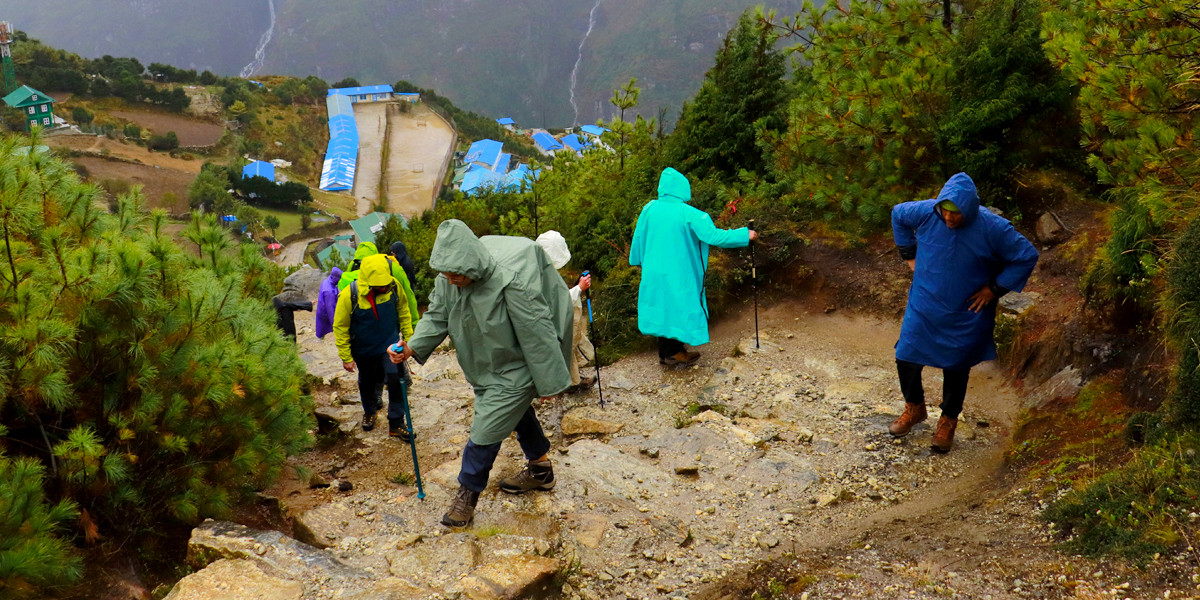
At Relax Getaways, we pride ourselves on being the premier choice for travelers seeking unique and enriching experiences in Nepal during the monsoon season. Our deep understanding of the nuances of monsoon travel, combined with our carefully curated tours, ensures that every guest enjoys a vibrant, lush, and culturally immersive journey, even amidst the rains. From navigating the less-traveled paths that reveal Nepal's rain-washed splendor to arranging participation in lively local festivals, our expertise makes us the best company for those looking to explore Nepal during this dynamic season. With Relax Getaways, travelers can expect meticulously planned itineraries, insider tips to manage the monsoon's unpredictability, and a commitment to safety and comfort that transforms a simple trip into a lifetime experience. Choose Relax Getaways to discover the magical monsoon activities in Nepal—where every detail is designed to embrace the beauty and adventure that the rainy season brings.
Table of Contents
Why monsoon in nepal.
Traveling to Nepal during the monsoon season, which typically spans from June to August, offers a unique set of experiences that are distinct from other times of the year. Here are several compelling reasons why visiting Nepal during the monsoon can be a particularly rewarding choice:
Lush Landscapes: Monsoon rains transform Nepal’s landscapes into vibrant and lush panoramas. The valleys turn a vibrant green, and the air is clean and fresh after the dust of the pre-monsoon months is washed away. This makes for stunning photography opportunities with dramatic cloud formations and verdant scenery.
Fewer Tourists: The monsoon season sees fewer visitors, which means popular tourist spots are less crowded. This allows for a more relaxed exploration of cultural and historical sites, and you often get better deals on accommodation and travel services due to lower demand.
Vibrant Local Life: The monsoon is a significant time for agriculture in Nepal, and it is a period of growth and renewal. This is a fantastic time to observe and engage with local life, as communities are active in planting and other agricultural activities. The lively local markets brimming with fresh produce and the active participation in cultural and religious festivities provide deep insight into Nepalese culture.
Unique Cultural Festivals: Monsoon coincides with some important festivals in Nepal, such as Janai Purnima and Gai Jatra. These festivals are celebrated with great enthusiasm, featuring rituals, processions, and a variety of cultural performances that are not witnessed at other times of the year.
Ideal for Ayurveda Treatments: According to Ayurveda, the monsoon season is the best time for rejuvenation treatments. The cool and damp climate helps the body’s pores to open up and makes it more receptive to herbal oils and therapies, enhancing the effectiveness of treatments.
Adventure Sports: For adventure enthusiasts, the monsoon brings exciting conditions for white water rafting. Rivers are at their fullest, providing thrilling rapids and an excellent rafting experience. Additionally, the rain-shadow regions like Mustang and Dolpo offer great trekking opportunities even during the monsoon.
Rich Wildlife Experiences: The national parks, although more challenging to navigate, are teeming with life during the monsoon. The lush vegetation offers a great environment for wildlife and bird watching. In particular, the elephant grass in regions like Chitwan grows tall, and animals are more active, making it a fruitful time for wildlife enthusiasts.
Travel Costs: Travel and accommodation costs are generally lower during the monsoon, making it a cost-effective time for budget travelers to explore Nepal. You can often negotiate more favorable rates for tours and stays.
The monsoon in Nepal brings challenges, such as occasional transportation delays and the need for proper gear, but with the right preparation, it can offer an array of unique and enriching experiences that showcase the country’s natural beauty and cultural richness in full bloom.
Cultural Exploration in Kathmandu
Exploring the rich cultural heritage of Kathmandu during the monsoon offers a unique and immersive experience, distinct from any other time of the year. The rains bring a refreshing and mystical ambiance to the city's ancient temples, palaces, and streets, making it an ideal time for those interested in delving deep into the history and spirituality of Nepal. Here are some key aspects of cultural exploration in Kathmandu during the monsoon:
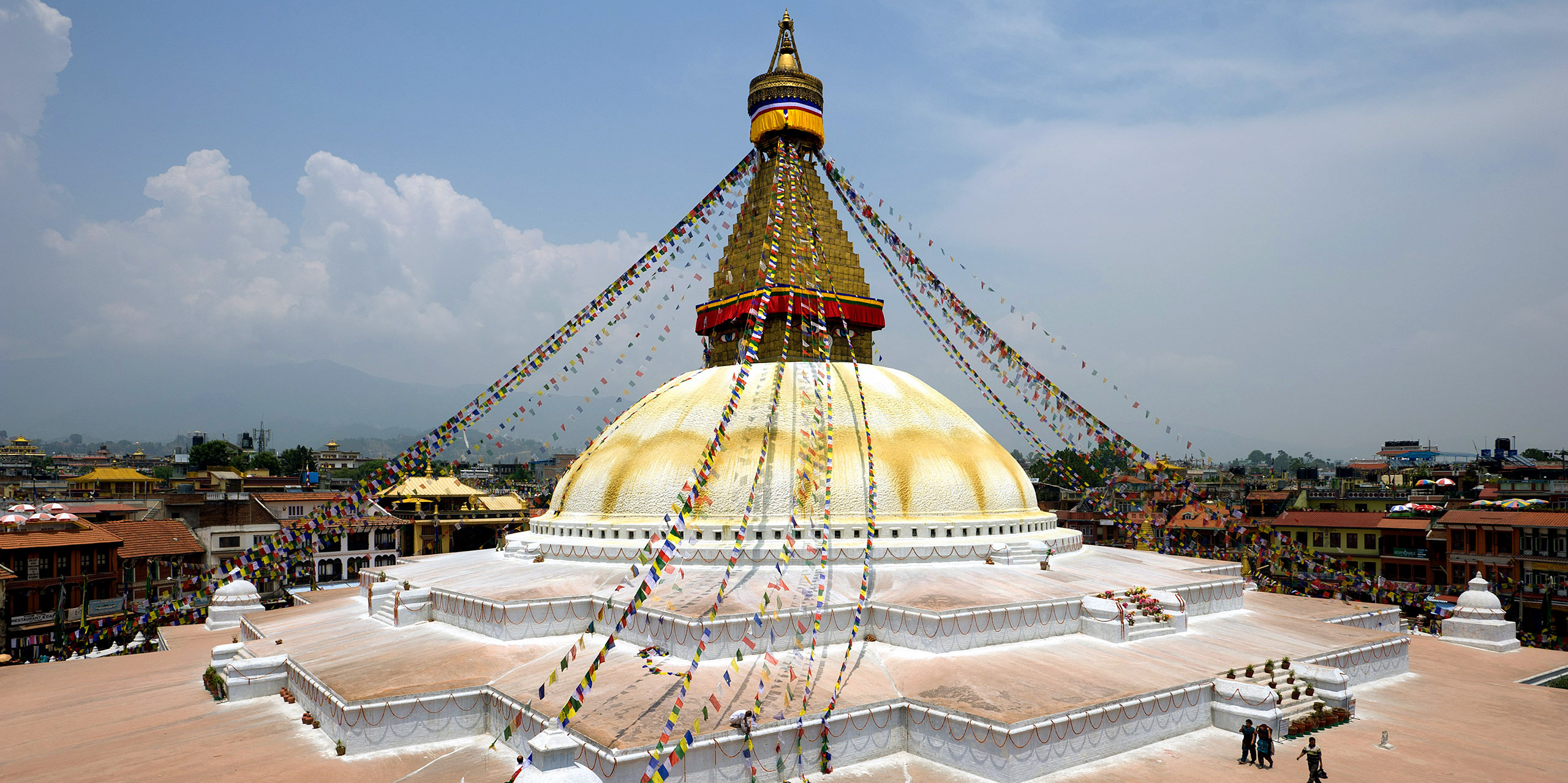
Swayambhunath Stupa (Monkey Temple): Perched on a hill overlooking Kathmandu, Swayambhunath is one of the most ancient and revered holy shrines in Nepal. The monsoon mists that often envelop the hill add a mystical quality to the site. The stupa is a great spot for meditation, peaceful walks, and panoramic views of the city, shrouded in lush greenery from the rains.
Kathmandu Durbar Square: A UNESCO World Heritage site, Kathmandu Durbar Square is the historic heart of the city, featuring a royal palace and numerous temples dedicated to Hindu gods and goddesses. Exploring this square during the monsoon allows for a more relaxed visit, with fewer tourists and a vibrant local life that can be observed in more authentic hues.
Pashupatinath Temple: This sacred Hindu temple on the banks of the Bagmati River is a significant destination for pilgrims. During the monsoon, the increased flow of the river adds a powerful and spiritual energy to the temple surroundings. Visitors can witness religious ceremonies and the daily rituals performed by the Sadhus (holy men).
Patan Durbar Square: Located in Lalitpur, near Kathmandu, Patan Durbar Square is known for its artisan community and exquisite craftsmanship in metal and stone. Monsoon rains highlight the architectural beauty and intricate carvings of the temples and palaces here. The Museum in the square is also a must-visit for those interested in learning about the rich cultural history of the Kathmandu Valley.
Thamel and Asan Market: For a more local cultural experience, wander through the bustling streets of Thamel and Asan. These areas are famous for their vibrant markets and narrow alleys, lined with shops selling everything from local handicrafts to traditional Nepalese attire. The monsoon season adds a lively atmosphere to these markets, as locals hustle about their daily lives.
Art and Gallery Tours: Kathmandu is home to numerous art galleries that showcase classical and contemporary Nepalese art. Galleries like the Siddhartha Art Gallery and the Nepal Art Council Gallery host exhibitions that feature works by local artists, which reflect the culture and traditions of Nepal.
Cultural Shows and Cuisine: Experience cultural shows that feature traditional Nepalese music and dance. Many restaurants and hotels in Kathmandu offer dinner shows where you can enjoy authentic Nepalese cuisine while watching performances that depict the folklore and myths of Nepal.
Engage with Local Communities: Participating in community activities or visiting local homes can provide deeper insights into the daily lives and traditions of the Nepali people. Many community centers and NGOs organize events and workshops that visitors can attend to learn more about local crafts, cuisine, and customs.
Cultural exploration in Kathmandu during the monsoon is not just about visiting sites; it's about experiencing the pulse of the city as it navigates the rainy season, revealing practices and scenes that are deeply rooted in the Nepali way of life. This time of year offers a quieter, yet profoundly rich tapestry of cultural interactions, ideal for those looking to understand and appreciate the essence of Kathmandu.
Attend Vibrant Festivals
Attending the vibrant festivals in Nepal during the monsoon season offers a spectacular insight into the country's rich cultural tapestry. These festivals, celebrated with great fervor and community participation, provide a unique opportunity to experience local traditions, religious practices, and the joyous spirit of the Nepali people. Here are some of the key festivals that take place during the monsoon and are a must-experience for visitors:
.jpg)
Janai Purnima: Janai Purnima, or the Sacred Thread Festival, typically occurs in August. On this day, Hindu men renew their Janai, a sacred thread worn across the chest, after taking a holy bath in rivers or ponds. This festival is also significant for the Newar community in the Kathmandu Valley, who celebrate it as Kwati Purnima , where they consume Kwati, a soup made from sprouted beans, believed to be healthful for the monsoon season. It's a wonderful occasion to witness religious rites and enjoy the local culinary delicacies that accompany the celebrations.
Gai Jatra (Festival of Cows): Gai Jatra is one of the most colorful and humorous festivals celebrated in the Kathmandu Valley, particularly in Kathmandu, Patan, and Bhaktapur. Held in August, the festival commemorates the lives of those who passed away within the last year. Families of the deceased parade through the streets with cows or young boys dressed as cows, believed to help guide the departed souls to heaven. The festival also includes satires, jokes, and comedic performances, making it a lively event that blends solemnity with celebration.
Indra Jatra: Celebrated in September, Indra Jatra marks the end of the monsoon season and is one of Kathmandu’s most exciting and revered festivals. The festival honors Indra, the god of rain, and features several days of processions, masked dances, and religious ceremonies. The Kumari, the living goddess, is paraded through the streets in her chariot, a major highlight for many visitors. The spectacle of lights, colors, and the traditional Lakhey dance make it a culturally enriching experience.
Teej: Teej is a significant Hindu festival primarily celebrated by women. During this festival, women fast and pray for the marital bliss and health of their husbands or for a good husband if they are unmarried. The celebrations include singing, dancing, and donning beautiful red sarees. Although Teej is celebrated across the country, the festivities in the Kathmandu Valley are particularly vibrant, offering a deep dive into the role of women in Hindu religious traditions.
Bhoto Jatra: Part of the larger Rato Machhindranath Festival, Bhoto Jatra occurs at the end of the monsoon season. It involves displaying a sacred vest to the public, which is believed to bring good luck. The festival is celebrated with much fanfare in Patan, featuring a chariot procession similar to that during Indra Jatra.
Each of these festivals offers a unique perspective on Nepalese culture, tradition, and community life. They allow visitors to witness the deep-rooted faith and vibrant customs that are a fundamental part of Nepal's social and religious framework. For anyone looking to experience the authentic spirit and communal harmony of Nepal, attending these monsoon festivals is an unparalleled experience.
Adventure in White Water Rafting
White water rafting in Nepal during the monsoon season offers an exhilarating adventure, with the rivers swollen from the rains, providing thrilling rapids and a unique challenge for rafting enthusiasts. The monsoon, which typically runs from June to August, breathes new life into Nepal's rivers, making this a prime time for those seeking high-adrenaline river activities. Here are the key aspects of experiencing white water rafting during Nepal's monsoon:
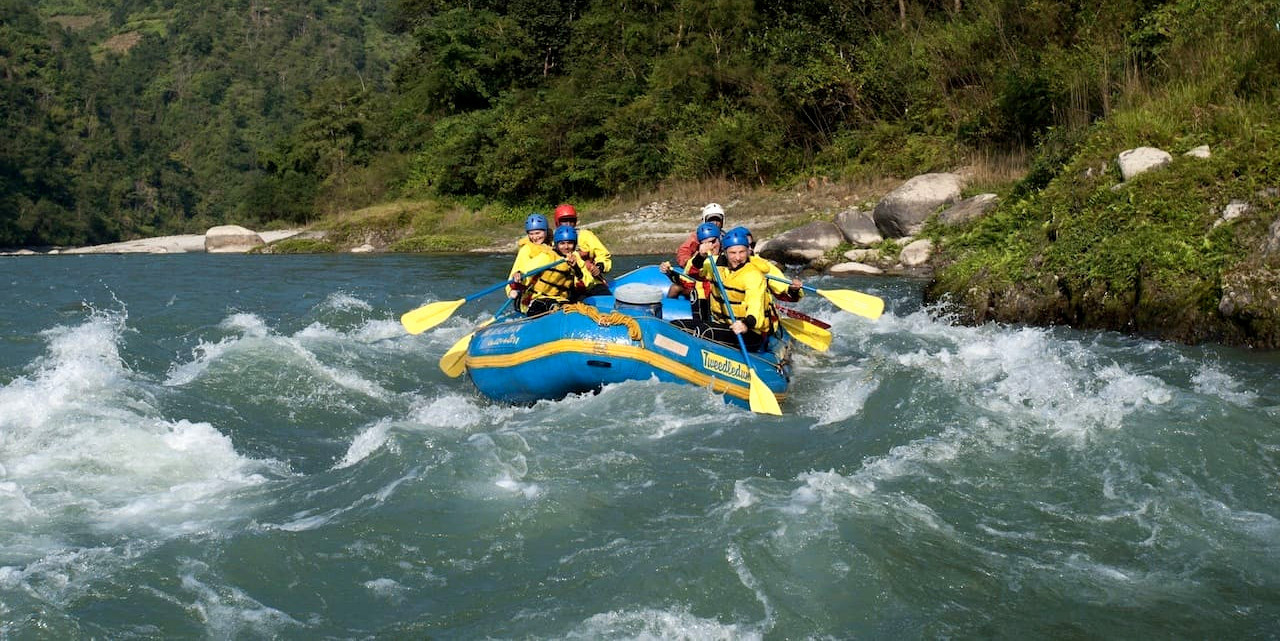
Trishuli River One of the most popular rafting destinations, the Trishuli River, is easily accessible from Kathmandu, Pokhara, and Chitwan. During the monsoon, the river's rapids, which range from Class III to IV, become more vigorous and challenging, providing an ideal setup for both beginners and experienced rafters looking for excitement close to the major cities.
Bhote Koshi River For those seeking a more intense experience, the Bhote Koshi River offers some of the steepest rafting in Nepal. Located near the border with Tibet, this river features Class IV-V rapids during the monsoon, presenting a thrilling and technical challenge that attracts adventure seekers from around the world.
Marsyangdi River Known as the "raging river," the Marsyangdi offers spectacular views and non-stop action, suitable for experienced rafters. The river flows through remote regions, providing a unique way to experience the natural beauty and dramatic landscapes of Nepal while navigating its challenging rapids.
Safety and Preparation: Monsoon rafting demands extra precautions. Operators like Relax Getaways ensure the highest safety standards, providing experienced guides who are well-versed in monsoon rafting conditions. Participants are equipped with all necessary safety gear, including helmets, life jackets, and appropriate wet suits. It is also essential to listen carefully to your guides and follow their instructions to ensure a safe and enjoyable experience.
What to Expect: Rafting during the monsoon is not just about tackling high rapids; it’s also an immersive experience in the vibrant and dynamic environment of Nepal’s rainy season. The rivers are surrounded by lush landscapes, with local flora and fauna in full bloom. Rafting trips can also be combined with camping along the riverbanks, offering a peaceful retreat after the day’s adventures.
Environmental and Cultural Insights: Participating in rafting expeditions during the monsoon also offers an opportunity to learn about the river ecosystems and the local communities living along the riverbanks. Many rafting companies contribute to conservation efforts and engage with local cultures, providing a deeper understanding of the environmental and social aspects of the regions visited.
White water rafting in Nepal during the monsoon is a thrilling adventure that combines physical challenges with the beauty of Nepal’s natural landscapes. It's an opportunity to experience the raw power of nature and the exhilaration of navigating through it. Whether you’re a seasoned rafter or a curious newbie, the monsoon season presents an exceptional time to dive into this vibrant water sport.
Wildlife Watching
Wildlife watching during the monsoon season in Nepal offers a unique and lush perspective on the country’s abundant natural habitats. The rains bring life to the forests and grasslands, making them teem with biodiversity. This is an excellent time for wildlife enthusiasts to observe a wide range of animals in their most active state. Here’s what makes wildlife watching during the monsoon season a must-do activity:
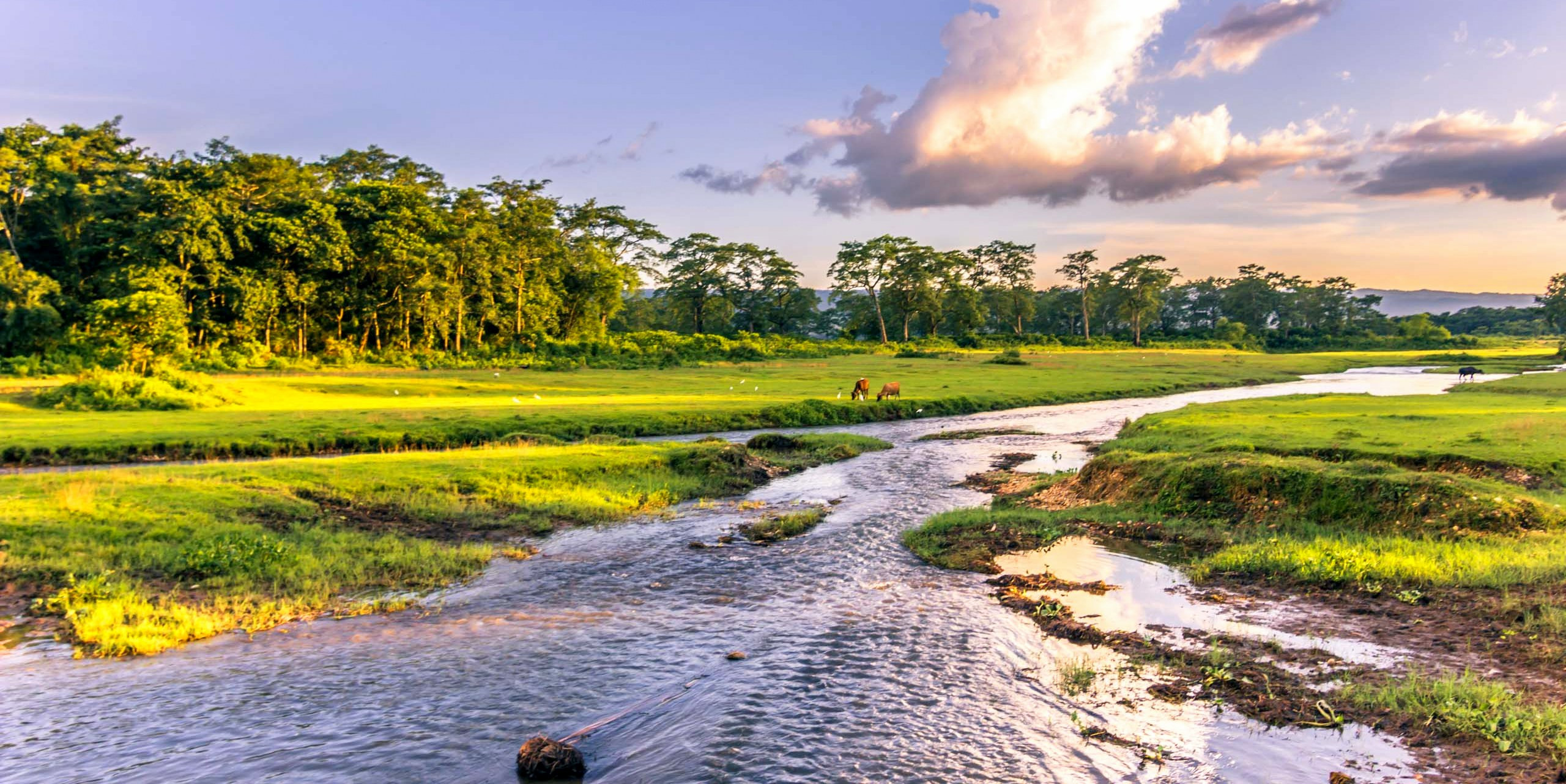
Prime Wildlife Destinations
Chitwan National Park: Located in the Terai region, Chitwan National Park is one of the best wildlife-viewing destinations in Asia. Despite the monsoon rains, the park remains accessible and offers a lush landscape that enhances the wildlife viewing experience. The park is home to the Bengal tiger, one-horned rhinoceros, and a variety of deer species. The dense foliage and increased water sources during the monsoon attract these animals to more accessible viewing spots.
Bardia National Park: Further west than Chitwan, Bardia National Park offers a more remote and undisturbed environment, which is ideal for those looking to escape the more touristic paths. The park is renowned for its elephant sightings, and the increased vegetation during the monsoon provides ample opportunities to see these majestic creatures, as well as the elusive Bengal tiger.
Koshi Tappu Wildlife Reserve: Though primarily famous for bird watching, Koshi Tappu Wildlife Reserve in the eastern Terai comes alive during the monsoon with migratory and resident birds. This season is particularly favorable for observing waterfowl, waders, and other bird species that thrive in the wet conditions.
Preparing for Monsoon Wildlife Safaris
Waterproof Gear : Ensure you have waterproof clothing and protection for your camera and binoculars.
Flexible Itinerary : Be prepared for sudden downpours, which might cause temporary disruptions to your plans.
Insect Protection : The monsoon brings out mosquitoes and other insects, so insect repellent is a must.
Expert Guides : Always choose experienced guides who know the area well and can navigate the parks safely during the rain.
Wildlife watching during Nepal’s monsoon season offers a vibrant, dynamic, and richly rewarding experience. The lush landscapes not only provide spectacular backdrops but also enhance the chances of seeing wildlife in its natural setting. For those willing to embrace the monsoon’s unpredictability, the rewards include witnessing the thriving life of Nepal’s famed biodiversity.
Ayurvedic Wellness Retreats
Ayurvedic wellness retreats during the monsoon season in Nepal provide a unique opportunity to experience rejuvenation and healing in line with ancient practices. According to Ayurveda, the monsoon is the best time for detoxification as the cooler and moist environment helps to open the pores of the body, making therapeutic treatments more effective. Here’s an overview of what to expect from Ayurvedic wellness retreats in Nepal during the monsoon:

Optimal Time for Panchakarma: The monsoon season is considered ideal for Panchakarma , a comprehensive Ayurvedic treatment that detoxifies and restores the body’s optimal balance. Panchakarma treatments can include a series of massages, herbal baths, oil treatments, and nutritional modifications designed to cleanse the body of toxins. The naturally cool climate of the monsoon helps the body retain the oils used in many Ayurvedic treatments, enhancing their effectiveness and absorption.
Retreat Settings: Many Ayurvedic retreats in Nepal are set in tranquil locations that complement the healing process. These retreats often overlook lush landscapes, with views of verdant valleys, flowing rivers, or serene forests. The settings are not only beautiful but also promote a deep sense of peace and connection with nature, which is central to Ayurvedic healing principles.
Holistic Wellness Programs: Retreats typically offer a variety of programs tailored to individual health needs and goals. These programs can range from stress relief and weight management to more intensive detoxification and rejuvenation packages. Activities may include yoga, meditation, Ayurvedic cooking classes, and workshops on lifestyle changes to sustain health benefits beyond the retreat.
Experienced Practitioners: Ayurvedic retreats in Nepal are staffed by experienced practitioners who are well-versed in traditional Ayurvedic medicine. These experts not only administer treatments but also provide valuable insights into living a balanced and healthy lifestyle according to Ayurvedic principles. Their guidance is personalized, taking into account each individual's dosha (body type), medical history, and wellness goals.
Cultural Integration: Participating in an Ayurvedic retreat during the monsoon in Nepal also allows for a deeper cultural immersion. Guests can learn about the local herbs and ingredients used in treatments and meals, and how these are integrated into daily Nepalese life. This holistic approach not only treats the body but also enriches the mind and spirit through a better understanding of Nepalese traditions and natural medicine.
Health Benefits: The benefits of attending an Ayurvedic retreat during the monsoon are numerous. They include improved digestion, enhanced vitality, reduced stress, and a greater overall sense of well-being. The natural serenity of the monsoon season aids in this rejuvenation process, making it a perfect time for retreat.
Ayurvedic wellness retreats during the monsoon season offer a perfect escape into the world of traditional healing, surrounded by the natural beauty of Nepal. These retreats provide a sanctuary not only for physical restoration but also for mental and spiritual rejuvenation, aligned with the rhythms of nature and ancient wisdom. Whether seeking a comprehensive detox or simply a peaceful break from the hectic pace of life, Ayurvedic retreats in Nepal during the monsoon deliver an enriching and transformative experience.
Safe Monsoon Trekking
Trekking in Nepal during the monsoon season can be a rewarding experience if planned correctly. Despite the challenges posed by rain and mud, certain regions in Nepal offer ideal trekking conditions even during the monsoon due to their unique geographical features. These areas, known as rain-shadow areas, receive significantly less rainfall than the rest of the country, making them perfect for monsoon trekking. Here’s a guide to safe and enjoyable trekking in Nepal during the monsoon:
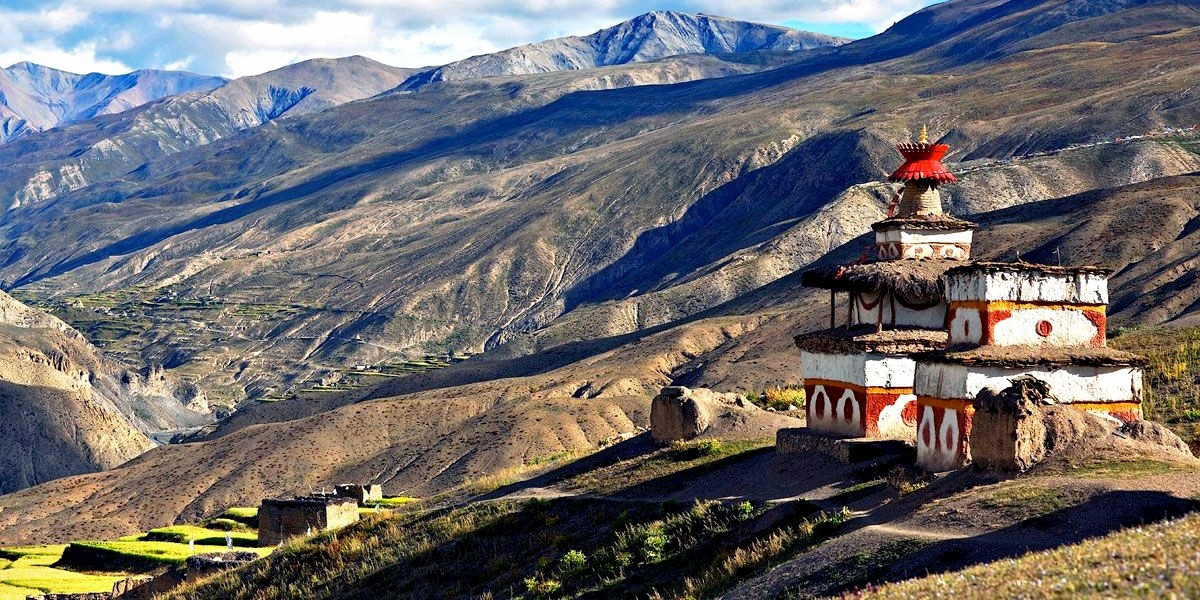
Upper Mustang: Upper Mustang, located in the rain-shadow of the Annapurna and Dhaulagiri ranges, is one of the best destinations for trekking during the monsoon. The landscape here is arid and starkly beautiful, featuring rock formations and medieval villages. This area experiences minimal rainfall, ensuring dry trails and clear views.
Dolpo Region: Another excellent rain-shadow area, Dolpo offers a glimpse into Tibetan culture and dramatic landscapes, including Shey Phoksundo Lake, one of Nepal’s most beautiful spots. The lower parts of Dolpo receive some rain, but the higher regions remain dry, providing safe hiking conditions.
Manang and Mustang (Annapurna Circuit): Certain sections of the Annapurna Circuit, particularly those around Manang and the northern parts near Mustang, also lie in a rain-shadow area. These parts offer safer trekking options with less disruption from the monsoon rains.
Safety Tips for Monsoon Trekking
Proper Gear : Essential items include waterproof jackets, trousers, and trekking boots. A good quality backpack cover and a waterproof cover for your sleeping bag are also crucial.
Experienced Guides : Hiring experienced local guides who know the terrain and can navigate safely during the monsoon is vital. They can also provide valuable insights into the local culture and environment.
Flexibility in Itinerary : Be prepared to adjust your trekking plans according to the weather conditions. Monsoon can occasionally bring unexpected showers even to rain-shadow areas.
Health Precautions : The monsoon season increases the risk of leeches and mosquitoes, so carrying insect repellent and salt (for leeches) is advisable. Ensure you have a first-aid kit equipped for minor injuries and common ailments.
Travel Insurance : Always travel with insurance that covers trekking activities, including emergency evacuation and medical services.
Advantages of Monsoon Trekking
Fewer Crowds : One of the significant advantages of trekking during the monsoon is the lack of crowds. Trails are less crowded, and teahouses have fewer guests, which can lead to a more authentic interaction with locals.
Lush Landscapes : Although some high-altitude areas remain arid, the approach trails can be lush and vibrant, offering beautiful green scenery and blooming flowers.
Cultural Experiences : The monsoon season is rich with local festivals and agricultural activities. Trekkers can observe and even participate in these cultural events, providing a deeper understanding of the local communities.
Monsoon trekking in Nepal requires careful planning and consideration, but with the right preparation and destinations, it can be an incredibly rewarding experience. Trekking in the rain-shadow regions not only ensures drier conditions but also exposes trekkers to unique landscapes and cultures not seen in more popular trekking seasons.
Photography Opportunities
Monsoon season in Nepal transforms the landscape into a dynamic and vivid canvas, offering exceptional opportunities for photography. The combination of lush greenery, dramatic skies, and vibrant daily life creates a unique setting for both amateur and professional photographers. Here are some key aspects to consider for photography during Nepal’s monsoon season:
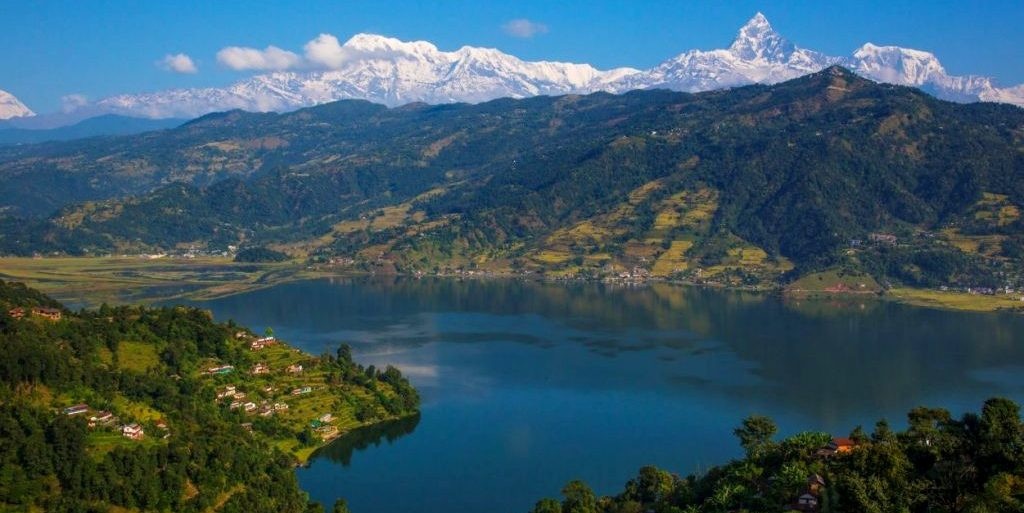
Dramatic Landscapes: The monsoon rains bring an explosion of greenery to Nepal's hills and valleys. This lushness contrasts beautifully with the rugged mountains, many of which may still be capped with snow in the higher altitudes. The play of light and shadow, along with the often-cloudy, moody skies, provides a dramatic backdrop for landscape photography. Capture the swirling mists and clouds as they envelop mountain peaks and forested hillsides.
Enhanced Colors: The monsoon season saturates colors, making them appear more vivid. The freshly washed streets of Kathmandu, the bright clothing of local people, and the rich greens of the rice paddies and forests can add a strong visual impact to your photographs. This is an excellent time for capturing the vibrancy of Nepal’s urban and rural settings.
Water Features: Waterfalls, rivers, and streams are at their fullest during the monsoon. The increased flow creates powerful images of cascading water and raging rivers. Places like the Poon Hill trek or the Annapurna region offer spectacular views of waterfalls and lush terrains that are particularly photogenic during this season.
Cultural Festivities: Monsoon coincides with several local festivals, including the vibrant Janai Purnima and the lively Gai Jatra. These festivals bring out elaborate processions, traditional attire, and a plethora of cultural activities that are a feast for the eyes and the camera. Capturing these events can provide a deep insight into the cultural richness of Nepal.
Daily Life and Local People: The monsoon season affects daily life in many ways, which can lead to compelling human interest stories. Photographing local people as they go about their daily routines—whether it’s children playing in the rain, vendors selling colorful umbrellas, or farmers working in the fields—can add a strong narrative element to your images.
Macro and Flora Photography: The wet environment of the monsoon is perfect for macro photography. The raindrops on plants, insects taking shelter, and the growth of new plants and flowers offer macro photography enthusiasts a chance to capture stunning close-up details of nature.
Tips for Monsoon Photography in Nepal
Protect Your Equipment : Ensure you have waterproof covers for your camera and lenses. Humidity and water can damage photography equipment.
Best Light : Overcast conditions can provide diffused light which is ideal for photography, reducing harsh shadows and bright highlights.
Be Prepared : Carry protective gear for yourself, like waterproof clothing and sturdy boots. Being comfortable allows you to focus on capturing great photos.
Patience and Flexibility : Weather can be unpredictable. Be ready to wait out rain showers and be flexible with your travel plans.
Monsoon in Nepal offers a unique opportunity to capture stunning photographs that showcase the natural beauty and cultural vibrancy of the country in a way that is not possible at other times of the year. With the right preparation and a keen eye, you can bring back images that truly reflect the spirit of Nepal during this lush season.
Indoor Activities
During Nepal's monsoon season, when the outdoor landscapes are drenched in rain, there are plenty of enriching indoor activities that can provide visitors with engaging experiences. Here are some notable indoor activities that you can enjoy, even when the weather outside is less than ideal:
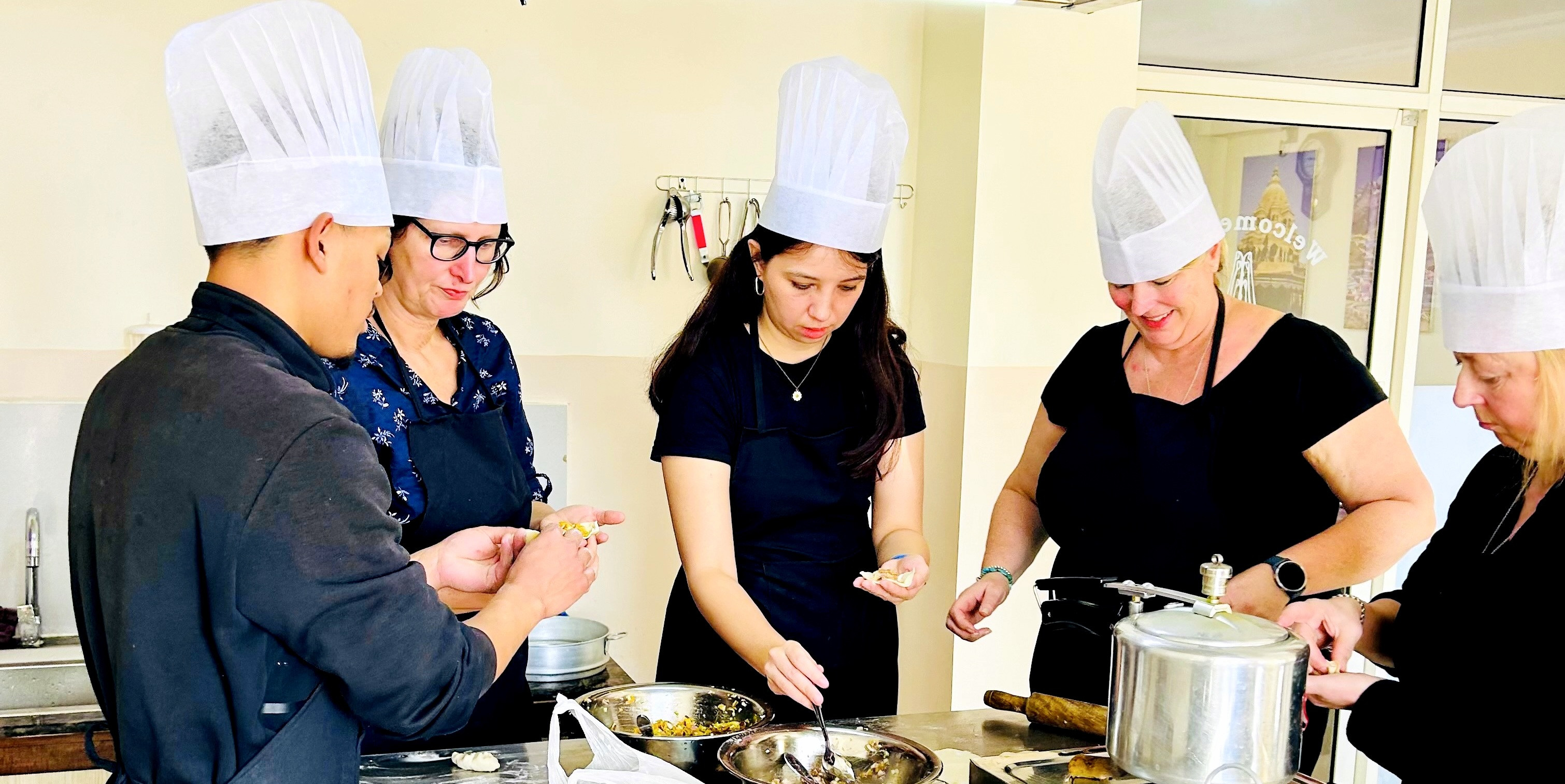
Museum Visits: Nepal boasts a variety of museums that offer insights into the nation's rich history, culture, and art. The National Museum of Nepal in Kathmandu, for example, displays artifacts from across the country that trace Nepal's historical and cultural evolution. The Patan Museum , located in Patan Durbar Square, is another excellent choice, focusing on traditional Nepalese art and architecture.
Art Galleries: Exploring Nepalese art can be a profound indoor activity. Kathmandu is home to numerous art galleries such as the Siddhartha Art Gallery and the Nepal Art Council Gallery , which feature contemporary and traditional art by Nepalese and international artists. These galleries often host new exhibitions, workshops, and artist talks that can provide deeper insights into the vibrant local art scene.
Cooking Classes: Participating in a Nepalese cooking class is a fun and interactive way to learn about the local cuisine and culture. Many classes include a market visit to buy fresh ingredients, followed by instruction on how to prepare traditional dishes such as momo (dumplings), dal bhat (lentils and rice), and various Nepalese curries.
Cultural Shows: Attend traditional Nepalese cultural shows which often include dance performances and live music. These shows are a great way to experience and appreciate the local culture and traditions from the comfort of an indoor venue. Places like the Nepal Cultural Center often host such events.
Spa and Wellness Centers: For those seeking relaxation, visiting a spa or wellness center can be the perfect monsoon activity. Many centers offer Ayurvedic treatments, massages, and wellness therapies that are especially beneficial during the cooler, damp monsoon months.
Yoga and Meditation Retreats: Joining a yoga or meditation session can be particularly refreshing during the monsoon. Many centers in Kathmandu and Pokhara offer indoor yoga and meditation classes that cater to all levels, providing a peaceful retreat from the monsoon rains.
Handicraft Workshops: Engage in a handicraft workshop where you can learn skills like pottery making, Thangka painting, or wood carving. These workshops not only offer a chance to learn a new craft but also support local artisans and provide an in-depth look at Nepalese artistic traditions.
Theater Performances: Check out local theater performances, which can range from traditional Nepalese street theater to modern plays. Theatres like Mandala Theatre in Kathmandu showcase a variety of local and international productions.
Literary Cafes: Visit one of Kathmandu’s literary cafes, where you can enjoy a good book, participate in book readings, or join lively discussions. These cafes often serve as cultural hubs, hosting events that include poetry readings and author meet-and-greets.
Shopping in Malls: For those who prefer a bit of retail therapy, visiting one of Kathmandu’s shopping malls like the Civil Mall or Labim Mall offers a way to shop for both local and international brands under one roof, away from the monsoon rains.
These indoor activities not only keep you dry during Nepal’s monsoon season but also provide valuable insights into the country's cultural and artistic heritage, making your visit enriching and memorable.
Travel Preparedness
Traveling during Nepal’s monsoon season, which typically spans from June to August, requires special preparations to ensure a safe and enjoyable experience. Here are some essential travel preparedness tips for navigating the monsoon in Nepal:
Pack Appropriate Clothing: The monsoon climate is characterized by heavy rain and humidity, but temperatures can still be warm. Pack lightweight, breathable clothing that dries quickly. Waterproof jackets, ponchos, and rain covers for your backpack are must-haves. It’s also wise to bring along a few warm layers since temperatures can drop, especially in the evenings or in higher altitudes.
Choose Suitable Footwear: Waterproof hiking boots are essential if you plan on trekking. For city travel, water-resistant shoes or sandals that can handle wet conditions are advisable. Always have a spare pair so you can rotate if one pair gets wet.
Protect Your Electronics and Important Documents: Waterproof bags or cases are crucial to protect your electronics such as cameras, smartphones, and laptops from rain. Similarly, keep your important documents, like your passport and travel insurance papers, in waterproof pouches.
Carry Insect Repellent and Basic First Aid: Monsoon increases the presence of mosquitoes and other insects, raising the risk of diseases like malaria and dengue fever in some areas. Carry a good insect repellent and consider packing a mosquito net if you're staying in rural areas. A basic first aid kit equipped with antiseptics, band-aids, anti-diarrhea medication, and any personal medication is also essential.
Be Flexible with Your Itinerary: The monsoon can lead to unexpected disruptions, such as transportation delays, road blockages, or even temporary closures of attractions. Keep your travel plans flexible and allow extra time for travel between destinations.
Stay Informed About the Weather: Regularly check local weather reports and be prepared for sudden changes. Apps and local news can provide timely updates about weather conditions in specific areas of Nepal.
Choose the Right Travel Insurance: Ensure that your travel insurance covers monsoon-related issues like trip cancellations or delays, and medical emergencies. Check that it includes coverage for activities you plan to engage in, such as trekking or rafting.
Travel with a Reputable Company: When booking tours and activities, choose reputable providers who have experience operating in monsoon conditions and are known for prioritizing safety. They will have the knowledge and resources to handle any challenges that arise due to the weather.
Use Waterproof Bags for Trekking: If you're trekking, use a waterproof trekking bag or a regular trekking bag with a high-quality rain cover. Pack your items in plastic bags inside your backpack for double protection.
Bring a Portable Umbrella and Quick-Dry Towel: A compact, sturdy umbrella can be invaluable during sudden downpours. Additionally, a quick-dry towel will be useful whether you’re trekking through the mountains or exploring the cities.
Traveling during the monsoon in Nepal can be a rich and rewarding experience, as the landscape is lush and the tourist crowds are thinner. With the right preparations, you can enjoy all that Nepal has to offer during this vibrant season safely and comfortably.
Health and Safety for Things to do in Nepal in Monsoon
Traveling in Nepal during the monsoon season presents unique health and safety challenges. The monsoon, typically from June to August, brings heavy rainfall, which can significantly impact travel plans and personal health. Here are essential health and safety tips to consider when engaging in activities in Nepal during the monsoon:
Health Precautions
Vaccinations and Health Checks: Before traveling, ensure you are up to date with vaccinations recommended for Nepal, including Hepatitis A and B, Typhoid, and Tetanus. Additionally, consider a consultation with a travel doctor who may recommend malaria prophylaxis if you plan to visit rural areas.
Avoid Waterborne and Foodborne Illnesses: The risk of waterborne diseases increases during the monsoon due to water contamination. Drink only bottled or purified water, avoid ice in drinks, and be cautious with raw fruits and vegetables that may not have been washed with purified water. Eating hot, cooked meals from reputable restaurants is advisable.
Manage Insect Bites: Mosquitoes are more prevalent during the monsoon, increasing the risk of dengue fever and other insect-borne diseases. Use insect repellent regularly, wear long-sleeved shirts and pants, and sleep under mosquito nets if necessary.
Safety Measures
Prepare for Trekking: If you plan to trek, be aware that trails may be slippery, leeches are more active, and visibility may be reduced. Use sturdy, waterproof trekking boots, carry trekking poles for stability, and always trek with a knowledgeable guide. Choose treks in the rain-shadow regions like Upper Mustang or Dolpo for safer conditions.
Be Cautious of Flooding and Landslides: Heavy rains can lead to sudden flooding and landslides, particularly in hilly and mountainous areas. Stay informed about the weather conditions and heed local advisories. Avoid river crossings during or immediately after heavy rains and be cautious on road journeys.
Road Travel Safety: Road conditions can deteriorate rapidly during the monsoon, with potholes, mudslides, and slippery surfaces. If you must travel by road, prefer daytime journeys and use experienced local drivers and well-maintained vehicles.
Urban Caution: In cities, be cautious of flooded streets and uncovered manholes. Fast-moving water can be dangerous, even in urban areas. Traffic may also be more chaotic during heavy rains, so extra caution is necessary when walking near roads.
Emergency Preparedness
Comprehensive Travel Insurance: Ensure your travel insurance covers medical treatment, emergency evacuation, and the potential costs associated with trip cancellations or delays due to monsoon-related issues.
Emergency Contacts: Keep a list of emergency contacts, including local emergency services, the nearest hospital, and your home country’s embassy or consulate. Also, have the contact information of your tour operator or local guides handy.
Stay Informed: Keep abreast of local news and weather forecasts. Mobile apps and travel alerts from reputable sources can provide critical information quickly.
By taking these health and safety measures, you can better manage the risks associated with monsoon travel in Nepal. Proper preparation and awareness can help ensure a safe, enjoyable, and healthy visit to this beautiful country during its lush monsoon season.
Tips for Things to do in Nepal in Monsoon
Traveling to Nepal during the monsoon season can be a fascinating experience, as the landscape bursts with lush greenery and the air is fresh and vibrant. To make the most of your trip during this rainy season, here are some practical tips tailored for engaging in activities and exploring Nepal between June and August:
Pack Smart: Include lightweight, quick-drying clothing in your luggage, as well as a sturdy raincoat, waterproof pants, and a good-quality umbrella. Waterproof covers for your backpack and shoes that can handle mud and wet conditions are also essential. Additionally, don’t forget to pack insect repellent and a basic first-aid kit.
Choose the Right Activities: Opt for activities that are less affected by the rain, such as cultural tours of temples and museums, cooking classes, or attending indoor cultural performances. For the more adventurous, rain-shadow areas like Upper Mustang and Dolpo offer excellent trekking opportunities even during the monsoon.
Embrace the Local Festivals: The monsoon season coincides with vibrant festivals like Janai Purnima and Gai Jatra. Participating in these festivals can provide a deep insight into the rich cultural fabric of Nepal and is a unique way to experience the country’s traditions and hospitality.
Stay Flexible: Monsoon weather can be unpredictable, with sudden showers and changes in weather conditions. Keep your plans flexible and allow for alterations based on the daily weather forecast. This flexibility can help you avoid disappointments and make the most of sunny or less rainy intervals.
Be Prepared for Trekking: If you decide to go trekking, ensure that you are well-prepared with appropriate gear, including waterproof bags and layers. Hiring a local guide is highly recommended, as they can provide valuable insights and updates on weather conditions and trail safety.
Capture the Scenery: The monsoon season offers unique photography opportunities with dramatic skies and vibrant landscapes. Protect your photography equipment with waterproof cases and bags. Early morning or late afternoon light, when the clouds might break, can provide spectacular lighting conditions for photography.
Enjoy the Cuisine: Monsoon is a great time to try local Nepalese cuisine, which often includes seasonal ingredients that are at their peak. Look for dishes that are warming and beneficial during cooler, damp weather, such as hot soups, stews, and tea.
Watch Out for Leeches: If you are hiking or walking in rural areas, be prepared to encounter leeches. Salt or tobacco water can be effective in removing them, and wearing leech socks can prevent them from attaching to your skin.
Check Road Conditions Regularly: If you are traveling by road, stay updated on the conditions as landslides and floods can cause road blockages. Always have an alternate route planned and consult with local drivers or guides.
Respect Local Sensitivities: Understanding and respecting local customs and sensitivities is important, especially when participating in festivals or visiting religious sites. Dress modestly and ask for permission before taking photographs of people or religious ceremonies.
By following these tips, you can enjoy a fulfilling and enjoyable trip to Nepal during the monsoon, experiencing the country’s beauty and cultural richness in a unique seasonal context.
Visiting Nepal during the monsoon season unveils a unique charm, with lush landscapes and vibrant cultural festivities. While the rains may pose challenges, they also enhance the natural and cultural beauty of the country, offering a serene and less crowded experience. Whether you're exploring rain-soaked temples, trekking in less-traveled regions, or participating in lively festivals, the monsoon season provides a unique opportunity to experience Nepal's richness. With careful planning and the right gear, a trip to Nepal during the monsoon can be a rewarding and unforgettable adventure.
FAQs for Things to do in Nepal in Monsoon
Q: Is it safe to travel to Nepal during the monsoon?
A: Yes, it is safe to travel to Nepal during the monsoon with the right preparations. Opt for safer regions like rain-shadow areas, and be flexible with your travel plans to manage potential landslides and flooding effectively.
Q: What are the best activities to do in Nepal during the monsoon?
A: Cultural tours, attending festivals like Janai Purnima and Gai Jatra, indoor activities such as museum visits, and trekking in rain-shadow regions like Upper Mustang or Dolpo are great options.
Q: What should I pack for a monsoon trip to Nepal?
A: Include lightweight, quick-drying clothes, a waterproof jacket, rain pants, durable water-resistant footwear, a waterproof backpack cover, insect repellent, and all essential documents in waterproof pouches.
Q: Are there any health concerns to be aware of during the monsoon?
A: The risk of waterborne and insect-borne diseases increases during the monsoon. Ensure you drink only bottled or purified water, avoid raw foods, use insect repellent, and stay current with recommended vaccinations.
Q: How does the monsoon affect trekking in Nepal?
A: Popular trekking routes may be wet, slippery, and have reduced visibility. However, trekking in rain-shadow areas such as Upper Mustang and Dolpo is more feasible as these areas receive significantly less rainfall.
Q: Can I participate in wildlife safaris during the monsoon?
A: Yes, wildlife safaris in Chitwan and Bardia National Parks can be lush and vibrant during the monsoon, with a higher chance of spotting wildlife due to abundant water and food sources.
Q: What are the advantages of visiting Nepal during the monsoon?
A: The monsoon season offers fewer tourists, less crowded attractions, lush landscapes, and excellent photography opportunities, allowing for a more immersive experience with local culture.
Q: How can I stay updated on weather conditions in Nepal during the monsoon?
A: Keep informed through local news, weather apps, and advisories from Nepal's Department of Meteorology. Always check the weather forecast before planning any day trips or treks.
Q: Are transportation services available during the monsoon?
A: Transportation services generally operate, but there may be occasional disruptions. Regularly check updates and maintain flexible travel plans.
Q: What should I do in case of a monsoon emergency?
A: Follow local advisories and directions from your tour operator or accommodation. Keep emergency contact numbers for local services, your embassy, and your travel insurance provider handy.
For the Nepal tour, please click here.
If you are looking for different kinds of Nepal Tours or Trekking Packages, feel free to contact us .
- Best Place to visit
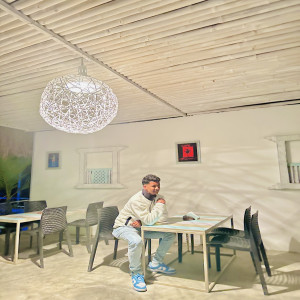
Danu Giri, hailing from Kathmandu, Nepal, is not only an accomplished content writer but also an avid explorer with a passion for discovering new destinations. His journeys to various places enrich his understanding of different cultures and landscapes, which he skillfully weaves into his writing. His ability to blend travel with writing ensures that each piece he crafts is as engaging as it is informative.
Recent Posts
- Top Treks in Nepal During the Fall
- World Heritage Sites of Nepal
- Natural Tourist Attractions in Nepal
- Nepal’s Wildlife on Trek: The Best Routes for Animal Spotting
- Most Visited Places in Nepal
Related Posts
- 10 Places Most of the Travelers Miss In Nepal; You Shouldn't!
- Best Underrated Treks in Nepal
- Top 10 best places to visit in Tibet
- Culture and Tradition
- Photography

- Travel Guide & Tips
An ultimate guide to the Most Popular Monsoon Treks in Nepal
- Modified on Jul 11, 2024
The Monsoon Trekking Season in Nepal runs from mid-June to September, bringing around 80% of the country’s annual rainfall that lasts for almost 105 days. This season is also known as Wet Summer due to heavy rainfall and high humidity because of the monsoon winds from the Indian Ocean.
Heavy rainfall supports the agriculture sector of the country as it may also lead to various natural disasters like floods, and landslides, which cause significant damage to the infrastructure and natural habitats. Trekking to the different regions of Nepal during monsoon can be challenging as well as rewarding. As the fall season has the clearest sky, trekking during the monsoon has its rewards. The trails are less crowded, the villages are lively and green whereas the spring and winter are gray and dry.
If you are planning a monsoon trek in Nepal, you need to be careful about the heavy rainfall and storms, especially leeches. The Monsoon Season in Nepal is a time of lush greenery and blooming flowers enhancing stunning landscapes. The best months to trek in the monsoon season are from June to September. If you plan to trek during the Monsoon Season in Nepal, it is obvious that you must have proper rain covers, windproof and waterproof jackets, trekking poles, sturdy trekking boots, and raincoats.
However, it gets less rainfall in September which makes the best time to trek as the autumn begins. Usually Spring and Autumn are the best recommended seasons for trekking in Nepal, however, if you are looking for empty and peaceful trails, then the monsoon season is the one for you. If you are a first-time traveler to Nepal, here is a complete guidebook for you.
Here are the most popular monsoon treks in Nepal you can add to your bucket list:
Table of Content
Most popular monsoon treks in nepal, nar phu valley & kangla pass monsoon trek (11-12 days).
Nar Phu Valley Trek is one of the popular monsoon treks in Nepal due to the less and uncrowded hiking trail. This trek is the best for the ones who want a quiet and off-the-beaten monsoon trek that lies in the remote areas of the Annapurna Region.
This is a moderate to strenuous trek that anyone with good physical fitness can execute.
It is also essential to take extra precautions about the potential risks of heavy rainfall and landslides. Although mudslides may block some roads to Besisahar, it is one great trek to do during monsoon.
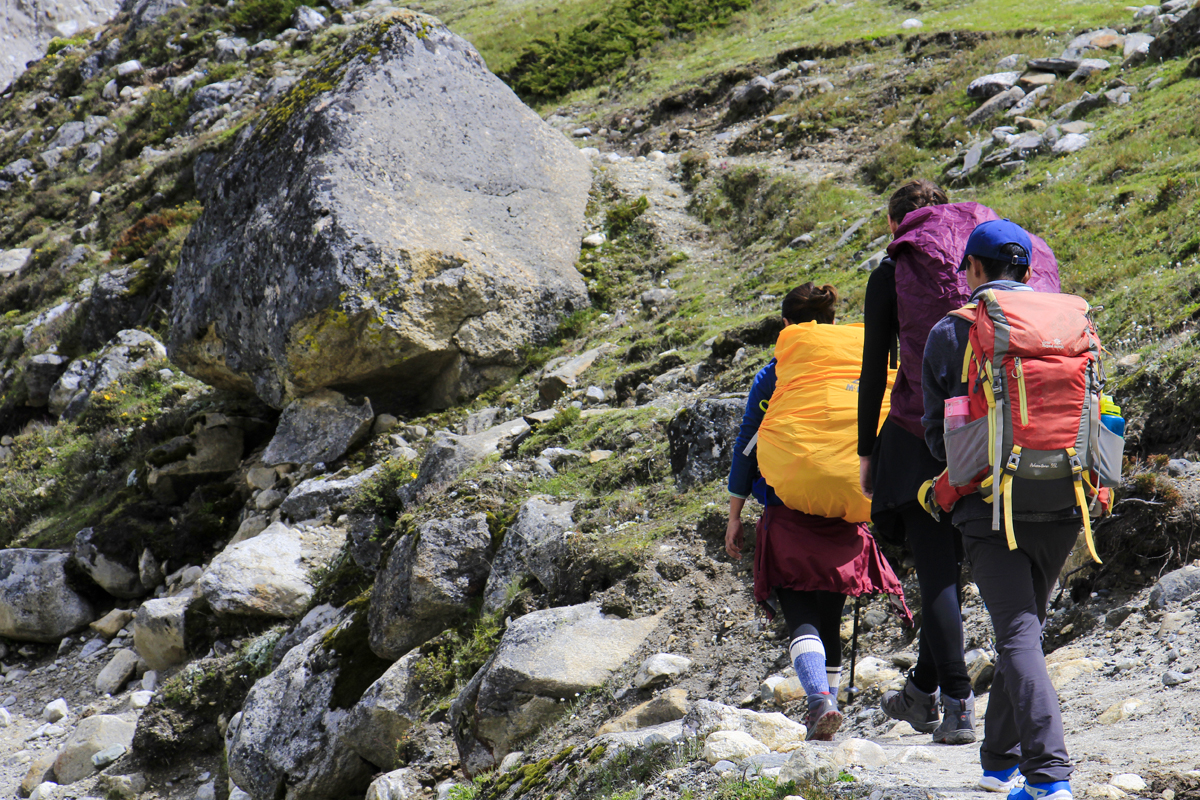
Major Highlights and Attractions of Nar Phu Valley Monsoon Trek:
- Waterfalls and water streams on Nar Phu Valley come to life with extraordinary freshness
- Monsoon turns the Annapurna Region into Lushy green land with a blooming flower paradise that enhances the astonishing landscapes
- Kangla pass is the major highlight of this trek during monsoon as it gives a challenge on the muddy trails
- As monsoon is considered off-season, explore the beauty of Nar Phu Valley in peaceful and uncrowded trails in budget
Upper Mustang Monsoon Trek (14-15 days)
Located in the northern-central part of Nepal, Upper Mustang is a popular trekking destination with a unique microclimate during the Monsoon Season. Monsoon Rainfall washes away the dust and leaves a clearer and more vibrant landscape in the Upper Mustang region of Nepal. While other regions might be difficult to execute during the Monsoon, the Upper Mustang remains accessible and comparatively safe during this time.
The Upper Mustang trek is considered a moderate to strenuous trek due to high fitness requirements. Despite the challenge of trekking during the Monsoon season, the Upper Mustang Monsoon trek is a rewarding experience that allows travelers to explore the hidden gem of Nepal. Always plan the trek with a registered trekking agency to secure the risk of altitude sicknesses and all the required permits.
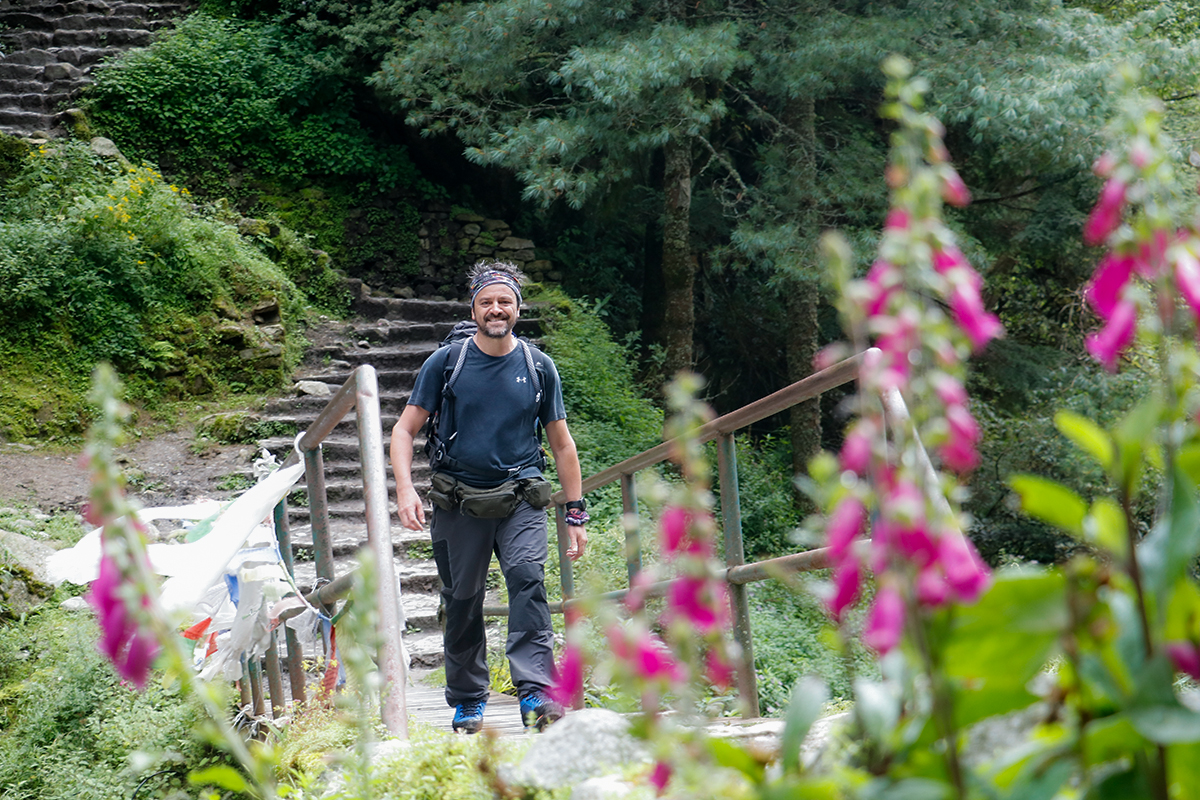
Major Highlights and Attractions of Upper Mustang Monsoon Trek:
- Lo Manthang, the former kingdom of Mustang looks more vibrant and clean during monsoon and is the major highlight of Upper Mustang Monsoon Trek
- Trek through the unexplored gem of Nepal with dust free experience
- Explore several Monasteries and Gompas of the Mustang region
- Less crowded and quiet trekking trails
- Rainwashed fresh and dust-free trials throughout the trek
Everest Base Camp Trek (12-14 days)
There is a misconception that trekking to the Everest Base Camp is only possible during the peak season that is Spring and Autumn, whereas the Everest Base Camp Trek is possible throughout the year. Everest Base Camp Monsoon Trek is for those who want to experience extra challenges and experience incredible green sceneries and clear landscapes.
However, it is a moderate to strenuous trek due to heavy rainfall and landslides. You need to be very careful on the suspension bridges and the slippery trails, due to heavy rainfall.
Monsoon is the best season to trek to Everest Base Camp due to the less crowded trails where you can get each and every experience in silence. In the early monsoon, there is sufficient rainfall in Lukla and the lower Everest region whereas the upper Everest region faces comparatively less rainfall.
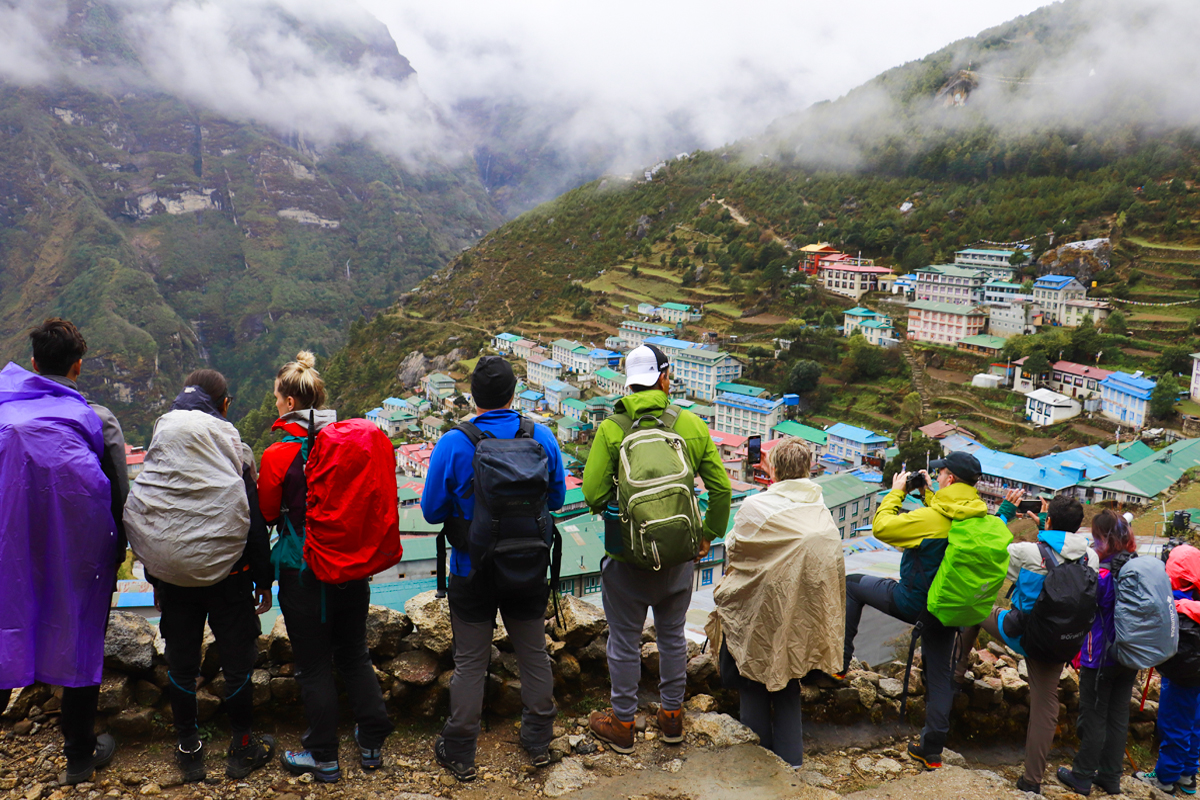
Major Highlights and Attractions of Everest Base Camp Monsoon Trek:
- Experience blooming flowers and lush green atmosphere around the trails to Everest Base Camp
- Comparatively less crowded trails and slippery suspension bridges
- Extremely green and fresh feel at Lukla Airport during monsoon
- A great and challenging adventure through slippery trails
- Clear and more vibrant views of the landscapes free from dust
- Monsoon is the best season to spot wildlives in the Everest Region
- Since monsoon is off-season, prices for food and accommodation tend to be lower prices than in peak season
Annapurna Circuit Trek (12-14 days)
Annapurna Circuit Trek is one of the most popular trekking destinations during the Monsoon season of Nepal because of its stunning views of the Annapurna Range, local villages, and diverse landscape. This trek can be done at any time of the year when the monsoon can be a challenging and equally rewarding experience for adventure seekers.
As you make your way through the lush green trails, you can feel the fresh breeze and the mountains seem to come to life with the mists and clouds around them.
Take extra precautions as the weather can be unpredictable in the Annapurna region so pack enough clothes and rain covers, however, it is likely to rain at night in the Annapurna region which means there is less possibility of getting soaking wet during the Annapurna Circuit Trek. Here, are the top 10 reasons why must trek to Annapurna Base Camp.
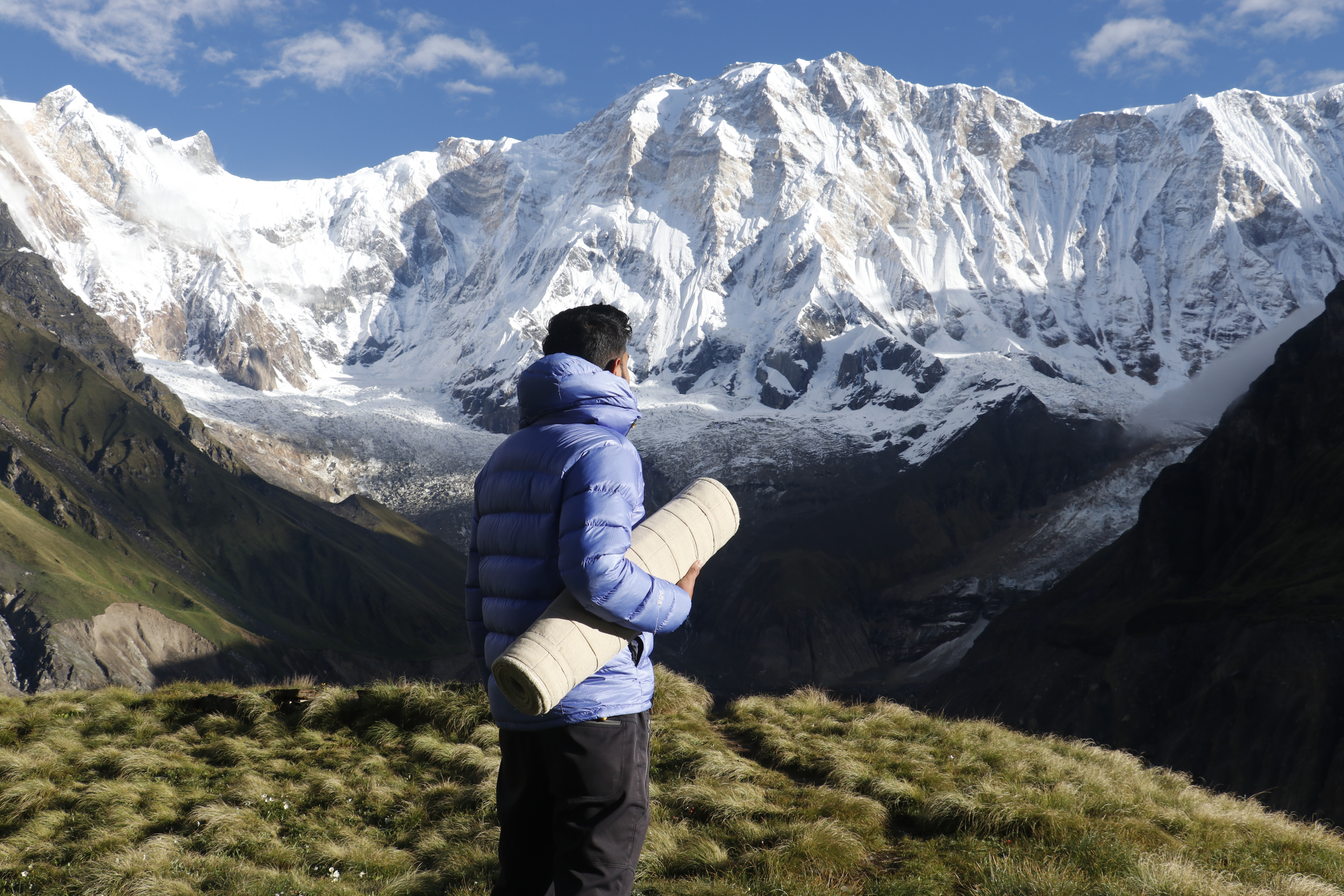
Major Highlights and Attractions of Annapurna Circuit Monsoon Trek:
- Extremely less crowded trails and teahouses
- Clear and fresh breezed trails and extremely vibrant landscapes
- Monsoon trek is best for photography and videography as the trails are fully green and vibrant
- Experience the fresh flowing rivers and waterfalls that are extremely gorgeous around the trails
- Reach the top of Thorong La Pass for breathtaking views of Manaslu, Annapurna I, and Dhaulagiri
Upper Dolpo Trek (16- 18 days)
One of the popular monsoon treks in Nepal is the Upper Dolpo Trek which lies in the rain shadow area where the weather is wet and humid.
The Upper Dolpo Trek is a challenging monsoon trek that demands a good level of fitness and strength while walking on slippery trails with leeches. It is also highly recommended to carry salt to prevent leeches on the trail.
It is better to hire a guide from a registered trekking agency in order to get extra safety and support to complete this trek. Local flights can be delayed due to heavy rainfall, however, this is one of the greatest treks to execute during monsoon in Nepal.
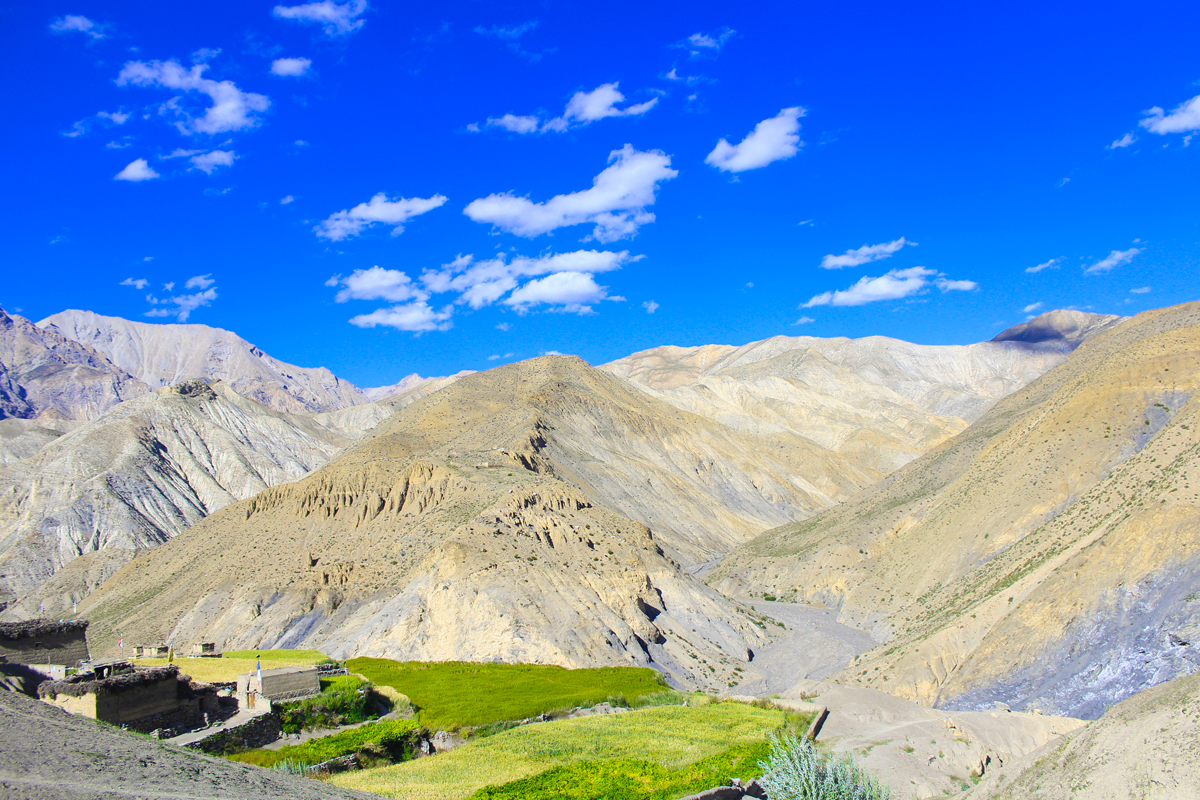
Major Highlights and Attractions of Upper Dolpo Monsoon Trek:
- A major highlight of this trek is Shey Phoksundo Lake, one of the deepest and most popular lakes in Nepal with much more freshness and green-blue water during monsoon
- Explore the less explored and remote western Nepal at cheaper prices during monsoon offseason
- Trek through the highest passes in Nepal like Nangdala, Jayanata, and Sela Passes
- Fast Flowing waterfalls and rivers, are the exciting elements that await you during monsoon
- Monsoon is the best season to collect Yarsagumba (a unique caterpillar fungus used for its aphrodisiac properties)
Mardi Himal Trek (5-8 days)
Mardi Himal is a relatively moderate trek that doesn't require extra physical fitness. Although this is the best trek for Autumn, it can also be done during Monsoon as the trails and teahouses are less crowded.
This trek serves the majestic views of Machhapuchhre and the Annapurna Range. The hills are covered in greenery and the mountains feel alive with the clouds surrounding the landscapes during monsoon. The trek serves the best sub-tropical forests and alpine vegetation.
As this is a relatively short trek, this can be done any season and by anyone with good physical fitness. However, the trail has different ascents and descents you need to be careful of, so wear good quality boots and also don't forget to carry rain covers in case of heavy rainfall. Here , is a complete guidebook for Mardi Himal Trek.
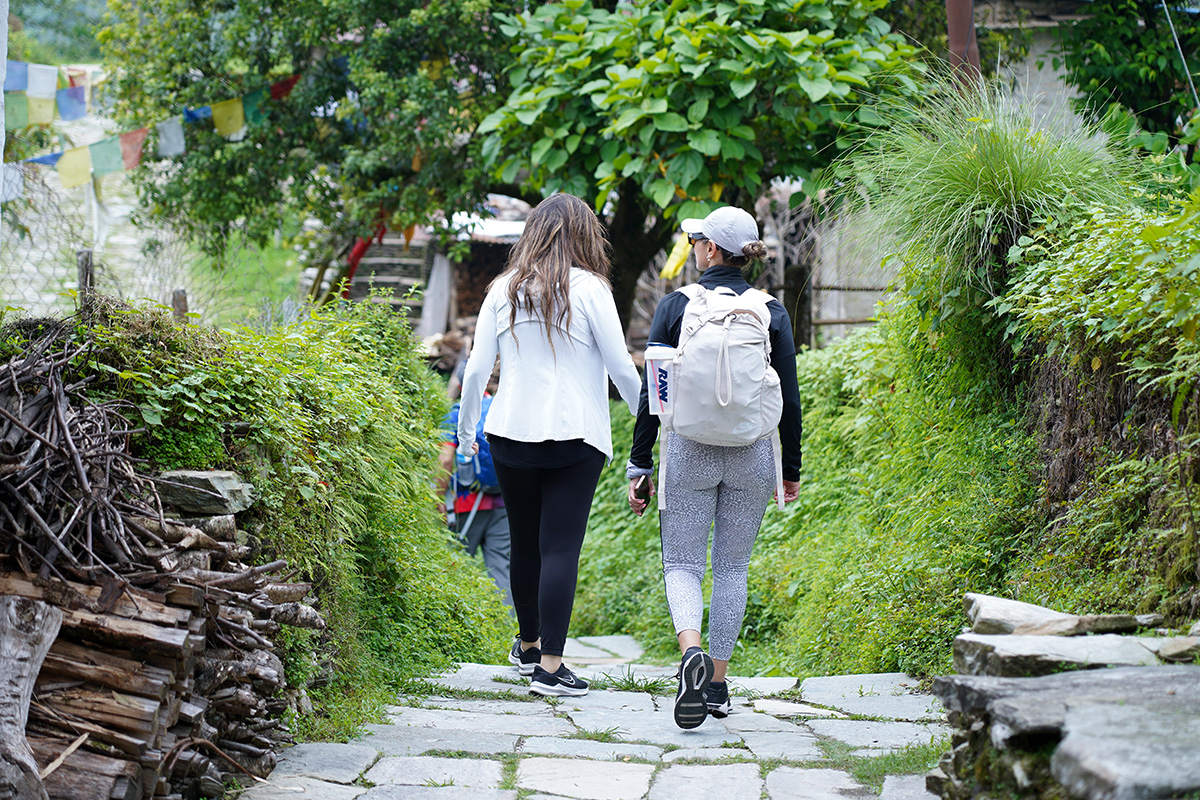
Major Highlights and Attractions of Mardi Himal Monsoon Trek:
- Mardi Himal Base Camp is the major highlight of this trek
- Astonishing views of Machhapuchhre, Annapurna Range, and Dhaulagiri
- Amazing rhododendron forests and breathtaking landscapes
- Experience the local culture and hospitality of the less-trodden trail of Nepal
Langtang Valley Trek (9-11 days)
Monsoon can be a good season to trek the Langtang Valley, the trails are less crowded, and you get to experience the best rainwashed green valleys that Langtang Valley has to offer you. The trail gets muddy and slippery but the experience is worth all the struggle and a rewarding experience for nature lovers.
Sometimes, the fog and clouds may disrupt the views but the rainfall monsoon serves to clear the pristine landscapes and the whole valley. And since it is an agricultural season, you get to explore the terraced farms in the Langtang Region. You can also checkout the blog on, complete guidebook for Langtang Valley Trek, here.
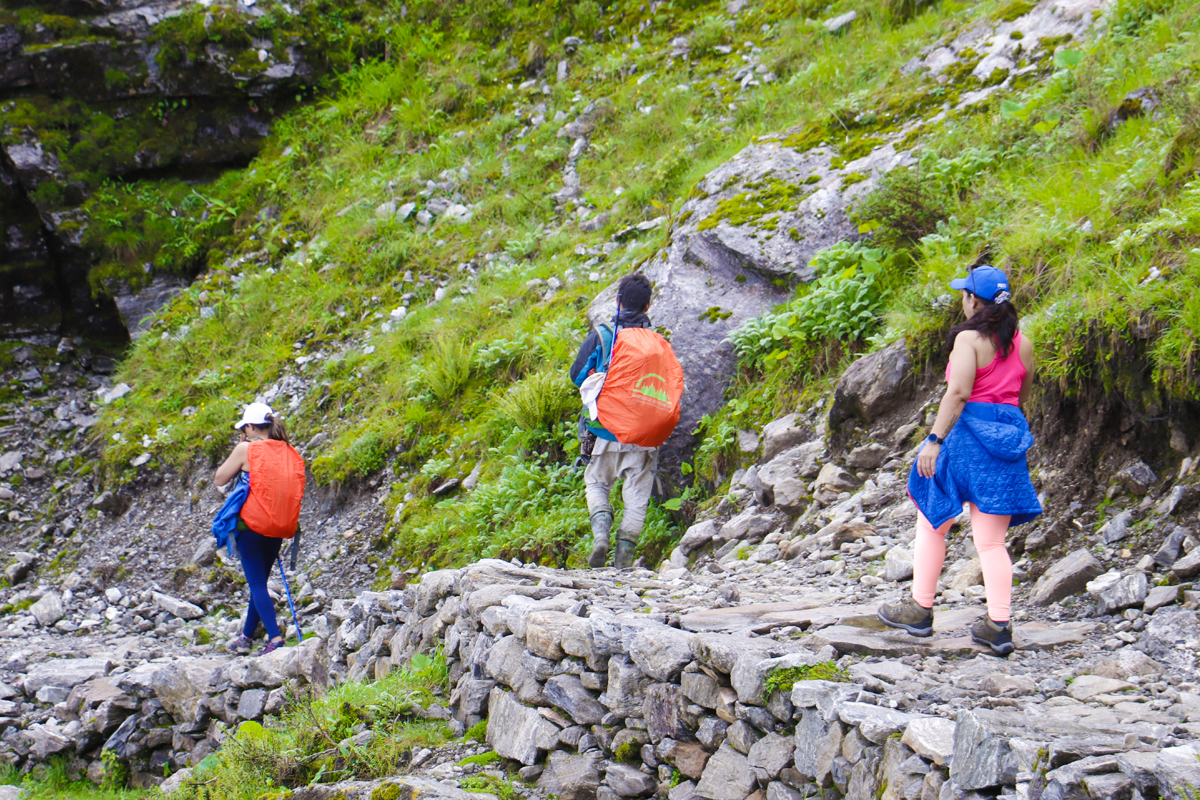
Major Highlights and Attractions of Langtang Valley Monsoon Trek:
- Despite the rainy weather, experience the best-rainwashed greenery of the Langtang Valley
- Explore the wildlife like Red Panda, Himalayan Black bear, and snow leopard
- Kyanjin Gompa is the major highlight of this trek
- Panoramic landscapes of Ganesh Himal
- Hike to TserI Ri viewpoint for the best views of mountains, valleys, and glaciers
Ghorepani Poonhill Trek (4-5 days)
Ghorepani Ponnhill is one of the easiest and most beginner-friendly treks in the Annapurna Region that serves the pristine views of Annapurna, Machhapuchhre, and Dhaulagiri. Monsoon and Autumn are the best seasons to trek the Ghorepani Poonhill. Monsoon is regarded as the off-season for trekking in Nepal which makes it clear that the trails will be less crowded and the teahouses, and accommodations will be a lot cheaper than peak season. This trek can easily be done by anyone as it does not require a high fitness level.
It is advisable to check the weather forecasts before you start your trek to avoid extra days during monsoon. Ghorepani Poonhill Monsoon Trek can be extremely rewarding as well as challenging due to slippery trails and a slight risk of landslides on the roads. Always carry rain covers and sturdy boots when trekking during the monsoon season in Nepal. This trek is comparatively the shortest trek to plan during monsoon season in Nepal.
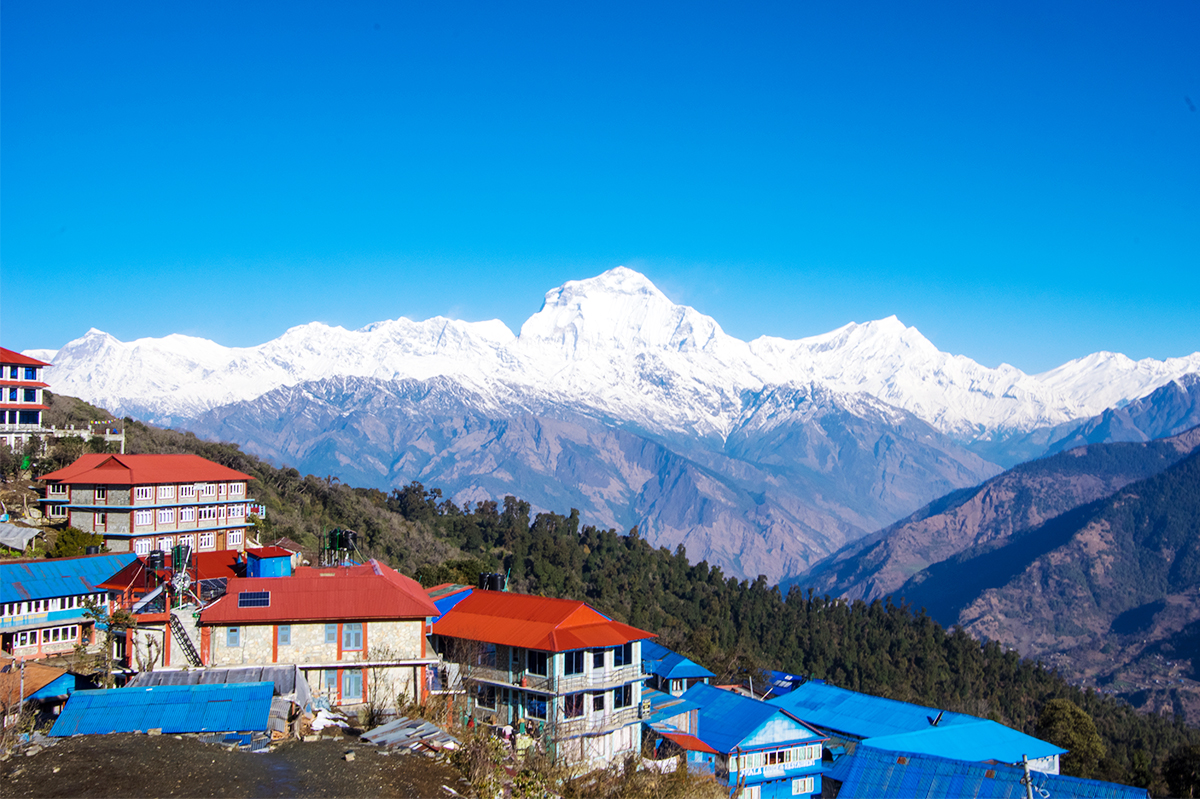
Major Highlights and Attractions of Ghorepani Poonhill Monsoon Trek:
- Experience the astonishing sunrise from the Ghorepani Poon Hill Viewpoint
- Pristine landscapes of Mt. Annapurna, Machhapuchhre, and Dhaulagiri
- The Annapurna region seems lush and green and exclusively incredible during monsoon
- Monsoon Season brings the waterfalls to life leaving a fresh breezing experience
- Experience the Gurung Village and hospitality in Ghandruk
Trekking Preparations for Monsoon Season in Nepal
Physical fitness requirements.
Physical fitness is a common requirement for trekking in Nepal, especially during monsoon seasons, it is highly expected for you to meet the physical requirement as the trails get muddy and slippery, and also to ensure that you enjoy your trek in comfort and safety.
You can do different cardiovascular exercises and some muscle-strengthening exercises for your hands and legs. It is also important for you to acclimatize at higher altitudes in order to prevent or lessen the risk of altitude sickness.
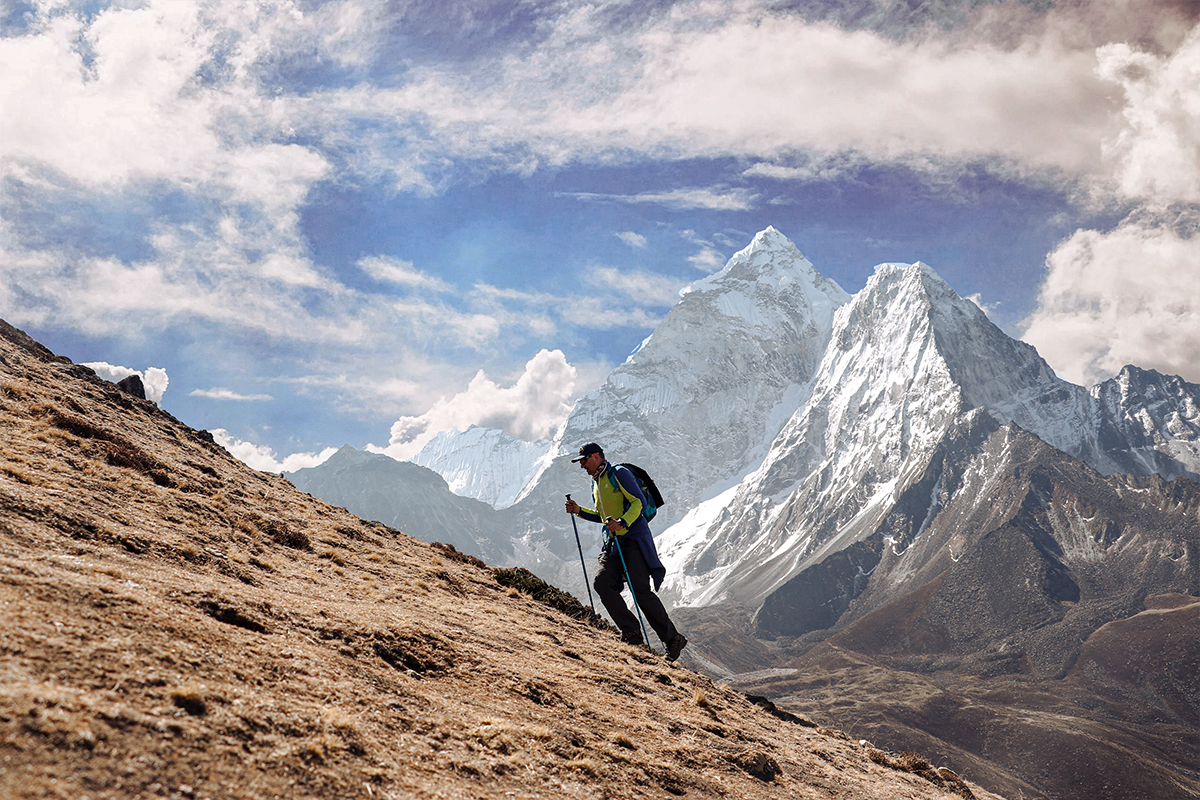
Necessary gear and equipment
Having good gear during trekking is very important. Especially during monsoon, the weather can be very unpredictable so you need to be careful about each and every gear and item you pack. The followings are the essential Monsoon Trekking Gear Checklist you need during trekking in Nepal in Monsoon Season:
- Sturdy Trekking Boots
- Raincoats and backpack covers
- Quick drying clothes
- Trekking poles
- Sleeping bag
- Water purifying tablets
- Headlamp
- Waterproof jackets
- Salt (To prevent leeches and worms)
Permits and fees
Either monsoon or any other season, you need to have trekking permits to enter the restricted areas for trekking in Nepal. The permits vary according to the region you choose to trek.
- National Park/ Conservation Area Permit
- Rural Municipality Permit
- Restricted Area Permit
According to the Nepal Tourism Board, you must obtain the necessary permits to trek in Nepal, so you can choose a local travel agent like Footprint Adventure for your adventure in Nepal who can help you with all the necessary permits and requirements to trek in Nepal.
To know more about new rules and regulations on the requirements of trekking permits in Nepal, click here.
Plan your route according to the weather
Planning a trek in Nepal during Monsoon can be a challenging and equally rewarding experience. Besides, you need to be extremely careful and know every day's weather conditions and plan your trek according to them. You need to be very flexible with your itinerary during monsoon as the weather can be very unpredictable during monsoon. The best advice during trekking in monsoon season is to start your trek early in the morning to avoid heavy rainfall, landslides, or floods.
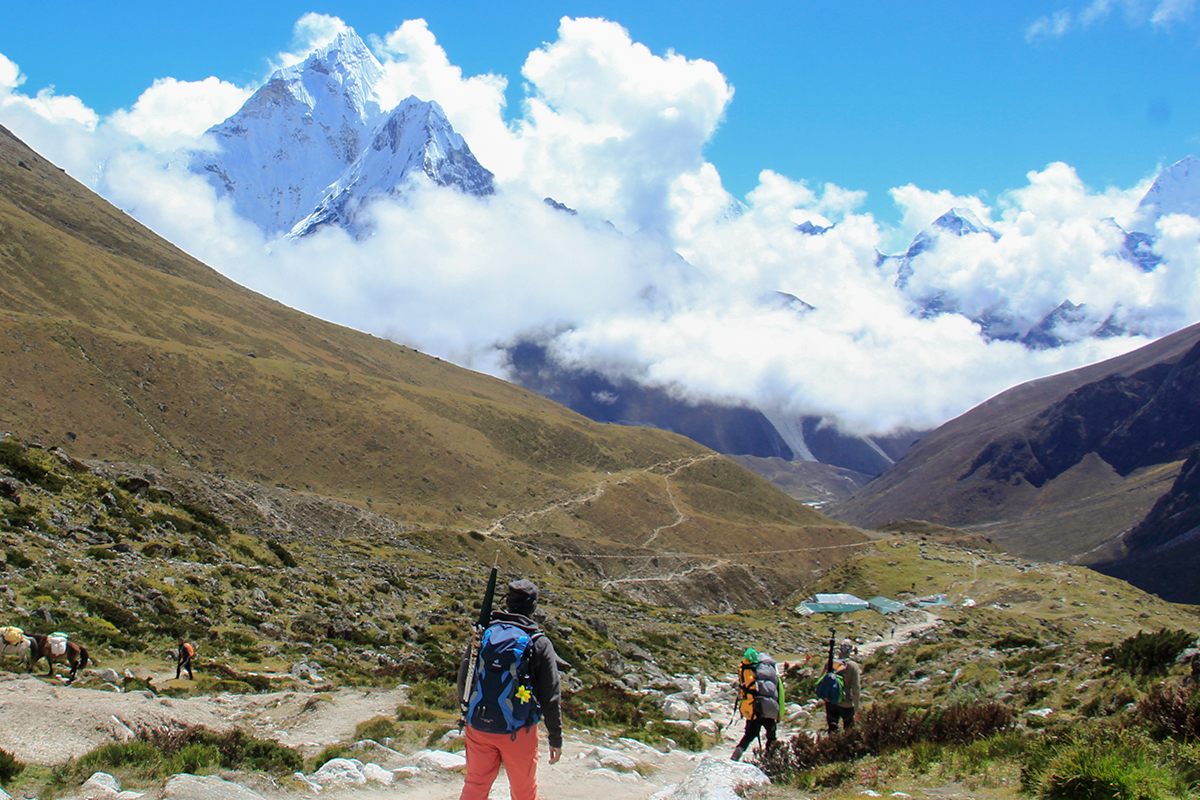
Hire a guide or porter
As per the recent announcement of NTB, you must hire a guide or a porter from a registered local agency of Nepal to lessen the risk of getting lost and extra safety to foreigners trekking in Nepal. During monsoon season, it is highly recommended to hire a guide as the trails can sometimes be dangerous due to floods and landslides where you might need a guide to help you with the trails and can give insights into the local cultures and traditions of the region.
Accommodations and food
Although monsoon is an off-season for trekking in Nepal, you need to know that people are starting to choose monsoon for trekking in Nepal to avoid crowded trails so it is always the best option to book your accommodations before your trek. Most of the tea houses and lodges serve Nepali cuisine on the trails of Nepal. However, you can choose any type of food on the menu according to your preference and convenience.
Tips for Safe and Enjoyable Trekking in Monsoon Season in Nepal
Start early to avoid heavy rainfall.
Heavy rainfall is common during monsoon season in Nepal, the rainfall gets worse during the day so it is always a good idea to start your trek early in the morning to avoid getting wet in heavy rainfall.
Starting early would be helpful for you to navigate the trail if needed. However, the weather can be unpredictable during the monsoon, so always check the weather forecasts before you start the trek.
Hygiene and health tips
Maintaining good hygiene and taking care of your health are very important during monsoon season as you might easily get sick. You need to stay hydrated throughout the trekking days and eat enough carbs.
Take care of your hygiene, wash your hands frequently, and avoid drinking water from natural resources.
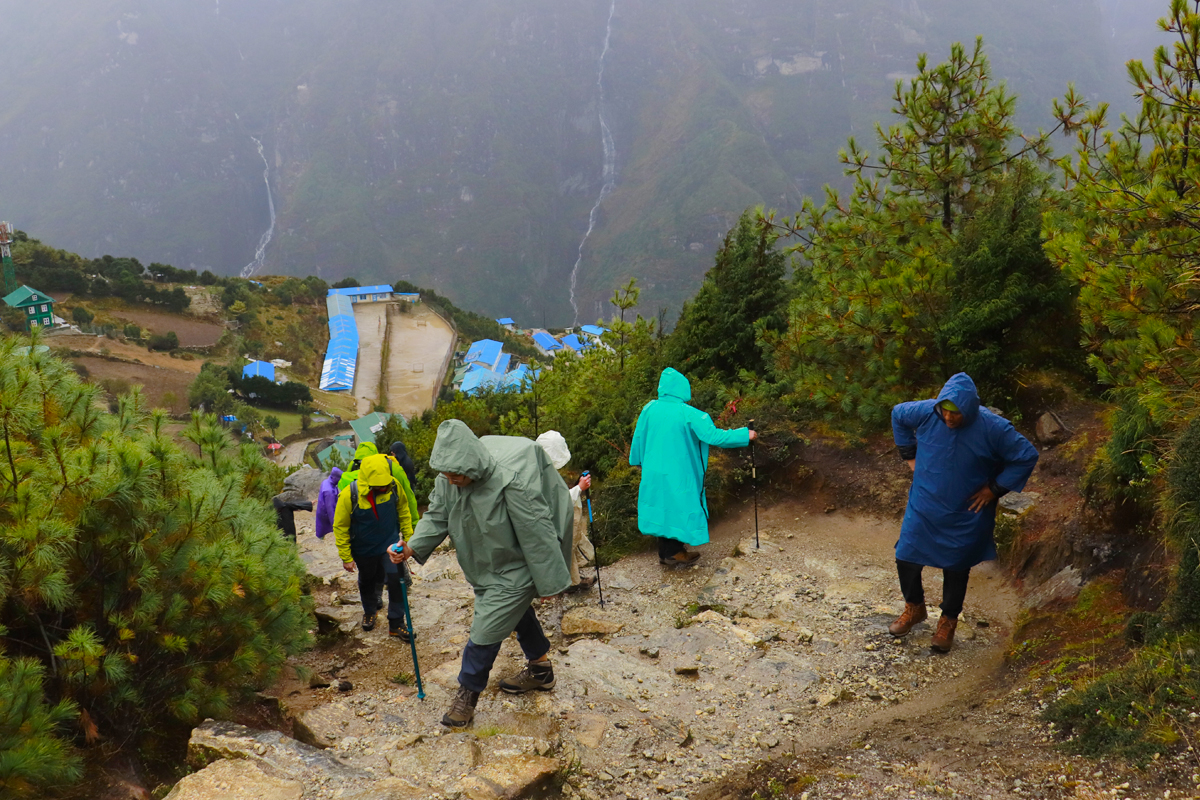
Be prepared for leeches
Leeches are a common problem during trekking in monsoon season so you need to be prepared for leeches and other insects. Leeches are blood-sucking parasites that attach to your skin and suck your blood, and can also transmit infections.
Followings are the tips you need to know about leeches when trekking during monsoon seasons:
- Use leech repellents
- Check yourself regularly
- Use salt (best natural leech repellents)
- Wear appropriate clothes
- Learn to remove leeches
Cultural Norms and Customs
As you will be trekking in a different country, you need to be very respectful of the cultural norms and values of the country and locals. You need to be careful while taking pictures, always ask for permission before taking any photographs. The locals you find in the trekking region are more polite, and kind and are always willing to serve you with their hospitality. Although tipping is not compulsory in Nepal, your appreciation is always accepted.
Add extra days to your schedule
Weather can be very unpredictable during the monsoon, so it is always good advice to check the weather forecast before starting the trek. Also, be flexible with your itinerary during monsoon as you might need extra days due to possible natural disasters like floods, landslides, or mudslides during monsoon.
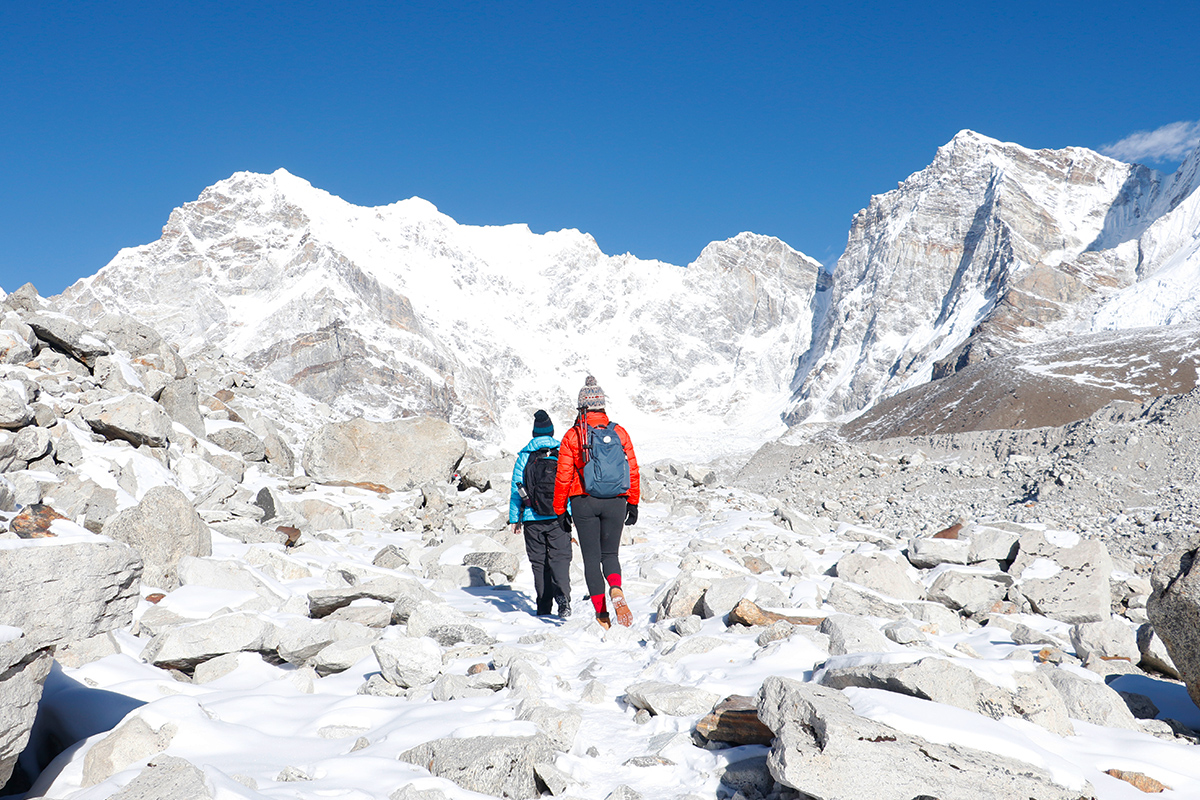
Take extra precautions against water-borne diseases
There is an increased risk of water-borne diseases during the monsoon season in Nepal. Always drink purified water, or carry water purifying tablets with you and avoid eating uncooked or raw foods, always wash your fruits before eating. Wash your hands frequently during monsoon season to prevent water-borne diseases.
Frequently Asked Questions (FAQs)
When is the monsoon season in nepal.
Monsoon season in Nepal starts from mid-June to September. Monsoon season is also regarded as off-season for trekking in Nepal due to possible natural disasters like floods, landslides, or mudslides. Trekking in Nepal during monsoon can be a challenging and equally rewarding experience due to the less crowded trails and tea houses. You can also experience the lush green and blooming flowers throughout the trail with a beautiful and vibrant rainwashed landscape.
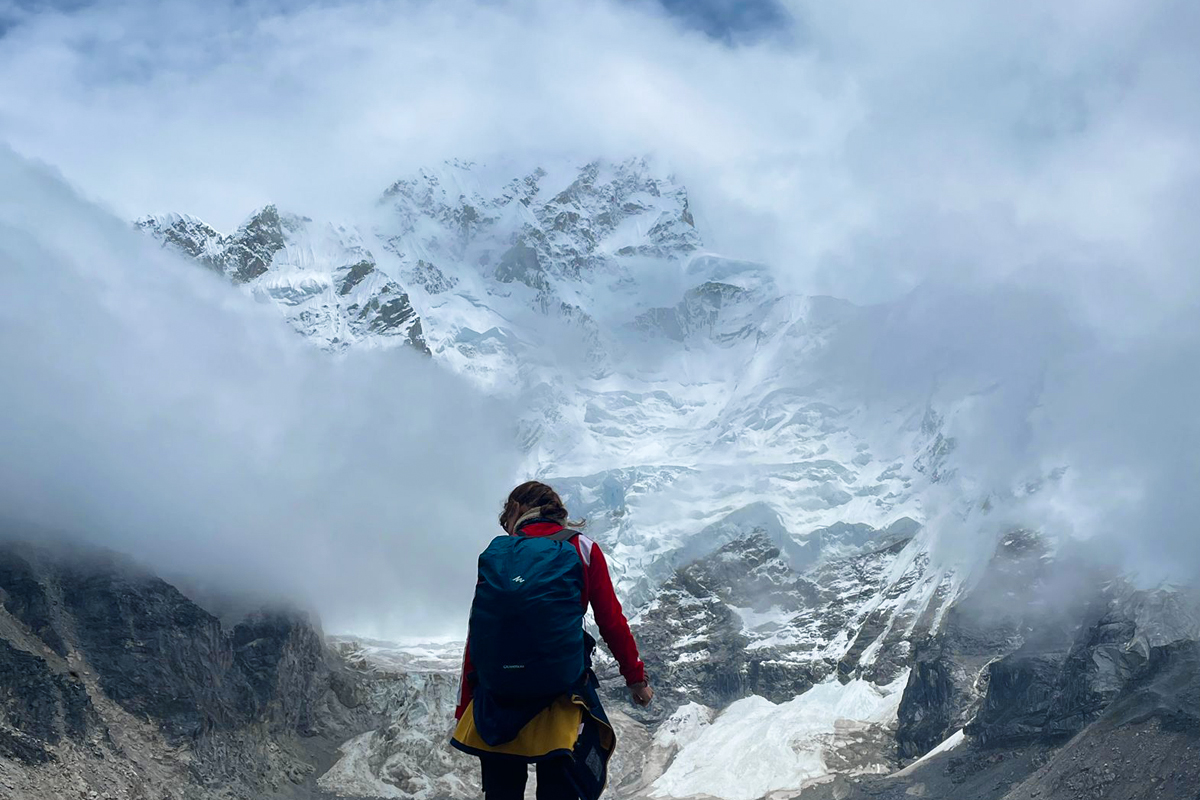
Which are the best months to trek in the monsoon season?
Trekking during monsoon can be challenging due to slippery trails but, some regions in Nepal are worth visiting during monsoon. The best times to trek in Nepal are from mid-June to August when the rainfall is not as heavy and the trails are easily passable.
What are the most popular monsoon treks in Nepal?
Usually Spring and Autumn are the best recommended seasons for trekking in Nepal, however, if you are looking for empty and peaceful trails, then the monsoon season is the one for you. Although trekking in Nepal during the monsoon can be challenging, there are still popular monsoon treks that are possible and rewarding treks. Followings are the most popular monsoon treks of Nepal:
- Nar Phu Valley and Kangla Pass Trek
- Upper Mustang Trek
- Everest Base Camp Trek
- Annapurna Circuit Trek
- Langtang Valley Trek
- Ghorepani Poonhill Trek
- Mardi Himal Trek
- Upper Dolpo Trek
It is always recommended to check weather forecasts before you plan your trek. Check out the link here, to learn about weather and climate in Nepal.
What are the physical fitness requirements for a monsoon trek in Nepal?
Physical fitness is a common requirement for trekking in Nepal, especially during monsoon seasons, it is highly expected for you to meet the physical requirement as the trails get muddy and slippery, and also to ensure that you enjoy your trek in comfort and safety. You can train your body with cardiovascular exercises and do strength workouts for strong legs. You also need to be flexible during monsoon trekking in Nepal as you cannot predict the muddy and slippery trails.
What gear and equipment do I need for a monsoon trek in Nepal?
Having good gear during trekking is very important. Especially during monsoon, the weather can be very unpredictable so you need to be careful about every gear and item you pack. The following is the essential Monsoon Trekking Gear Checklist you need during trekking in Nepal in the Monsoon Season:
You can also check the link here, to learn about the trekking packing list in detail.
Can I trek alone in monsoon season or do I need a guide?
No, according to the recent announcement of NTB, solo trekking is banned in Nepal due to possible safety risks for the trekkers. NTB has banned FITs ( Free Individual Travellers) to prevent the risk of losing trekkers in restricted areas.
NTB has now mandated to hire of a licensed guide or a porter from a registered travel agency in Nepal for trekking in Nepal. To know more about the importance of choosing a local travel agent, click here.
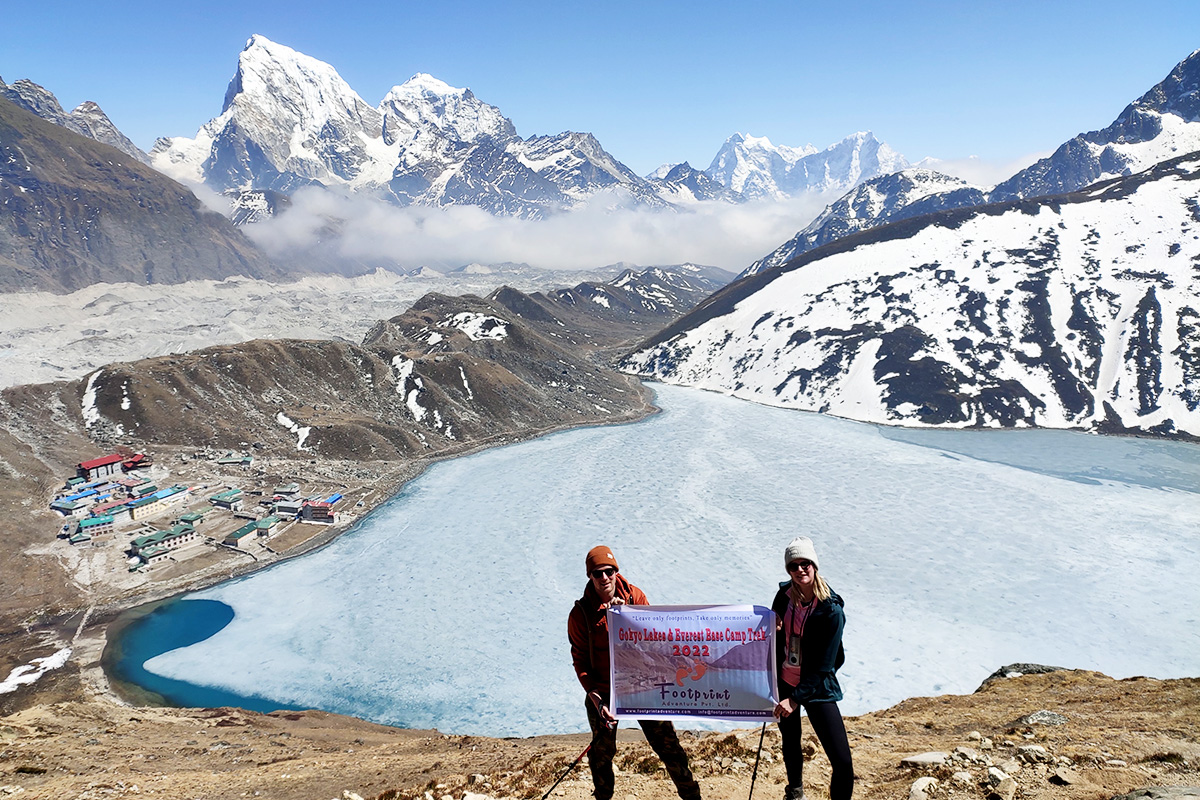
What are the safety precautions to take during a monsoon trek in Nepal?
It is very important to take enough safety measures when trekking during monsoon season to avoid potential risks of natural disasters, or you getting sick. Here are some safety precautions you can apply during monsoon trekking in Nepal:
- Drink enough water and eat enough carbs
- Buildup your cardio fitness
- Plan your trek according to the weather forecasts
- Learn to acclimatize and rest
- Avoid trekking alone
- Start early to avoid rainfall
What are some cultural norms and customs to be aware of during a monsoon trek in Nepal?
As you will be trekking in a different country, you need to be very respectful of the cultural norms and values of the country and locals. You need to be careful while taking pictures, always ask for permission before taking any photographs.
The locals you find in the trekking region are more polite, and kind and are always willing to serve you with their hospitality. Although tipping is not compulsory in Nepal, your appreciation is always accepted.
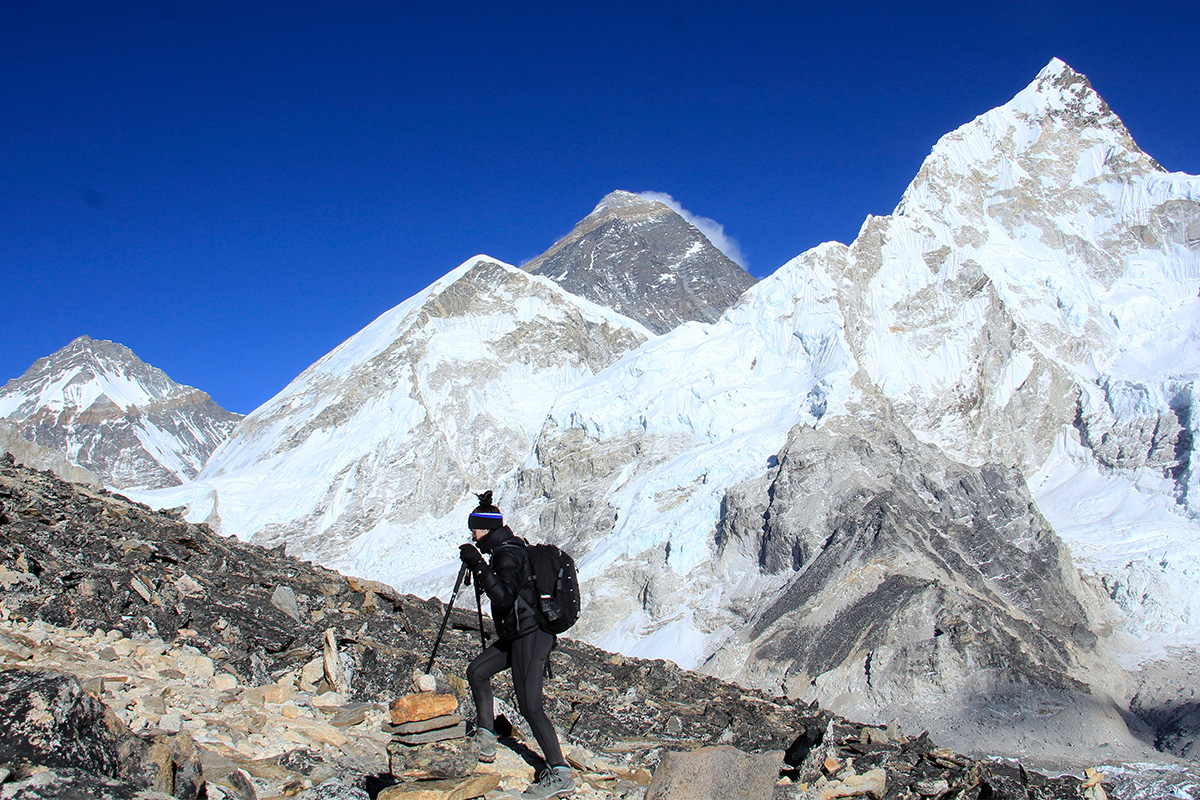
Lastly, you need to choose a perfect season and trek according to your availability and preference. Monsoon Trek is a challenging and equally rewarding trek that is less crowded with trails and tea houses. You can also experience the lush green and blooming flowers throughout the trail with a beautiful and vibrant rainwashed landscape.
Footprint Adventure is a leading travel agency that has been in the trekking field since 2015 with extremely good reviews, you can always contact us for any queries about trekking in the Monsoon season or others. We can help you with all the necessary permits and special guidance for monsoon treks in Nepal.
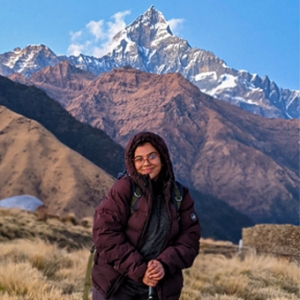
Ashmita Thapa
Ashmita is a content writer at Footprint Adventure with a really positive outlook on life. She is dedicated to exploration, and enjoys going on hikes and treks. She is delighted to travel and explore the beauty of Nepal with Footprint Adventure. She genuinely believes in promoting her native country in whatever manner she can, with the goal of making the biggest possible contribution to the travel and tourism sector.
Ashmita adds that she is extremely appreciative of Footprint Adventure for offering her the opportunity to learn more about travel and tourism. She would also like to grow here with more dedication and effort for the company. She also values the chance to meet new people, explore various regions and cultures, and broaden her knowledge about travel and tourism in Nepal.
"Self-improvement comes through change. Push yourself to the places you've never been before"
- Top 10 Best Treks In Nepal
- Photography
- Biodiversity
- Best Place in Nepal
- Popular Trekking in Nepal
- Restricted Area
- Conservation Area
- Information
Send an Enquiry
Recent posts.
- Culture Shock in Nepal: Knowing Nepalese Life's Perspective
- Indra Jatra: Yenyã Punhi - The Biggest Jatra in Nepal
- Complete Guidebook for Ruby Valley Trek 2024/2025
- Thimphu Tsechu Festival in Bhutan 2024| Footprint Adventure
- Where is Kilimanjaro? - Footprint Adventure
- Boudhanath Stupa- The Largest Spherical Stupa in the World
Related Posts
- Tengboche Monastery: A Spiritual Oasis in Khumbu Region of Nepal
- Kalapatthar : The Ulimate View Point in the Everest Base Camp Trek
- Accommodations
- Adventure Sports
- Adventure Tourism
- Cultural & Historical
- Festivals & Events
- Food and Taste
- Heritage Sites
- National Parks & Conservation Areas
- News & Events
- Places To Visit
- Sustainable Tourism
- Temples & Monasteries
- Things To Do
- Uncategorized
- UNESCO World Heritage Sites
We use cookies to ensure that we give you the best experience on our website.

Best Monsoon Treks in Nepal
By embracing the unique beauty and challenges of trekking in Nepal during the monsoon season and following the essential safety guidelines, you can enjoy a memorable and life-changing experience in the majestic Himalayas.
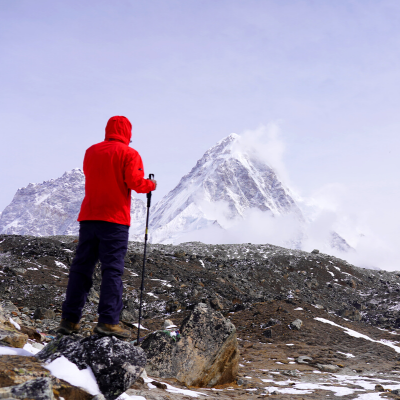
Nestled between the towering peaks of the Himalayas, Nepal is a paradise for adventure seekers and nature enthusiasts alike. With its rich cultural heritage, diverse landscapes, and some of the highest peaks in the world, including the iconic Mount Everest, Nepal has become a popular trekking destination for travelers across the globe. The country offers a wide array of trekking routes, catering to all levels of experience and fitness, making it an ideal destination for a life-changing adventure.

Monsoon Season in Nepal and its Impact on Trekking:
The monsoon season in Nepal typically spans from June to September, bringing heavy rainfall, increased humidity, and frequent cloud cover to the region. While this season is often seen as less desirable for trekking due to the challenging weather conditions, there are still a few trails that remain accessible and rewarding during this time. In fact, the monsoon season offers its own unique charms, such as lush green landscapes, fewer crowds, and a more authentic glimpse into the daily lives of the local people.
Purpose of the Article:
The purpose of this article is to provide a detailed guide on the best monsoon treks in Nepal, highlighting the distinctive experiences they offer, as well as the necessary preparations and precautions to take for a safe and enjoyable trekking experience. By showcasing the beauty and adventure of these lesser-known trails, we aim to inspire travelers to embark on an unforgettable journey through Nepal's breathtaking landscapes during the monsoon season.
Table Of Content
Monsoon season characteristics.
The monsoon season in Nepal is marked by a distinct set of characteristics that can impact the trekking experience. Understanding these features will help trekkers prepare for the unique challenges and opportunities presented during this time of year.
Typical Duration (June to September):
The monsoon season typically lasts from June to September, with the heaviest rainfall occurring in July and August. During these months, the country experiences a significant increase in precipitation, transforming the landscapes into lush, green vistas.
Weather Conditions:
Heavy rainfall: As the monsoon sets in, Nepal experiences torrential downpours on a regular basis. The heavy rainfall can cause trails to become muddy and slippery, making it essential for trekkers to exercise caution and wear appropriate footwear.
Occasional landslides: The increased rainfall can also trigger landslides, particularly in the steep and unstable terrains. It is crucial to stay updated on local weather conditions and follow the advice of experienced guides to ensure safety.
Limited visibility: The monsoon clouds often cloak the high peaks, resulting in limited visibility. This can make it difficult to enjoy the stunning views typically associated with trekking in Nepal. However, on clear days, the monsoon can also bring crisp, clean air and dramatic, cloud-shrouded vistas.
Advantages of Trekking During Monsoon Season:
Trekking during the monsoon season in Nepal may present challenges, but it also offers some unique advantages that can make the experience worthwhile and memorable. Some of the benefits of trekking during this time include:
Lush Landscapes:
The monsoon rains bring life to Nepal's flora and fauna, transforming the landscapes into verdant valleys, vibrant wildflowers, and thriving ecosystems. The lush greenery provides a breathtaking backdrop for trekkers, offering a different perspective compared to the drier months.
Fewer Crowds:
As many trekkers avoid the monsoon season, trails are often less crowded, allowing for a more peaceful and immersive experience. This also means that popular teahouses and lodges are less busy, providing a more intimate and relaxing atmosphere after a long day of trekking.
Authentic Cultural Encounters:
With fewer tourists around, the monsoon season offers a more authentic glimpse into the daily lives of the local people. This can lead to richer cultural exchanges and a deeper understanding of Nepal's diverse communities and traditions.
Lower Costs:
During the monsoon season, there may be lower prices for accommodations and other services due to decreased demand. This can make trekking more affordable and accessible for budget-conscious travelers.
Unique Wildlife Experiences:
The monsoon season is a time of rejuvenation for Nepal's wildlife. As the landscapes become more fertile, many species of animals become more active, providing unique opportunities for wildlife enthusiasts to witness a thriving ecosystem.
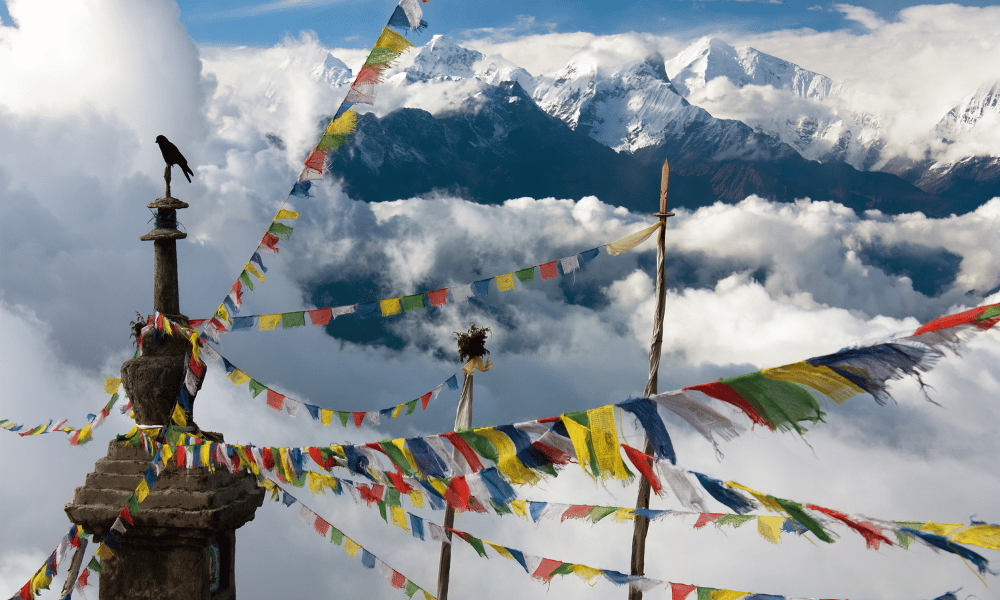
Dramatic Sceneries:
While the monsoon clouds can sometimes limit visibility, they also create dramatic and mesmerizing sceneries when the skies clear. The interplay between clouds, light, and mountains can result in unforgettable views that are distinctly different from those experienced in the dry season.
While trekking during the monsoon season requires careful planning and preparation, the unique advantages it offers can make it a truly rewarding experience for adventurous and flexible travelers.
Precautions and Considerations
Not all trekking routes are suitable for monsoon trekking, as some may be more prone to landslides or difficult to navigate in heavy rain. It's crucial to choose trails that are less affected by the monsoon, such as those in rain-shadow areas or lower altitude treks with more stable terrain. Researching and consulting with experienced guides or trekking agencies can help in identifying the best monsoon treks.
Necessary Equipment and Clothing for Monsoon Treks:
Preparing the right gear is essential for a safe and comfortable monsoon trek. Some necessary items include:
Waterproof clothing: A high-quality rain jacket and rain pants are crucial for staying dry during downpours.
Waterproof backpack cover: This helps protect your belongings from getting wet.
Sturdy trekking shoes: Waterproof and breathable trekking shoes with good grip are necessary for navigating muddy and slippery trails.
Quick-drying clothing: Lightweight, moisture-wicking clothes can help you stay comfortable and dry more quickly.
Trekking poles: These provide extra stability on slippery trails.
Warm layers: Temperatures may drop during evenings, so it's essential to have warm clothing for layering.
Insect repellent: The monsoon season can bring an increase in insects, making repellent a useful addition to your gear.
Safety Measures and Guidelines for Trekking in the Monsoon Season:
Following safety measures can help ensure a successful and enjoyable monsoon trek:
Hire a knowledgeable guide: A local guide can help you navigate the trails, provide updates on weather conditions, and ensure you stay safe during the trek.
Stay updated on weather forecasts: Regularly check weather updates and plan your trekking days accordingly.
Avoid river crossings during heavy rainfall: Rivers can rise rapidly during monsoon rains, making crossings dangerous. Wait for the water levels to recede before attempting to cross.
Be prepared for delays: Landslides or heavy rain may cause delays or changes in your itinerary. Maintain flexibility in your schedule to accommodate these unforeseen events.
Start your trek early in the day: Rainfall is usually heavier in the afternoon, so starting your trek early can help you avoid the heaviest downpours.
Stay hydrated and maintain proper nutrition: Even though the temperatures may be cooler, it's essential to drink plenty of water and maintain a balanced diet to keep your energy levels high.
By taking these precautions and considerations into account, you can maximize your chances of a safe and enjoyable monsoon trekking experience in Nepal.
List of the Top 10 Monsoon Treks in Nepal
Upper mustang trek.
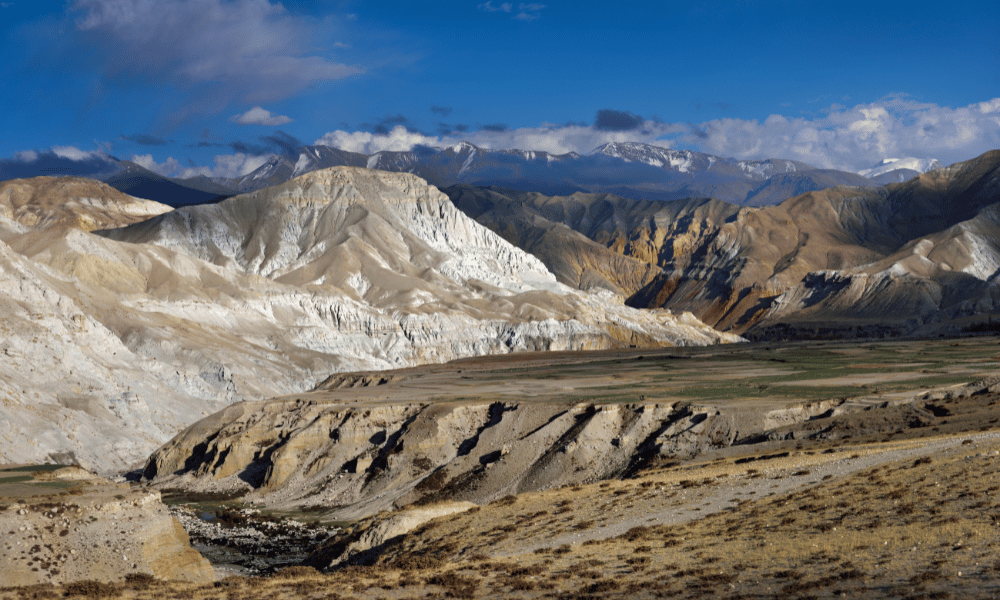
The Upper Mustang Trek takes you through the remote and arid region of Mustang in Nepal, which lies in the rain-shadow of the Annapurna and Dhaulagiri mountain ranges. This unique landscape remains relatively unaffected by the monsoon, making it an ideal trekking destination during this season. The trek offers an opportunity to explore the ancient Kingdom of Lo, characterized by its striking rock formations, centuries-old monasteries, and traditional Tibetan culture.
Key Highlights and Attractions:
Lo Manthang: The walled city of Lo Manthang is the cultural and political center of the Upper Mustang, where you can witness the traditional lifestyle of the locals and explore ancient monasteries.
Unique landscape: The Upper Mustang features a distinct arid landscape with colorful rock formations, caves, and cliffs, contrasting the lush greenery of other regions in Nepal.
Ancient monasteries: Visit centuries-old monasteries, such as Thubchen Gompa and Choser Cave Monastery, which hold significant cultural and religious importance.
Traditional Tibetan culture: Experience the rich Tibetan culture and heritage that has been preserved in this remote region, largely untouched by modern influences.
Tiji Festival: If your trek coincides with the annual Tiji Festival , usually held in May, you can witness the vibrant and colorful celebration that takes place in Lo Manthang.
Trekking Duration and Difficulty Level:
The Upper Mustang Trek typically takes around 12-16 days to complete, depending on your pace and acclimatization. The trek is considered moderate in difficulty, with daily walking distances of 4-6 hours on average. The highest point of the trek is at an altitude of 3,810 meters (12,500 feet) in Lo Manthang.
Tips for Trekking During the Monsoon Season:
Acquire the necessary permits: Upper Mustang is a restricted area, and trekkers need to obtain a special permit along with the Annapurna Conservation Area Permit (ACAP) and the Trekkers' Information Management System (TIMS) card.
Hire a guide: A knowledgeable local guide can help ensure a safe and enjoyable trekking experience, as they are familiar with the trails and can provide valuable insights into the region's culture and history.
Prepare for variable weather: Despite being in the rain-shadow, the Upper Mustang can still experience occasional rain during the monsoon. Pack waterproof clothing and gear to stay dry and comfortable.
Be mindful of altitude: The trek involves gradual ascents to high altitudes. Take your time to acclimatize properly and be aware of the symptoms of altitude sickness.
Respect local customs and culture: Upper Mustang is culturally sensitive, and it's important to be respectful of local traditions and customs while interacting with the people and visiting religious sites.
By considering these tips and embracing the unique landscape and culture of the Upper Mustang, trekkers can enjoy a truly memorable experience during the monsoon season in Nepal.
Lower Dolpo Trek
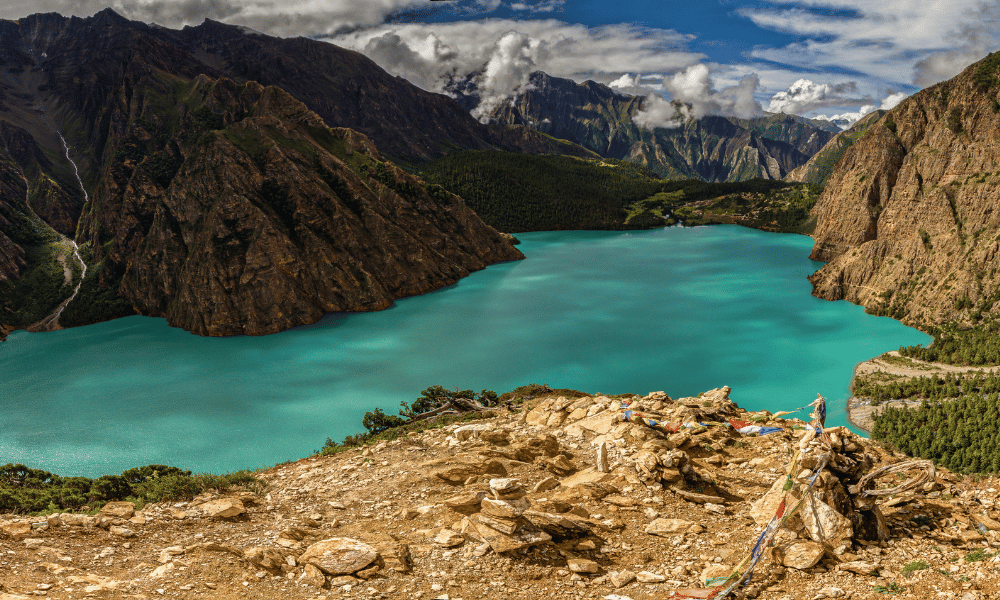
The Lower Dolpo Trek takes you through the remote and isolated region of Dolpo in western Nepal, which lies in the rain-shadow of the Dhaulagiri massif. This off-the-beaten-path trek offers a unique opportunity to experience the untouched natural beauty, diverse landscapes, and rich cultural heritage of this lesser-known region. The Lower Dolpo is a suitable trekking destination during the monsoon season due to its relatively drier conditions.
Phoksundo Lake: The pristine, turquoise Phoksundo Lake is a highlight of the trek, renowned for its stunning beauty and surrounding cliffs and forests.
Shey Gompa: Visit the ancient Shey Gompa, a significant monastery with historical and cultural importance, situated near the base of Crystal Mountain.
Diverse landscapes: The Lower Dolpo trek offers a range of landscapes, from lush forests and alpine meadows to arid cliffs and high mountain passes.
Traditional culture: Experience the unique and rich culture of the Dolpo people, who have maintained their traditional way of life in this remote region.
Wildlife: The region is home to diverse wildlife, including the elusive snow leopard, blue sheep, and Himalayan tahr.
The Lower Dolpo Trek typically takes around 18-21 days to complete, depending on your pace and chosen route. The trek is considered moderate to challenging in difficulty, with daily walking distances of 5-7 hours on average. The highest point of the trek is the Numa La Pass at an altitude of 5,190 meters (17,028 feet).
Obtain necessary permits: Trekkers are required to obtain a restricted area permit for Lower Dolpo, along with the Shey Phoksundo National Park entry permit.
Hire a guide and porter: A knowledgeable local guide can help ensure a safe and enjoyable trekking experience, while a porter can assist with carrying heavy gear and supplies.
Prepare for variable weather: Despite being in the rain-shadow, the Lower Dolpo can still experience occasional rain during the monsoon. Pack waterproof clothing and gear to stay dry and comfortable.
Acclimatize properly: The trek involves high-altitude passes and gradual ascents. Take your time to acclimatize properly and be aware of the symptoms of altitude sickness .
Respect local customs and culture: While interacting with the local people and visiting religious sites, it is essential to be respectful of their customs, traditions, and beliefs.
By considering these tips and embracing the natural beauty and unique culture of Lower Dolpo, trekkers can enjoy an unforgettable monsoon trekking experience in Nepal.
Nar Phu Valley Trek
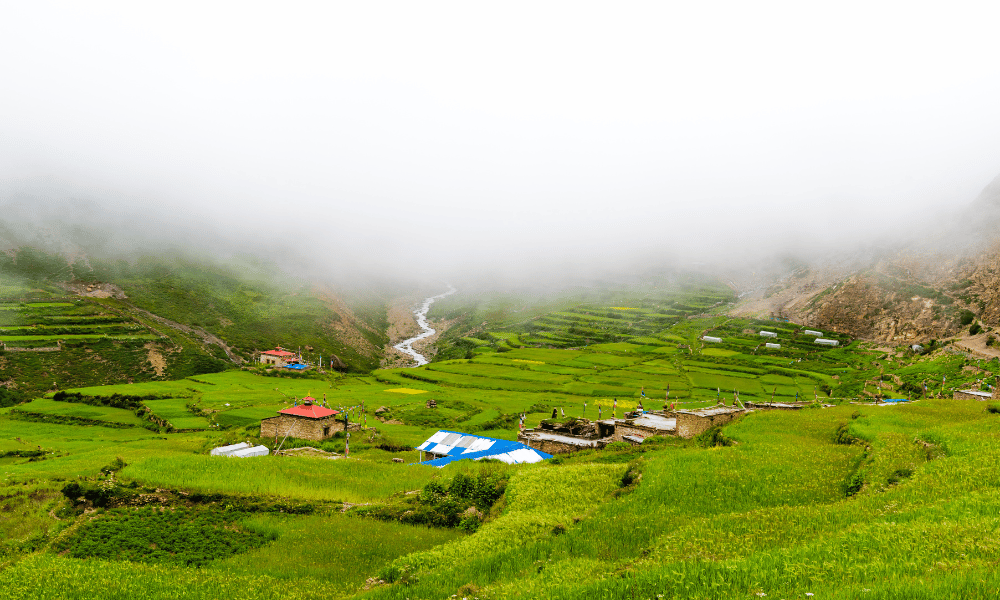
The Nar Phu Valley Trek takes you through the remote and hidden valleys of Nar and Phu in the Annapurna region of Nepal. This off-the-beaten-path trek offers a unique opportunity to explore the unspoiled landscapes, ancient villages, and the rich cultural heritage of the region. The Nar Phu Valley Trek is suitable for trekking during the monsoon season, as it lies in the rain-shadow of the Annapurna range.
Ancient villages: The trek takes you through the ancient and preserved villages of Nar and Phu, where you can witness traditional stone houses and the local way of life.
Unique landscape: The Nar Phu Valley features a range of landscapes, from lush forests and arid cliffs to high mountain passes and glacial valleys.
Tashi Lhakhang Gompa: Visit the historic Tashi Lhakhang Gompa, an important Buddhist monastery in the region.
Kang La Pass: Cross the challenging Kang La Pass at 5,320 meters (17,454 feet), which offers stunning panoramic views of the Annapurna massif and surrounding peaks.
Cultural experience: The region is home to the Tibetan-influenced Nar and Phu communities, allowing trekkers to immerse themselves in the unique culture and traditions.
The Nar Phu Valley Trek typically takes around 12-15 days to complete, depending on your pace and chosen route. The trek is considered moderate to challenging in difficulty, with daily walking distances of 5-7 hours on average. The highest point of the trek is the Kang La Pass at an altitude of 5,320 meters (17,454 feet).
Obtain necessary permits: Trekkers need to obtain a restricted area permit for the Nar Phu Valley, along with the Annapurna Conservation Area Permit (ACAP) and the Trekkers' Information Management System (TIMS) card.
Prepare for variable weather: Despite being in the rain-shadow, the Nar Phu Valley can still experience occasional rain during the monsoon. Pack waterproof clothing and gear to stay dry and comfortable.
Acclimatize properly: The trek involves high-altitude passes and gradual ascents. Take your time to acclimatize properly and be aware of the symptoms of altitude sickness.
By considering these tips and embracing the natural beauty and unique culture of the Nar Phu Valley, trekkers can enjoy a memorable monsoon trekking experience in Nepal.
Annapurna Circuit Trek
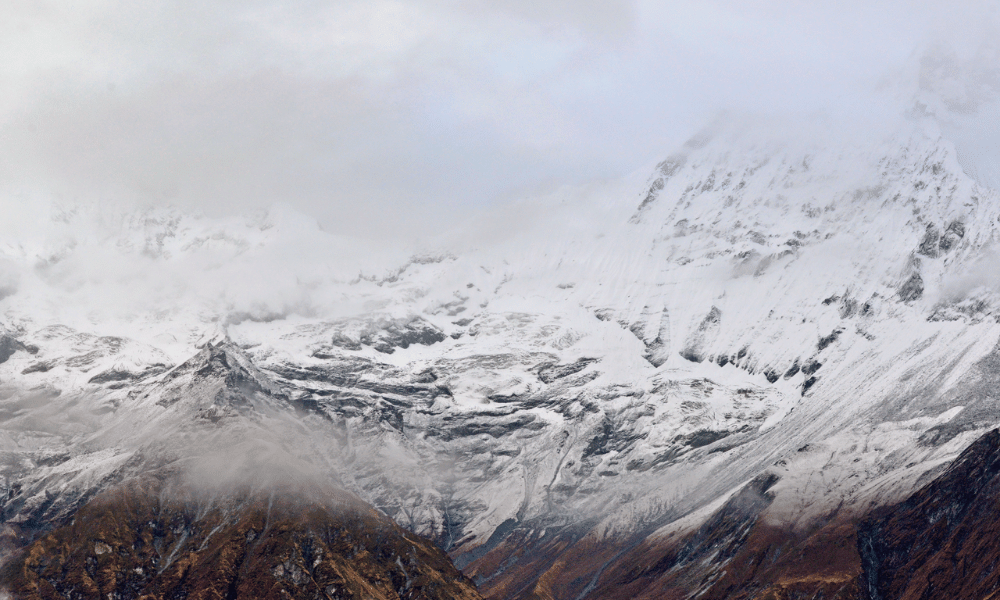
The Annapurna Circuit Trek is a classic and popular trek that takes you through diverse landscapes, ancient villages, and beautiful valleys in the Annapurna region of Nepal. The trek encircles the Annapurna massif, passing through various terrains, including subtropical forests, paddy fields, high alpine meadows, and arid deserts. While certain parts of the trek lie within the rain-shadow, other sections can be affected by the monsoon, so it's essential to plan accordingly.
Thorong La Pass: Cross the challenging Thorong La Pass at 5,416 meters (17,769 feet), the highest point on the trek, which offers panoramic views of the Annapurna massif and surrounding peaks.
Muktinath Temple: Visit the sacred Muktinath Temple, a significant pilgrimage site for both Hindus and Buddhists.
Manang Village: Experience the unique culture and traditions of the Manang people, who live in one of the most remote and picturesque valleys in the region.
Kali Gandaki Gorge: The trek takes you through the world's deepest gorge, the Kali Gandaki Gorge, which separates the Annapurna and Dhaulagiri massifs.
Diverse landscapes: The Annapurna Circuit Trek offers a variety of landscapes, from lush subtropical forests and terraced farmlands to high alpine meadows and arid deserts.
The Annapurna Circuit Trek typically takes around 12-21 days to complete, depending on your pace and chosen route. The trek is considered moderate to challenging in difficulty, with daily walking distances of 5-7 hours on average. The highest point of the trek is the Thorong La Pass at an altitude of 5,416 meters (17,769 feet).
Plan your route carefully: Certain parts of the Annapurna Circuit Trek are more affected by the monsoon than others. Consult with experienced guides or trekking agencies to plan the best route for the season.
Obtain necessary permits: Trekkers need to obtain the Annapurna Conservation Area Permit (ACAP) and the Trekkers' Information Management System (TIMS) card before embarking on the trek.
Prepare for variable weather: The weather can be unpredictable during the monsoon season, so pack waterproof clothing and gear to stay dry and comfortable.
By considering these tips and embracing the diverse landscapes and rich culture of the Annapurna Circuit, trekkers can enjoy a memorable monsoon trekking experience in Nepal.
Langtang Valley Trek
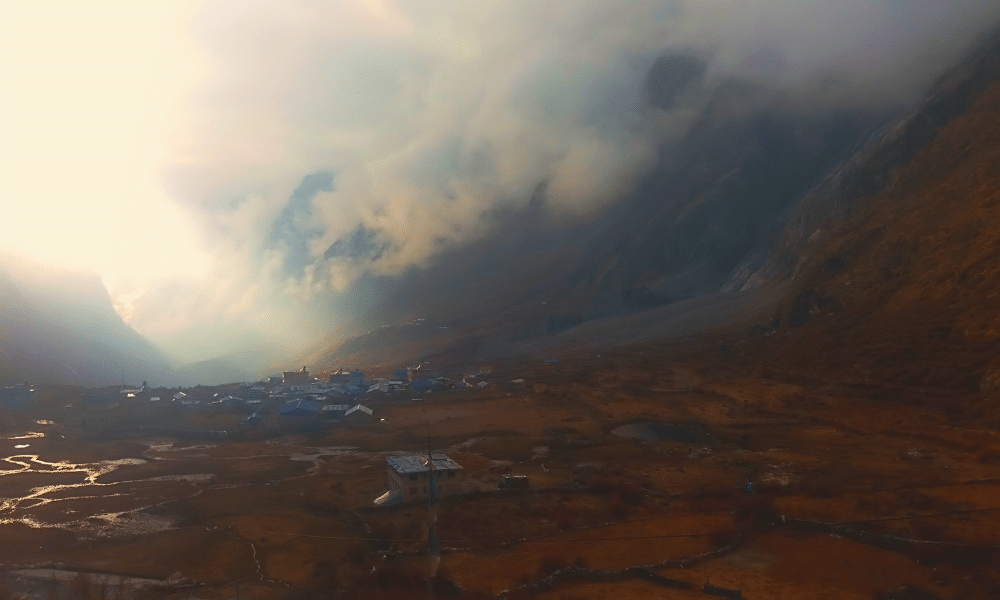
The Langtang Valley Trek takes you through the beautiful and diverse Langtang Valley, situated north of Kathmandu in Nepal. The trek offers a unique opportunity to explore the serene landscapes, lush forests, traditional Tamang villages, and the stunning mountain views of the region. While the Langtang Valley is not in the rain-shadow, it receives comparatively less rainfall than other regions, making it a possible trekking destination during the monsoon season with proper planning and preparation.
Kyanjin Gompa: Visit the ancient Kyanjin Gompa, an important Buddhist monastery in the region, and immerse yourself in the spiritual atmosphere.
Langtang Village: Explore the traditional Tamang village of Langtang, where you can witness the unique culture and traditions of the Tamang people.
Diverse landscapes: The Langtang Valley Trek offers a variety of landscapes, from lush forests and terraced farmlands to high alpine meadows and glaciers.
Wildlife: The region is home to diverse wildlife, including the endangered red panda, Himalayan tahr, and several bird species.
Mountain views: Enjoy the stunning views of the Langtang range, including Langtang Lirung (7,227 meters), Ganesh Himal (7,422 meters), and several other peaks.
The Langtang Valley Trek typically takes around 7-10 days to complete, depending on your pace and chosen route. The trek is considered moderate in difficulty, with daily walking distances of 4-6 hours on average. The highest point of the trek is at Kyanjin Ri (4,773 meters) or Tserko Ri (5,000 meters), depending on which viewpoint you choose to climb.
Plan your route carefully: Consult with experienced guides or trekking agencies to plan the best route and timing for your trek during the monsoon season.
Obtain necessary permits: Trekkers need to obtain the Langtang National Park entry permit and the Trekkers' Information Management System (TIMS) card before embarking on the trek.
Be cautious of landslides: Monsoon rains can cause landslides in some areas. Stay informed about the trail conditions and follow your guide's advice.
By considering these tips and embracing the natural beauty and unique culture of the Langtang Valley, trekkers can enjoy a memorable monsoon trekking experience in Nepal.
Rara Lake Trek
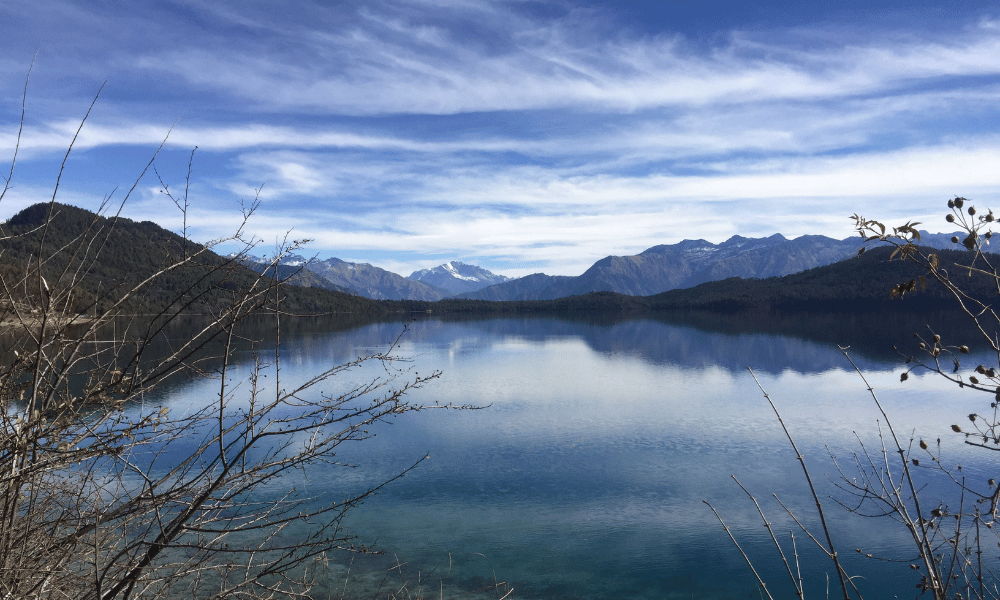
The Rara Lake Trek takes you through the remote and pristine region of western Nepal, culminating at the enchanting Rara Lake, the largest lake in Nepal. The trek offers a unique opportunity to explore the untouched natural beauty, diverse landscapes, and rich cultural heritage of the lesser-known region. The Rara Lake Trek is suitable for trekking during the monsoon season, as it lies in the rain-shadow of the Himalayas.
Rara Lake: The pristine Rara Lake is the centerpiece of the trek, renowned for its clear blue waters and the surrounding lush forests and snow-capped mountains.
Rara National Park: The trek takes you through the beautiful Rara National Park, home to diverse wildlife, including the endangered red panda, musk deer, and several bird species.
Traditional villages: Experience the unique culture and traditions of the local people living in remote villages along the trail.
Diverse landscapes: The Rara Lake Trek offers a range of landscapes, from lush forests and alpine meadows to arid cliffs and high mountain passes.
Off-the-beaten-path experience: Enjoy the tranquility and solitude of this less-traveled region, away from the crowds of more popular trekking routes.
The Rara Lake Trek typically takes around 10-14 days to complete, depending on your pace and chosen route. The trek is considered moderate in difficulty, with daily walking distances of 5-7 hours on average. The highest point of the trek is at an altitude of approximately 3,710 meters (12,172 feet) at Rara Lake.
Obtain necessary permits: Trekkers need to obtain a restricted area permit for the Rara Lake Trek, along with the Rara National Park entry permit.
Prepare for variable weather: Despite being in the rain-shadow, the Rara Lake region can still experience occasional rain during the monsoon. Pack waterproof clothing and gear to stay dry and comfortable.
By considering these tips and embracing the natural beauty and unique culture of the Rara Lake region, trekkers can enjoy an unforgettable monsoon trekking experience in Nepal.
Ruby Valley Trek
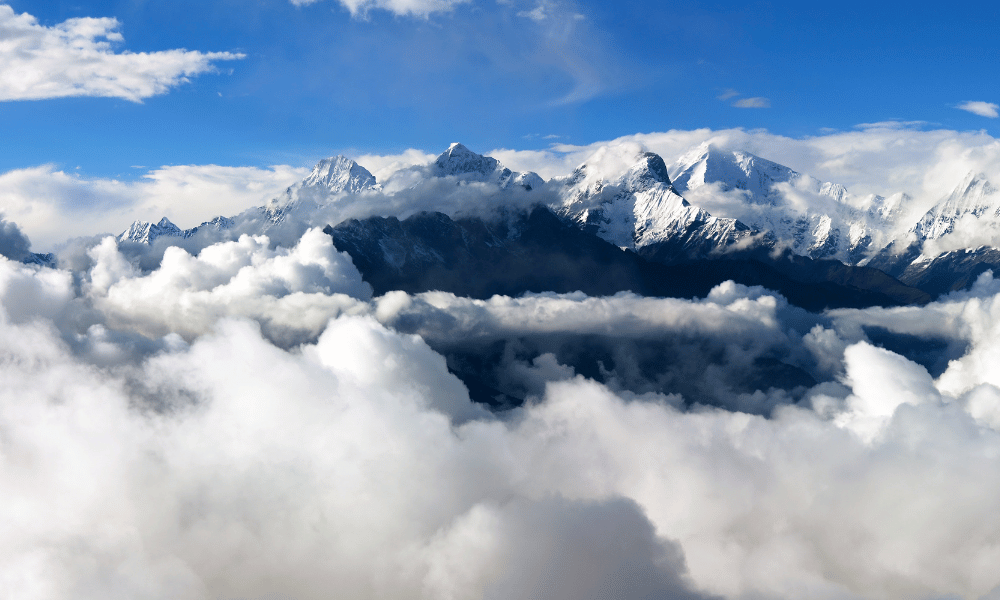
The Ruby Valley Trek is an off-the-beaten-path trekking experience that takes you through the picturesque Ganesh Himal and Ruby Valley regions of central Nepal. This lesser-known trek offers a unique opportunity to explore the untouched natural beauty, diverse landscapes, and rich cultural heritage of the Tamang and Gurung communities. Although not in the rain shadow, Ruby Valley Trek receives comparatively less rainfall than other regions during the monsoon season, making it possible to trek with proper planning and preparation.
Traditional villages: Visit traditional Tamang and Gurung villages along the trail, where you can witness their unique culture, traditions, and lifestyle.
Ganesh Himal: Enjoy the stunning views of the Ganesh Himal range, including Ganesh I (7,429 meters), Ganesh II (7,118 meters), and several other peaks.
Pangsang Pass: Cross the Pangsang Pass (3,842 meters), which offers panoramic views of the surrounding mountains and valleys.
Diverse landscapes: The Ruby Valley Trek offers a variety of landscapes, from terraced farmlands and lush forests to high alpine meadows and stunning valleys.
Local homestays: Experience the warm hospitality of the local people by staying in their homes and learning about their day-to-day life.
The Ruby Valley Trek typically takes around 10-14 days to complete, depending on your pace and chosen route. The trek is considered moderate in difficulty, with daily walking distances of 5-7 hours on average. The highest point of the trek is the Pangsang Pass at an altitude of 3,842 meters (12,605 feet).
Obtain necessary permits: Trekkers need to obtain the Trekkers' Information Management System (TIMS) card before embarking on the trek. Additional permits might be required depending on your chosen route.
By considering these tips and embracing the natural beauty and unique culture of the Ruby Valley, trekkers can enjoy a memorable monsoon trekking experience in Nepal.
Kanchenjunga Base Camp Trek
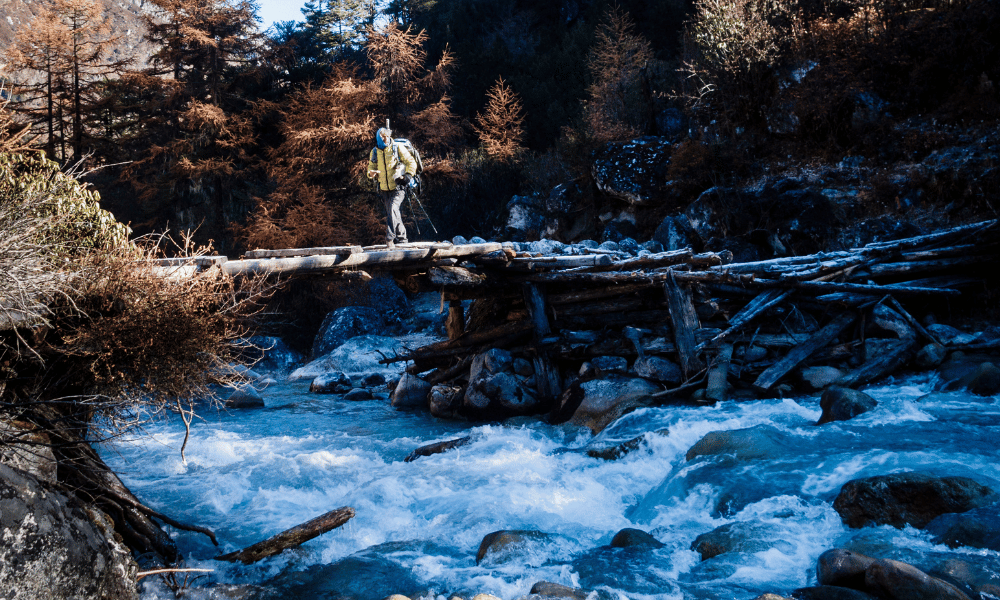
The Kanchenjunga Base Camp Trek is a remote and adventurous trekking experience that takes you to the base camps of the world's third-highest peak, Mount Kanchenjunga (8,586 meters). Situated in eastern Nepal, the trek offers a unique opportunity to explore the untouched natural beauty, diverse landscapes, and the rich cultural heritage of the local communities. The trek is challenging and less frequented by trekkers, providing a more authentic and off-the-beaten-path experience. During the monsoon season, the Kanchenjunga region receives significant rainfall, so proper planning and preparation are crucial.
Kanchenjunga Base Camps: Visit both the North and South Base Camps of Mount Kanchenjunga, offering close-up views of the impressive peak.
Diverse landscapes: The Kanchenjunga Base Camp Trek offers a variety of landscapes, from lush forests and terraced farmlands to high alpine meadows, glaciers, and stunning valleys.
Traditional villages: Experience the unique culture and traditions of the local Limbu, Rai, and Sherpa communities living in remote villages along the trail.
Kanchenjunga Conservation Area: Trek through the Kanchenjunga Conservation Area, home to diverse wildlife, including the snow leopard, red panda, and various bird species.
Panoramic mountain views: Enjoy breathtaking views of the Kanchenjunga massif and other Himalayan peaks, such as Makalu, Lhotse, and Everest.
The Kanchenjunga Base Camp Trek typically takes around 20-25 days to complete, depending on your pace and chosen route. The trek is considered challenging in difficulty due to its remoteness, high altitude, and long duration. Daily walking distances are about 6-8 hours on average. The highest point of the trek is at an altitude of 5,160 meters (16,929 feet) at Lapsang La Pass or 5,143 meters (16,873 feet) at Sele La Pass, depending on the chosen route.
Obtain necessary permits: Trekkers need to obtain the Kanchenjunga Conservation Area Permit (KCAP) and the Trekkers' Information Management System (TIMS) card before embarking on the trek.
Be cautious of landslides and flooding: Monsoon rains can cause landslides and flooding in some areas. Stay informed about the trail conditions and follow your guide's advice.
By considering these tips and embracing the natural beauty and unique culture of the Kanchenjunga region, trekkers can enjoy a memorable monsoon trekking experience in Nepal.
Pikey Peak Trek
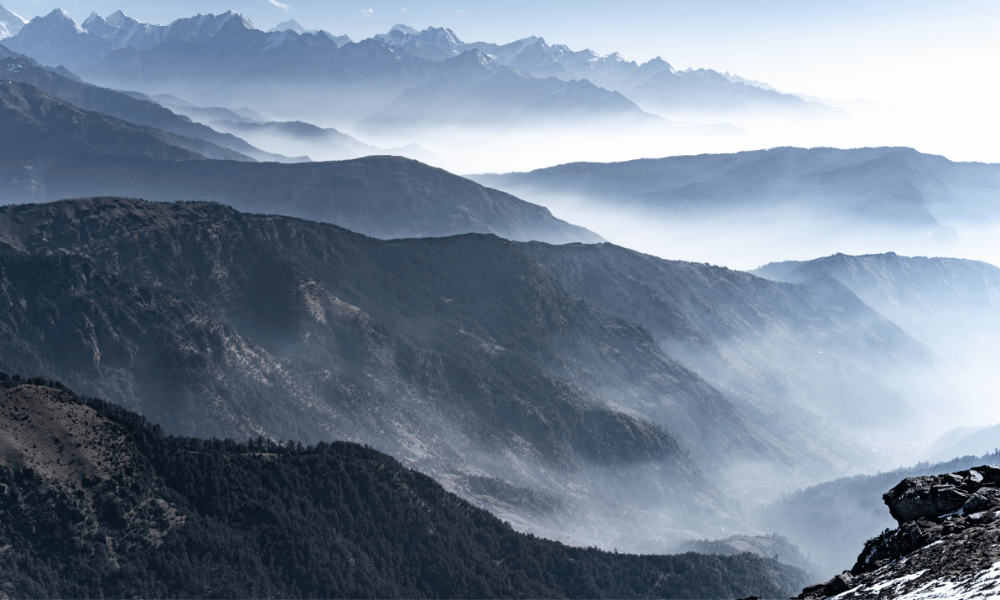
The Pikey Peak Trek is a short and relatively easy trek located in the lower Solu Khumbu region of eastern Nepal. It offers a unique opportunity to explore the cultural richness of the area, including monasteries and traditional Sherpa villages, while enjoying the stunning views of the Everest range and other surrounding peaks. Although not in the rain shadow, the Pikey Peak Trek receives comparatively less rainfall during the monsoon season, making it a possible trekking destination with proper planning and preparation.
Pikey Peak summit: Reach the summit of Pikey Peak (4,065 meters) and enjoy panoramic views of the Everest range, Makalu, Annapurna, and Kanchenjunga, among others.
Traditional Sherpa villages : Visit charming Sherpa villages, such as Junbesi and Taklung, and witness their unique culture, traditions, and lifestyle.
Thupten Chholing Monastery: Explore the Thupten Chholing Monastery, an important Buddhist pilgrimage site in the region, and immerse yourself in the spiritual atmosphere.
Rhododendron forests: During spring, the trek offers beautiful rhododendron forests, which bloom with vibrant colors.
Cultural experience: The Pikey Peak Trek offers a rich cultural experience, as it passes through various ethnic communities, including Sherpa, Magar, and Tamang people.
The Pikey Peak Trek typically takes around 6-8 days to complete, depending on your pace and chosen route. The trek is considered easy to moderate in difficulty, with daily walking distances of 4-6 hours on average. The highest point of the trek is the Pikey Peak summit at an altitude of 4,065 meters (13,337 feet).
By considering these tips and embracing the natural beauty and unique culture of the Pikey Peak region, trekkers can enjoy a memorable monsoon trekking experience in Nepal.
Helambu Trek
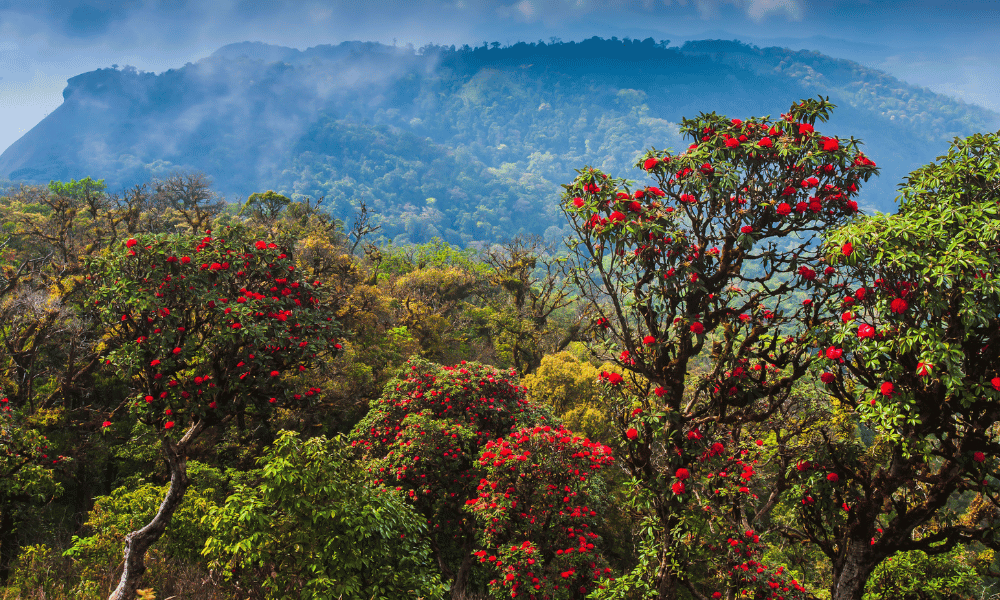
The Helambu Trek is a short and relatively easy trek located in the Langtang region of central Nepal, just north of Kathmandu Valley. The trek offers an opportunity to explore the cultural richness of the area, including traditional Tamang and Sherpa villages, and enjoy the beautiful landscapes of terraced fields, lush forests, and snow-capped mountains. The Helambu region receives significant rainfall during the monsoon season, so proper planning and preparation are crucial for trekking during this time.
Traditional villages: Visit traditional Tamang and Sherpa villages, such as Tarkeghyang and Sermathang, and witness their unique culture, traditions, and lifestyle.
Scenic landscapes: The Helambu Trek offers diverse landscapes, from terraced fields and lush forests to high alpine meadows and snow-capped peaks.
Ancient monasteries: Explore ancient monasteries, such as Tarkeghyang Monastery and Melamchi Ghyang Monastery, and immerse yourself in the spiritual atmosphere.
Accessibility: The trek's proximity to Kathmandu makes it easily accessible and an excellent choice for those with limited time.
The Helambu Trek typically takes around 7-10 days to complete, depending on your pace and chosen route. The trek is considered easy to moderate in difficulty, with daily walking distances of 4-6 hours on average. The highest point of the trek is Tharepati at an altitude of 3,650 meters (11,975 feet).
By considering these tips and embracing the natural beauty and unique culture of the Helambu region, trekkers can enjoy a memorable monsoon trekking experience in Nepal.
Trekking during the monsoon season in Nepal offers a unique opportunity to experience the beauty and challenges of the Himalayas in a different light. Lush landscapes, fewer crowds, and the chance to witness local cultural celebrations make monsoon treks an unforgettable adventure.
To ensure a successful monsoon trek, it is crucial to prepare adequately and follow safety guidelines. Some key considerations include:
Planning your route carefully and consulting with experienced guides or trekking agencies
Obtaining necessary permits and hiring a knowledgeable local guide and porter
Packing waterproof clothing and gear, as well as preparing for variable weather conditions
Being cautious of landslides and staying informed about trail conditions
Respecting local customs, traditions, and beliefs while interacting with local people and visiting religious sites
Acclimatizing properly and being aware of altitude sickness symptoms
Frequently Asked Questions
The monsoon season in Nepal typically begins in June and lasts until August, with the peak rainfall usually occurring in July.
Yes, it is possible to trek safely in Nepal during the monsoon season with proper planning, preparation, and adherence to safety guidelines. Some treks are more suitable for the monsoon season than others, especially those in rain-shadow areas.
The main challenges of trekking during the monsoon season include heavy rainfall, slippery trails, increased risk of landslides, occasional flooding, and limited visibility.
Some advantages of trekking during the monsoon season include lush landscapes, fewer crowds, lower trekking costs, and the opportunity to witness unique cultural celebrations and local flora.
For a monsoon trek in Nepal, pack waterproof clothing (such as a rain jacket and pants), sturdy trekking boots with good grip, quick-drying clothes, warm layers, waterproof backpack cover, and trekking poles for added stability.
While not mandatory for all treks, hiring a knowledgeable local guide is highly recommended for a monsoon trek in Nepal. A guide can help ensure a safe and enjoyable trekking experience, navigate challenging trails, and provide valuable insights into local culture and traditions.
Yes, most tea houses remain open during the monsoon season. However, some remote trekking routes may have fewer open teahouses, so it's essential to plan and consult with a guide or trekking agency about accommodation options.
To minimize the risk of landslides, choose a trek that is less prone to landslides during the monsoon season, stay informed about trail conditions, and follow your guide's advice. Avoid walking during or immediately after heavy rainfall, and stay on established trails.
To prevent leeches, wear long pants tucked into your socks, use insect repellent, and consider wearing leech socks. Regularly check for leeches and remove them safely if found.
To stay healthy during a monsoon trek in Nepal, drink only purified or boiled water, eat freshly cooked food, wash your hands frequently, and carry a first-aid kit with essential medicines. Be aware of the symptoms of altitude sickness and acclimatize properly during high-altitude treks.
BLOGS & TRAVEL STORIES
our first-hand Himalayan travel experience
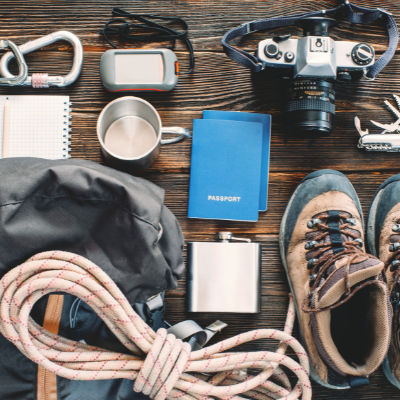
Travel Guides & Tips
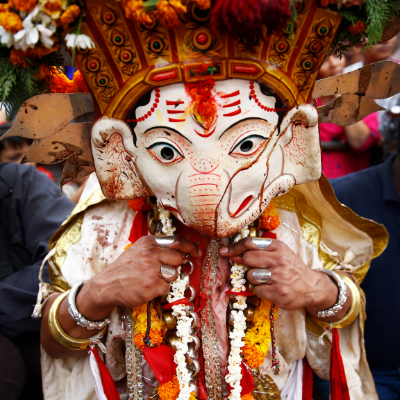
Culture and Festivals
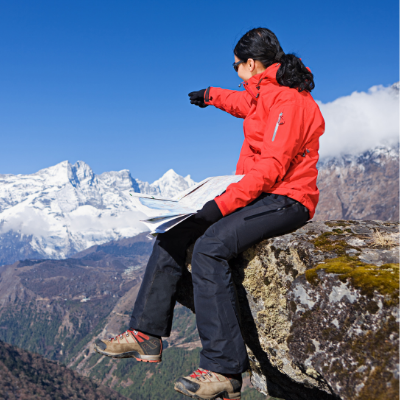
Travel Stories
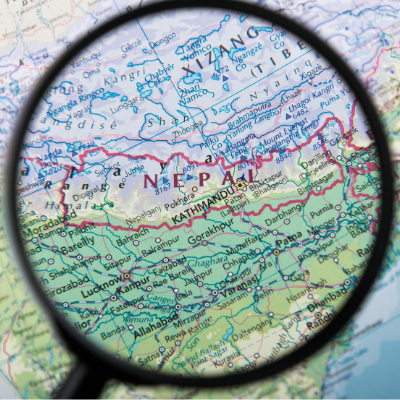
Latest Travel News
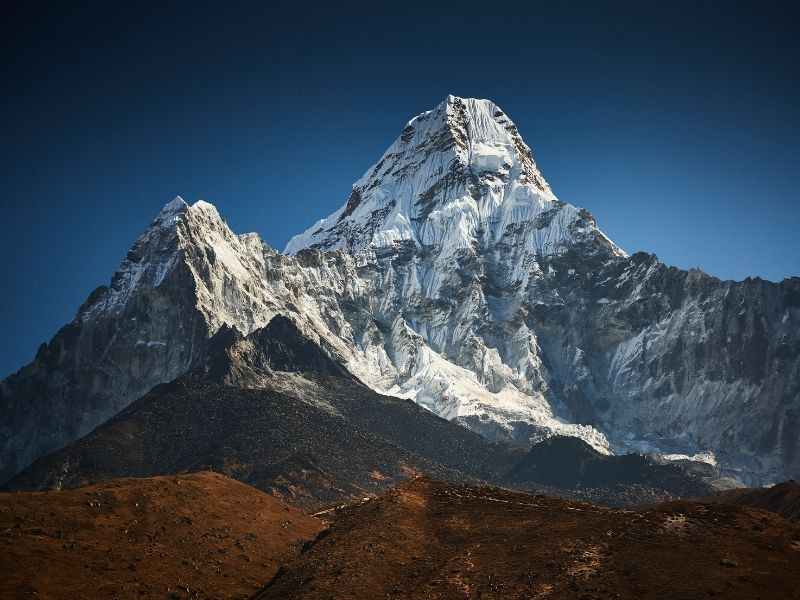
Mount Everest Region
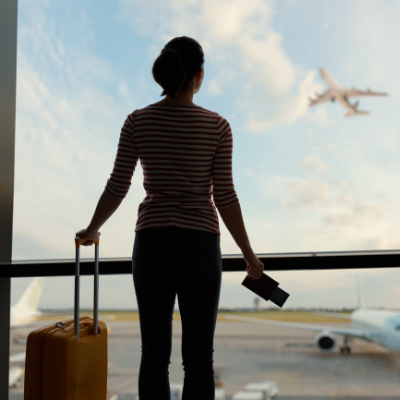
World Heritage Sites
Cookies & privacy policy.
This website uses cookies to improve your experience. Learn More
8 of the best places to visit in Nepal

May 22, 2024 • 7 min read

Experience the best of Nepal's stunning sacred sights and magnificent mountains © fotoVoyager / Getty Images
Nepal is small in size but it’s big on variety. Best-known for its mountains, the Himalayan nation also contains historic towns, wildlife-filled national parks, Hindu and Buddhist pilgrimage sites, tea fields and much more.
When planning your trip to Nepal , your main activities should determine your destinations. To trek, head to the mountains, naturally. But which mountains? Different regions offer different experiences, and are more or less challenging to reach from the main cities.
To help you choose, here’s a round-up of the top places to visit in Nepal, whether you want to do some gentle sightseeing or have more active plans.
1. Kathmandu Valley
Best for historic palaces and temples
Almost all trips to Nepal start in the Kathmandu Valley , and the capital region deserves plenty of time. Historically composed of several separate kingdoms — the most prominent being Kathmandu , Patan/Lalitpur , and Bhaktapur — nowadays, the roughly 25km-wide (15-mile) Kathmandu Valley is one big urban sprawl, with ever-diminishing farmland around the edges. The human history of the valley dates back millennia, and visitors can still see ancient temples and medieval palaces, and encounter traditional indigenous Newari culture, among the haphazard modern concrete constructions.
Of greatest interest to travelers are central Kathmandu, Patan, and Bhaktapur. These three ancient towns together comprise a UNESCO World Heritage Site, with seven different monument zones: the Durbar (royal) Squares of Kathmandu , Patan, and Bhaktapur, and the Hindu and Buddhist sites of Pashupatinath Temple , Boudhanath Stupa , Swayambhunath Stupa , and Changu Narayan . Note that although the first six are popular tourist destinations, far fewer people visit Changu Narayan, on the north-eastern edge of the Kathmandu Valley, so head there to avoid the hustle in peak season.
Planning tip: Despite common misconceptions, Kathmandu isn’t all that high, at 1400m (4600ft); you’re extremely unlikely to feel any effects of altitude, and the weather leans hot more often than not, especially between March and October.
Ready to go? Here's our seasonal guide to the best time to visit Nepal

2. Solukhumbu District
For the mighty mother mountain Sagarmatha, aka Mt Everest
When the weather is really, really clear, and if you know exactly where to look, you may be able to get a glimpse of a sliver of Mt Everest (Sagarmatha in Nepali, Chomolongma in Sherpa) from Kathmandu. Otherwise, you’ll need to head to the Solukhumbu District, north-east of the capital, to see the world’s highest mountain.
There’s no road to Everest (on the Nepal side of the border) so most people embarking on the Everest Base Camp trek in the Solukhumbu District fly from Kathmandu to Lukla, a village a few days’ walk from the mountain. Solukhumbu contains the Sagarmatha National Park, and is mostly home to Sherpa people, who have a distinct Tibetan-derived culture.
Planning tip: If you don’t have time to trek into the Solukhumbu District, take a scenic Everest flight from Kathmandu for views of the mountain.
Get ready to trek to Everest Base Camp with our planning guide
Best for a taste of Tibet
On the northern side of the Annapurna Range, on the edge of the Tibetan Plateau, is the Mustang Region, a barren, windswept landscape that’s home to ethnically Tibetan people. Catch a short flight from Pokhara to Jomsom through the deepest gorge in the world, the Kali Gandaki Gorge, or take a bone-rattling 160km (100-mile) ride in a 4WD. Or, trek there on the Annapurna Circuit .
Mustang is divided into Lower and Upper, and the distinction matters. Lower Mustang is easily accessible (aside from the logistical challenge of getting there) to all, whereas non-Nepali tourists can only visit Upper Mustang on a guided tour and have to pay a hefty fee of at least US$500 for a special 10-day permit and US$50 per day thereafter. Highlights include the apple-growing village of Marpha, Kagbeni village on the Kali Gandaki River, the Muktinath Temple Hindu pilgrimage site, and Upper Mustang’s walled capital, Lo Manthang.
Planning tip: Mustang is all but inaccessible during the monsoon (June through to early September), when the roads are often washed out and flights frequently canceled, and the winter, when it's extremely cold and snowy, especially Upper Mustang.

Best for a chilled-out lakeside vibe
Pokhara , 200km (125 miles) west of the capital and Nepal’s second city, couldn’t be much more different from Kathmandu. On the shores of Lake Phewa (Phewa Tal) and sitting at the foot of the Annapurna Himalaya, the mountain views from Pokhara are next level.
Many people come to Pokhara on the way to and from a trek in the Annapurnas , as there are vehicle connections and flight to far-flung mountain towns from here. You can also enjoy paddling a rowboat on the lake, affordable sundowners on the Lakeside strip, white water rafting on the Seti River, paragliding from Sarangkot Hill, visiting the Shanti Stupa (World Peace Pagoda), and riding the Annapurna Cable Car up to a lookout across the mountains.
Planning tip: If you suffer from respiratory conditions, or are traveling with kids, you may want to prioritize Pokhara over Kathmandu as its air quality is better, and there’s less traffic.
5. Annapurna Himalaya
Best for numerous trekking trails
You don’t need to venture far beyond Pokhara to reach the Annapurna Himalaya — the trailheads for many treks into this range begin around an hour’s drive from the city. From the distinctive pointed peak of Mt Fishtail (Macchapucchre) to the snowy hulk of Mt Dhaulagiri, the Annapurnas are a seriously impressive mountain range.
Active travelers have many trekking options. Australian Camp/Dhampus and Poon Hill are among the best places in Nepal to visit with family as the treks are easy but the views no less spectacular. If you have more time and stamina, the Annapurna Circuit, Annapurna Sanctuary, Mardi Himal and Lake Tilicho treks are some other options.
Planning tip: If you’re looking for the best places to visit in Nepal for a 10-day visit, combine a couple of days each in Kathmandu and Pokhara with a short trek in the Annapurna Himalaya and maybe even a jungle safari in Chitwan.
Struggling to choose a hiking trail? Here's our guide to Nepal's best route

Best for Buddhist temples and pilgrimage spots
Travelers with an interest in Buddhism won’t want to miss Lumbini , in far western Nepal, as it’s where the historical Buddha, Prince Siddhartha Gautam, was born. Lumbini is a UNESCO World Heritage Site and, as well as the modest attractions directly related to Buddha, such as the Maya Devi Temple where it’s believed he was born, the town contains temples and monasteries built by many Buddhist nations and organizations from around the world. There’s a small international airport in Lumbini, or it's a long drive from Kathmandu or Pokhara.
7. Chitwan National Park
Best place for wildlife safaris
Nepal isn’t all about the mountains. The jungle-filled plains of the Terai, the southern border area beside India, are home to an array of birds and animals, including the vulnerable one-horned rhinoceros (whose population has swelled in Chitwan over the last decade), Royal Bengal tigers, gharial and mugger crocodiles, and various kinds of deer and birds.
The Chitwan National Park is the most popular of the reserves and parks on the Terai as it’s easily accessible from both Kathmandu and Pokhara. From Sauraha town you can go on safari in the park, visit wildlife rehabilitation centers, and learn about the indigenous Tharu people of Chitwan.
Planning tip: Visit Chitwan in late January or early February, when locals clear the long elephant grass and the wildlife hiding within becomes more visible.
Best for tea fields and Mt Kanchenjunga views
Often overlooked by travelers because it’s a bit out-of-the-way in eastern Nepal, Ilam is the center of Nepal’s tea-production industry. Despite bordering tea capital Darjeeling in India, Ilam is less of a household name in the tea world, but it shouldn’t be. Travelers can tour the tea fields and admire the views of Mt Kanchenjunga, the third-highest mountain in the world, which sits on the Nepal–India border north of Ilam. Trekking routes in this part of Nepal are similarly lesser-known, but there are plenty of options, including the rugged and challenging Kanchenjunga Circuit Trek.
This article was first published Jan 9, 2022 and updated May 22, 2024.
Explore related stories

Budget Travel
Aug 5, 2024 • 6 min read
Tipping is an elusive custom all over the world, and Asia is no exception. Here's what you should know.

Jun 26, 2024 • 9 min read

Jun 6, 2024 • 6 min read

May 31, 2024 • 5 min read

May 29, 2024 • 7 min read

Feb 22, 2024 • 3 min read

Jan 11, 2024 • 4 min read

Dec 20, 2023 • 7 min read

Oct 15, 2023 • 3 min read

Sep 18, 2023 • 7 min read
Ace the Himalaya
Trekking in Nepal, Peak Climbing, Mt Biking and Tours in Nepal, Bhutan and Tibet
- Everest Base Camp Trek - 14 Days
- EBC Trek with Helicopter Return - 12 Days
- Everest Base Camp Luxury Trek - 14 Days
- Everest Base Camp with Island Peak - 19 Days
- Everest Three Passes Trek - 20 Days
- Annapurna Base Camp Trek - 13 Days
- Annapurna Circuit Trek - 19 Days
- Ghorepani Poon Hill Trek - 9 Days
- Manaslu Circuit Trek - 15 Days
- Gokyo to Everest Base Camp Trek - 17 Days

Monsoon Treks in Nepal
Embark on an adventure through Nepal's lush monsoon trails, where rain-soaked landscapes and blooming flora create a mesmerizing backdrop against the majestic Himalayas.
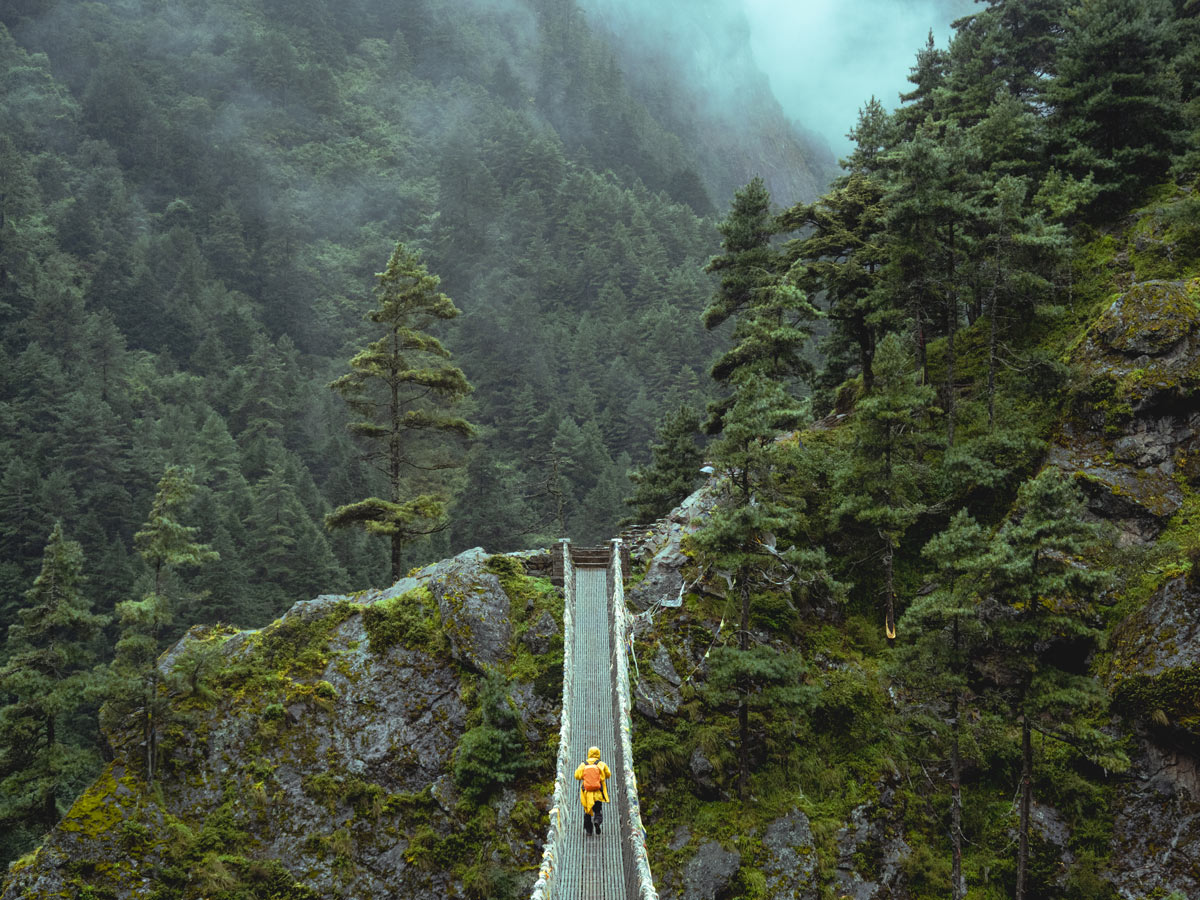
Nepal is home to some of the best treks in the world and features numerous trekking options suitable for every kind of trekker.
However, it is a common belief that these treks are best suited only for peak seasons like autumn (September to November) and spring (March to May), or a shoulder season like winter (December to February).
While monsoon (June to August) might not be the best time to visit Nepal, some treks in Nepal come to life with a unique charm, lush landscapes, quieter trails, and a vibrant palette of flora and fauna that you might not be able to see during any other season.
So, let’s debunk the myths and explore the options for monsoon treks in Nepal while preparing you for this unique adventure.
Why consider a monsoon trek in Nepal?
While it is true that monsoon is considered an off-season for trekking in Nepal , it is a misconception that no trek in Nepal can be accomplished during monsoon. In fact, you can have a unique and equally adventurous trekking experience during monsoon.
Contrary to the peak trekking seasons, monsoons don’t necessarily feature azure skies and clear views. However, the magic of the months of June to August caters to a specific type of audience seeking a distinctively lush and quieter experience amidst the trails.
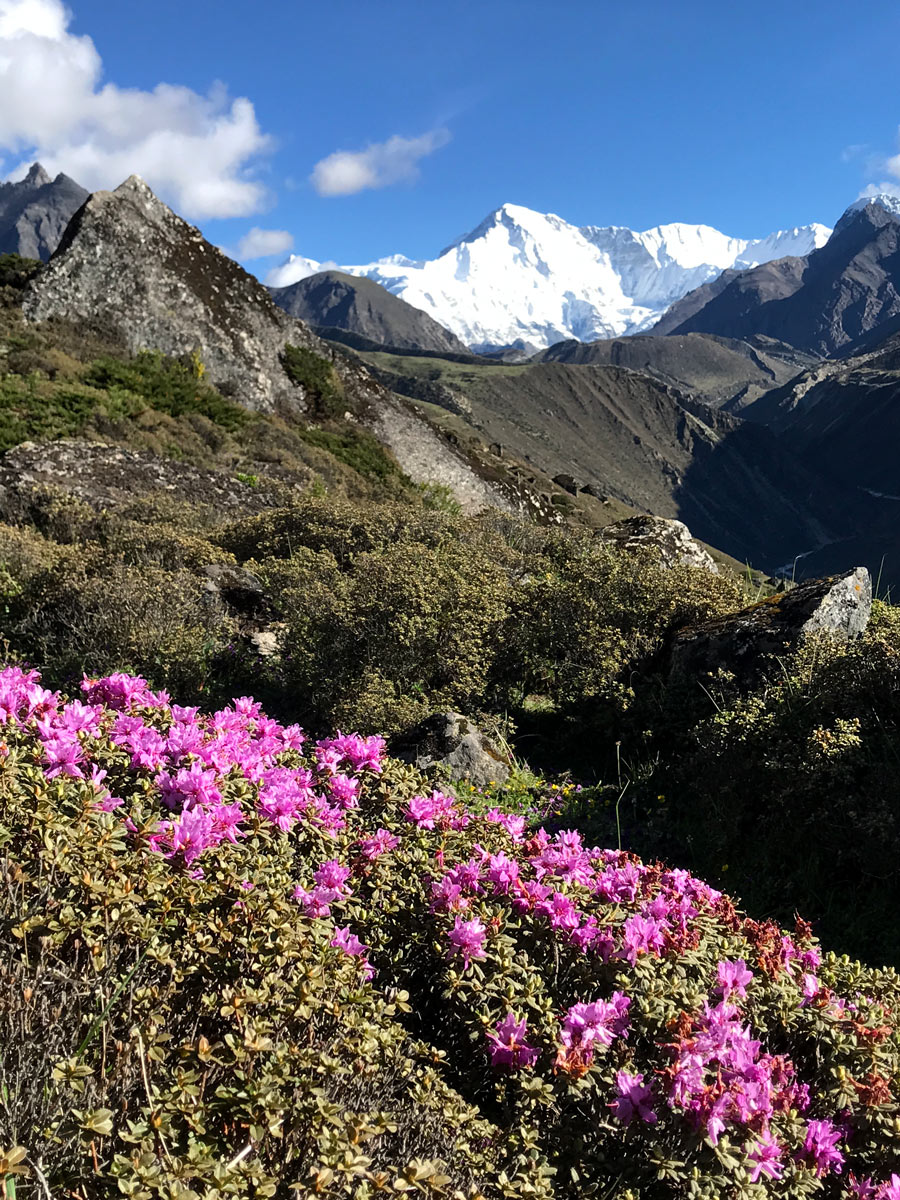
With the frequent rains, monsoons bring an atmosphere of rejuvenation to the vibrant landscapes and bring the flora to life. The meadows are bursting with wildflowers and valleys painted in different hues of greens.
On top of that, you are constantly accompanied by the soothing sounds of waterfalls and rivers and you can also witness the Himalayas surrounded by emerald mist when it is not raining.
Monsoon season also coincides with several local festivals and celebrations like Janai Purnima and Teej, and agricultural traditions like Ropain Jatra as this season is a vital time for agriculture in Nepal.
The biggest advantage of trekking in Nepal during monsoon season is that you will find no trekkers traffic which means you will have almost every trail just to yourself as you experience the raw beauty of Nepal in its most verdant.
Top Monsoon Treks in Nepal
Upper mustang trek.
The Upper Mustang region of Nepal is located in the rain shadow of the Himalayas and thus is completely sheltered from the rain and unaffected by monsoon. It is also known as the desert of Nepal for the same reason that it experiences little to no rainfall.
Therefore, the Upper Mustang trek is the best monsoon trekking destination. The landscapes of the Upper Mustang region are also unique, dry, arid, and barren accompanied by dramatic canyons which make the region stand out from other trekking trails of Nepal.
The Upper Mustang trek is a journey spanning almost 12 to 14 days and it takes you through some of the most captivating landscapes starting from Kagbeni and reaching all the way up to Lo Manthang .
On the way, you will cross several villages like Samar, Ghami, and Charang where the landscapes often resemble Tibetan highlands.
These villages are rooted in ancient Tibetan culture and you will find ancient monasteries, caves, traditional mud houses, chortens, and lots of prayer flags.
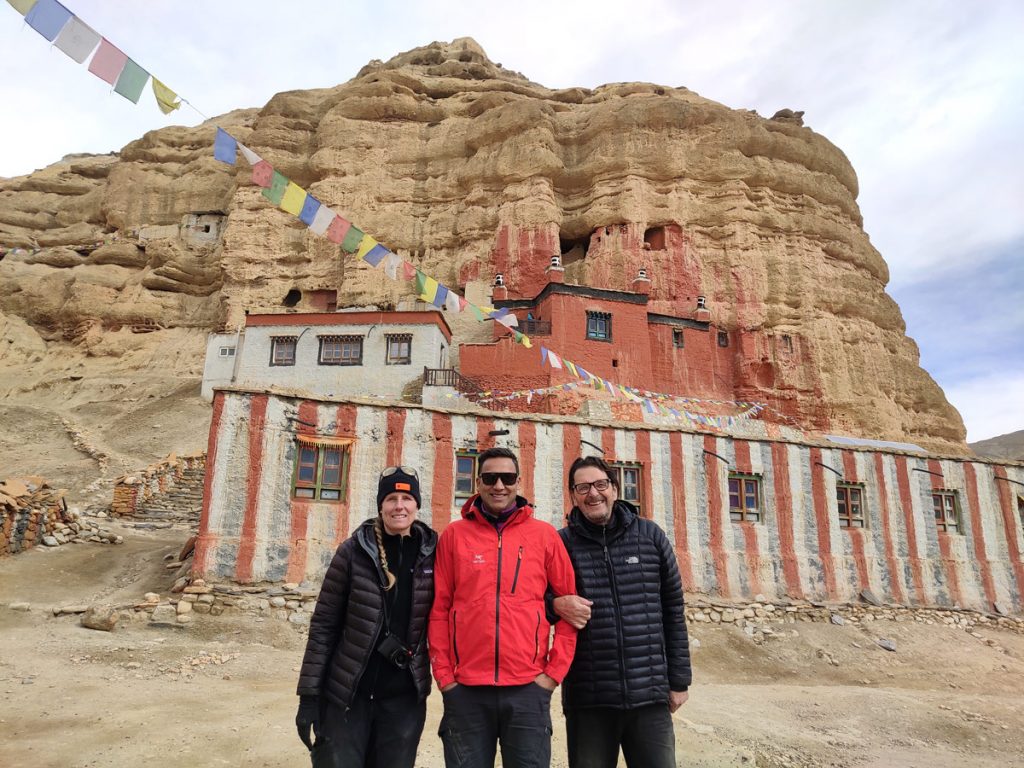
Lo Manthang is also known as the ‘Lost Kingdom’ which is surrounded by walls and it is a historically and culturally significant stop during the trek. It features ancient remains of the King’s palace and several caves.
Surrounded by walls, the kingdom is also known as the ‘walled city’ and adds more cultural impact to the trek. Lo Manthang is also the highest point of the Upper Mustang trek as it takes you to an altitude of 3,810 meters.
Other significant monasteries like Ghar Gumba and Luri Gumba are also significant stops on the trek. The famous Tiji festival celebrated in the region also coincides with monsoon where you can see the entire region coming to life with colors.
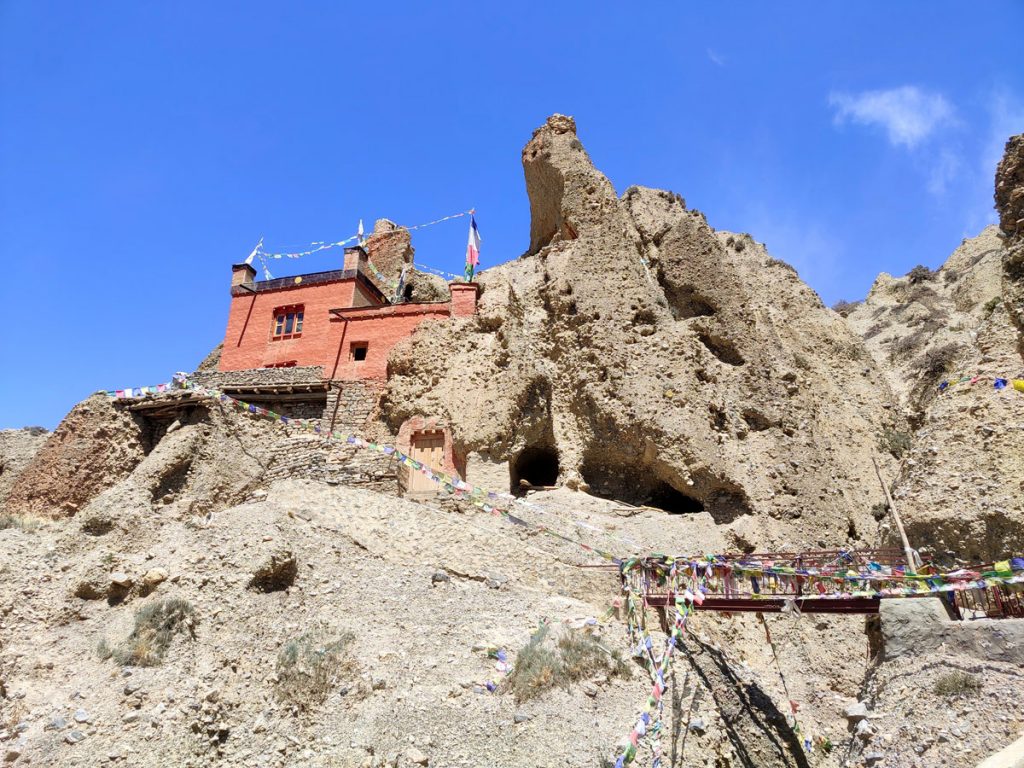
You will face absolutely no monsoon-related challenges on the Upper Mustang trek and you can get fascinating views of Annapurna, Thorung Peak, Nilgiri, Dhaulagiri, Tukuche Peak, Lamjung Himal, and more.
Upper Dolpo Trek
Another adventurous option for a Himalayan experience in Nepal while remaining unaffected by the heavy rainfall of monsoon is the remote yet stunning Upper Dolpo Trek which is a haven for those seeking natural beauty, cultural experience, and remoteness all within a single trek.
Spanning around 170 to 200 km, this trek takes around 18 to 22 days and can easily be done during monsoon as this too lies in the rain shadow of the Himalayas and experiences minimal rainfall.
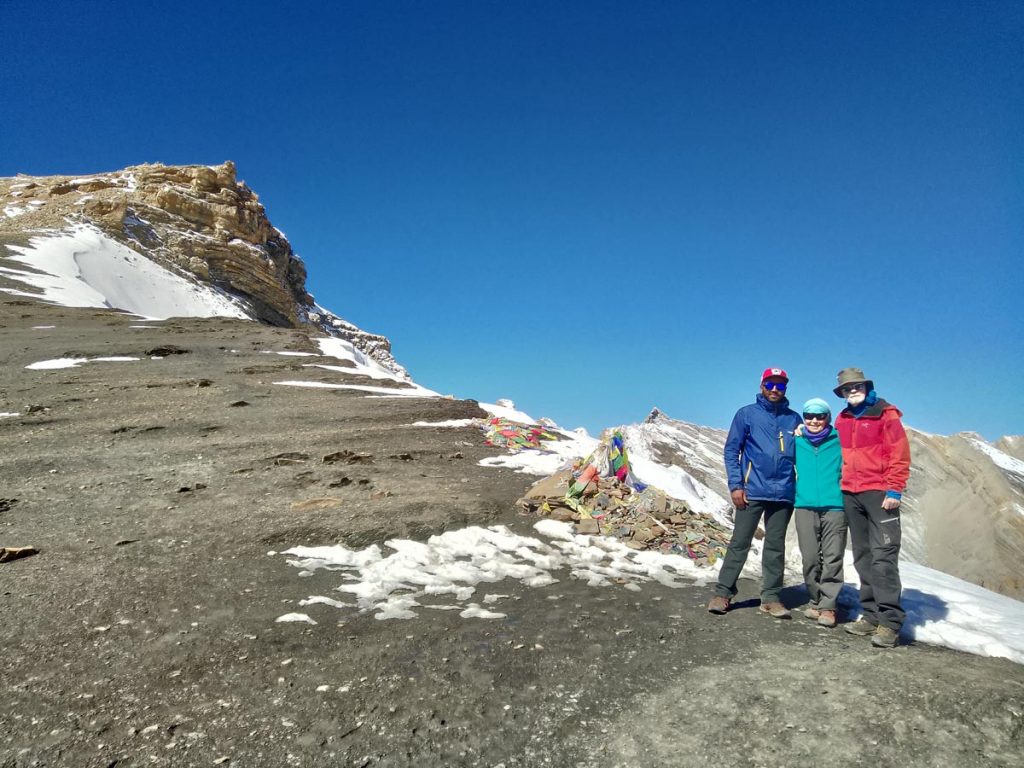
This trek begins with a scenic flight to Juphal and takes you to some of the unexplored corners of Nepal while passing through terraced fields, high mountain passes, and other remote villages, which is why it is also one of the off-the-beaten-path treks of Nepal.
Bordering Tibet, this trek passes through Renje and Phoksundo Bhanjyang, where you get to witness the stunning turquoise waters of Shey Phoksundo Lake, to reach the Kang La Pass at 5,151 meters which is the highest point of the trek.
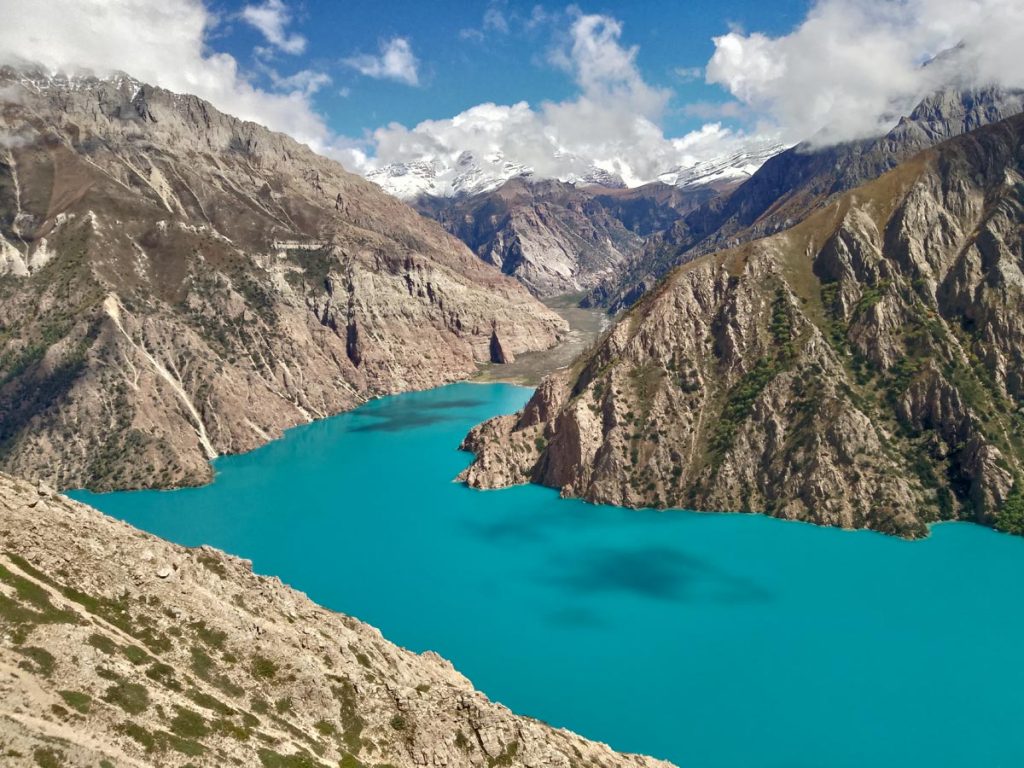
After that, your trek continues with the dramatic shift of elevation across Shey Gompa, Namduna Gaon, Saldang, Sibu, Jeng La, Tokyu, Serkam, and Tarakot forming a loop around the region.
Throughout the trek, you will get amazing views of the likes of Crystal Peak, and valleys carved by Bheri and Nang Chu Rivers, and also experience the thrill of crossing mountain passes.
One unique thing you will experience during the trek is the ancient pre-Buddhist Bon Po religion which is practiced in very few places. The cultural aspect of the trek truly comes out at locations like Shey Gompa and Bonpo Monastery.
The only problem that you might experience while trekking Upper Dolpo during monsoon season is the delay in flight to and from Juphal. Besides this, the trek is completely unaffected by monsoon.
Nar Phu Valley Trek
Continuing the series of trekking routes in the rain shadow areas, the Nar Phu Valley trek is another worthy addition to this list as it gives one of the best trekking experiences during monsoon.
It is also a rare and remote trek that takes you to the secluded Nar and Phu villages nestled in the Annapurna region of Nepal within a span of 10 to 14 days as you travel through a small segment of the elaborate Annapurna Circuit trek.
This trek comes to life during monsoons as the valleys of Nar and Phu bloom with a vibrant display of flora and the otherwise dry trails of the trek become slightly lush in certain segments.
The Nar Phu Valley trek takes you to places that have remained unchanged over the centuries which is evident in their traditional houses, deep-rooted cultures, and the Tibetan lifestyle of people, specifically Gurungs and Bhotias.
While traversing through this desert-like landscape, the likes of Tashi Lha Khang monastery add a spiritual dimension to the trek making it even more peaceful and life-changing.
During the trek, you will also cross high mountain passes of the Annapurna region like the Kang La Pass (5,306 m), and the Thorong La Pass too (5,416 m) if your itinerary permits.
While this trek always experiences relatively fewer trekkers’ traffic, during the months of monsoon (June to August) you will guaranteed have this trail all to yourself.
Ghorepani Poonhill Trek
One of the beginner-friendly treks in Nepal, the Ghorepani Poon Hill trek is a short yet rewarding option on this list which is known for its accessibility as you can experience the magic of Annapurna region without committing to the length.
Starting from Birethanti, this trek spans 4 to 5 days and covers a small segment of the Annapurna region while reaching the maximum altitude of 3,210 m at Poonhill, hence not requiring acclimatization.
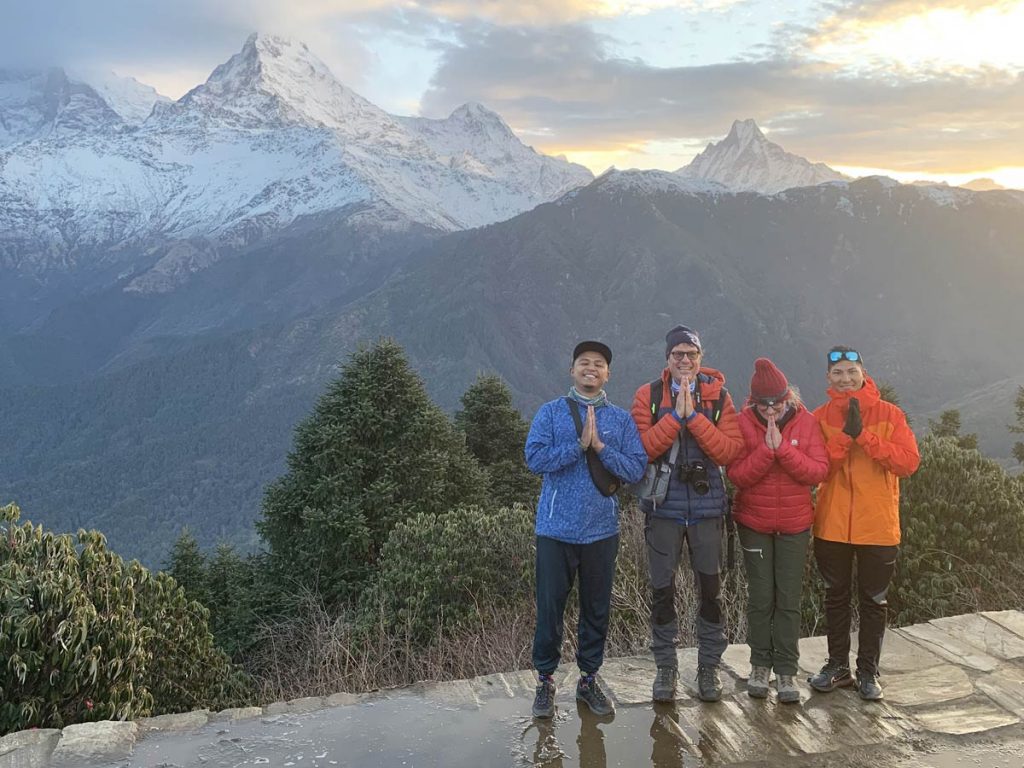
The main highlights of the Ghorepani Poonhill trek are the mesmerizing sunrise from Poonhill and the verdant rhododendron forests that accompany you during the walk to Poonhill.
If you are doing this trek during monsoon, typical chances of heavy rainfall are during the afternoon and evenings which leaves the mornings clear for perfect views if you are lucky.
You can walk up to Poonhill which is one of the best sunrise viewing spots in Nepal and get your picture-perfect view of the first rays of sun immersing the Annapurna and Dhaulagiri range in its golden hues.
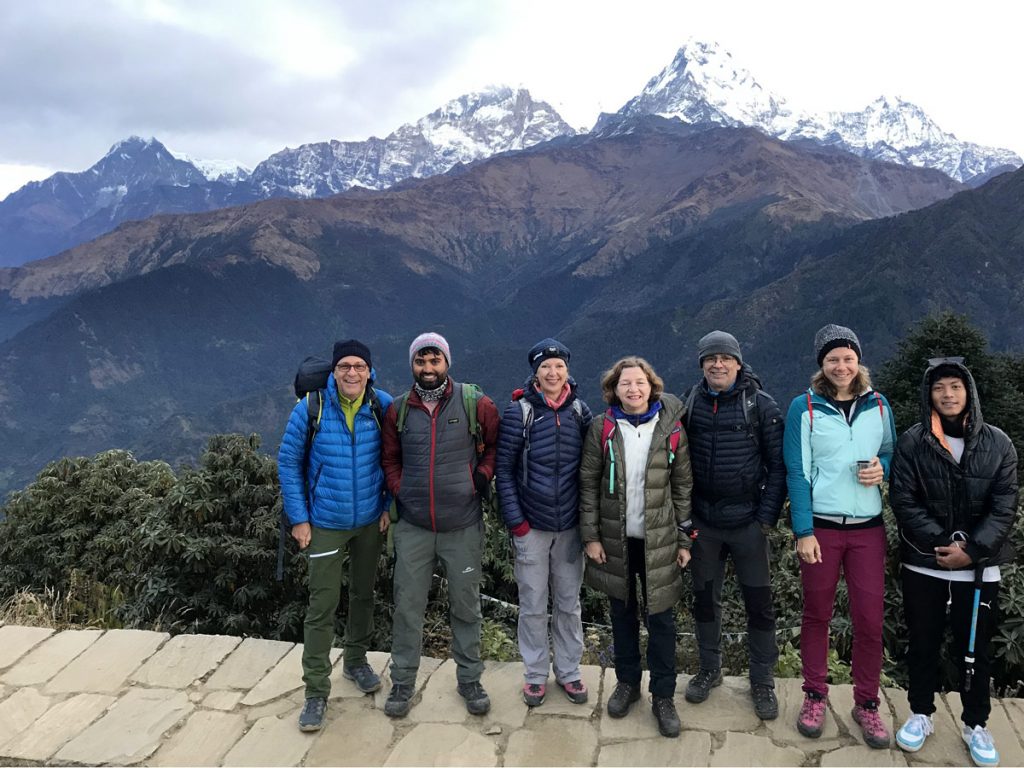
Even if the visibility is low due to clouds, you will still get a world-class view making you feel as if you are on top of the skies.
On top of that, you will also escape the crowd as this trek usually experiences a high influx of trekkers during peak seasons.
You will also get to experience the warm hospitality and rich culture of the Gurungs, Magars, and Thakalis residing in this region.
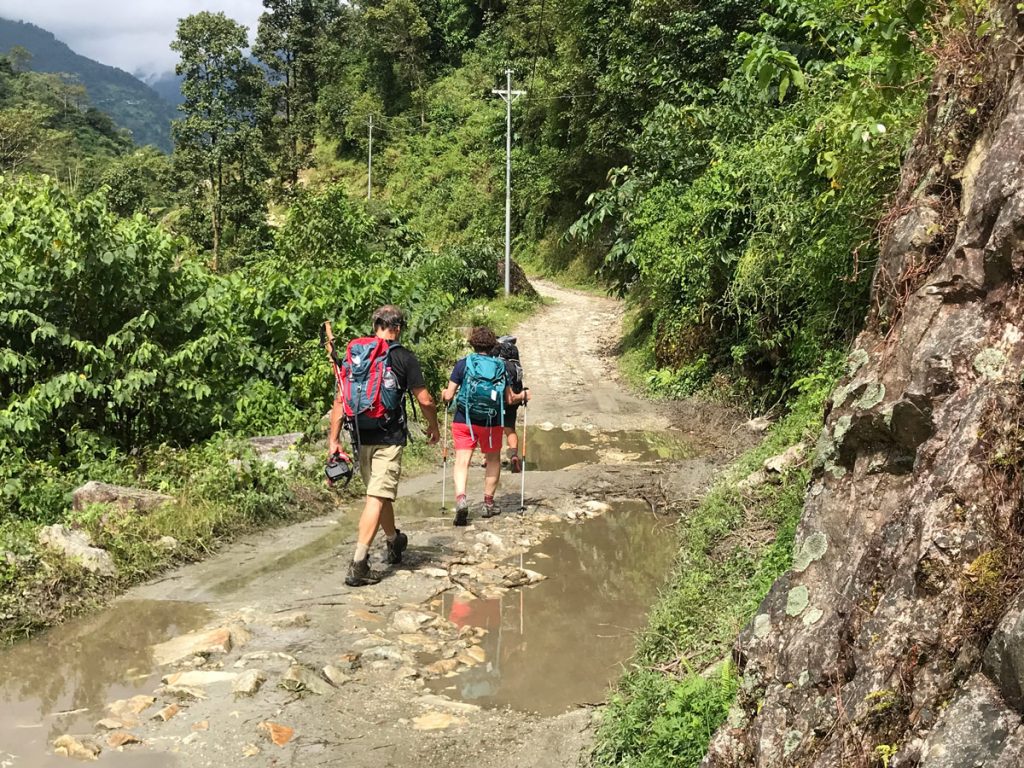
Another advantage of doing this trek during monsoon is that you can experience the lush landscapes in their full might as the wildlife activity is high the trails are dotted with wildflowers and the segment from Ghorepani to Poonhill is booming with several flora.
However, doing this trek in monsoon is slightly more difficult than doing it in other seasons as the trail becomes slippery and gets infested by leeches and the mountain views might also be obstructed.
But it is not very risky and can be conquered with proper preparation and accurate gear as the trek is short and takes you at a relatively lower altitude.
Annapurna Circuit Trek
The Annapurna Circuit trek , a legendary Himalayan adventure, is one of the few treks that experiences a mix of rain shadow and monsoon zones which makes it a partially protected area during monsoon.
This trek is usually avoided during monsoon as it experiences a reasonable amount of rainfall. However, with certain precautions and knowledge, this trek can be completed during monsoon too.
Starting from Syange, the trek circumnavigates around the Annapurna massif and covers a major portion of the Annapurna Conservation Area . The highest point on this trek is at the Thorong La Pass at 5,416 m.
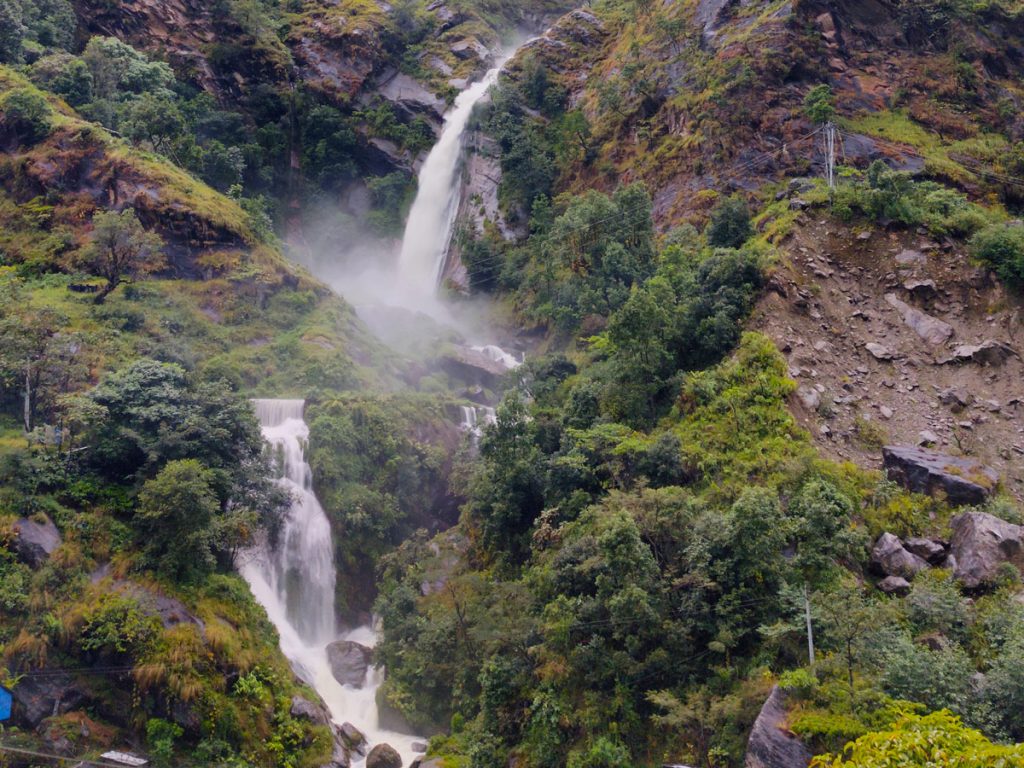
This is a lengthy trek and covers around 170 to 210 km. Therefore, it can be divided into sections. The northern section of the Annapurna Circuit trek is located in the rain shadow area and experiences minimal rainfall.
This section includes places close to Manang and Mustang and they become a viable option during monsoon. Here you will see deep canyons and valleys like the Kali Gandaki Gorge and dry and arid landscapes.
Even if you are trekking the entire circuit, only the lower sections of the trek will be more challenging as the amount of rainfall decreases as you ascend higher.
During the lower sections, you have to be careful about slippery trails and other challenges like leeches and carry rain-protecting gear.
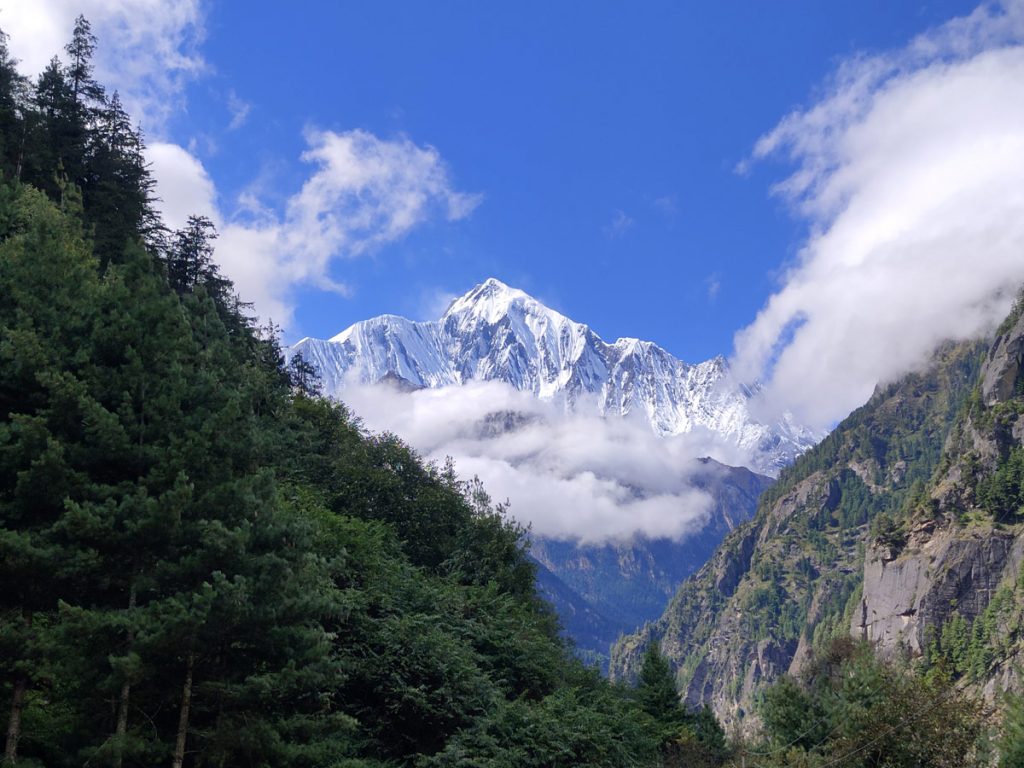
Other risks like landslides and trail blockage are not much of a problem during the Annapurna Circuit trek as it features a dirt road that runs parallel to the trekking trail. So, in case of trail blockage, you can always take the dirt road.
What you can focus on is the lush and vibrant landscapes with high agricultural activities that will make your experience a memorable and tranquil one due to less crowds.
Everest Base Camp Trek
A final addition to this list is the iconic Everest Base Camp trek which, to your surprise, can also be rather easily completed during monsoon. It is challenging, yes, but it is also much more adventurous and uniquely memorable.
Starting with a scenic flight to Lukla Airport , the Everest Base Camp trek is a 10 to 12-day adventure that takes you to the foothill of the highest peak in the world – Mount Everest . It is a highly popular trek and is worth all the hype.
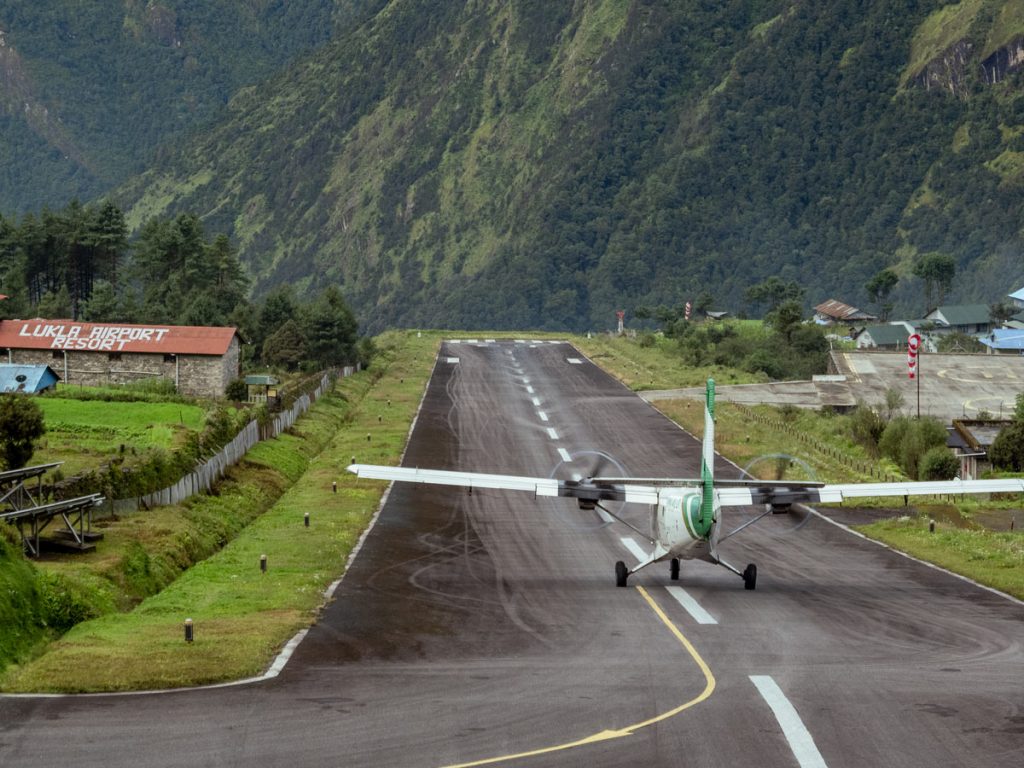
Doing Everest Base Camp Trek during monsoon is an experience much different than doing it during autumn or spring. While the rainfall can be a disturbance for a few days in the beginning, it begins to subside as you ascend higher.
You must be prepared and careful though as the trail becomes slippery during monsoon and the chances of injuries are increased. The visibility of the mountains is also low and expect rain at any sudden time.
But if you have the proper gear to tackle it, the rewards of this trek during monsoon overpower the challenges. The landscapes as you pass the Sherpa villages are bursting with rhododendrons and juniper.
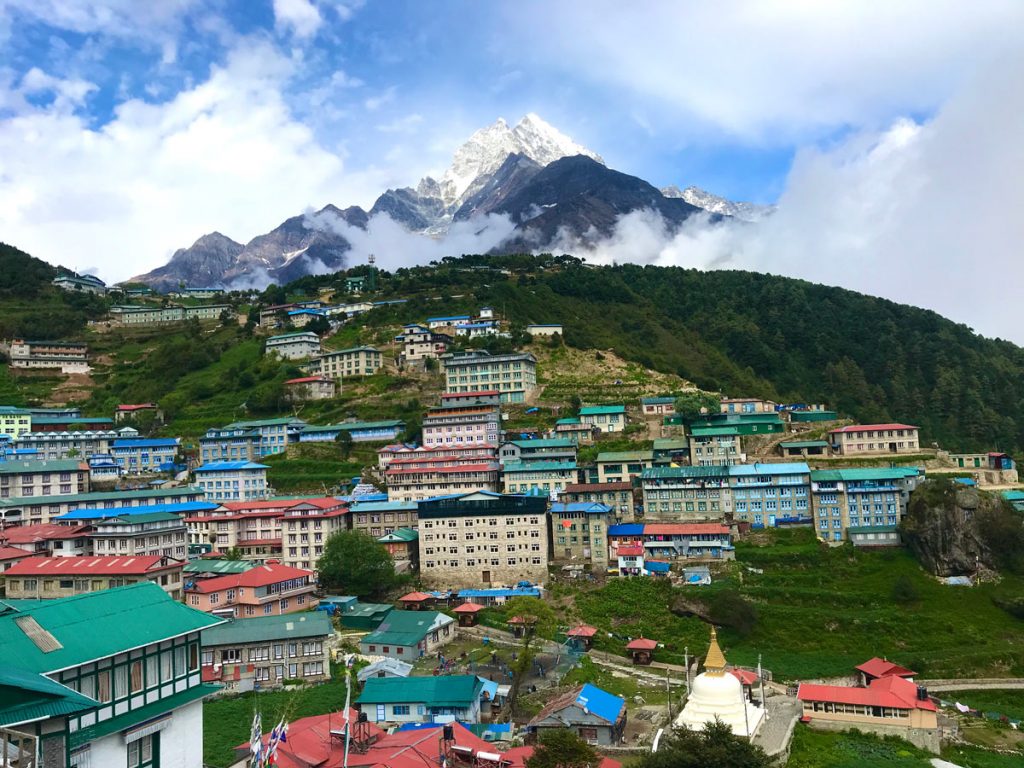
You will come across several waterfalls as you make your way through Namche Bazaar, Tengboche, and Dingboche, and continue the trek.
As you reach higher, the rainfall might manifest as snow adding more ethereal beauty to the already stunning trail. The rainfall becomes relatively less once you cross Namche.
The skies are also relatively clear during mornings, which can allow you to catch a quick glimpse of the mountains. And you can experience all this while not being suffocated by the huge crowd that the trail experiences during other seasons.
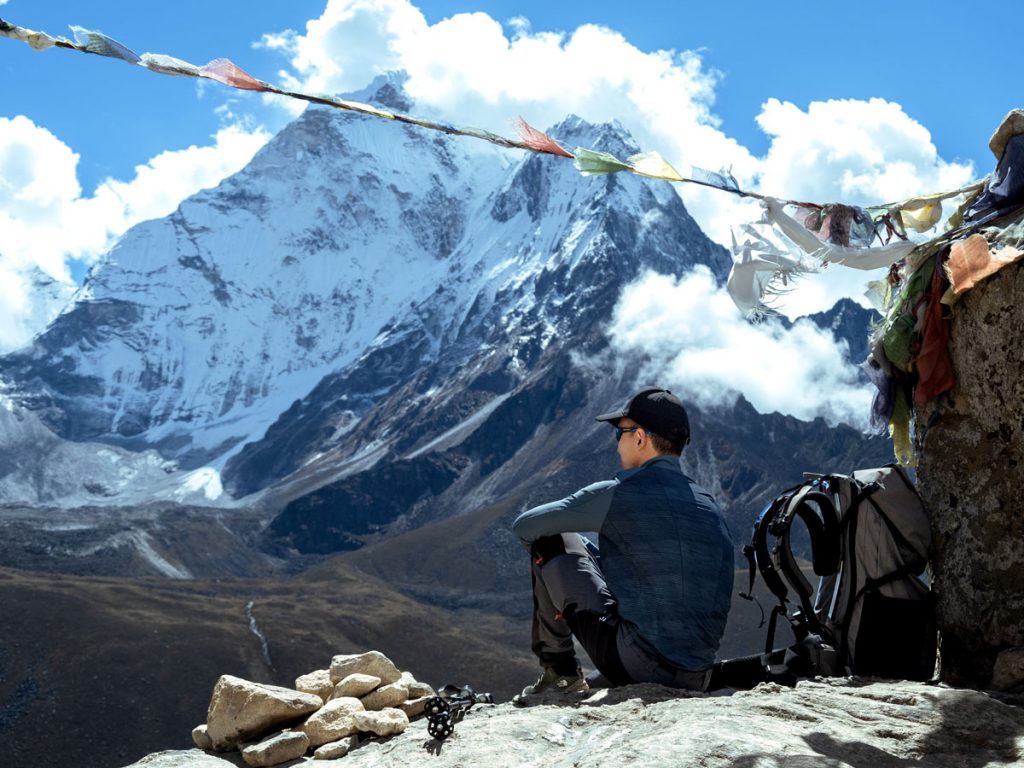
However, one thing that might be a hurdle in your trekking plans is the frequent delays and cancellations of flights to and from Lukla as it is considered a dangerous airport, and flying during monsoon can be challenging.
Therefore, it is advisable to include buffer days in your itinerary as there are chances of delays in your itinerary due to these weather-related delays at the Lukla airport.
Challenges During Monsoon Treks
Despite all these unique experiences and vibrant atmosphere, the reason why monsoon is considered an off-season for trekking in Nepal is because of the lots of challenges it brings along.
The main challenge of trekking during monsoon is that the trails, which are already rugged and often not well maintained, become extremely muddy and slippery due to constant rainfall.
Combined with this, the visibility is also not high due to rain and fog. This increases the risk of slipping, falls, and injury making the trails accident prone, especially for beginners due to tired leg muscles, improper footing, and lack of balance on slippery trails.
Due to lack of visibility, one might also miss out on one of the highlights of trekking in Nepal which is the picture-perfect mountain views which can be disappointing. However, you do get a unique and mystical view due to the clouds.
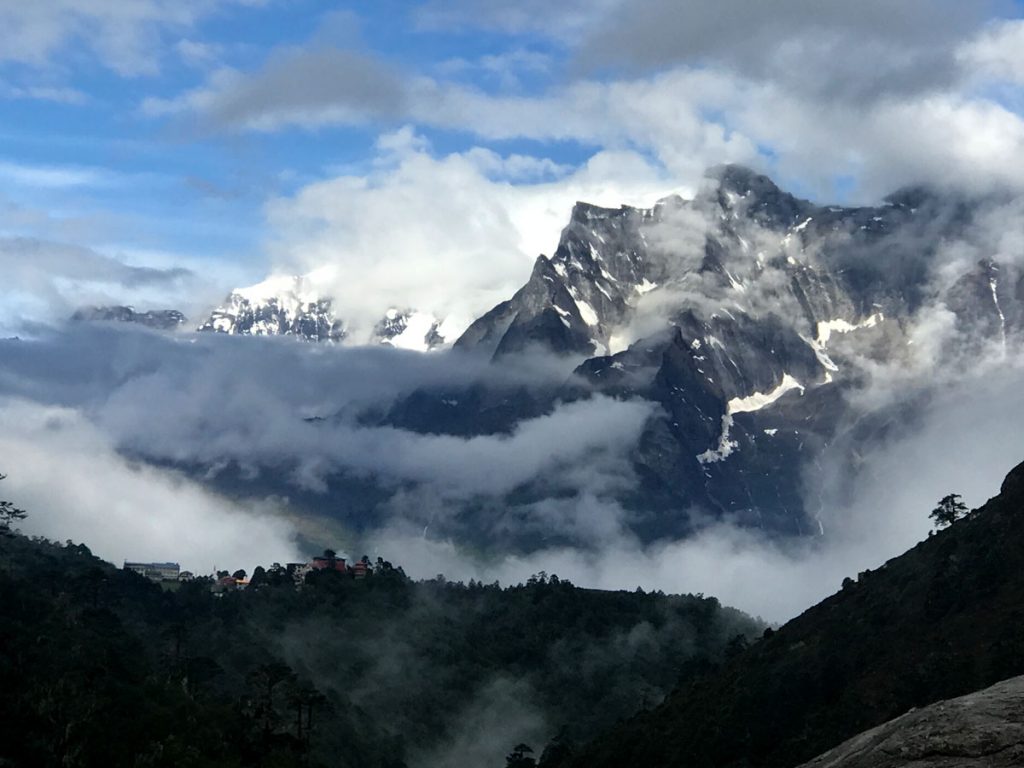
Another disadvantage is that most of the trails in Nepal are infested with leeches and these bloodsuckers can latch onto your skin without even being detected. Heavy rainfall can also lead to trail blockage and landslides at times.
You will also come across unpredictable weather challenges like sudden rain, thunderstorms, or even hailstorms. Also, because monsoon is an off-season, the number of teahouses and lodges on the trek is very limited as most of them will be closed.
Essential Tips for Monsoon Trekking
Although many challenges are prevalent during trekking in monsoon, they can be tackled with proper preparation, thorough packing, early measures, and a spirit of adventure.
- Set realistic expectations to avoid disappointment during the trek as it is highly likely that you will not be getting mountain views on a monsoon trek in Nepal.
- You need to have flexibility in travel plans as occasional delays are possible due to unpredictable weather conditions which might in turn affect your overall itinerary.
- As monsoon is an off-season for trekking in Nepal, you might not get all the facilities like an elaborate food menu, wi-fi and internet services, and even laundry sometimes. So, be prepared.
- To tackle the slippery trails, wear sturdy and waterproof hiking boots preferably with spikes for better traction.
- Carry a trekking pole too for better grip, stability, and balance in the slippery sections. Be mindful of your footing.
- Make sure to wear a gaiter over the boots and apply salt on it for leech protection.
- Carry a good insect repellant containing DEET and spray it on your shoes, socks, and lower legs constantly throughout the day.
- Check your shoes, socks, and legs for any leeches, and do not panic if you find one. Use salt to detach it and flick it with your fingernail. Do not pull it forcefully to avoid infection. Clean it with antiseptic and bandage.
- Pack quick-drying clothes that are suitable for layering when trekking in monsoon.
- Carry proper and high-quality rain gear like rain jackets, rain pants, and bag covers which are breathable along with being waterproof.
- Be aware of your surroundings while trekking and watch out for warnings of potential landslides, loose scree, cracks in the ground, or unusual flow of water.
- Partner with a local reputed agency and hire guides for safe and successful trekking adventures as guides know these trails much better and can predict the weather patterns.
Related Blogs & Articles
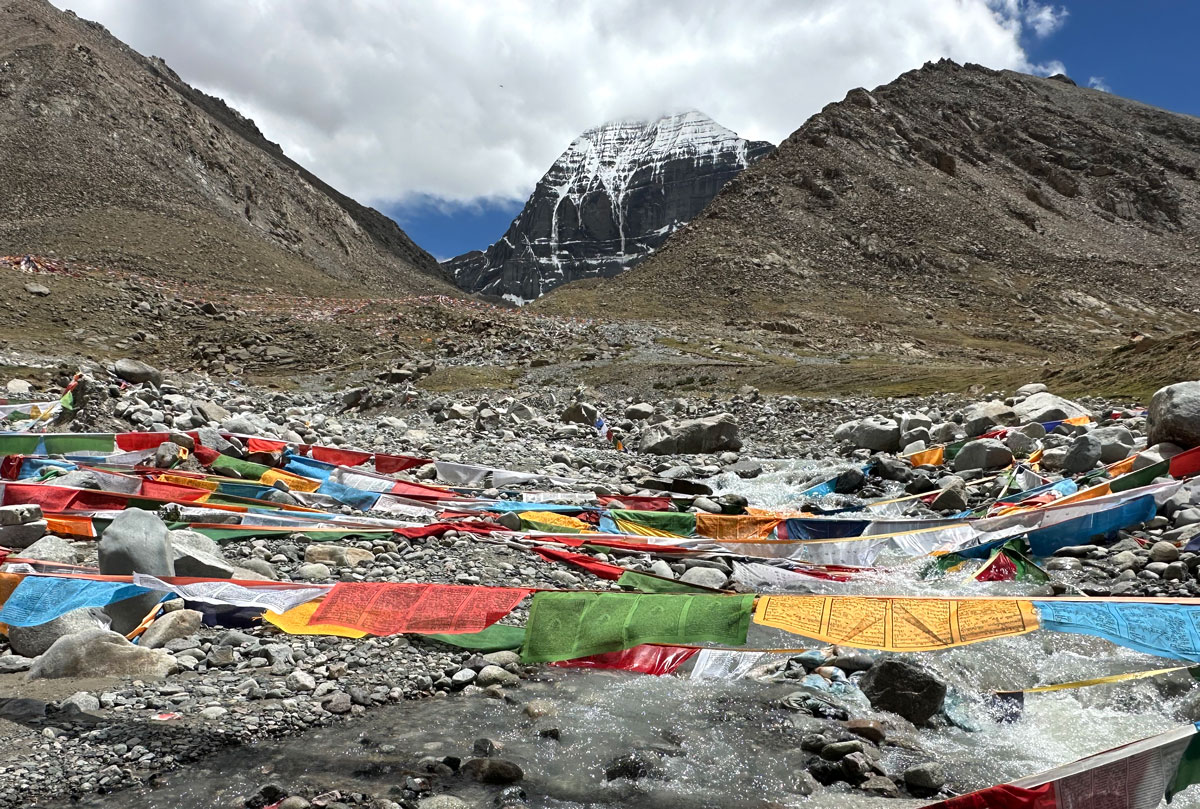
Pilgrimage Activities during Kailash Mansarovar Yatra
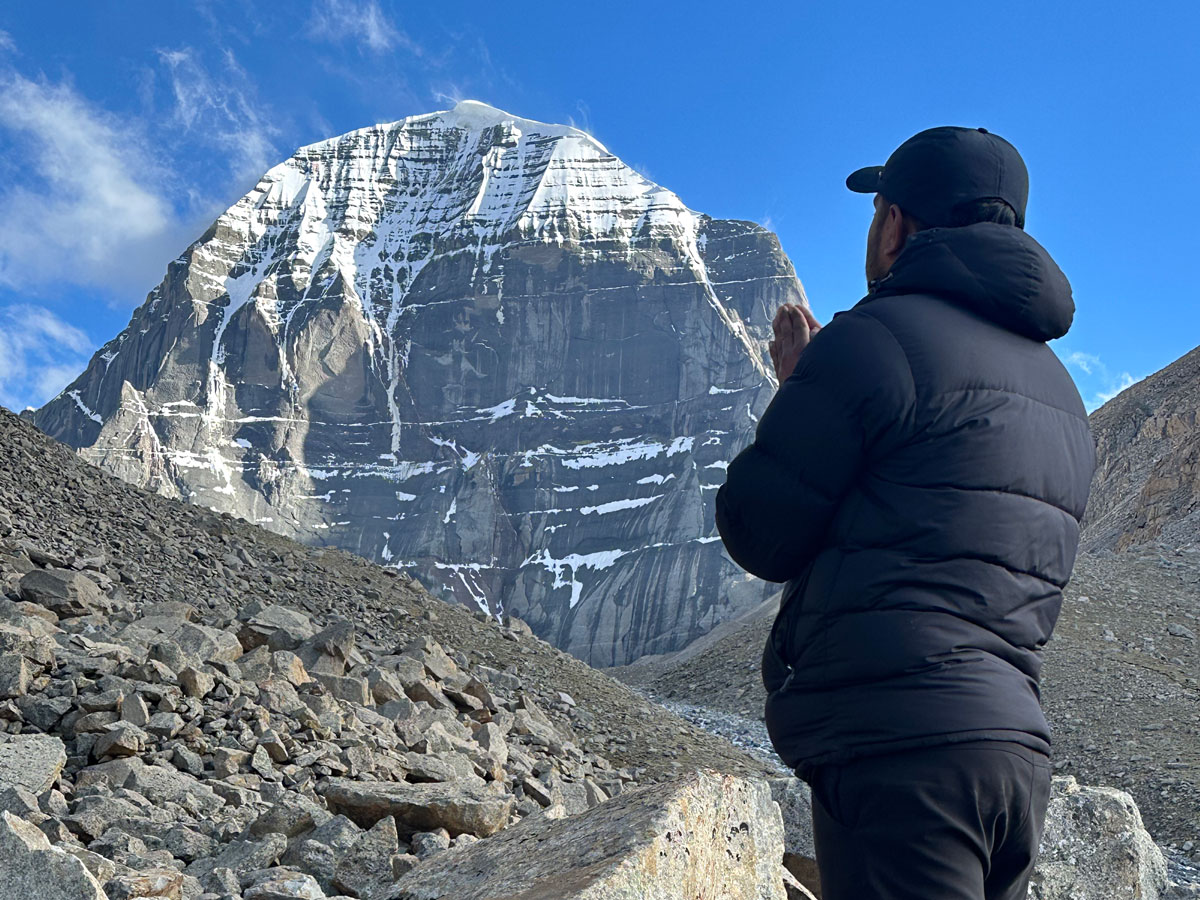
Where is Mount Kailash Located?
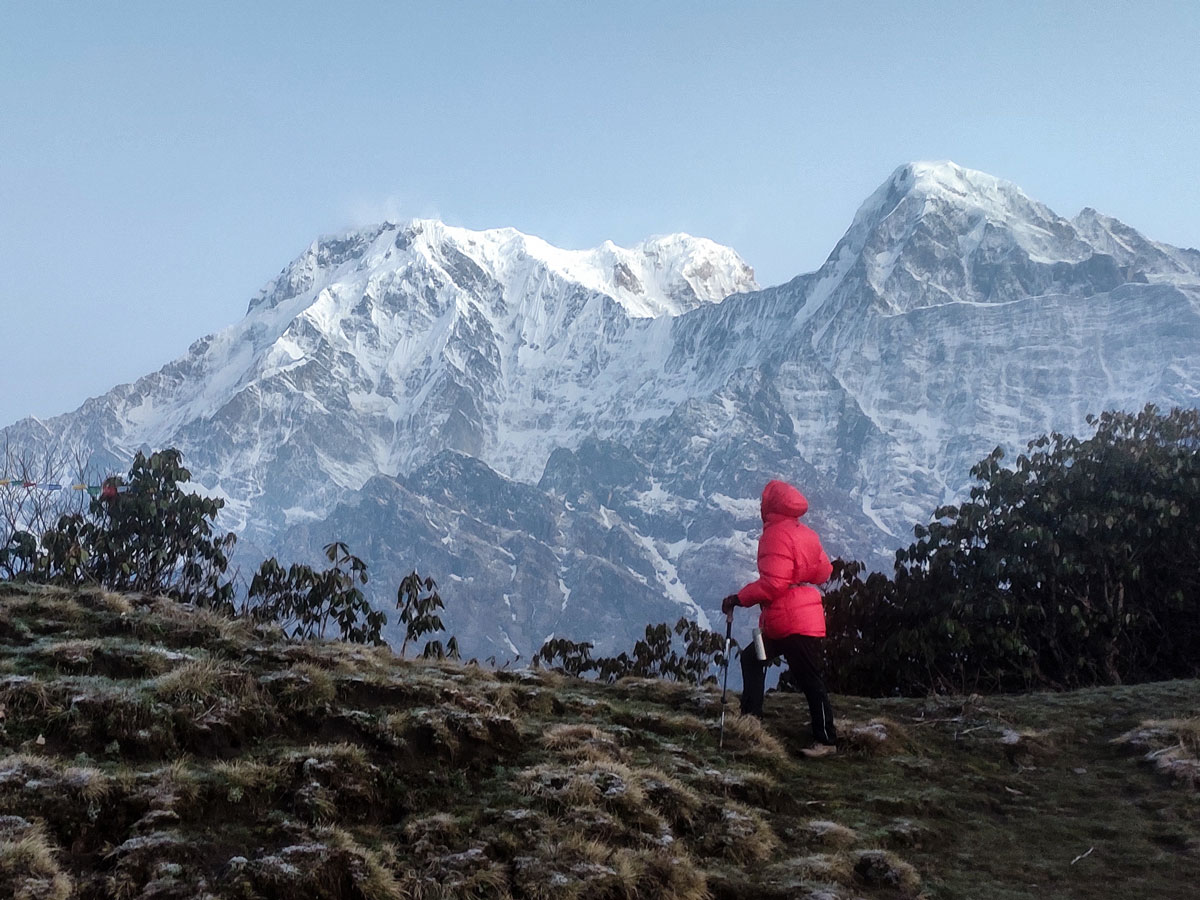
Why choose Mardi Himal trek?

- Phone This field is for validation purposes and should be left unchanged.
Trekking in Nepal
Climbing and expedition, cultural tour and sightseeing, cycling and mountain biking, luxury treks, luxury tours, multi country tours, voluntourism trips, extend your trip.
- Everest Base Camp Heli Trek – 8 Days
- Everest Panorama Trek – 9 Days
- EBC Trek with Helicopter Return – 12 Days
- Everest Base Camp Trek – 14 Days
- Gokyo Lake Trek – 13 Days
- Gokyo and Renjo La Pass Trek – 14 Days
- Everest Base Camp Trek without Lukla Flight – 17 Days
- Gokyo to Everest Base Camp Trek – 17 Days
- Everest Base Camp with Island Peak – 19 Days
- Everest Three Passes Trek – 20 Days
- Everest High Passes and Island Peak – 23 Days
- Classical Everest Base Camp Trek – 21 Days
- Langtang Valley Trek – 10 Days
- Langtang Valley Ganja La Pass Trek – 14 Days
- Langtang Helambu Trek – 17 Days
- Ghorepani Poon Hill Trek – 9 Days
- Mardi Himal Trek – 10 Days
- Annapurna Base Camp Trek – 13 Days
- Himalayan Highlights – 13 Days
- Nar Phu Valley Trek with Annapurna Circuit – 18 Days
- Annapurna Circuit Trek – 19 Days
- Tilicho Lake Trek With Thorong La Pass – 19 Days
- Khopra Danda Trek – 11 Days
- Shivapuri-Chisapani Trek – 4 Days
- Upper Mustang Trek (Drive & Trek) – 16 Days
- Tsum Valley Trek – 16 Days
- Manaslu Circuit Trek – 15 Days
- Dhaulagiri Circuit Trek – 21 Days
- Upper Dolpo Trek – 25 Days
- Kanchenjunga Base Camp Trek – 29 Days
- Yala Peak Climbing – 13 Days
- Island Peak Climbing – 15 Days
- Mera Peak Climbing – 19 Days
- Everest Base Camp and Lobuche East – 18 Days
- Tent Peak Climbing with Annapurna Base Camp – 18 Days
- Pisang Peak and Thorung La Pass – 21 Days
- Ama Dablam Expedition – 29 Days
- Kathmandu Cultural Heritage Tour – 3 Days
- Kathmandu Heritage – 3 Days
- Inheritances of Kathmandu – 4 Days
- Glimpses of Kathmandu & Nagarkot – 5 Days
- Kathmandu and Pokhara Unveiled – 5 Days
- Explore Kathmandu – 6 Days
- Glimpse of Nepal – 8 Days
- Nepal Heritage Tour – 10 Days
- Nepal Adventure Tour – 11 Days
- Nepal Multi Sports Adventure – 11 Days
- Nepal Vista – 10 Days
- Nepal Highlights – 14 Days
- Experience Nepal – 15 Days
- One Day Biking Trip – Kathmandu – 1 Day
- Annapurna Circuit Biking – 14 Days
- Upper Mustang Biking – 16 Days
- Kathmandu Valley Rim Biking – 8 Days
- Annapurna in Luxury – 9 Days
- VVIP Everest Base Camp Trek – 10 Days
- Everest View Luxury Trek – 11 Days
- Everest Base Camp Luxury Trek – 14 Days
- Everest Base Camp Deluxe Trek – 16 Days
- Mt Everest Base Camp to Gokyo Trek – 19 Days
- Kathmandu Luxury Tour – 3 Days
- Kathmandu and Pokhara Luxury Tour – 5 Days
- Nepal Multi Sport Luxury Adventure – 11 Days
- Best of Nepal – 14 Days
- Trishuli River Rafting – 1 Day
- Everest Base Camp Helicopter Tour – 1 Day
- Everest Base Camp Heli Tour with Gokyo Extension – 1 Day
- Langtang Heli Sightseeing – 1 Day
- Pokhara and Annapurna Heli Sightseeing – 1 Day
- Paragliding in Nepal (Pokhara) – 1 Day
- Scenic Mountain Flight (Everest Flight) – 1 Day
- Ultra Light Flight – 1 Day
- Jamacho Day Hike-One day hiking trip – 1 Day
- Kathmandu Uncovered with Nagarkot – 1 Day
- Day Tour to UNESCO Heritage Sites – 1 Day
- Nepal and Tibet – 15 Days
- Nepal and Bhutan – 15 Days
- India, Nepal and Bhutan – 19 Days
- Nepal, Tibet and Bhutan – 20 Days
- Arupokhari School Volunteer Program – 14 Days
- Rebuild Home Volunteer Program – 9 Days
- Bardiya Jungle Safari – 4 Days
- Chitwan Jungle Safari – 3 Days
Trekking in Bhutan
Festival tours, motorcycling.
- Druk Path Trek – 8 Days
- Chomalhari Trek – 12 Days
- Laya Ghasa Trek – 18 Days
- Bhutan Vistas Tour – 5 Days
- Cultural Heartland Tour – 10 Days
- Hidden Valley – 11 Days
- Bhutan Multi Sports Tour – 11 Days
- Paro Tshechu Festival – 8 Days
- Punakha Tsechu – 9 Days
- Trongsa Lhuntse Tshechu – 9 Days
- Bumthang Tangbi – 11 Days
- Bhutan Ura Yakchoe – 12 Days
- Tamshingphala Choepa – 12 Days
- Mongar and Trashigang – 16 Days
- Bhutan Biking – 8 Days
- Bhutan Motorcycle Tour – 12 Days
Trekking in Tibet
- Tibet Advance Everest Base Camp – 21 Days
- Cho Oyu Expedition – 45 Days
- Shishapangma Expedition – 47 Days
- Everest Expedition via North Side – 63 Days
- Lhasa Tour from Kathmandu – 10 Days
- Lhasa Overland Tour from Kathmandu – 13 Days
- Kathmandu to Lhasa Overland Tour with EBC – 15 Days
- Tibet Tour with Everest Base Camp via Lhasa – 15 Days
- Kailash Mansarovar Yatra – 16 Days
- Everest Base Camp Biking Tour – 21 Days

How to do Nepal during monsoon season
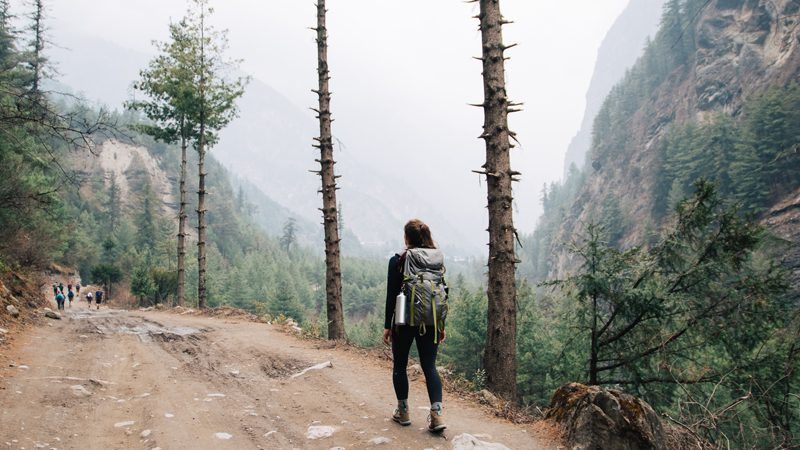
“ Chitwan is hot,” I’m warned at breakfast by a chatty local. I laugh nervously. “Hotter than Kathmandu?” I ask, shifting uncomfortably in my chair. I sip my cinnamon and clove-spiced tea while making a conscious effort to stop sweating. ‘Hot’ I’ve learned, is relative.
I grew up in the frigid Canadian winters of Northwestern Ontario where temperatures often dip below -40°C if you factor in wind chill (and we always factor in wind chill). My version of stifling hot is probably closer to your idea of a warm breezy day. But ‘monsoon hot’ seems to have its own special meaning for everyone. So if somebody like me – a giant baby when it comes to any heat whatsoever – can tackle Nepal during the height of monsoon season, anyone can. Here’s my handy survival guide.
Move slowly
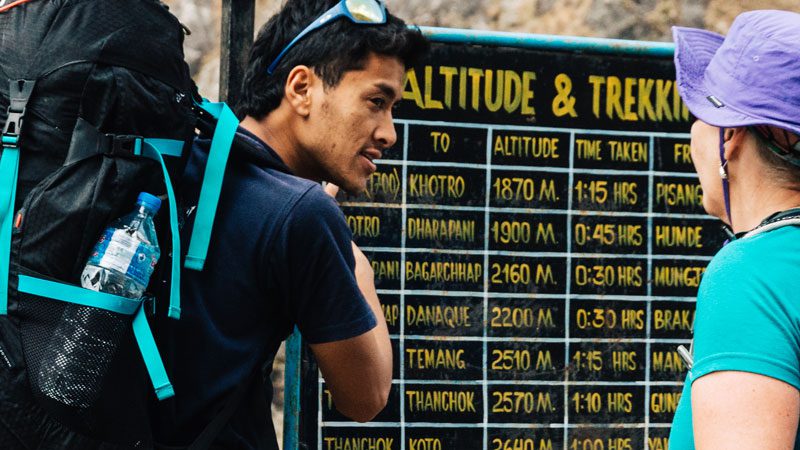
Image c/o The Common Wanderer
This is a lesson I learned while climbing to the UNESCO World Heritage Site of Swayambhunath Temple. Legend has it that the hill on which the temple sits rose from beneath a lake that used to cover the Kathmandu Valley. There are two ways to get to the top, by cab or by stairs. Being a monsoon rookie, I chose the stairs…all 365 of them. Fight the urge to have your real-life Rocky Balboa moment and just go slow. Slowness will also help you avoid stepping in a pile of monkey poop, cleverly left for you in prime stepping areas by the hundreds of sacred monkeys that live around the temple.
Dress like a local
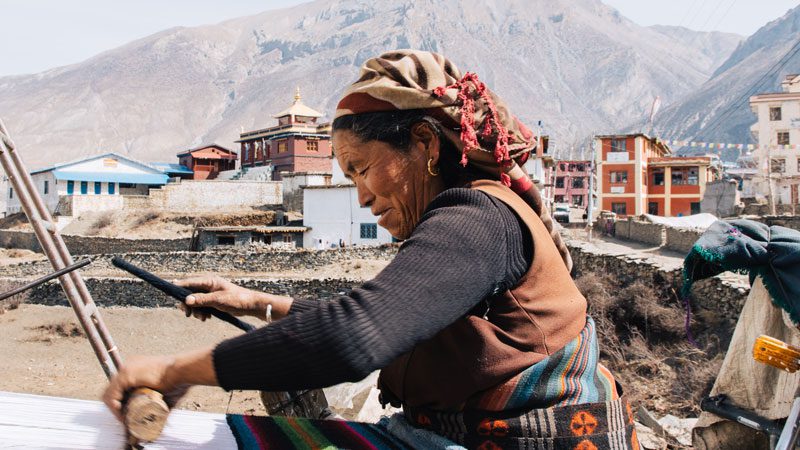
Local knowledge can often be hard to tap into while travelling for short periods of time, but this local tip is right out in the open for you to see. Leave your favourite ripped jeans at home -– they will not provide the ventilation required during Nepal’s hottest months. Pick up a few pairs of cotton pants from one of the shops that line the dusty streets of Kathmandu and wear them everywhere. You’ll thank me later. If elephant-inspired prints aren’t your thing, you can easily find plain colourful options in the capital’s bustling Thamel district . The pants are often one size fits all, but have a whole lot of stretch to them, which also means you can eat more momos at dinner. Side note: eat all of the spicy momos you can find. They’re delicious.
Embrace the sweat
The highest recorded sweat rate from somebody resting while in hot weather is 5 litres per hour, which is downright impressive. Temperatures in Chitwan can creep well into the 40°C range in June with what my internal hygrometer detected to be 100% humidity every day (note: humidity claims may or may not be accurate), so you’re going to sweat. A lot. But sweating is your body’s way of trying to keep you cool so grab an extra stick of deodorant or go au naturel style and just roll with it. Remember to drink plenty of water (a couple of litres a day minimum ). But plan ahead and BYO reusable water bottle with a filter or purifier, otherwise sweating will be the least of your worries.
Look beyond Base Camp for adventure
Nepal has much more to offer than just those iconic Himalayan views of Everest everyone’s always raving about. Monsoon season is the perfect time to take a day-trip over to the towns of Patan and Bhaktapur where you can explore their buzzing markets and admire the temple sites (without the influx of high-season tourism getting in the way of your photo ops). If wildlife is what you want, a jeep jungle safari in Chitwan is the best way to spot sloth bears, one-horned rhinos, mugger crocodiles and even the elusive Bengal tigers. Trekking is still possible during monsoon season, but due to increased cloud cover you are unlikely to catch the majestic Himalayan views you’re envisioning. The Pokhara region – famous for its world-class trekking options and stunning views – receives some of the heaviest monsoon rain in all of Nepal. Rather than fight Mother Nature on this (she will win), opt for a short trekking route in the Kathmandu Valley region.
Be rain-ready
As the old saying goes, ‘when it rains, it pours’. This is especially true during monsoon season. Be prepared. Pack yourself a light-weight rain jacket, or even one of those cheap plastic ponchos and bring it everywhere. There are usually warning signs before it starts to pour – thunder, lightning, and that incredibly heavy feeling in the air that would make your grandma’s elbow act funny. When the rains come, they comes in intense and powerful bursts that will send you running for cover inside the closest local shop you can find. On the bright side, this is the perfect opportunity to practice your Nepali greetings with others trying to stay dry(ish). Namaste.
Thanks to Westcomb , Flight Network, tentree and Passion Passport for partnering with us to send 7 people to Nepal this summer in our continued effort to help bring tourism back to Nepal after the 2015 earthquake. They ventured with us through monsoon season to visit tentree’s planting site in Chitwan National Park where they’re working to combat the deforestation in Nepal. Feature image c/o The Common Wanderer .
Ready for a proper Nepal adventure? Check out our Nepal small group adventures . Or sign up for our FREE e-newsletter for more destination inspiration.

Feeling inspired?
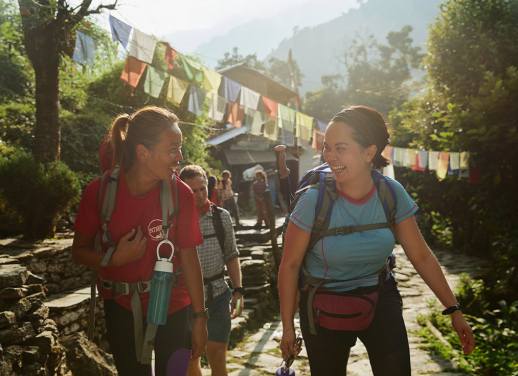
Joni Taisey
One of my favourite parts about travelling is people watching at the airport, but not in a creepy way. I promise. I also enjoy the actual travel part of travel. I’d pick burritos over tacos, lakes over oceans and mountains over beaches every time.
You might also like
Learn how to leave hack your 2025 canadian..., level up your australian public holidays in 2025, how to make the most of us federal..., make the most of nz’s public holidays in..., top us national parks, how to maximise your annual leave using uk..., 7 incredible hikes in denali national park, unique getaways for your next girls’ trip, how to visit europe in the off-season, best places to travel in march, best places to travel in may.
Trekking and Peak Climbing in Nepal
- Regd. No.:63295/065/066
- Tourism Licence:1632
- VAT No.:303818070
Home » Nepal Trekking Guide » Best Monsoon Treks in Nepal
Best Monsoon Treks in Nepal
Here, we are going to discuss Best Monsoon Treks in Nepal that are listed in this article.
Monsoon is really not the best time for trekking. Well, that’s what most people think or at least a misconception which non-amateur hikers hold. However, for seasoned travelers, it’s a perfect time to step-up the game and become more adventurous with unforeseen challenges.
The airy setting is just the right moment to walk the well-worn path leading to Himalaya. Despite the humid weather, the rain succeeds to gather enough moisture, causing the walk on steep hills relatively easier.
Monsoon makes everything look angelic in the region, the soaring hills, resonant valleys, and freshly watered forests. As the cloud effaces, mountain ranges in the Himalaya glimmer like never before, putting on fabulous views.
The everlasting downpour refuels streams and waterfalls scattered across the hills, giving another excuse to hike. Mysterious valleys and snow-covered mountains cheer up after the rainfall for a very long time.
Meanwhile, the continuous drizzle and gust of wind scrub off all the dust, providing a crystal clear view. There are fewer trekkers on the trail in monsoon due to which you’ll get to have all the time to rove around.
Given its diverse landform, Nepal has got plenty of treks that are suitable to do in Monsoon. Most of these hikes have mild walking trails that can be done in nontime. Some of the best monsoon treks in Nepal that can be easily accessed are as follows.
1. Annapurna Circuit Trek
Annapurna Circuit Trek looks utopia all year round but things spice up a little bit more during monsoon. The season evokes nature like anything else, putting a marvelous view behind steep hills and verdure.
Sounds unlikely but monsoon actually brings forth wonderful weather to walk the rugged trails of Annapurna Circuit. Although some sections are filthy with mudholes, the overall scenery is great. Perched within Annapurna Conservation Area , the trek gets going with a flight to Pokhara.
With the trail as long as 124 miles, you’ll have to walk an average of 5-6 hours every day to reach the circuit. The paths are well-marked and scour several quaint villages and teahouses offering delicious Nepali food and western dishes as well.
The Alpine forest above Marsyangdi River Valley is intriguing to walk through. In fact, there’s a good chance for you to stumble on some of the rare wild animals and birds habitat to the mountain region.
At 5,416 meters, Thorong La Pass draws the attention of visitors to itself, providing awesome sights to catch. The few little things that stand out over others include the picturesque Annapurna massif, Tilicho Peak, Manaslu, and Kali Gandaki gorge.
Annapurna Base Camp trek finishes off with a bang in the Kali Gandaki gorge after starting the journey all the way from Besisahar. With so many incredible things to encounter, it’s reasonable to say that Annapurna Circuit is one of the best monsoon treks in Nepal.
- Full Name *
- Country * Afghanistan Åland Islands Albania Algeria American Samoa Andorra Angola Anguilla Antarctica Antigua and Barbuda Argentina Armenia Aruba Australia Austria Azerbaijan Bahamas Bahrain Bangladesh Barbados Belarus Belgium Belize Benin Bermuda Bhutan Bolivia Bonaire, Sint Eustatius and Saba Bosnia and Herzegovina Botswana Bouvet Island Brazil British Indian Ocean Territory Brunei Darrussalam Bulgaria Burkina Faso Burundi Cambodia Cameroon Canada Cape Verde Cayman Islands Central African Republic Chad Chile China Christmas Island Cocos Islands Colombia Comoros Congo, Democratic Republic of the Congo, Republic of the Cook Islands Costa Rica Côte d'Ivoire Croatia Cuba Curaçao Cyprus Czech Republic Denmark Djibouti Dominica Dominican Republic Ecuador Egypt El Salvador Equatorial Guinea Eritrea Estonia Eswatini (Swaziland) Ethiopia Falkland Islands Faroe Islands Fiji Finland France French Guiana French Polynesia French Southern Territories Gabon Gambia Georgia Germany Ghana Gibraltar Greece Greenland Grenada Guadeloupe Guam Guatemala Guernsey Guinea Guinea-Bissau Guyana Haiti Heard and McDonald Islands Holy See Honduras Hong Kong Hungary Iceland India Indonesia Iran Iraq Ireland Isle of Man Israel Italy Jamaica Japan Jersey Jordan Kazakhstan Kenya Kiribati Kuwait Kyrgyzstan Lao People's Democratic Republic Latvia Lebanon Lesotho Liberia Libya Liechtenstein Lithuania Luxembourg Macau Macedonia Madagascar Malawi Malaysia Maldives Mali Malta Marshall Islands Martinique Mauritania Mauritius Mayotte Mexico Micronesia Moldova Monaco Mongolia Montenegro Montserrat Morocco Mozambique Myanmar Namibia Nauru Nepal Netherlands New Caledonia New Zealand Nicaragua Niger Nigeria Niue Norfolk Island North Korea Northern Mariana Islands Norway Oman Pakistan Palau Palestine, State of Panama Papua New Guinea Paraguay Peru Philippines Pitcairn Poland Portugal Puerto Rico Qatar Réunion Romania Russia Rwanda Saint Barthélemy Saint Helena Saint Kitts and Nevis Saint Lucia Saint Martin Saint Pierre and Miquelon Saint Vincent and the Grenadines Samoa San Marino Sao Tome and Principe Saudi Arabia Senegal Serbia Seychelles Sierra Leone Singapore Sint Maarten Slovakia Slovenia Solomon Islands Somalia South Africa South Georgia South Korea South Sudan Spain Sri Lanka Sudan Suriname Svalbard and Jan Mayen Islands Sweden Switzerland Syria Taiwan Tajikistan Tanzania Thailand Timor-Leste Togo Tokelau Tonga Trinidad and Tobago Tunisia Turkey Turkmenistan Turks and Caicos Islands Tuvalu Uganda Ukraine United Arab Emirates United Kingdom United States Uruguay US Minor Outlying Islands Uzbekistan Vanuatu Venezuela Vietnam Virgin Islands, British Virgin Islands, U.S. Wallis and Futuna Western Sahara Yemen Zambia Zimbabwe Country
- Number of Travellers *
- Phone Number
- Approximate Date Day 1 2 3 4 5 6 7 8 9 10 11 12 13 14 15 16 17 18 19 20 21 22 23 24 25 26 27 28 29 30 31 Month 1 2 3 4 5 6 7 8 9 10 11 12 Year 2025 2024 2023 2022 2021 2020 2019 2018 2017 2016 2015 2014 2013 2012 2011 2010 2009 2008 2007 2006 2005 2004 2003 2002 2001 2000 1999 1998 1997 1996 1995 1994 1993 1992 1991 1990 1989 1988 1987 1986 1985 1984 1983 1982 1981 1980 1979 1978 1977 1976 1975 1974 1973 1972 1971 1970 1969 1968 1967 1966 1965 1964 1963 1962 1961 1960 1959 1958 1957 1956 1955 1954 1953 1952 1951 1950 1949 1948 1947 1946 1945 1944 1943 1942 1941 1940 1939 1938 1937 1936 1935 1934 1933 1932 1931 1930 1929 1928 1927 1926 1925 1924 1923 1922 1921 1920
- Send us your enquiry *
- Solve (6+6=?) & submit button will appear *
2. Upper Mustang Trek
One of Nepal’s best-known landmarks, Upper Mustang is historied for its breathtaking landscapes, fascinating culture, and welcoming people. More so, it’s cherished for the deserted terrains, hidden stone caves, and ancient fortresses which act as a crown jewel to the region.
Mustang cast a shadow of dryness in the area on the leeward side, causing most of its trail to be arid. Simultaneously, with high precipitation and steep trails, it becomes really hard to course the path. But, thanks to the scintillating views on the journey which gives a sense of relief and comfort.
A lot of incredible sights to see on the way including mud walls, spectacular cliffs, and quaint villages. The Kali Gandaki riverbed peeked at by rolling hills and rocks looks no less than a paradise. Its old buildings and monasteries carrying a legacy of centuries, says a lot about the civilization and people inhabiting that you won’t even have to bother querying.
Upper Mustang trek normally kicks-off with a flight to Jomsom, which sits right before two shimmering peaks, Dhaulagiri and Niligiri. The trail passes through small settlements like Kagbeni and Syangboche before finally arriving at Lo-Manthang.
Sited at the northern end of Mustang , Lo is a forbidden kingdom with primordial palaces and monasteries. It has got a slew of interesting sites to explore, Thubchen Gompa, saint’s tomb, and inn to name a few. Hence, Upper Mustang is no doubt, one of the best monsoon treks in Nepal.
You may also like:
- Langtang Gosaikunda Trek Itinerary
- Trekking in Annapurna Region
- Cultural Tours in Nepal With Exciting Nepal Treks
3. Phoksundo Lake Trek
It wasn’t too long ago when Phoksundo Lake Trek came to the notice of people and today it has already become a go-to destination for every avid trekker during monsoon. The old trails stopping in countless villages and ascending over hills has been fancied by off-season hikers
But, with its serene turquoise lake, enclosed between mountains, it’s easy to see why people are so obsessed with the trip to Phoksundo. The lakeshore provides itself a stunning landscape and mountains all across, where even the howling sound of wind can be heard.
Hikers who visit Phoksundo Lake in Monsoon will get vast swathes of remote settings and countryside views throughout the trek. They’ll also get to see the slow-moving glaciers, captivating ridges, and fluttering prayer flags.
Nested at Dolpo district at 3,611 meters height, Phoksundo Lake is splendid beyond description. The hike is not as easy as you think with more than a week-long journey, passing over several villages including Dunai and Ringmo.
You’ll even have to walk through Kang-La Pass which is quite strenuous for most hikers. The trails are slightly steeper and rough but the scenery ahead is extraordinary. Keep your eyes peeled on the way to watch the magnificent Shey Gompa at 4,126 meters and other religious pilgrimages.
4. Nar Phu Valley Trek
Nar Phu Valley has always been an interesting place to visit with astounding views. But it’s only a few years ago when the valley came to the fore with trekkers going absolutely nuts about it. Its beautiful settings with green pastures, untamed hillocks, and forest paths hypnotize every visitor walking the trail.
From vibrant culture-brimmed villages to incredibly diverse locals, everything is mesmerizing about Nar Phu Valley . With the increasing elevation, you’ll get a clearer picture of Annapurna massif, Tilicho Peak, and Langtang Himal. You can even spot the moving glaciers from the edge of the hills which gleams on any clear day.
Since the valley lies in a remote part of Annapurna, most of the trek routes are unpaved and filled with rocks. Hence, walking the trail in the monsoon might cause a bit ruckus but the reward is still worth the effort.
You’re able to explore the otherworldly landscapes, towering stone cliffs, and walls throughout the valley. A lot of well-preserved Tibetan monasteries, eye-pleasing Chortens, and timeless culture will take you back to history.
5. The Ghandruk Trek
If you’re only for a short time in Nepal but want to experience the lifestyle and culture in the mountain then Ghandruk is the trek for you. As compared to other hikes, it takes merely a week to finish walking the path of Ghandruk which makes it one of the best monsoon treks in Nepal.
Without ascending mountains and endless steep routes, you’ll get all the flavors of the region, be it the flourishing culture or panoramic views of snow peaks. Like most treks in the Annapurna region, the trip to Ghandruk also commences with a short drive from Pokhara.
The trek involves roving foothills and into the woods before and even after Pothana, a small village in Dhampus . The walk to Ghandruk village is always meant to be magical with the setting of luscious pasture, lofty hills, and mountains.
There are enough rustic shelters and teahouses in Ghandruk for one to stay overnight. It also serves as a viewpoint to watch the first sunrise of the day. However, to enjoy it and the astounding sight of Annapurna as well, you’ll have to wake up before dawn.
Since Ghandruk lies at an elevation of 2,012 meters , the weather can get nasty in monsoon. Thus, you have to be a bit careful while stopping at the village and make sure that you don’t catch a cold.
6. Rara Lake Trek
Trek in the wilderness always comes with staggering surprises and picturesque vista. That explains why most trekkers visiting Nepal are so anxious to explore Rara Lake Trek , after all, it’s so exquisite and fascinating.
Rara Lake looks like an earthly paradise with a tranquil freshwater tucked between the snow-capped mountains and forests. It’s a part of Rara National Park, straddled between Jumla and Mugu in mid-western, Nepal.
Spanned in an area of 6.11 sq. mi. Rara Lake offers visitors a breathtaking view of high cliffs and sweeping landscapes. As monsoon sweeps the dust in the air, the mirror image of towering snow peaks and passing clouds is clearly visible on the surface of the water.
Visitors can also walk into the woods for birdwatching and taking glimpses of more than 51 species of mammals. Avid thrill-seekers can ride horseback on the lakeside or even row the boat on Rara lake.
7. Humla’s Limi Valley Trek
Humla’s Limi Valley is still hopeful of getting a long-overdue recognition someday. But, as of now, it struggles to gain popularity due to limited access and remoteness. Fortunately, with more travelers open to beat off the beaten track, Limi Valley enlivens with visitors in Monsoon.
Of course, the endeavor’s pay them big time with a heartwarming view of mountains and lowland plains. Trekkers are likely to get a sneak peek inside the culture and lifestyle of people in Humla. The trail follows an ancient salt caravan through the rolling hills in the mountainside to reach the valley.
Coming along the way, you’ll get to squint at the primordial Tibetan monasteries and prayer flags in Humla. Some of the gompas here are from the 11th century intertwined with shamanistic influences that epitomize the rich history of Humla.
This ancient valley is also famous for Halji Rinchenling Monastery where devotees come to offer prayers. Walking through the forest to watch wild animals like Himalayan Black Beer, Snow Leopard, and marmots are pretty thrilling. Thus, if you want to do the best monsoon treks in Nepal then Humla’s Limi Valley is your pick.
8. Tilicho Lake Trek
After escaping months of blazing hot summer, June is the ideal time to step out of homes and relish nature. And, where better to traverse for a breath of fresh air than Tilicho Lake in Manang. Situated 55 km from Pokhara, Tilicho Lake is a piece of heaven on the earth.
It’s crammed with stunning landscapes, sky-scraping mountains, and cliffs. It’s fed on entirely by glacial runoff which is why the water is still and transparent. The minute you enter the sanctuary, home to Tilicho Lake, all the high humidity and heat waves will go away.
You can whiff the fragrance of fresh snow in the air even while scrambling the trail in the distance. The sight of shimmering snow peaks and vivacious valleys whose charm doesn’t wither despite heavy rain is the highlight of the trek
Just in case you don’t know, Tilicho is one of the highest lakes in the world with unrivaled beauty. You’ll have to spend at least 2 weeks on the trail, making stops in Chame, Pisang, and Khangsar village to finish at Tilicho Lake.
There are no crowds in this part of the region during monsoon which means you’ll get to explore the sublimity of Tilicho just the way you like it. The rugged route with boulders makes the trek a bit harder and exhausting. But those who prefer comfort can take their time and stay at tea houses before gently climbing the trail.
9. Ruby Valley Trek
Ruby Valley Trek is one of the most underrated and also best monsoon treks in Nepal. With only a handful of travelers familiar with the hike, Ruby Valley doesn’t receive too many guests. But, regardless of how many wayfarers visit the region, its eminence doesn’t slump.
Located in north-central Nepal at the sub-range of Himalayas, Ruby Valley is a hidden gem of Nepal. It has got spectacular scenery and a bunch of incredible places to explore. The hike will pretty much give you the taste of mountain culture and people’s way of living, especially the Tamang and Gurung community .
The views from Ruby Valley are some of the best you may have ever come to witness. It offers the unobstructed vista of dazzling mountain ranges including Ganesh Himal and Manaslu.
Unlike anywhere else in the town, you’ll get to see stone flour mills and numerous suspension bridges while on the trek to Ruby Valley. Since its trails are not busy at all with fewer tourists visiting the neighborhood, you won’t have to rush.
Other than sightseeing, you can go through the villages and take an insight into the customs of different ethnic groups inhabiting together. If that’s not enough, walk into the woods in spare time and have sight of various wild animals including Himalayan tahrs and musk deer.
10. Gokyo Ri
Do we even have to say why Gokyo Ri is on the list of best monsoon treks in Nepal, particularly after the overwhelming views it brings with itself? One of the most popular and also best monsoon treks in Nepal, Gokyo Ri has got everything that tempts hikers.
Roosted at an elevation of 5,357 meters, Gokyo Ri is some of the few places from where you’ll get a close shot of the world’s highest peak, Mount Everest. Moreover, the place also manages to get an awe-inspiring view for the visitor even on the rainiest days.
It’s always exciting to navigate the trail of Gokyo Ri that walks through many villages including Namche Bazaar. It’s a famous Sherpa town in Khumbu Valley where most trekkers acclimatize and explore the renowned spots.
The trek routes of Gokyo Ri are best explored on foot. Trekkers shall be scrambling the steep trails from Lukla and pass multiple villages including Dole and Machhermo. Walking along the path, you’ll get a glimpse of Tibetan monastery, mani walls, and gorges.
In comparison to other treks, Gokyo Ri is a bit tough, requiring to walk an average of 5-6 hours each day. The path is as majestic and divine as you can think, winding through dense forests and suspension bridge to reach the final destination.
11. Kathmandu Valley Trek
There’s no denying that Kathmandu Valley is one of the best monsoon treks in Nepal. Unlike most hikes, it doesn’t require a month-long plan or any extreme preparation. In fact, visitors can do the trek in the quickest amount of time due to easy access and less difficult level.
To escape the city hustle and enjoy nature, you can traverse lots of places on the outskirts of Kathmandu. Some of the popular as well as short hikes include Nagarkot Chisapani Trek, Lakuri Bhanjyang, Shivapuri National Park , and Ranikot hike.
Though all these treks are close to the city, they offer quite impressive views of snowclad mountains, colorful valleys, and cascading waterfalls. Some places at a high elevation even offer the sight of undulating hills and timeless enchanting lakes.
Most of these treks have short trails and thus can be done in less than a week. As the paths are well-defined, you can tour the places without the help of a guide. Moreover, you won’t have to fear altitude sickness as the hiking trail doesn’t escalate more than 3000 meters.
12. The Tamang Heritage Trail
It’s a newly introduced hike in Nepal. And yet, Tamang Heritage Trail is more striking and adventurous than many other old treks. It’s a moderate hike and with no technical difficulties except a few ups and downs. Hence, the beginners too can traverse the trail of Tamang Heritage in as little as 5 days. Visit the region in Monsoon and you’ll get a picture-worthy scenery as the rain washes out all specks of dust, providing a clear view of hills. It also offers a soul-stirring view of highlands, widespread topography, and a stunning backdrop of green hills. You can even notice the sparkling mountains over cloud and rhododendron forests dispersed far and wide.
The Tamang Heritage Trail has dramatically varied terrains that sit right alongside and beneath the walking trails. The easiest way to reach the Tamang village is to start off from Syabrubesi and make the way through Gatlang and Tatopani before finishing it off in Briddim.
Similar articles you may like:
- Everest Base Camp Trek in January
- Annapurna Base Camp Trek Difficulty
- Lower Manaslu Trek 13 Days Itinerary
Final Verdict
With its lovely weather, warm and sunny days, and light rainfall, Monsoon in Nepal is guaranteed to capture your heart and soul. The earthy smell and clear blue sky after heavy showers make you feel energized and cozy.
Trekking in the monsoon means you won’t have to deal with too many crowds. It’s easy to flee the trail and spend as much time you like in one place without any interruption. The accommodation comes cheap as you can even negotiate the price in lodges and teahouses at your chosen destination.
As it falls right between summer and autumn, the weather is quite subtle during monsoon. It’s neither too hot nor cold, making just the right time to travel moors and relish the marvelous view.
The path is sure to keep you busy all day long, providing a view of sprawling meadows, hovering mountains over clouds, and resonating valleys. Sightseeing streams and waterfalls make complete sense with the rain providing enough water. Hence, if you’re well-prepared and doing one of the best monsoon treks in Nepal, the expedition will for sure be thrilling.
Managing Director
Mr. Subash K.C ventured into the tourism industry after completing his studies in Management Stream in 2001 at Tribhuvan University. Mr. K.C, born and brought up in the Lalitpur district, is keenly interested in exploring the different trekking routes. Getting the opportunity to work in the tourism industry helped him gather insights about trekking across Nepal. In addition, he also learned about customer care and group management. By leading solo and group trekkers himself, he started collecting data about many trekking destinations in Nepal. He creates an enriching experience for national and international travelers through exceptional hospitality.
Apart from managing trekking and tours, Mr K.C also handles client inquiries, accommodation reservations, arrangements of transportation and flights, and other logistics. Recognizing the importance of personalized service, he proactively takes care of clients' needs and requirements. He is fluent in English and excels in organizing treks, tours, and adventure sports in Nepal, Tibet, and Bhutan.
He is highly committed to promoting responsible tourism and prioritizes client satisfaction by providing top-notch service through his well-organized company. He believes that through responsible traveling, we can protect the natural environment and promote sustainability. He has expanded his knowledge by traveling to various countries worldwide, such as India, Bhutan, Switzerland, Germany, France, Italy, Thailand, China, Singapore, Philippines, Vietnam, USA, Japan, UK, Canada etc and is passionate about exploring more destinations.
Traveling to Nepal during the Monsoon season

Travelers often like to feel the rain, while others just get wet. Travelers wait for it to rain and then go out into the street. The experience of traveling in the monsoon rains is truly magical, something that should be experienced by everyone at least once.
Traveling and trekking in Nepal during the monsoon season has a certain charm. In Nepal, the monsoon season begins in June and lasts until August. Monsoons provide the best opportunity to enjoy nature in Nepal and gain the finest travel experience.
Travel during the monsoon season can provide a number of added benefits including savings on luxury hotels, a greener landscape, smaller crowds, and the chance to attend some of Nepal’s most elaborate festivals. Monsoon brings more spectacular sunrises and sunsets, as well as a better view of the mountains.
During the rainy season, traveling can be more challenging. Travel plans can change, delays can occur, and there is more water everywhere. However, the monsoon season is one of the most beautiful times of the year, and you can only appreciate its beauty if you witness it in full glory.
Get ready for this monsoon and visit Nepal with us to enjoy the mischievous sky and fresh air.
Trekking during Monsoon, is it worthwhile?
People are becoming more and more open to the idea of touring and trekking during the monsoon season. Trekking in the monsoon season offers many hidden benefits, such as the lack of crowds, so you can enjoy many places all by yourself. You may want to explore Nepal during the monsoons for a number of reasons.
Beautiful Sunrises:

During the night, it usually rains, and in the morning the sky begins to clear. One of the most picturesque sights in the world is when the sun breaks through those rain-bearing clouds, drenching the snow-covered mountains in brilliant colors.
Lush, Green Beauty:

During the monsoon season, the Nepalese Himalayas are especially beautiful. Throughout the trails, lush vegetation is growing, and flowers are blooming everywhere. The terraced fields look wonderful during this period.
Destinations during the Monsoon season:
- Explore the cultural richness of World Heritage Sites

The beautiful heritage sites in Nepal are open and safe to visit throughout the monsoon season.The stone and metal around the temples also make lovely photographs if it’s been raining.
You can traverse the medieval Kathmandu valley for historical, cultural, and religious explorations. It is great for those who are interested in exploring the architecture, cultures, and traditions of Kathmandu, Bhaktapur, and Patan.
Also possible during the monsoon are visits to Lumbini and Chitwan National Parks which are both World Heritage Sites. Travel is not affected during these months either, as flights and transportation remain normal.

Pokhara is considered one of the most beautiful valleys in Nepal. This valley is located in the Kaski district in the western part of Nepal and is famous for having many beautiful lakes. Thus, Pokhara is also called the City of Lakes’.
The city also consists of many caves, waterfalls, rivers, hills, mountains, trek and adventurous places, and natural beauty. So naturally, the place offers you a lot to enjoy during the monsoon.

Chitwan is located 150 km southwest of the capital, Kathmandu; that includes Chitwan National Park (a Natural World Heritage Site), Ranipokhari, Bishazari Lake, Jalbire waterfall, Shiraiculi hill, and many more.
Chitwan can engage you with activities like elephant ride and bathe, cultural programs by the Tharu community, the sunset view from Narayani riverbank, crocodile breeding centre, and many more during monsoon.
- Upper Mustang

Though Upper Mustang is considered the desert of Nepal, a trek in the monsoon is great fun. It is so because the wind in other seasons is menacing and may ruin your trek. It never rains in Mustang but the rain shadow in the monsoon makes the wind less active, which eases the trip and shows the breathtaking art of nature.

Rain shadow areas such as Dolpo (upper and lower), Upper Mustang, Nar-Phu Valley, and Upper Manang are ideal for trekking in the monsoon season. They do not experience heavy rainfall.
Moreover, you can see cultural blends, traditional performances, ancient scenery, marvelous scenery, and primitive caves in addition to the unique and varied landscapes, especially during the monsoon season.

Located in western Nepal’s Tanahun district, Bandipur is one of the most popular tourist destinations to visit during the monsoon. Aside from the 18th-century houses that have been turned into restaurants, the place also has temples, caves, amazing valleys, and forests, along with natural views of green hills. A special treat during the monsoon season is to watch the sunrises and sunsets.
- Trishuli River

If you want to experience the adventurous side of the Himalayas, then the Trishuli River is a great destination. Trishuli River offers a unique opportunity for adventurers to view an incredible glacier while experiencing the natural beauty of the surrounding area during the monsoon season.
The Trishuli River which originates through a forest valley is one of Nepal’s most popular destinations for rafting, kayaking, day trips, and camping.
- Enjoy Agricultural Activities

In Nepal, agricultural activities are heavily dependent on the monsoon. Planting corn, planting rice in paddy fields, and other agricultural activities can be enjoyed almost everywhere in the country. Taking part in such activities can give you a sense of how locals live and what they do.
Final Words
The monsoon season in Nepal is an ideal time for travel, as you can enjoy a lot of activities despite the rain. So, get your bags packed and get ready for your journey.
No Comments yet!
Cancel reply.
You must be logged in to post a comment.
Recent Posts
Langtang valley trekking, best luxury accommodation in kathmandu valley, rhododendron view trek, trishuli river rafting tour in nepal, the best local delicacies of nepal.
- Community Based Tourism
- Luxury Holidays
- All Nepal Tour
- Cultural tour
- Experiential Tour
- Jungle & Wildlife
- Nature & Landscape
- Annapurna Trekking
- Everest Trekking
- Langtang Trekking
- Peak Climbing

- Destination
- Nepal Trekking
7 Best monsoon treks in Nepal
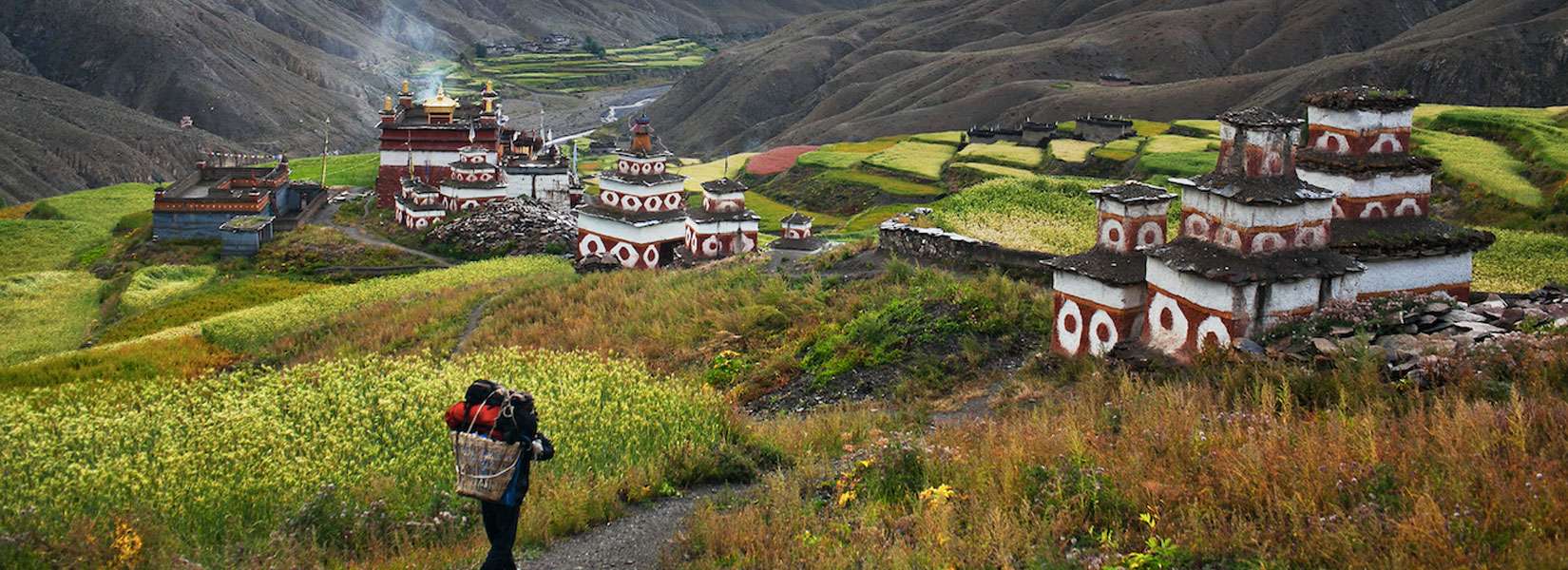
Monsoon trekking in Nepal
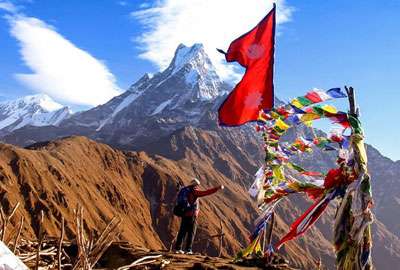
Mardi Himal Trek 4 Days
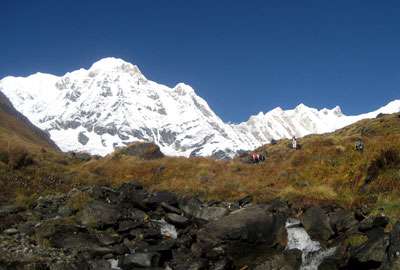
Annapurna Base Camp Trek 7 Days

Classic Langtang Valley Trek
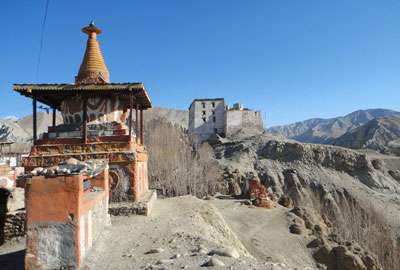
Upper Mustang Trek
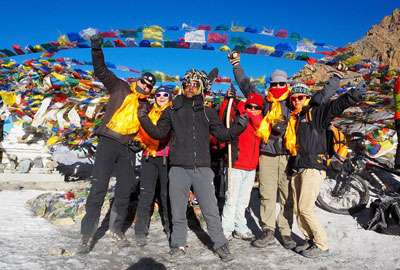
Annapurna Circuit Trek

Nar Phu Valley Trek
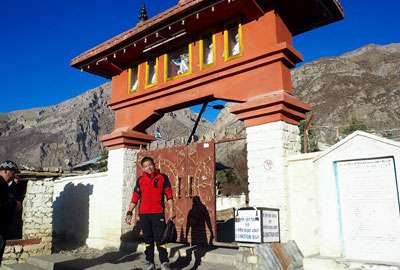
Lower Mustang Trek
Usually, most of the information on web pages and trekking and travel agencies in Nepal suggests fall and spring seasons are the best times to trek in Nepal but Nepal also offers some of the best monsoon treks as well that offer very peaceful treks without crowds. It is always while the fall season may have the clearest sky, trekking during the summer (from the beginning of June, July, and August) has its rewards. Some treks should be avoided, but for certain areas, it is a great time to visit Nepal: the trails are less crowded, the villages are full of life and the valleys are in bloom and green whereas winter and spring are dry and grey.
Trekking in Nepal during the monsoon season or the summer spans from the beginning of June to August and sometimes until early September has heavy rainfall in most parts of Nepal and the roads and trekking paths become wet and muddy and the weather is the most important factor for the trekking so, there are noticeable risk of landslide, flood and trail and roadblocks on your trekking route so, we have selected only few treks for the season where there is less risk of these factors.
Cultural city tours such as the Kathmandu tour, Pokhara, Lumbini tour, and Safari in Chitwan National Park have no issues and they are accessible and very doable all around the year and some short treks such as the Annapurna Base Camp , Langtang Valley Trek , Mardi Himal Trek , Ghorepani Poon Hill Trek are possible on monsoon in Nepal providing peaceful environment without crowd like in peak seasons, full of green and alpine flowers blossomed with chances of great landscape view.
If you can allow time for a couple of weeks or more; the best places to trek during July and August are Nar Phu Valley, Lower Mustang, A part of Annapurna Circuit, and Manaslu Circuit which are said to be under the rain shadow and low budget trek. Upper Mustang and Upper Dolpa are the best places to trek in monsoon. Trekking in July and August can be best for botanical keens. Wilderness Excursion offers 7 best following monsoon and summer season treks for 2024 and 2025. Find below some packages listed as monsoon treks that can be done through June, July, and August. Though July and August are off-season in Nepal; the advantages of monsoon trekking in Nepal are that you have quiet trails without people, very less trekkers you meet, you get the full attention of the local teahouses as they have fewer customers, and you find more intimacy than in a peak season, overall experience with the local people and culture. Also, the rivers and waterfall are roaring and surging, the fields are green and spring is in bloom. Happy trek with Wilderness Excursion!
- Short treks near Kathmandu Valley
- Annapurna Trekking
- Manaslu Trekking
- Everest Trekking
- Langtang Trekking
- 20 Best Nepal off the beaten track
- Wilderness Trekking in Nepal
- Ganesh Himal Trekking
- Dhaulagiri Trekking
- Dolpo Trekking
Ask A Question
Direct call support:
We are associated


+977-9841613822 Email: [email protected]
Tour in Nepal During Monsoons
Tour & trekking in nepal during the monsoons.
There is something rather charming about tour and trekking in Nepal during the monsoons . Fall might be the most popular season, and it also gets a lot of footfall, but there are a number of tour and treks that are great to trek during the monsoon season. Read on to find out how you can get the most out of your tour and trekking adventures in the country, and discover the best tour and treks s in Nepal during the monsoons.
The monsoon season lies between mid-June and early September.
The average temperature around this time is 71 degrees Fahrenheit (22 degree Celsius), and it keeps going down as you start gaining altitude.
The average rainfall is between 135 – 325 mm, with July being the wettest month.
Rains usually occur during the evening and night, so you can expect anything between 7 to 11 hours of sunshine, depending on your location.
Why tour and Trek During the Monsoon Season in Nepal ?
More and more people are opening up to the idea of tour and trekking during the monsoons. The benefits of trekking in monsoons are unsung and the lack of crowds means that you get the place all to yourself! Here are just some of the reasons why you should explore Nepal during the monsoons.
Beautiful Sunrises: It usually rains during the night, and by morning the skies start clearing up. The sight of the sun’s rays breaking through those rain-bearing clouds, drenching the rain-soaked mountains with their glittery hues, is one of the most spectacular sights in the world.
Have the Mountains All to Yourself: The trails are usually deserted during the monsoon season. If you’re dying for some isolation and wish to have the best of nature all to yourself, a monsoon trek in Nepal is probably the best experience for you. It’ll just be you and the mountains!
Lush, Green Beauty: The Nepalese Himalayas are particularly beautiful during the monsoons. Many trails are bursting with lush vegetation, and flowers are blossoming everywhere. The agricultural terraces look stunning throughout this season as well.
Best Places to Trek and tour this Monsoon
There are so many treks and tour in Nepal that feel particularly amazing during the monsoon season. Most of these treks lie in the rain shadow regions, places where rain-producing clouds get blocked by those dramatic mountains. Simply put, while the rest of the land gets drenched in rain, these poor souls tend to lose out. It’s not to say that there will be no rain in these areas, but it will be considerably lower. Here are some of the best monsoon treks for you to try out this monsoon, in no particular order:
The Annapurna Circuit Trek
The upper sections of Annapurna Circuit, towards Manang, and Thorong La Pass, and into Muktinath, fall under the rain-shadow region. The views of the Annapurna Mountain and Muktinath are absolutely breath-taking during this period and the agricultural fields of Manang will also be lush and splendidly green, thanks to all that rain. The trails in this circuit are well-marked, so you’ll never have to worry about getting lost and those delicious-looking Nepali teahouses and friendly locals will make sure that you have plenty of rest, food and cultural exchange surrounding you throughout your tour.
Duration: 13- 14 Days
Getting There: Start the circuit from Bhulbhule, and head up to Jomsom, as these are the easiest areas to access.
Manaslu Trek
Manaslu trek – a great monsoon trek in Nepal
As with the Annapurna Circuit the great Manaslu trek also lies in the rain shadow and hence, is ideal during the monsoon season. In recent years, the Manaslu trek has become more and more popular due to road building on some parts of the Annapurna Circuit trek. The Manaslu trek has no read building, and where the Annapurna Circuit trek treks around the Annapurna range the Manaslu trek treks around Mt. Manaslu, the world’s eight highest mountain. Where trekkers are crossing the Thorong La the Manaslu trek is remote, pristine and one of Nepal’s best treks. We highly recommend this trek during the monsoon season.
Duration: 14 days
Getting there: You will start the Manaslu trek from Arughat and trek you way up from 700 meters and up to 5100 meters, crossing the Larke Pass. It’s a 7 hours bus journey from Kathmandu to the trek starting point.
Upper Mustang Trek
Buddhist monastery on the rocky hills with snowy mountains in Upper Mustang Nepal
This is one of the most popular (and most expensive) treks in Nepal. The entire trek is in the rain-shadow region, so you won’t have to worry about the rains at all. The trail leads you through arid, 4000-meter mountain passes, with the backdrop of some of the highest peaks in Nepal. Through the course of the trail, you will pass by the world’s deepest gorge (Kali Gandaki), isolated villages like Kagbeni, Chhuksang and Ghame, and the Tibetan cultural center of Lo Manthang, the forbidden kingdom.
Duration: 14 Days
Getting There: The rains might make it difficult for you to get to the trail by road, so it is recommended that you fly into Jomsom.
Dolpa Circuit
Dolpa is a highly underrated trekking circuit in Nepal. The area was closed to foreigners till 1989; so much of it still maintains a mystery. If you want to escape from the rest of the world and reconnect with nature, this is the best spot for you to do so. The trail is centered on the Lake Phoksundo, which is Nepal’s deepest lake. Its location between the mountains and a rich blue color makes it look rather magical. The area also has a lot of cultural offerings and it is worth spending some time at the Tshowa Monastery to learn more about the Buddhist culture.
Duration: 12- 14 Days
Getting There: Start and end the trek at Juphal. Juphal can be reached from Nepalgunj, which is well connected to Kathmandu by flight. The roads to Juphal might be blocked due to the rains, so a flight is the best option.
Everest Base Camp Trek
The trek to Everest Base Camp is one of the most crowded trails in the entire world, but during the monsoons, the crowds tend to thin out significantly. While there will be some amount of rain towards the beginning of the trek, as you ascend to higher altitudes, the rains will reduce, presenting some of the most magical landscapes on the planet. The trail is one of the most beautiful in the world- the view of the tallest mountain in the world from Kala Patthar itself makes the entire trek worth it. The beautiful Namche Bazaar, Tengboche Monastery, and Khumbu Glacier all await you in this trail.
Duration: 12-13 Days
Getting There: You can fly to Lukla from Kathmandu, and start the trail by walking to Phakding.
Humla’s Limi Valley Trek
Humla is another underrated travel destination in Nepal due to its remote location. This isolated trail gives trekkers an unparalleled panoramic view of the mountains, especially of Mt. Saipal and Mt. Kailash, and also the chance to immerse oneself in the Buddhist culture of the region. Limi Valley used to be an ancient trade route- one you can still follow from Hilsa (where Nepal’s longest river, Humla Karnali, enters the country) after crossing the Nara La Pass. If you are lucky, you can end up spotting the elusive snow leopard, or the more common musk deer, and blue sheep.
Kathmandu Tours 2024/2025
Whether you are in Kathmandu for a short getaway or have a few days to prepare for a Nepal Guide info team, there is no need to stay within the confines of your hotel. Kathmandu has many unique things to see and do. In three days, you can see many of the Kathmandu Valley’s highlights, from markets, temples and cultural sites to sunsets, mountain views and hiking.
Day by day Itinerary
Day 1 Welcome to Kathmandu =Kathmandu
Day 2 Explore Kathmand=Kathmandu
Day 3 Kathmandu to Nagarkot; optional visit to Dhulikhel or NamoBuddha =Nagarkot
Day 4 Nagarkot to Bhaktapur =Bhaktapur
Day 5 Tour Bhaktapur, tour Pata =Patan
Day 6 Depart Kathmandu
Recent Post
- Hiring Guides / Porters in Lukla Everest~Nepal
- Nepal: Everest Base Camp trek Details information
14 Everest Base Camp Yoga Trek- Booking Open for 2025
Nepal: everest base camp via gokyo trek 2025, visit nepal 2025 best offers for mount everest base camp trek, post category.
- Climbing (0)
- Culture (0)
- Expeditions (0)
- Festivals (0)
- Nepal Travel advice (0)
- Travel Blog (221)
- Trekking (0)
Talk to Expert
Related blog.

A superb tranquility has taken ownership of my whole soul, like these sweet mornings of spring which I appreciate with my entirety heart. I am so upbeat, my expensive companion,…

Associate and Certified
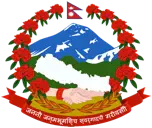
Recommended By


- 20 Best Monsoon Treks in Nepal
- You are here:
- Trekking in Nepal Guide
- Jun 5, 2024
Rupak Parajuli
Nepal , a paradise for trekkers, transforms into a mystical wonderland during the monsoon season. While many associate trekking in Nepal with the dry, post-monsoon months, the rainy season brings a unique charm to the Himalayan trails. Monsoon trekking unveils lush green landscapes, thriving flora, fewer crowds, and an intimate connection with nature. In this comprehensive guide, we explore the best monsoon treks in Nepal, offering insights, tips, and inspiration for your next adventure.
Why Trek in Nepal During Monsoon?
Trekking in Nepal during the monsoon season, from June to September, may not be the first choice for many adventurers, but it offers unparalleled experiences. The landscapes turn vibrant green, rivers swell, and waterfalls gush with newfound vigor. The air is fresh, and the trails, often deserted, provide a peaceful trekking experience. Monsoon treks also offer a glimpse into the local way of life, as communities thrive during this season with agricultural activities and cultural festivals.
Table of Contents
Plan your trip to nepal.
Customize your trip with help from a local travel specialist.
Upper Mustang Trek (15 Days)

Trip Highlights
- Explore the ancient walled city of Lo Manthang.
- Discover the unique Tibetan-influenced culture and lifestyle.
- Witness stunning desert landscapes and rock formations.
- Visit centuries-old monasteries and caves.
- Experience the vibrant Tiji Festival if trekking during the right season.
Upper Mustang Trek offers a journey into a once-forbidden kingdom that lies in the rain shadow of the Himalayas. This trek is a cultural odyssey through arid landscapes, red cliffs, and ancient caves that speak of centuries-old Tibetan Buddhist traditions. Starting from Jomsom, trekkers make their way through the Kali Gandaki Valley, encountering villages that reflect a medieval ambiance. The highlight is reaching Lo Manthang, the capital of Upper Mustang, where whitewashed houses, royal palaces, and monasteries provide a glimpse into a bygone era. The stark, barren beauty of Mustang contrasts sharply with the lush green hills typically associated with Nepal, making it a unique and unforgettable trek.
Upper Dolpo Circuit Trek (23 Days)
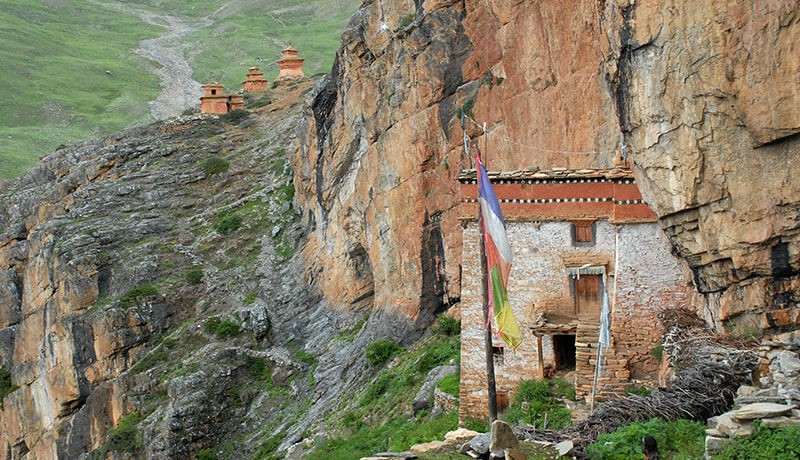
- Traverse the remote and rugged terrain of Dolpo.
- Visit Shey Gompa, a revered Buddhist monastery.
- Experience the mystical beauty of Phoksundo Lake.
- Encounter the traditional lifestyle of the Dolpo-pa people.
- Cross high passes over 5,000 meters with breathtaking views.
Upper Dolpo Circuit Trek is an expedition into one of Nepal’s most remote and less-explored regions, offering unparalleled natural beauty and cultural richness. Starting from Juphal, the trek leads to the pristine Phoksundo Lake, known for its turquoise waters and surrounding cliffs. Trekkers will pass through ancient monasteries, yak caravans, and villages where the Bon and Buddhist religions are practiced. The challenging terrain includes high passes such as Numa La and Baga La, which provide stunning views of the Dhaulagiri massif and other peaks. This trek is ideal for those seeking solitude and a deep connection with the natural and cultural heritage of Nepal.
Manaslu Circuit Trek (12 Days)
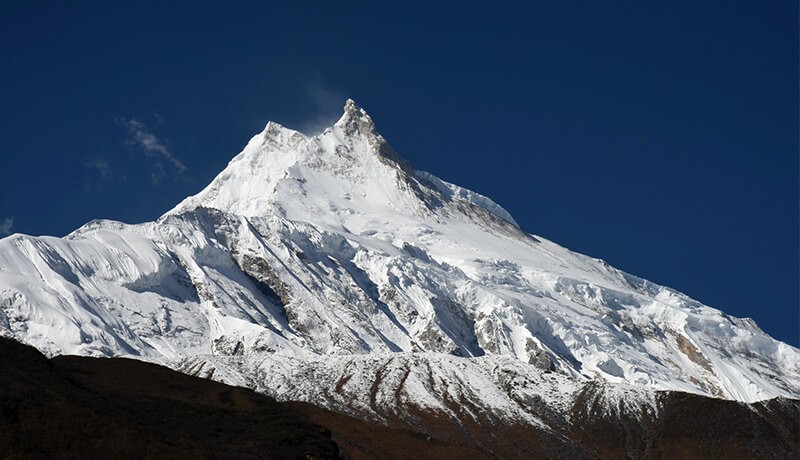
- Circumnavigate Mount Manaslu, the eighth highest peak in the world.
- Experience the rich cultural diversity of the Gurung and Tibetan communities.
- Cross the challenging Larkya La Pass at 5,160 meters.
- Witness dramatic landscapes from lush valleys to alpine meadows.
- Explore ancient monasteries and Mani walls.
Manaslu Circuit Trek is a classic adventure that takes trekkers around the majestic Mount Manaslu. Starting from Soti Khola, the trek winds through lush forests, terraced fields, and traditional Gurung villages. As the trail ascends, the landscape transforms into a more rugged and alpine environment. The crossing of the Larkya La Pass is a thrilling highlight, offering panoramic views of Himlung Himal, Cheo Himal, and the Annapurna range. The descent into the Marshyangdi Valley brings trekkers to the Annapurna Conservation Area, completing a circuit that is both physically demanding and spiritually enriching.
Annapurna Circuit Trek (10 Days)
.png)
- Diverse landscapes from subtropical forests to high-altitude deserts.
- Cross the iconic Thorong La Pass at 5,416 meters.
- Visit the sacred Muktinath Temple.
- Enjoy panoramic views of Annapurna, Dhaulagiri, and Machapuchare.
- Experience the cultural diversity of the Thakali and Gurung people.
Annapurna Circuit Trek is renowned for its breathtaking scenery and cultural variety. Beginning in the lush green valleys, the trek passes through rhododendron forests, terraced farmlands, and remote villages. As trekkers ascend, the landscape becomes more arid and rugged, culminating in the challenging Thorong La Pass, which provides a sense of accomplishment and stunning mountain vistas. Descending into the Kali Gandaki Valley, trekkers can visit the sacred pilgrimage site of Muktinath before continuing through the diverse terrain of Mustang and into the more temperate regions of the Annapurna Conservation Area. The circuit ends in the beautiful Pokhara Valley, providing a complete trekking experience.
Everest Base Camp Trek (12 Days)
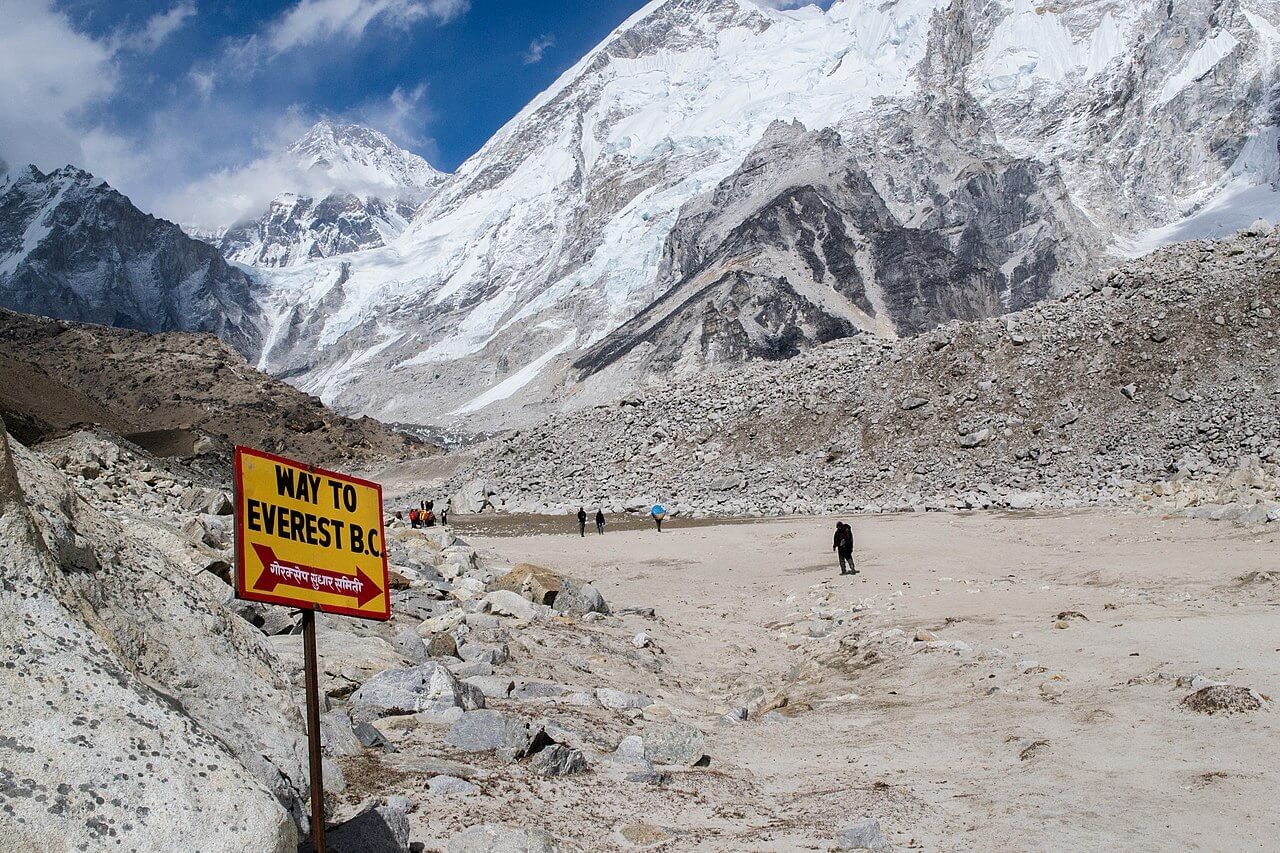
- Reach the base of the world’s highest peak, Mount Everest.
- Experience Sherpa culture and hospitality in villages like Namche Bazaar and Tengboche.
- Visit the iconic Tengboche Monastery.
- Enjoy stunning views of Everest, Lhotse, Nuptse, and Ama Dablam.
- Trek through the Sagarmatha National Park, a UNESCO World Heritage Site.
Everest Base Camp Trek is a bucket-list adventure for trekkers worldwide. Starting from the bustling town of Lukla, the trail winds through the heart of the Khumbu region. Trekkers will pass through vibrant Sherpa villages, lush forests, and high-altitude landscapes, all while experiencing the unique culture of the Sherpa people. The ascent to Namche Bazaar, the gateway to Everest, offers the first glimpses of the towering peaks. Continuing through the valley, trekkers visit the serene Tengboche Monastery before making the final push to Everest Base Camp. The trek culminates with a climb to Kala Patthar for a sunrise view of Everest, providing an unforgettable climax to this iconic journey.
Mardi Himal Trek (7 Days)
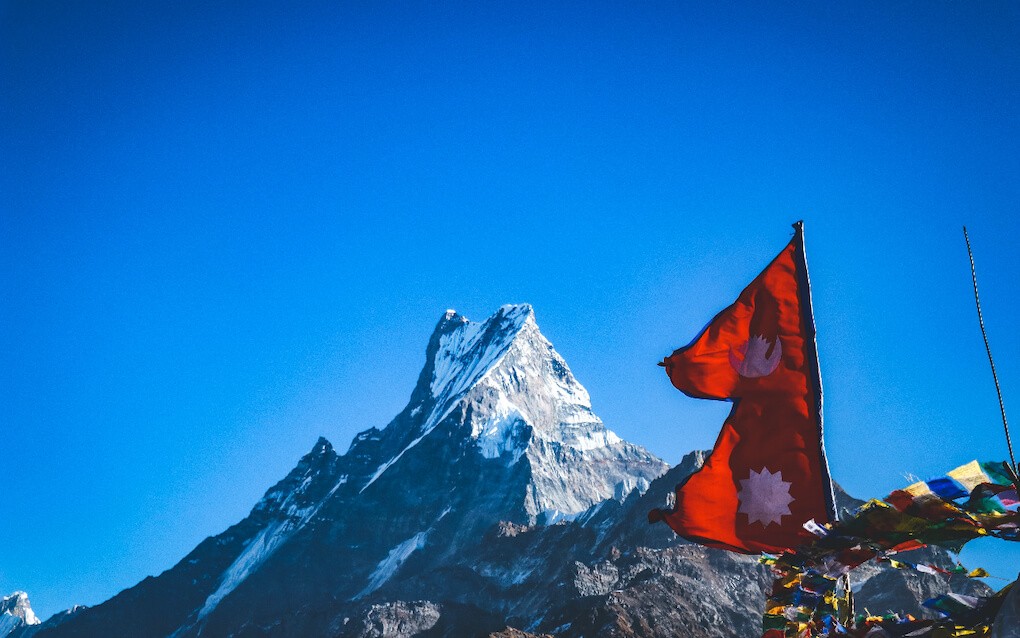
- Trek to the base of Mardi Himal, a hidden gem in the Annapurna region.
- Experience stunning views of Annapurna South, Hiunchuli, and Machapuchare.
- Traverse rhododendron forests and alpine meadows.
- Stay in quaint teahouses and encounter warm local hospitality.
- Enjoy the serenity of less crowded trails.
Mardi Himal Trek is a relatively new and less-trodden route in the Annapurna region, offering a tranquil escape into nature. The trek starts from Kande or Dhampus and leads through lush forests filled with rhododendrons, offering occasional glimpses of the surrounding peaks. As the trail ascends, it opens up to expansive views of Annapurna South and Machapuchare. Trekkers stay in simple yet cozy teahouses along the way, enjoying the hospitality of the local Gurung and Magar communities. The final ascent to Mardi Himal Base Camp rewards trekkers with panoramic views of the Himalayas, making it a perfect trek for those seeking solitude and stunning scenery.
Pikey Peak Trek (5 Days)
.jpeg)
- Panoramic views of Everest, Makalu, Kanchenjunga, and Annapurna.
- Experience the unique culture and traditions of the Sherpa people.
- Visit ancient monasteries and stupas.
- Enjoy beautiful rhododendron forests and alpine landscapes.
- Witness one of the best sunrise views in Nepal from Pikey Peak.
Pikey Peak Trek is a relatively short and less-crowded trek that offers some of the best panoramic views of the Himalayan range, including Mount Everest. Starting from Dhap or Jiri, the trail passes through beautiful rhododendron forests, traditional Sherpa villages, and lush valleys. The highlight is the climb to Pikey Peak, which offers an unparalleled sunrise view over the Himalayas. The trek also provides opportunities to visit ancient monasteries, including the Thupten Chholing Monastery, and to experience the rich Sherpa culture and traditions. This trek is perfect for those looking for a relatively easy and culturally immersive trekking experience.
Langtang Valley Trek (7 Days)
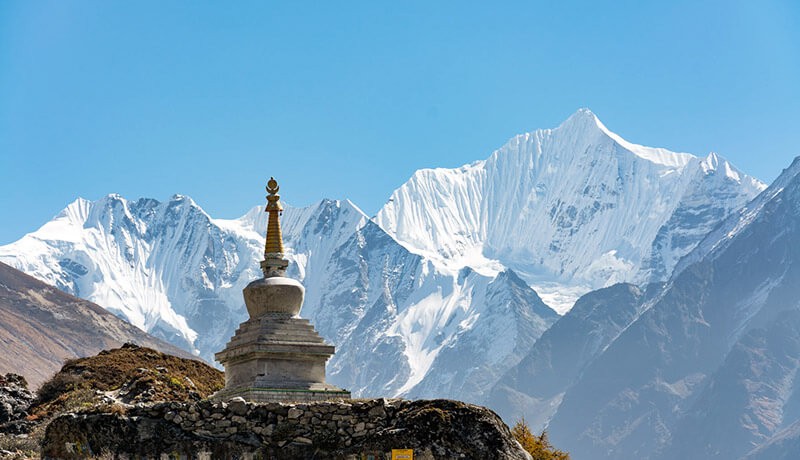
- Explore the picturesque Langtang Valley with its stunning landscapes.
- Visit Kyanjin Gompa and enjoy the views from Tserko Ri.
- Experience the unique culture of the Tamang and Tibetan communities.
- Walk through lush forests and past cascading waterfalls.
- Observe the recovery and resilience of the region post-earthquake.
Langtang Valley Trek is a beautiful journey into one of Nepal’s most picturesque regions, known for its breathtaking scenery and cultural richness. Starting from Syabrubesi, the trek follows the Langtang River through dense forests, terraced fields, and traditional Tamang villages. As the valley opens up, trekkers are greeted with stunning views of Langtang Lirung and other peaks. The highlight is reaching Kyanjin Gompa, a serene monastery surrounded by snow-capped mountains. Trekkers can also ascend Tserko Ri for a panoramic view of the Langtang range. This trek offers a perfect blend of natural beauty, cultural encounters, and a sense of adventure.
Tsum Valley Trek (15 Days)
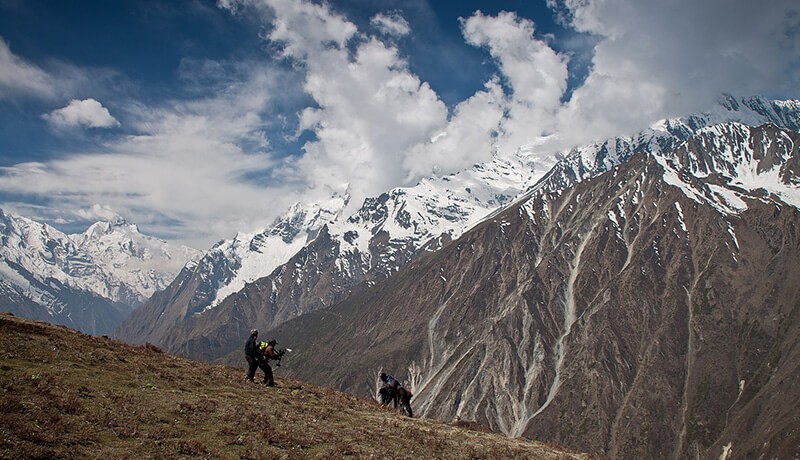
- Discover the hidden valley of Tsum with its rich cultural heritage.
- Visit ancient monasteries such as Mu Gompa and Rachen Gompa.
- Experience the unique lifestyle and traditions of the Tsumba people.
- Trek through pristine forests and picturesque villages.
- Witness stunning views of the Ganesh Himal and Shringi Himal.
Tsum Valley Trek takes trekkers into the mystical and culturally rich Tsum Valley, a hidden gem in the Manaslu region. Starting from Soti Khola, the trek follows the Budhi Gandaki River through beautiful forests and traditional Gurung villages. The trail diverges from the Manaslu Circuit and enters the secluded Tsum Valley, where ancient Buddhist monasteries and chortens dot the landscape. Trekkers will visit sacred sites like Mu Gompa and Rachen Gompa, learning about the unique traditions of the Tsumba people. The valley is surrounded by stunning peaks, including the Ganesh Himal, making it a trek of spiritual and natural significance.
Nar Phu Valley Trek (17 Days)

- Explore the remote and rugged Nar and Phu valleys.
- Experience the preserved Tibetan culture and traditions.
- Visit ancient monasteries and traditional stone houses.
- Trek through dramatic landscapes and high mountain passes.
- Witness stunning views of Annapurna, Kang Guru, and Pisang Peak.
Nar Phu Valley Trek offers an adventurous journey into the remote valleys of Nar and Phu, nestled in the Annapurna region. Starting from Koto, the trail ascends through dense forests, narrow canyons, and traditional villages. The trek provides a unique cultural experience, with visits to ancient monasteries, prayer flags, and stone houses that reflect the Tibetan heritage. The crossing of the Kang La Pass is a thrilling highlight, offering panoramic views of the Annapurna massif. The trek is both challenging and rewarding, taking trekkers off the beaten path into one of Nepal’s most preserved and culturally rich areas.
Shey Phoksundo Lake Trek (9 Days)
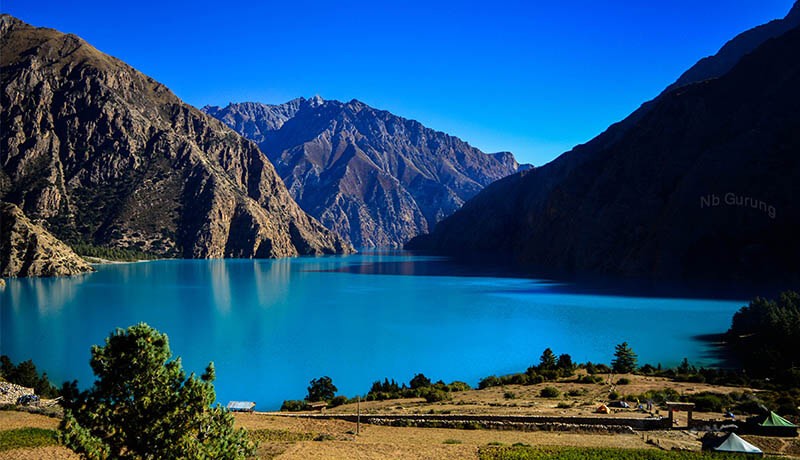
- Visit the stunning Shey Phoksundo Lake with its turquoise waters.
- Explore the remote and pristine landscapes of Dolpo.
- Experience the unique culture and traditions of the Dolpo-pa people.
- Trek through Shey Phoksundo National Park, rich in wildlife.
- Witness the breathtaking beauty of the Kanjiroba and Dhaulagiri ranges.
Shey Phoksundo Lake Trek is a journey into the heart of Dolpo, a region known for its untouched natural beauty and cultural heritage. The trek starts from Juphal and leads to the breathtaking Shey Phoksundo Lake, renowned for its crystal-clear turquoise waters surrounded by rugged cliffs. The trail passes through traditional Dolpo-pa villages, where the ancient Bon and Buddhist religions are practiced. Trekkers will experience the tranquility of Shey Phoksundo National Park, home to diverse wildlife such as blue sheep and snow leopards. This trek offers a perfect blend of stunning landscapes and cultural immersion.
Tilicho Lake Trek (15 Days)
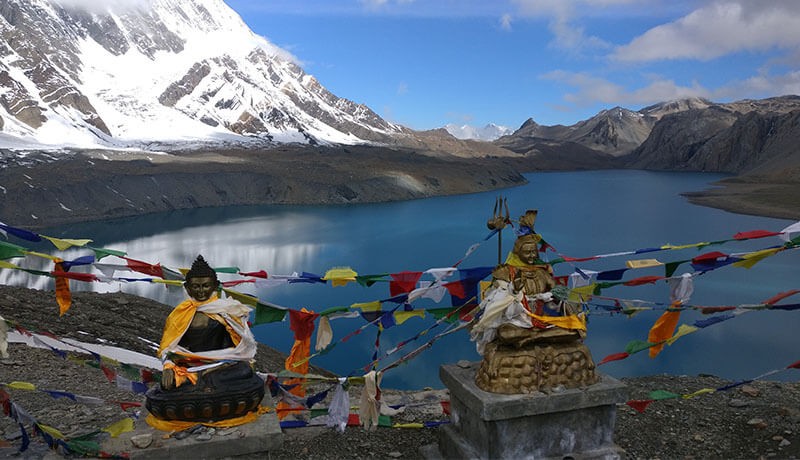
- Trek to Tilicho Lake, one of the highest lakes in the world.
- Witness stunning views of the Annapurna and Nilgiri ranges.
- Experience diverse landscapes from subtropical forests to alpine meadows.
- Cross the challenging Thorong La Pass.
- Explore the cultural diversity of the Manang and Mustang regions.
Tilicho Lake Trek is an adventurous journey to one of the highest lakes in the world, nestled in the Annapurna region. The trek starts from Chame and follows the Annapurna Circuit trail, passing through beautiful forests, terraced fields, and traditional villages. As the trail ascends, trekkers reach the serene Tilicho Lake, surrounded by towering peaks and glaciers. The journey continues with the crossing of the Thorong La Pass, offering breathtaking views of the Himalayas. This trek is a perfect combination of natural beauty, cultural encounters, and high-altitude adventure, making it a memorable experience.
Everest Gokyo Ri Trek (10 Days)
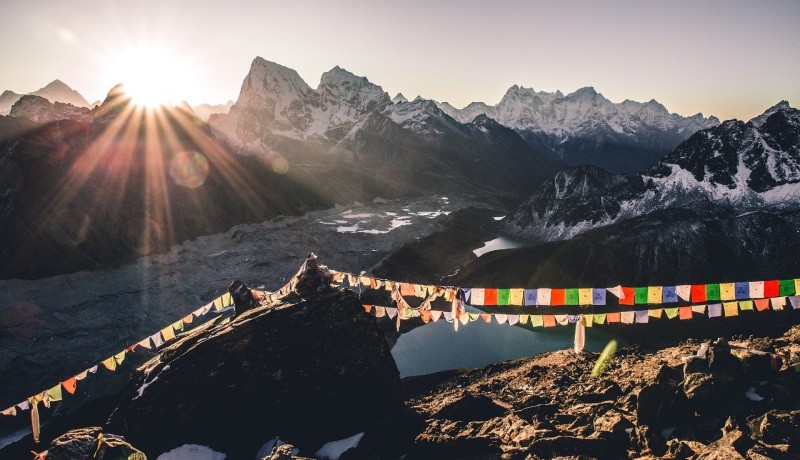
- Climb Gokyo Ri for stunning panoramic views of Everest, Lhotse, and Cho Oyu.
- Visit the beautiful Gokyo Lakes.
- Trek through the heart of the Sagarmatha National Park.
- Experience Sherpa culture in villages like Namche Bazaar and Dole.
- Witness the Ngozumpa Glacier, the largest glacier in Nepal.
Gokyo Ri Trek is a spectacular alternative to the traditional Everest Base Camp Trek, offering breathtaking views and serene landscapes. Starting from Lukla, the trek follows the Dudh Koshi River through lush forests and Sherpa villages. The trail ascends to the stunning Gokyo Lakes, a series of turquoise glacial lakes set against the backdrop of towering peaks. The highlight is the climb to Gokyo Ri, a viewpoint that offers panoramic vistas of Everest, Lhotse, Makalu, and Cho Oyu. Trekkers also get to experience the unique culture and hospitality of the Sherpa people, making this trek a truly rewarding adventure.
Ghorepani Poon Hill Trek (6 Days)
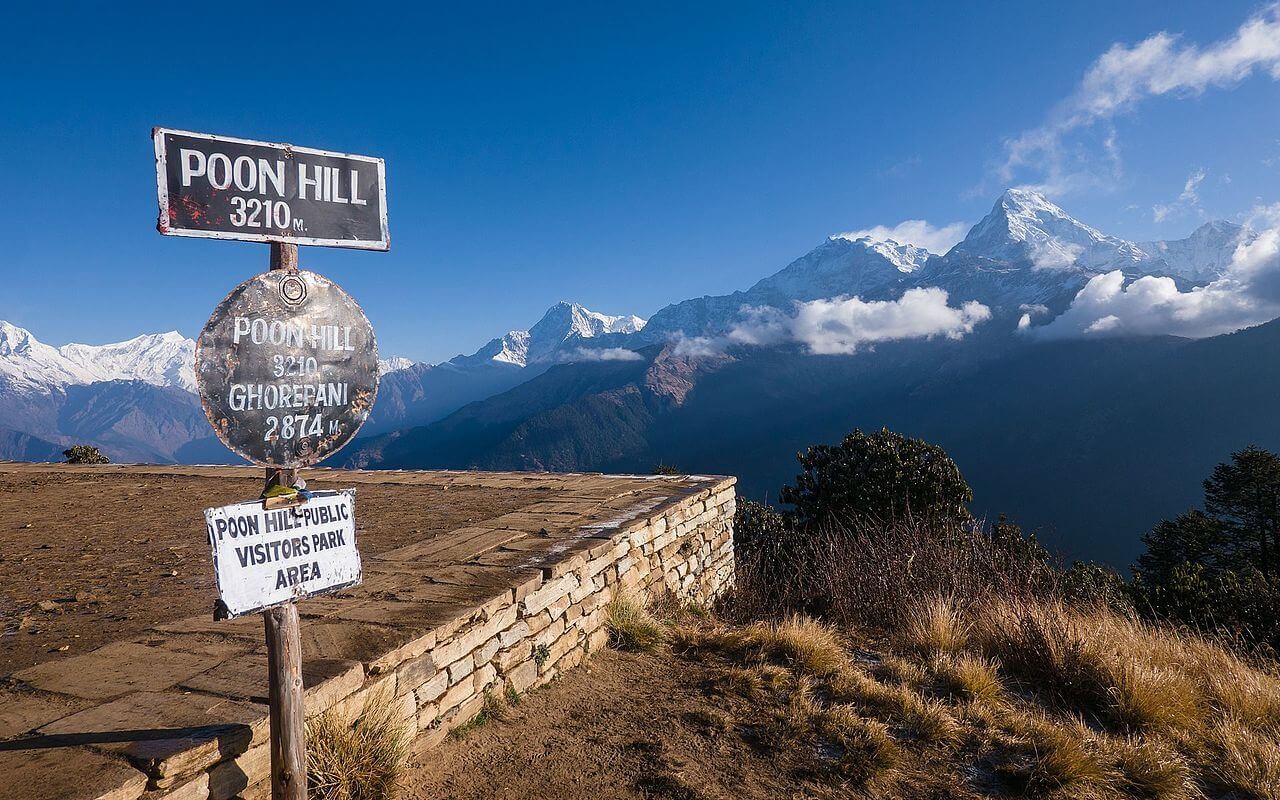
- Witness the spectacular sunrise view from Poon Hill.
- Trek through beautiful rhododendron forests and terraced fields.
- Experience the rich culture of the Gurung and Magar communities.
- Stay in charming teahouses and encounter warm local hospitality.
Ghorepani Poon Hill Trek is one of the most popular short treks in Nepal, offering stunning mountain views and cultural encounters. Starting from Nayapul, the trail ascends through lush forests filled with rhododendrons, leading to the picturesque village of Ghorepani. The highlight of the trek is the early morning hike to Poon Hill, where trekkers are rewarded with a breathtaking sunrise view over the Annapurna and Dhaulagiri ranges. The trek continues through traditional villages, where trekkers can experience the rich culture and hospitality of the Gurung and Magar people. This trek is perfect for those looking for a relatively easy and rewarding trekking experience.
Gosaikunda Helambu Trek (8 Days)
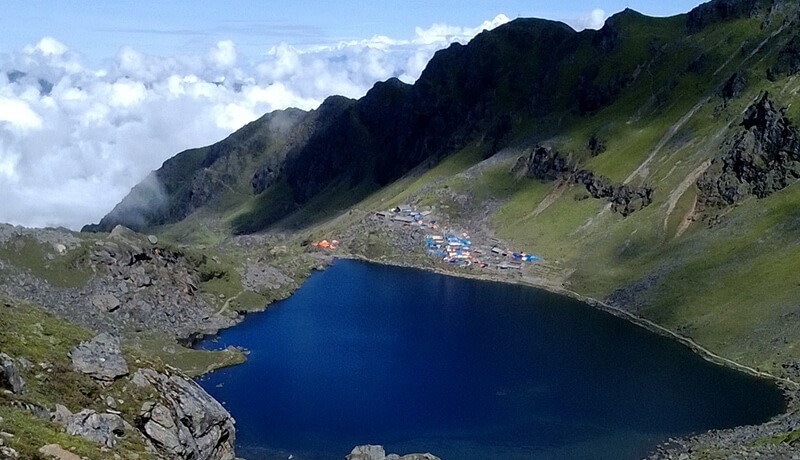
- Visit the sacred Gosaikunda Lake, a revered pilgrimage site.
- Trek through the lush forests of Langtang National Park.
- Experience the unique culture of the Tamang and Sherpa communities.
- Enjoy stunning views of the Langtang and Ganesh Himal ranges.
- Explore the beautiful Helambu region with its terraced fields and traditional villages.
Gosaikunda Helambu Trek is a diverse and culturally rich trek that takes trekkers to the sacred Gosaikunda Lake and through the picturesque Helambu region. Starting from Dhunche, the trail ascends through dense forests and alpine meadows to reach Gosaikunda, a lake revered by both Hindus and Buddhists. The journey continues through the scenic Helambu region, known for its terraced fields, traditional villages, and beautiful monasteries. Trekkers will experience the unique culture and hospitality of the Tamang and Sherpa people, making this trek a perfect blend of natural beauty and cultural immersion.
Khopra Danda Trek (11 Days)
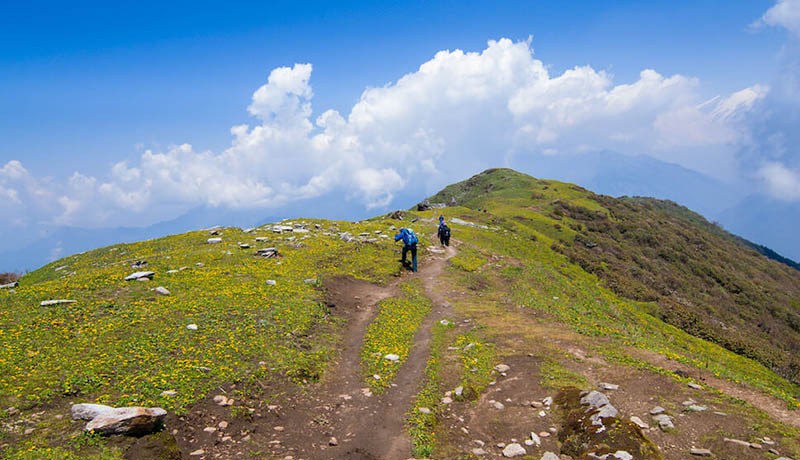
- Enjoy panoramic views of Annapurna, Dhaulagiri, and Nilgiri.
- Visit the serene Khayar Lake.
- Stay in community-run teahouses and support local initiatives.
Khopra Danda Trek is a relatively new and less-crowded trek in the Annapurna region, offering stunning mountain views and cultural encounters. Starting from Ghandruk or Tatopani, the trail ascends through lush forests filled with rhododendrons, leading to the picturesque ridge of Khopra Danda. The highlight of the trek is the panoramic view from Khopra Ridge, offering a stunning vista of the Annapurna and Dhaulagiri ranges. Trekkers can also visit the serene Khayar Lake, a beautiful alpine lake surrounded by towering peaks. This trek is perfect for those looking for a relatively easy and rewarding trekking experience while supporting local community initiatives.
Ponker Lake Trek (10 Days)
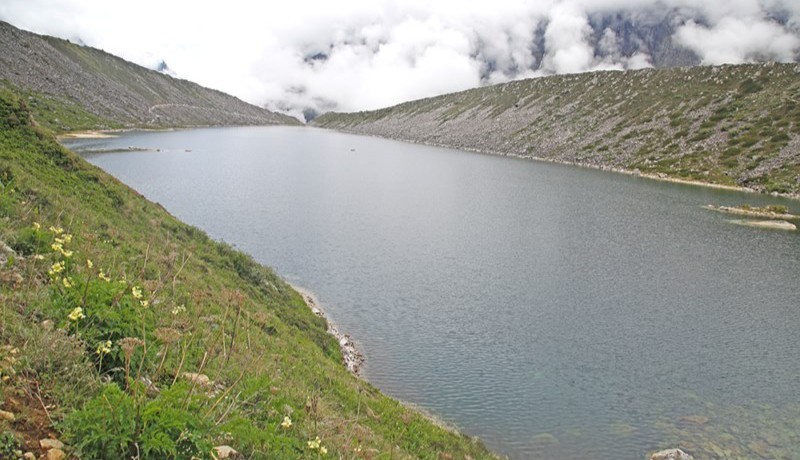
- Discover the hidden gem of Ponker Lake in the Dolpo region.
- Trek through pristine forests and rugged landscapes.
- Witness stunning views of the Dhaulagiri and Kanjiroba ranges.
Ponker Lake Trek takes trekkers into the remote and pristine Dolpo region, known for its untouched natural beauty and cultural heritage. Starting from Juphal, the trek follows the trail to the hidden gem of Ponker Lake, a beautiful alpine lake surrounded by rugged cliffs and snow-capped peaks. The journey passes through traditional Dolpo-pa villages, where the ancient Bon and Buddhist religions are practiced. Trekkers will experience the tranquility of the Dolpo region, home to diverse wildlife and stunning landscapes. This trek offers a perfect blend of natural beauty and cultural immersion.
Ruby Valley Trek (10 Days)
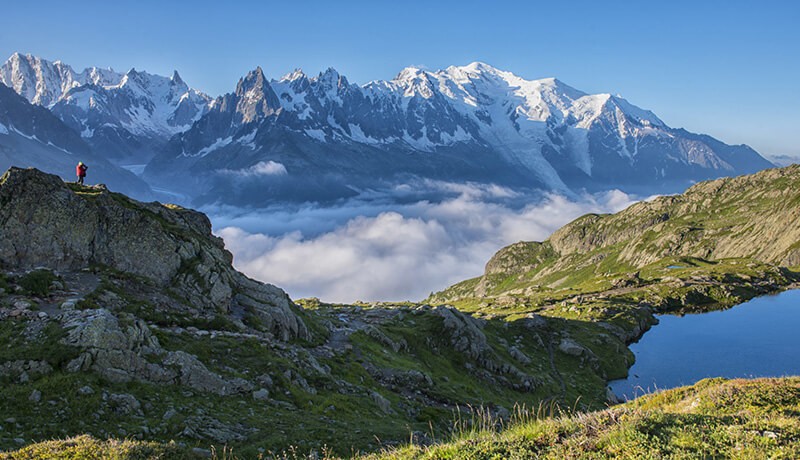
- Explore the scenic Ruby Valley with its lush forests and terraced fields.
- Experience the unique culture and traditions of the Tamang and Gurung communities.
- Enjoy stunning views of Ganesh Himal, Langtang, and Manaslu.
- Trek through picturesque villages and interact with friendly locals.
- Discover the rich biodiversity of the region.
Ruby Valley Trek is a hidden gem in the Ganesh Himal region, offering stunning scenery and cultural encounters. Starting from Syabrubesi or Dhading, the trek follows the trail through lush forests, terraced fields, and traditional Tamang and Gurung villages. The Ruby Valley is known for its rich biodiversity, with an abundance of flora and fauna. Trekkers will enjoy stunning views of Ganesh Himal, Langtang, and Manaslu, making it a perfect trek for nature lovers. The journey also provides opportunities to interact with friendly locals and experience their unique culture and traditions.
Rolwaling Valley Trek (9 Days)
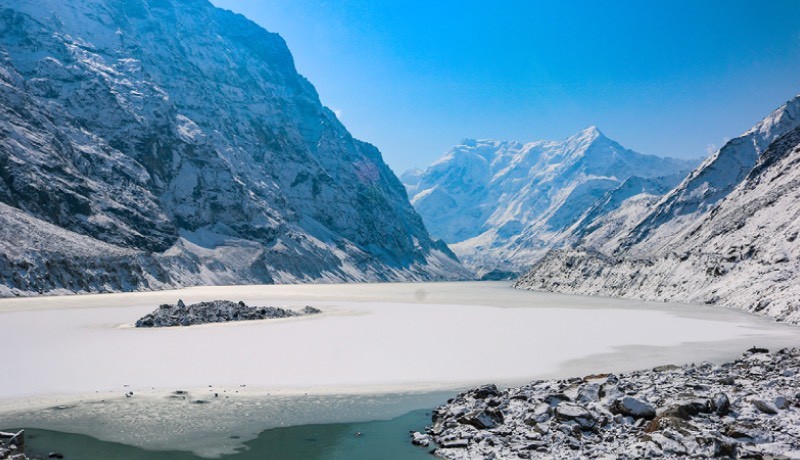
- Trek through the remote and rugged Rolwaling Valley.
- Experience the unique culture and traditions of the Sherpa and Tamang communities.
- Cross the challenging Tashi Lapcha Pass.
- Enjoy stunning views of Gaurishankar, Melungtse, and other peaks.
- Visit the picturesque Tsho Rolpa Lake.
Rolwaling Valley Trek is an adventurous journey into one of Nepal’s most remote and less-explored regions. Starting from Dolakha or Barhabise, the trail follows the Rolwaling River through dense forests, traditional Sherpa and Tamang villages, and rugged landscapes. The trek offers stunning views of Gaurishankar, Melungtse, and other peaks. The highlight is the crossing of the challenging Tashi Lapcha Pass, which provides a thrilling experience and panoramic views of the Himalayas. The trek also includes a visit to the picturesque Tsho Rolpa Lake, a beautiful alpine lake surrounded by towering peaks.
Humla Limi Valley Trek (18 Days)
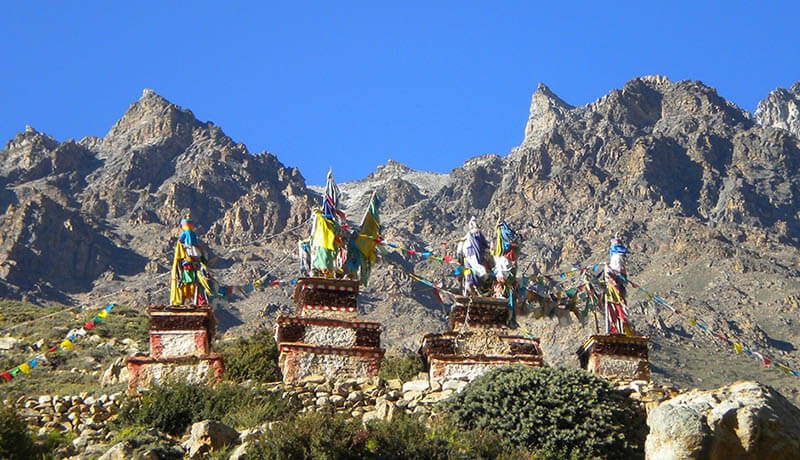
- Explore the remote and pristine Limi Valley in the Humla region.
- Experience the unique culture and traditions of the Limi-pa people.
- Trek through beautiful forests, alpine meadows, and rugged landscapes.
- Witness stunning views of the Saipal and Nalakankar ranges.
Humla Limi Valley Trek is a journey into one of Nepal’s most remote and less-explored regions, offering unparalleled natural beauty and cultural richness. Starting from Simikot, the trail follows the Karnali River through beautiful forests, alpine meadows, and traditional Limi-pa villages. The trek provides a unique cultural experience, with visits to ancient monasteries, prayer flags, and stone houses that reflect the Tibetan heritage. Trekkers will experience the tranquility of the Limi Valley, home to diverse wildlife and stunning landscapes. This trek offers a perfect blend of natural beauty and cultural immersion, making it a truly rewarding adventure.
Trekking Preparations for Monsoon Season in Nepal
Physical fitness requirements.
Prepare with regular cardio, strength training, and endurance exercises. Focus on building stamina and leg strength to handle long, steep ascents and descents.
Necessary Gear and Equipment For Monsoon Trekking in Nepal
- Waterproof clothing and backpack covers
- Lightweight, quick-dry clothing
- Sturdy, waterproof trekking boots
- Trekking poles for stability
- Insect repellent and leech socks
- High-quality rain jacket and pants
Permits and Fees
Ensure you have the required permits, such as TIMS (Trekkers' Information Management System) card and conservation area permits. Some regions, like Upper Mustang, require special permits.
Plan Your Route According to the Weather
Research the weather patterns and plan your trek to avoid the heaviest rains. Be flexible with your schedule and have alternative routes in mind.
Hire a Guide or Porter
Consider hiring a guide or porter for safety and convenience. They can help navigate tricky trails and manage the added challenges of monsoon trekking.
Accommodations and Food
Book accommodations in advance when possible. Expect simpler amenities and bring some high-energy snacks to supplement local meals.
Tips for Safe and Enjoyable Trekking in Monsoon Season in Nepal
Start early to avoid heavy rainfall.
Begin your trek early in the morning to avoid the afternoon downpours. This also provides ample daylight for trekking.
Hygiene and Health Tips
Maintain good hygiene to prevent illnesses. Purify drinking water, and carry hand sanitizer and personal hygiene products.
Be Prepared for Leeches
Wear long sleeves and leech socks. Carry salt or anti-leech sprays to deal with leeches effectively.
Cultural Norms and Customs
Respect local customs and traditions. Dress modestly and be mindful of cultural sensitivities.
Add Extra Days to Your Schedule
Factor in extra days for potential delays due to weather or health issues. This flexibility can help reduce stress and ensure a more enjoyable trek.
Take Extra Precautions Against Water-borne Diseases
Drink only purified or bottled water. Avoid raw foods and stick to freshly cooked meals.
Tips for Choosing the Right Trek in Monsoon
Choosing the right monsoon trek in Nepal depends on various factors, including your trekking experience, fitness level, and personal preferences. Consider the trek's difficulty, duration, and the region's weather conditions. Research the cultural and natural highlights of each trek to match your interests. Timing is crucial, as some treks are more accessible and enjoyable during specific monsoon months. Consulting with local guides and trekking agencies can provide valuable insights and help you make an informed decision.
Benefits of Monsoon Trekking
Monsoon trekking in Nepal offers several benefits. The trails are less crowded, providing a peaceful and intimate trekking experience. The lush green landscapes, full rivers, and blooming flora create a visually stunning environment. The monsoon season also coincides with various cultural festivals, offering a unique opportunity to experience local traditions and festivities. The vibrant atmosphere and the warmth of the local communities add to the overall trekking experience.
Challenges of Monsoon Trekking
Monsoon trekking comes with its set of challenges, including unpredictable weather, slippery trails, and potential landslides. Health and safety considerations, such as staying hydrated, maintaining good nutrition, and being aware of altitude sickness, are crucial. It's essential to be flexible with your schedule and prepared for changes in the itinerary due to weather conditions. Proper preparation, including carrying the right gear and following local advice, can help mitigate these challenges and ensure a safe and enjoyable trek.
Cultural Insights During Monsoon
The monsoon season in Nepal is rich in cultural activities and festivals. Trekkers can witness and participate in local traditions, agricultural practices, and religious ceremonies. Festivals like Teej, Janai Purnima, and Gai Jatra provide a deep insight into Nepali culture and community life. Interaction with local communities during the monsoon offers a unique opportunity to understand their way of life, hospitality, and resilience.
Monsoon Wildlife Encounters
Monsoon trekking in Nepal offers rich wildlife encounters. The national parks and conservation areas are teeming with diverse flora and fauna. Common wildlife sightings include red pandas, Himalayan black bears, and various bird species. The lush vegetation and full rivers create ideal habitats for wildlife, enhancing the trekking experience. Trekkers should follow conservation guidelines and respect the natural environment to ensure these encounters are safe and sustainable.
Monsoon Photography Tips
Monsoon trekking provides unique photography opportunities with vibrant landscapes, misty mountains, and cultural scenes. Capturing the essence of the monsoon requires the right gear, including waterproof cameras and lenses. Photographers should take advantage of the soft, diffused light created by the clouds and rain. Expert tips include focusing on details like raindrops, reflections, and local activities to create compelling images. Staying patient and flexible with your shooting schedule can also lead to remarkable shots.
Health and Safety During Monsoon
Health and safety are paramount during monsoon treks. Common health issues include dehydration, digestive problems, and altitude sickness. Preventative measures include staying hydrated, following a balanced diet, and acclimatizing properly. Carrying a well-equipped first aid kit and knowing emergency protocols are essential. Trekkers should also be aware of the risks posed by weather conditions, including landslides and flooding, and follow local advice and guidelines.
Sustainable Trekking Practices
Practicing sustainable trekking is crucial to preserving Nepal's natural and cultural heritage. Eco-friendly travel tips include minimizing waste, using biodegradable products, and respecting local customs and traditions. Supporting local communities by choosing homestays, buying local products, and hiring local guides contributes to sustainable tourism. Conservation efforts, such as staying on designated trails and not disturbing wildlife, ensure that the trekking regions remain pristine for future generations.
Frequently Asked Questions (FAQs)
Which are the best months to trek in the monsoon season.
The best months to trek in the monsoon season are June and early September when the rains are lighter.
What are the Most Popular Monsoon Treks in Nepal?
Popular monsoon treks include Nar Phu Valley, Upper Mustang, Everest Base Camp, and Annapurna Circuit.
What are the Physical Fitness Requirements for a Monsoon Trek in Nepal?
Trekkers should be in good physical condition, with regular exercise focusing on cardio, strength, and endurance.
What Gear and Equipment Do I Need for a Monsoon Trek in Nepal?
Essential gear includes waterproof clothing, sturdy trekking boots, trekking poles, insect repellent, and quick-dry clothing.
Can I Trek Alone in Monsoon Season or Do I Need a Guide?
While solo trekking is possible, hiring a guide or porter is recommended for safety and convenience during the monsoon.
What are the Safety Precautions to Take During a Monsoon Trek in Nepal?
Safety precautions include starting early, preparing for leeches, purifying water, and having flexible plans.
What are Some Cultural Norms and Customs to be Aware of During a Monsoon Trek in Nepal?
Respect local customs, dress modestly, and be mindful of cultural sensitivities.
Monsoon trekking in Nepal offers a unique and enriching experience, blending natural beauty, cultural richness, and adventure. Despite the challenges posed by the weather, the rewards of lush landscapes, vibrant communities, and fewer crowds make it a worthwhile endeavor. With proper preparation, flexible planning, and a spirit of adventure, monsoon treks can provide unforgettable memories and a deep connection with Nepal's diverse and dynamic environment. Embrace the charm of the monsoon and embark on a trekking journey that reveals the hidden gems of Nepal.
Trekking in Nepal during the monsoon season offers a unique and serene experience with lush landscapes and fewer crowds. Proper preparation, respect for local customs, and taking necessary precautions can ensure a safe and enjoyable adventure. Whether it's the remote valleys of Upper Dolpo or the iconic trails of Everest Base Camp, Nepal's monsoon treks promise unforgettable memories.
He is a Travel Enthusiast and Writer, who mostly covers the guide to outdoor adventure in the Himalayas of Nepal. He can be your friendly trip planner. Feel free to reach out to him.
Contact Now!
Send an Enquiry
Recent post.
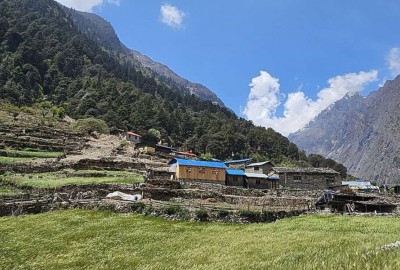
- June 21, 2024
Top 10 Less Crowded Treks in Nepal
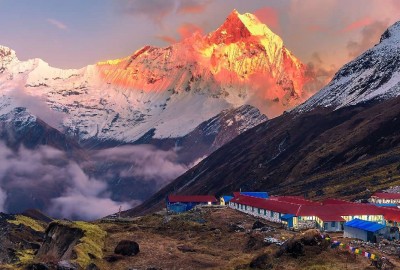
- June 16, 2024
Top 20 Summer Treks in Nepal
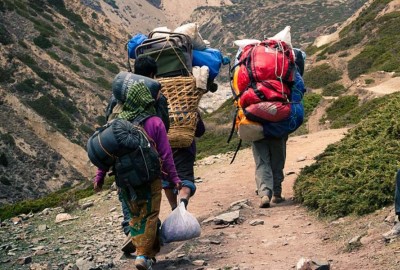
- June 07, 2024
Tipping Your Guides in Nepal
- Annapurna Guide
- Bhutan Guide
- City Tour Guide
- Educational Guide
- Everest Guide
- Festival Guide
- Flight Guide
- Gears Checklist
- Kathmandu Guide
- Langtang Guide
- Manaslu Guide
- Mountain Biking Guide
- Nepal Guide
- Off The Beaten Path Guide
- Peak Climbing Guide
Mount Mania Treks & Expedition P. Ltd.
Share this:
You may also like.
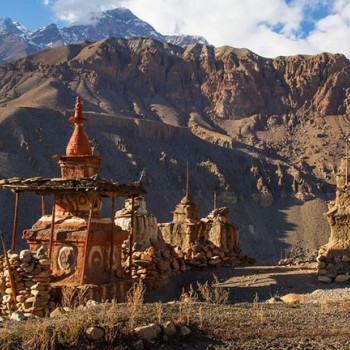
23 Days Upper Dolpo Circuit Trek
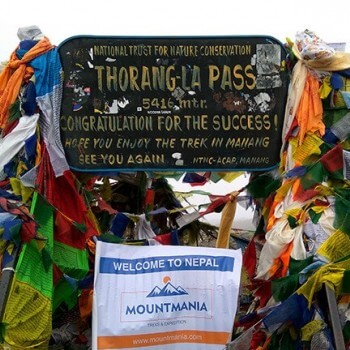
14 Days Annapurna Circuit Trek
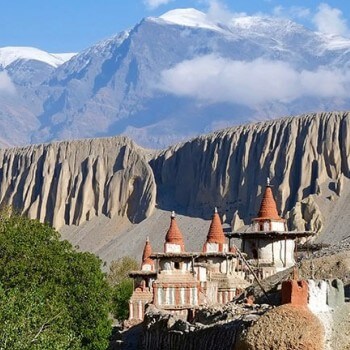
15 Days Upper Mustang Trek
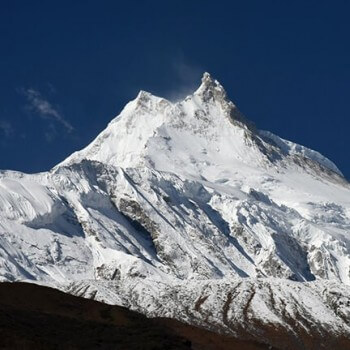
12 Days Manaslu Circuit Trek
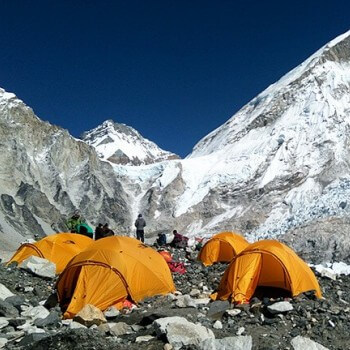
12 Days Everest Base Camp Trek
Registered with: company registration office, government of nepal, licensed by: nepal tourism board & department of tourism, proud member of trekking agency's association of nepal, general member of nepal mountaineering association.
Accomodation
Culture & tradition.
- Responsible Tourism
- Community Homestay
- community-based tourism
- community homestay network
- water harvesting solutions
- sustainability
- cultural preservation
- E-magazines
The best of Inside Himalayas delivered straight to your inbox. Sign up for the latest stories.
Please leave this field empty.
Get the latest edition of Inside Himalayas on your doorstep.
Select Country Afghanistan Albania Algeria Andorra Angola Antigua and Barbuda Argentina Armenia Australia Austria Azerbaijan Bahamas Bahrain Bangladesh Barbados Belarus Belgium Belize Benin Bhutan Bolivia Bosnia and Herzegovina Botswana Brazil Brunei Bulgaria Burkina Faso Burundi Cabo Verde Cambodia Cameroon Canada Central African Republic (CAR) Chad Chile China Colombia Comoros Congo, Democratic Republic of the Congo, Republic of the Costa Rica Cote d'Ivoire Croatia Cuba Cyprus Czechia Denmark Djibouti Dominica Dominican Republic Ecuador Egypt El Salvador Equatorial Guinea Eritrea Estonia Eswatini (formerly Swaziland) Ethiopia Fiji Finland France Gabon Gambia Georgia Germany Ghana Greece Grenada Guatemala Guinea Guinea-Bissau Guyana Haiti Honduras Hungary Iceland India Indonesia Iran Iraq Ireland Israel Italy Jamaica Japan Jordan Kazakhstan Kenya Kiribati Kosovo Kuwait Kyrgyzstan Laos Latvia Lebanon Lesotho Liberia Libya Liechtenstein Lithuania Luxembourg Madagascar Malawi Malaysia Maldives Mali Malta Marshall Islands Mauritania Mauritius Mexico Micronesia Moldova Monaco Mongolia Montenegro Morocco Mozambique Myanmar (formerly Burma) Namibia Nauru Nepal Netherlands New Zealand Nicaragua Niger Nigeria North Korea North Macedonia (formerly Macedonia) Norway Oman Pakistan Palau Palestine Panama Papua New Guinea Paraguay Peru Philippines Poland Portugal Qatar Romania Russia Rwanda Saint Kitts and Nevis Saint Lucia Saint Vincent and the Grenadines Samoa San Marino Sao Tome and Principe Saudi Arabia Senegal Serbia Seychelles Sierra Leone Singapore Slovakia Slovenia Solomon Islands Somalia South Africa South Korea South Sudan Spain Sri Lanka Sudan Suriname Sweden Switzerland Syria Taiwan Tajikistan Tanzania Thailand Timor-Leste Togo Tonga Trinidad and Tobago Tunisia Turkey Turkmenistan Tuvalu Uganda Ukraine United Arab Emirates (UAE) United Kingdom (UK) United States of America (USA) Uruguay Uzbekistan Vanuatu Vatican City (Holy See) Venezuela Vietnam Yemen Zambia Zimbabwe
- 06 August, 2017
What to See and Do During the Monsoon in Kathmandu
Monsoon season in Nepal has officially started. If you’re taking advantage of the off-season to travel in the country without many other tourists around, you may end up finding yourself in Kathmandu on a rainy day. If you don’t want to get wet and muddy outside, then here are some fun rainy-day activities for you to enjoy in the city.
Go climbing at Astrek Climbing Wall
Astrek is a climbing gym located in Thamel. It’s outdoors, but with protection from rain. There are two tall walls for climbing with ropes, as well as some shorter walls designed for bouldering . There are plenty of routes suitable for beginners, as well as some very challenging routes for more advanced climbers.
You can rent climbing shoes and harnesses at the gym, and there are very good staff who will make sure you have a good climbing experience. Just because it’s raining doesn’t mean you can’t enjoy some good rock climbing!
Sit in a café and read a book
There are plenty of good cafés and coffee shops all over Thamel and Patan where you can relax for a few hours. Order some tea or coffee, have some lunch, and finally read that book that you’ve been meaning to open for the past three months. Or bring your laptop with you, enjoy the free WiFi that many cafés offer, and finally sort through your travel photos and catch up with your friends. Many have Nepal-related books for sale, too.
Here are some suggestions of great coffee shops:
- Kar.Ma Coffee: Gyan Mandal, Jhamsikhel, Lalitpur
- Himalayan Arabica Beans: Saat Ghumti Marg, Thamel
- Himalayan Java Coffee: Locations throughout the valley, including two branches in Thamel, one at the Kathmandu Durbar Square and one at Boudhanath
- Café Swotha: Patan
- Tings Tea Lounge: Lazimpat
- Café Soma: Jhamsikhel, Lalitpur

Patan Museum. Photo: Frances Ellen/Flickr
Visit a museum
There are a few museums in the Kathmandu Valley that could entertain you for a couple of hours on a rainy day. They house important pieces of art, historical relics, weapons, coins, and a number of other archeological finds. A visit to these museums will give you a better understanding of the history and culture of Nepal.
Patan Museum (located at Patan Durbar Square)
Housed in an old royal palace, this museum features many statues and pieces of traditional Buddhist and Hindu artwork, with very informative descriptions. A visit to this museum is a great addition to a walk around the UNESCO World Heritage site of Patan Durbar Square. There’s also a great courtyard restaurant and gift shop, with lots of books.
Narayanhiti Palace Museum (located at the northern end of Durbar Marg)
This museum is located in the last palace of the Nepali royal family. The building and rooms tell the story of Nepal’s political turmoil over the past few decades, and it was where the royal massacre took place in 2001.
National Museum of Nepal (located near Swayambhunath)
Nepal’s largest museum houses historical artwork and features collections of historical weapons and coins. A visit to this museum will give a good overview of the history and culture of Nepal.
Play futsal or squash
If you want to be a bit active, there are many futsal arenas and a few squash courts spread around Kathmandu and Lalitpur. These generally charge at an hourly rate and sometimes need to be booked in advance over phone. It will be hard to make a booking on a weekend, but during the week the arenas and courts will be more open.
Go see a movie
There are a number of movie theaters around Kathmandu and Lalitpur where you can enjoy Nepali and Hindi movies, as well as more popular Hollywood movies as well. The main cinema chain in Kathmandu is QFX Cinemas . The theaters are pretty comfortable, with good quality audio-visual set-ups.
Top image: Michael Foley/Flickr
Tags: Kathmandu sightseeing monsoon Things to do in Kathmandu
Leave a reply
Your email address will not be published. Required fields are marked *
- submit comment
ISSUE 8 | 2024
Related articles.
- 06 September, 2024
Indra Jatra: Celebrating the God of Heaven, The Living Goddess, and the Fierce Deity of Kathmandu
- 30 August, 2024
Developing Responsible Tourism Through Water Harvesting Solutions in Dhankuta
- 16 August, 2024
From Orange Groves to Pine Forests: Journey to Dhankuta
- 09 August, 2024
Guest is God – The Soul of Himalayan Hospitality
- 31 July, 2024
The Origins and Legends of the Naga Serpents and Nag Panchami
- 28 July, 2024
Buddhist Monasteries in Pokhara: Life, Art and Community
- 17 July, 2024
Where to find Bön Culture in the Nepali Himalayas
- 02 July, 2024
What to Read When Coming to Nepal: Literary Treasures
- 15 June, 2024
Community Tourism: Building New Destinations and Enhancing Travel Experiences in Nepal
- 05 June, 2024
Into the World of Succulents With Sharad Bhimsaria
Treks Booking
Trekking Blog Website
Monsoon Season in Nepal
Monsoon season in Nepal brings the heavy rainfall, strong lightening, storms at nights. The monsoon season falls in between mid-June to mid of the September .
During the monsoon, the rain almost falls everyday with occasional thunderstorms in the evening. Monsoon is the best time for green vegetation and cultivation of paddy in Nepal.
The monsoon in Nepal originates from the Bay of Bengal India and moves along the southern part of the country. Nepal receives an average of 107 days of rainfall during the summer monsoon.
Transportation during Monsoon in Nepal
Trekking in Nepal in Himalayas undergoes either via overland or Flight. Some of the trekking routes have been connected with the roads to cities which are black-topped. But most of the mountain roads are graveled and might be blocked due to flood and landslides.
During the heavy rain, there will be chances of landslides and flood. So, you must go to rain-shadow areas for trekking in Nepal during monsoon time.
For the updated information about transportation means, please keep in touch with Treks Booking . We will let you with the latest updates of roads and flights.
Monsoon Festivals and Events
Things to do in nepal during monsoon, trekking to rain shadow areas.
Trekking in Nepal during monsoon is not highly recommended by the trekking agencies but there are some areas which receive less rainfall as compared to other regions of Nepal.
Upper Mustang, Upper Manang, Nar and Phu Valleys, Dolpo Region are the areas best for trekking during monsoon season. These places lie in trans-Himalayan region and rain-shadow areas.
You will be experiencing unique culture and nature, beautiful landscapes and the pristine Himalayas trekking to these areas. Upper Mustang Trek, Nar Phu Valley Trek, Upper Dolpo Trek, Annapurna Circuit Trek, Humla Limi Valley Trek are the best treks during monsoon season in Nepal.
Explore culture and heritage around Kathmandu Valley
If you are non-trekkers and love culture, Kathmandu is the best place for you to explore. The unique culture, arts and architecture, festivals and UNESCO World Heritage Sites are the best of part of Kathmandu sightseeing tour.
Hiking or Biking
Not interested for trekking long days? or love mount biking in Himalayas, Nepal offers the best places for you enjoy culture and nature.
Nagarkot, Dhulikhel, Namobuddha, Kakani, Phulchoki, Daman, Dhampus, Sarangkot, Bandipur and Tansen Palpa are the best places for hiking in Nepal.
If you love Mountain biking, you can bike to Upper Mustang, Annapurna Circuit and around Kathmandu Valley.
Experience the adventure (Bungee Jumping, Paragliding, Rafting and Jungle Safari)
Besides trekking and mountaineering, Nepal offers some other interesting adventure holidays that you really feel awesome.
Paragliding in Pokhara and Kathmandu, Bungee Jumping in Kathmandu and Pokhara, Zip Flying, Canoeing and Jungle safari in Chitwan National Park, Bardia National Park and Koshi Tappu Wildlife reserve are the best activities for you to experience during Monsoon Season.
The Nature, Culture and Mountains
In monsoon season, every day is not raining. Rains are generally seen in the afternoon while in the morning and day time receive less rain or no rain. If you are lucky, you will encounter the most beautiful nature and mountain views after rainfall stops. Don’t forget to capture the moment on your camera as the part of lifetime experience.
The green nature with the lush vegetation, blooming flowers and unique organic agricultural cultivation are the best part of your visit to Nepal during monsoon season.
You will be exploring unique festival and cultural activities in Kathmandu and Pokhara during the monsoon months as Naag Panchami, Janai Purnima, Bhote Jatra, Teej, Gai Jatra and Krishna Asthami are few of them.
Rice Paddy Planting (Asar 15 Event)
Asar 15, popular known as asar pandra in Nepali is the day of busiest day for the farmers all over the Nepal. The day activities people engage by planting rice paddy, eating a special dish – dahi chiura, singing asar bhaka, dancing and playing with mud and water.
In Nepal, Asar 15 is a biggest agricultural festival of planting rice paddy in the fields and celebrated by eating beaten rice and curd.
The ropain festival is celebrated all over the Nepal. In Kathmandu valley, Kirtipur, Chapagaon, bungmati, Pharping, Sanogaon, Lele, Bhaktapur and Harisiddhi are the places to visit to see rice planing festival.
Farmers will be busy on their fields for planting the rice paddy. People who want to enjoy mud and water will have the opportunity to play holi of mud and water, throwing each other.
Asar Pandhara is the popular date on Nepali calendar on the third month and marks the beginning of the great monsoon in Nepal. The day is popular for paddy planting. Nepal government has declared this day as National Paddy Day.
Bird Watching and Jungle Exploration
If you are nature lover, you can visit the National Parks, wildlife reserve of Nepal for bird watching, wild animal activities and nature walk in Kathmandu, bardia, chitwan national park and koshi tappu wildlife reserve.
Kailash Mansarovar Yatra
If you are planning for Kailash Mansarovar yatra, this is the right time for Kailash parikrama tour. You can join a group for Nepaljung – Hilsa – Kailash helicopter tour or you can go Kathmandu Lhasa Kailash. Kailash Mansarovar yatra by overland (Jeep, Bus) will be operated in 2020 by Treks Booking.
Yoga and Meditation
If you like spiritual tourism and interested on yoga tour in Nepal, its opportunity in monsoon. There are many yoga and meditation retreat centers around Kathmandu and Pokhara which provides you the services. You will learn to live a healthier life and getting touch with your inner. Get a yoga tour package and experience the peace of mind.
Places to Visit During Monsoon in Nepal
Kathmandu, Nagarkot, Dhulkhel, Ilam, Pokhara, Bandipur, Chitwan National Park, Bardia National Park, Lumbini, Tansen, Kakani, Upper Mustang, Humla Limi Valley, Siraichaur are some places to visit in Monsoon.
You may also like...
Museums and galleries of nepal, entertainment and sports in nepal, nepali people and their lifestyle, leave a reply cancel reply.
You must be logged in to post a comment.
Solo female travel anywhere and everywhere.
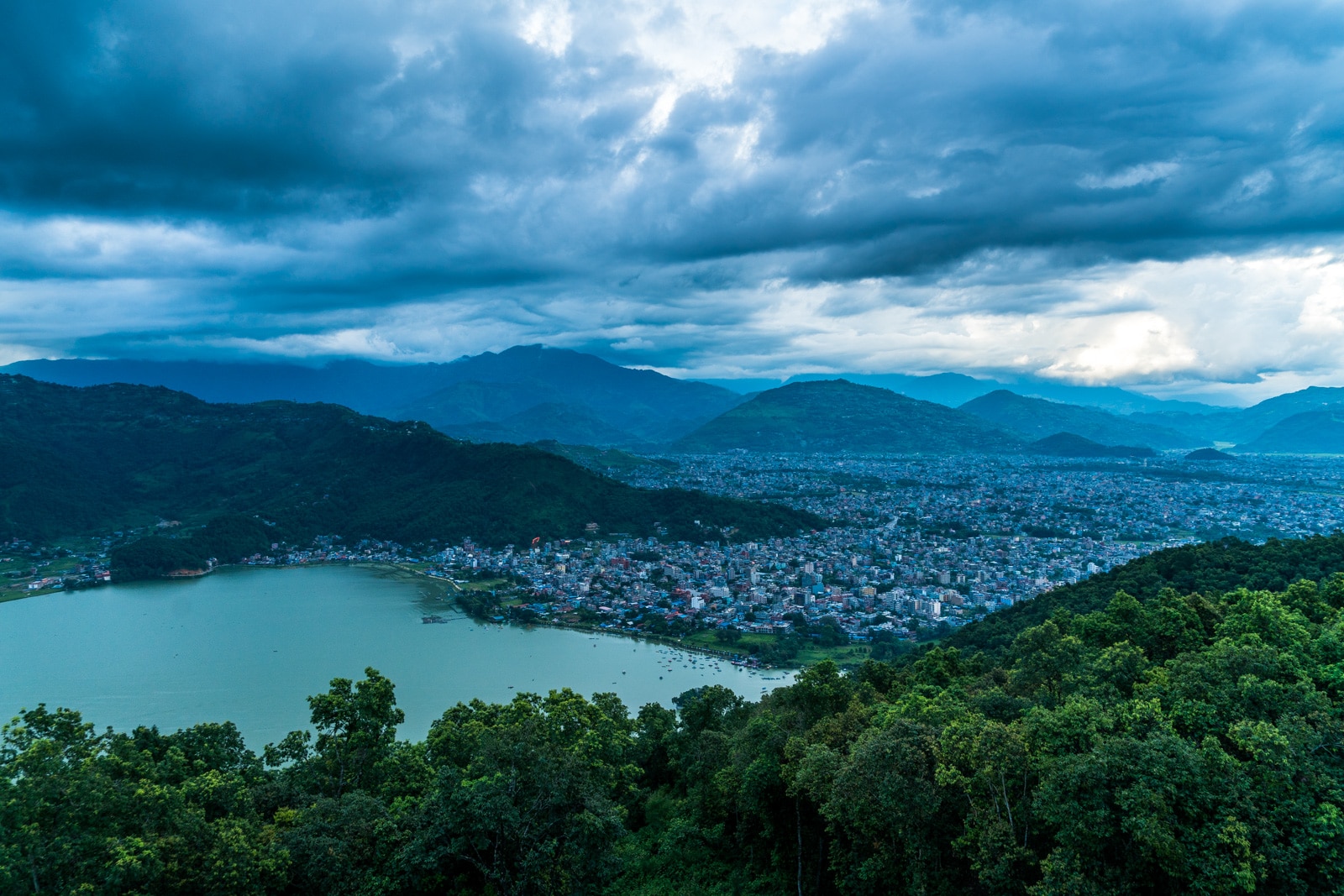
Monsoon in Nepal: visa quests, failed plans, and coffee addictions
What the heck we were doing in Nepal?! Plus what it was like to travel in Nepal during monsoon.
Our initial plans for Nepal sounded pretty badass: we would enter through the eastern tea hills, putter about in the Kathmandu valley as we sorted out visas, strap on our packs and hike over 5,000 meter plus passes, then our way through remote and offbeat Western Nepal to cross into Northern India.
What we actually did: drink a metric shit ton of coffee, twiddle our thumbs, and bond with working wifi (my love, I needed you) .
So we went to Nepal… why?
Our venture into Nepal was ill-fated from the start: July is full-on monsoon season in the country, and the month with the highest levels of precipitation.
Heavy rains are the obvious downside, but more practical problems are the regular landslides and the clouds bringing the rain; in monsoon, the Himalayas are completely obscured by clouds most of the time! Nothing says “Nepal adventure” like not seeing any mountains, eh eh?
Check out this monsoon packing list for all the gear you need when traveling in Nepal during the monsoon!
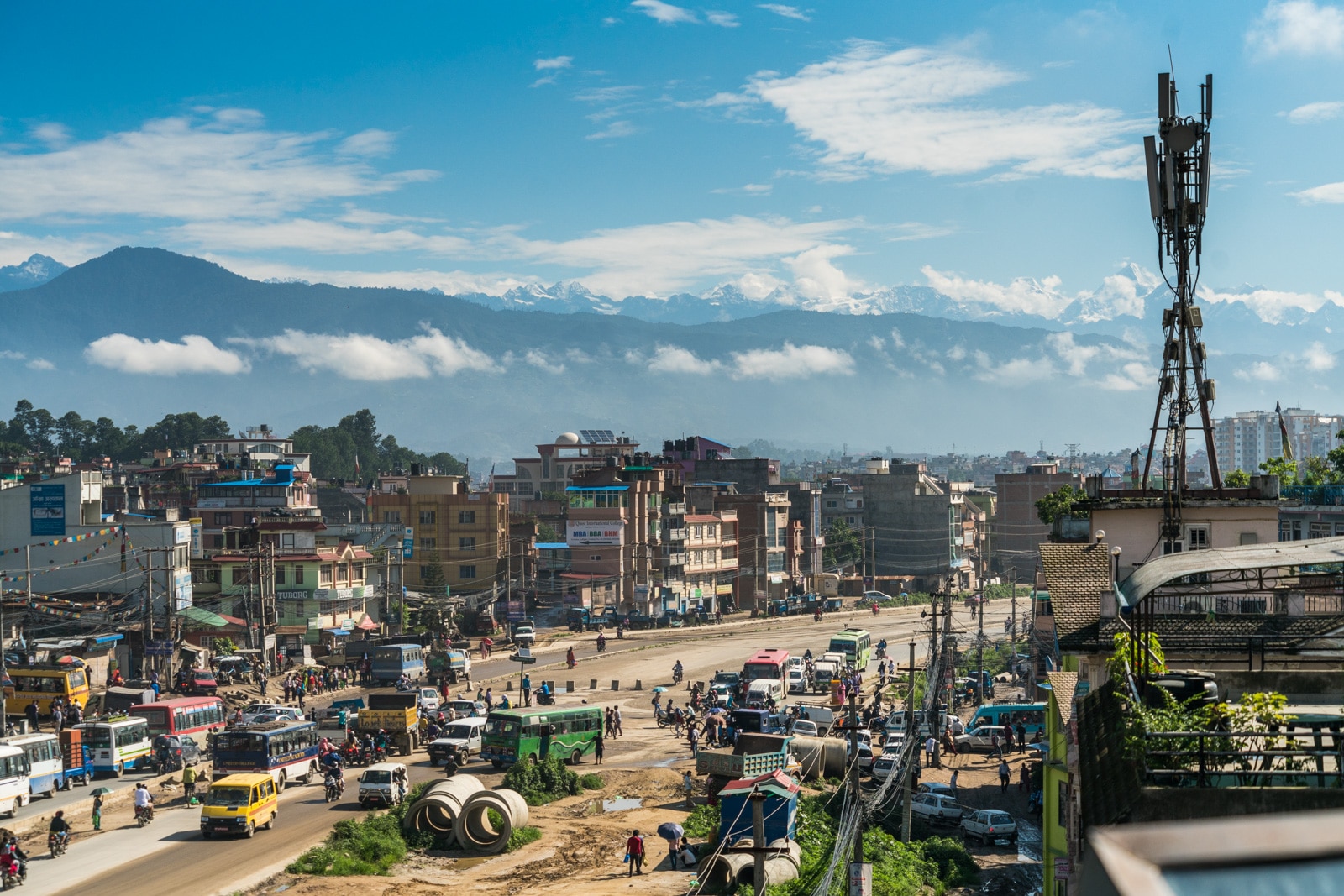
Never fear, we did see some of them… for an hour or two in total. Score! (I think?)
So why did we visit Nepal at such a wretched time? Aside from being distracted by the awesome that is Northeast India and spending longer there than intended, we came with an ulterior motive: to apply for new Pakistan visas . We needed to send our passports all the way back to the Netherlands to do so, and that was only possible from Nepal, not India (where it’s illegal to send passports in or out of the country).
If you follow us on our Facebook or Instagram , you’ll know our visa quest did not go as expected. We thought it would take several days… and it turned out to take several weeks , thanks to Dutch customs seizing our passports for a time. Fun!
Since we had to be on call while waiting for our precious passports to return, that meant no getting lost in the mountains of Nepal. It was a bummer (especially since we’d already paid for trekking permits ), but such is the unexpected nature of traveling. Besides, there are far worse places to be stuck than cushy tourist hotspots filled with comfort food and kickass coffee.

The tip of the Nepali iceberg
Since trekking was off the table, we put our noses to the grindstone more days than not, focusing on the blog and freelance work. Once our minds turned to mush, we turned to the streets, casually wandering but not actively exploring.
We don’t have any crazy stories or truly offbeat tips for you from Nepal, but that’s okay. Nepal is a popular country; it’s been written about by thousands of people a million times over, and there’s no lack of information available about it on the internet—a change from most of the other destinations we’ve visited in recent months!
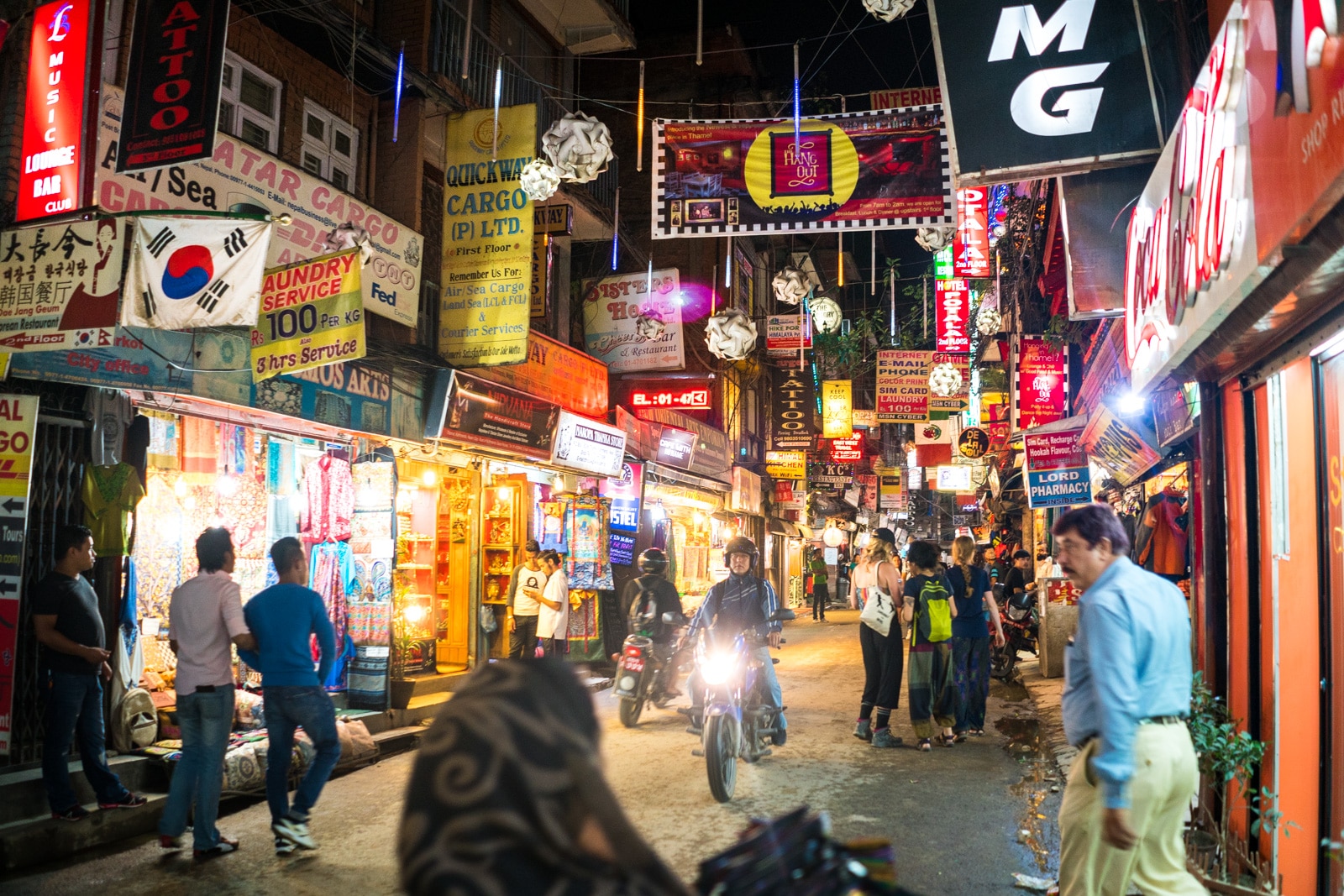
The congested tourist neighborhood of Thamel in Kathmandu. And this is during the off season!
There’s nothing we can say that hasn’t been better said by someone else, so we’ll refrain from dishing out advice aside from one point: do come, Nepal is recovering from the earthquake, the country is safe, and the people need your tourism!
If you’re looking for tips on Nepal, we recommend the Lonely Planet Nepal guide . Its coverage of trekking routes is extensive, and it was updated after the 2015 earthquake.
Of course, it would be a shame not to share anything from our month there… and we know other people are curious as to how it is to travel during monsoon in Nepal. We sure were! Instead of trying to explain in words, why don’t we let our photos do the talking?
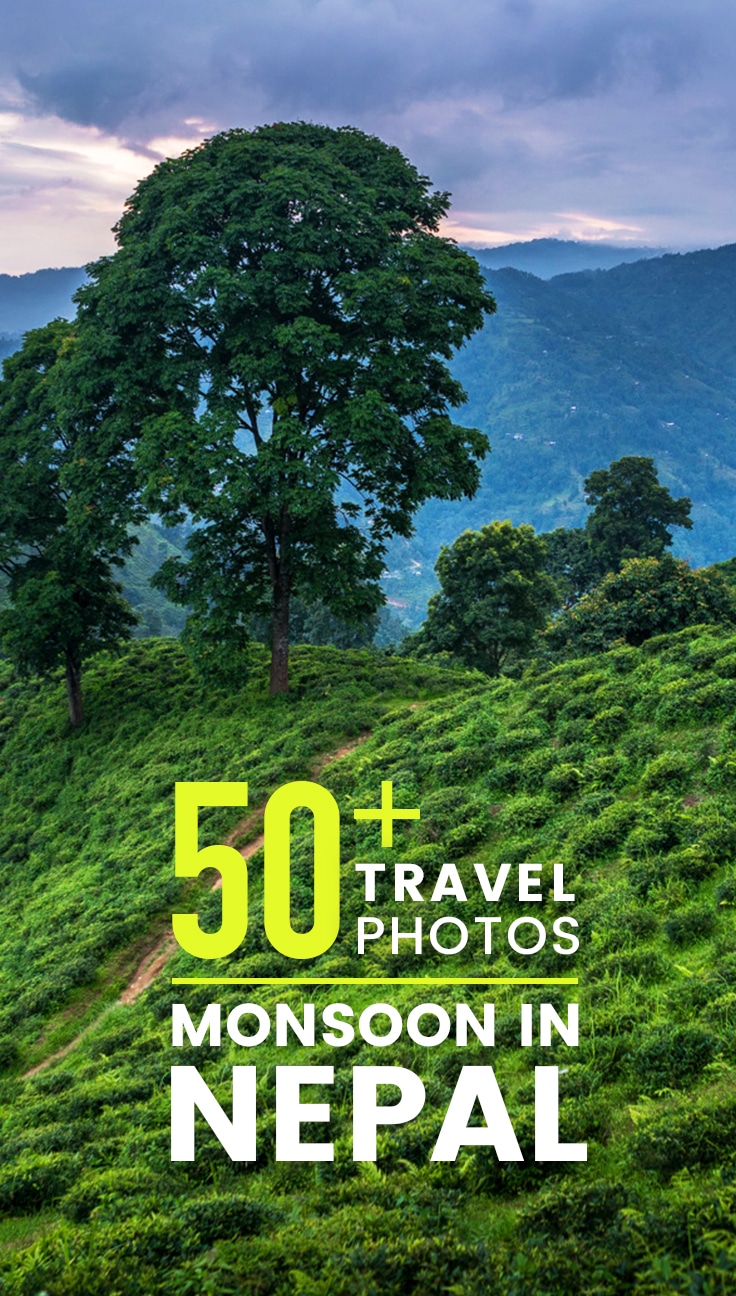
50+ photos of travel in Nepal during monsoon
The tea hills of ilam.
After crossing overland from India into Nepal , we headed up into the tea hills of Ilam. We can’t speak as to how busy it is during high season, but we were told it’s rarely visited by tourists compared to other destinations in Nepal. There’s your off the beaten track tip!
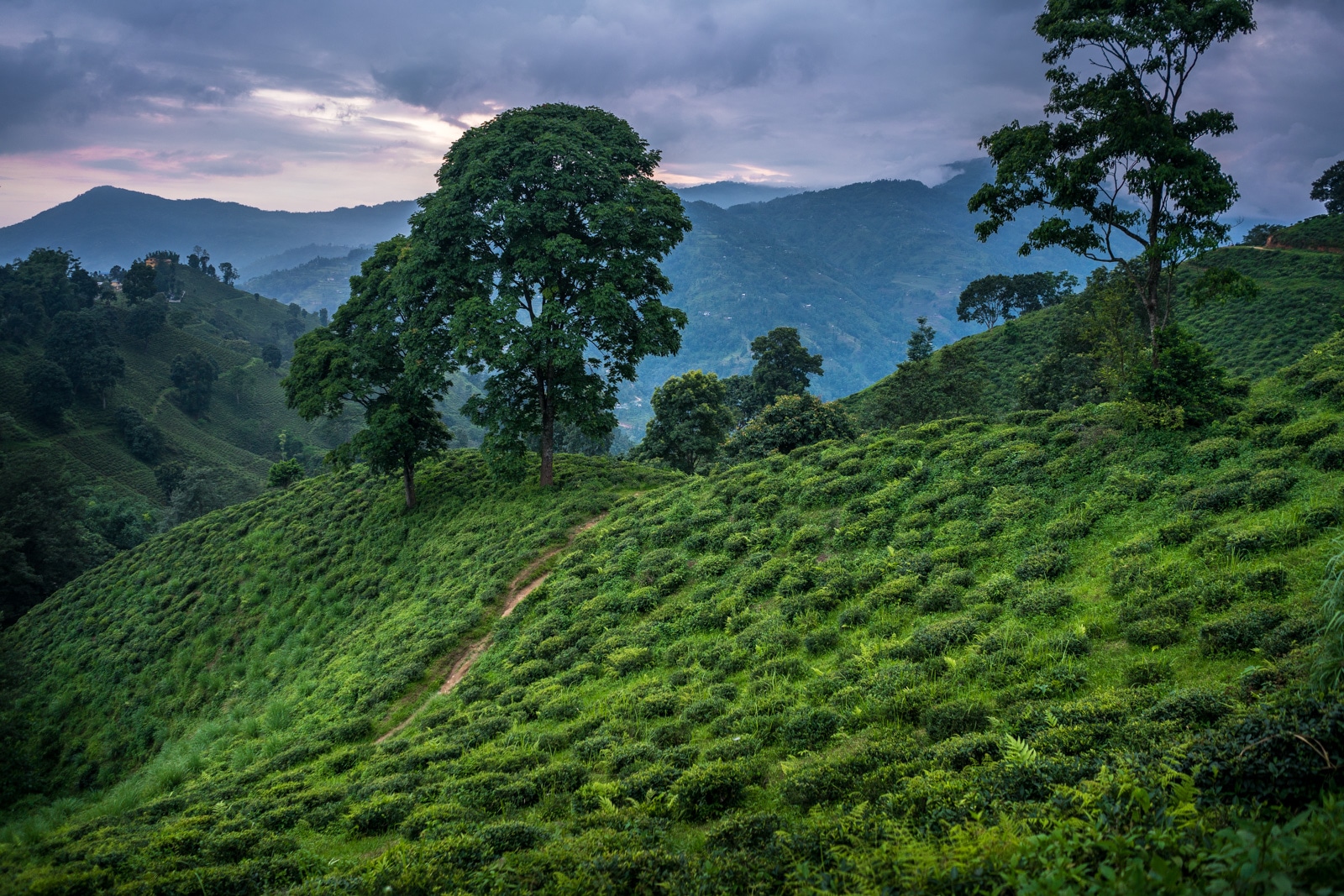
The hills surrounding Ilam are covered with tea! It’s exceptionally easy to escape the town and find a bit of peace and quiet in the greenery around, thanks to a million and one footpaths criss crossing the tea fields.
Why visit Ilam? Aside from the convenience of being close to the Indian border, tea from Ilam is widely regarded as the best tea produced in Nepal. We’re no tea aficionados (#coffee4life) but there was no denying the allure of tea fragrances in the air, and all the tea we had was excellent.
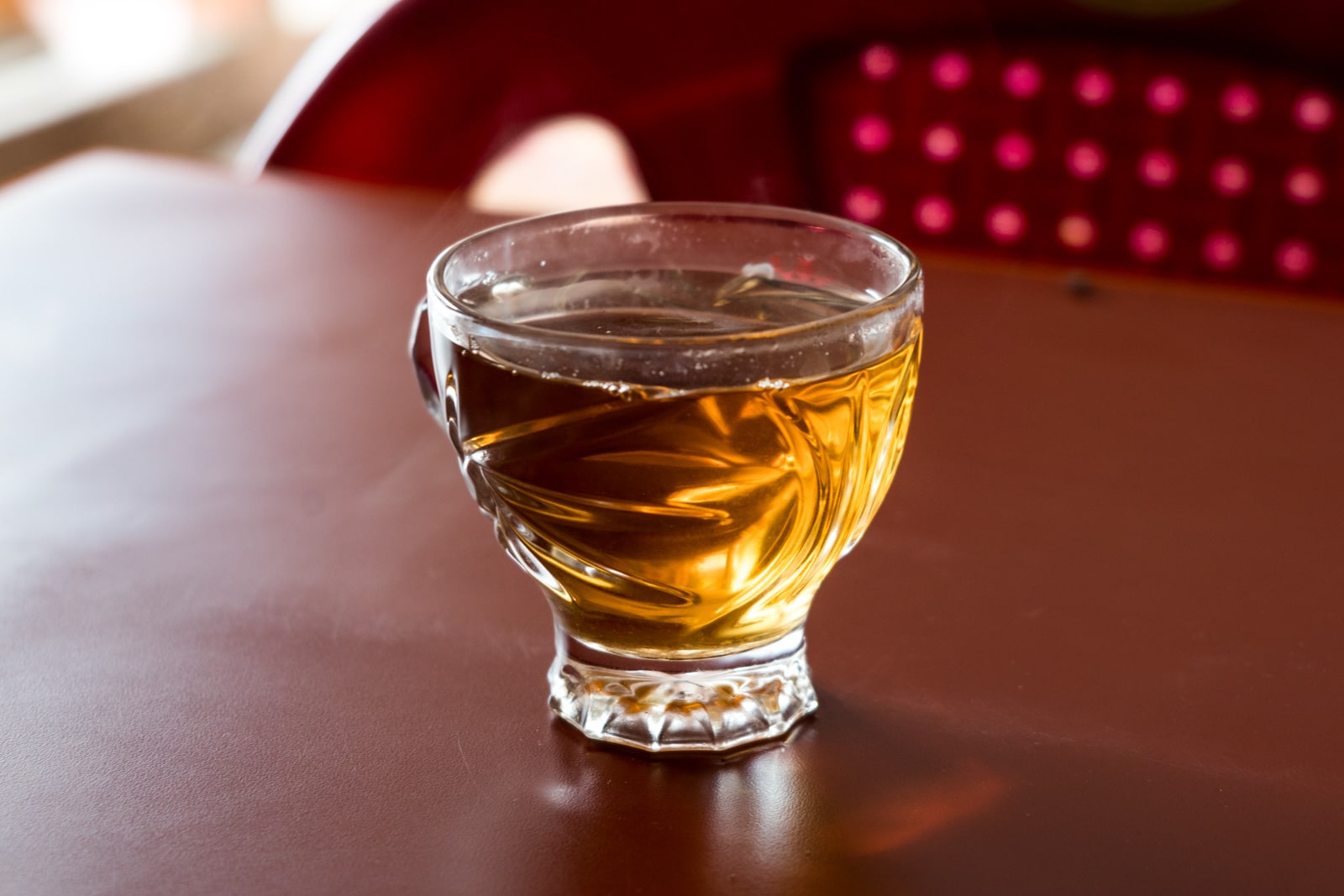
Unfortunately, most days the mountains were covered in clouds, and we were lost in fog. Here’s a more typical view of Ilam during monsoon!
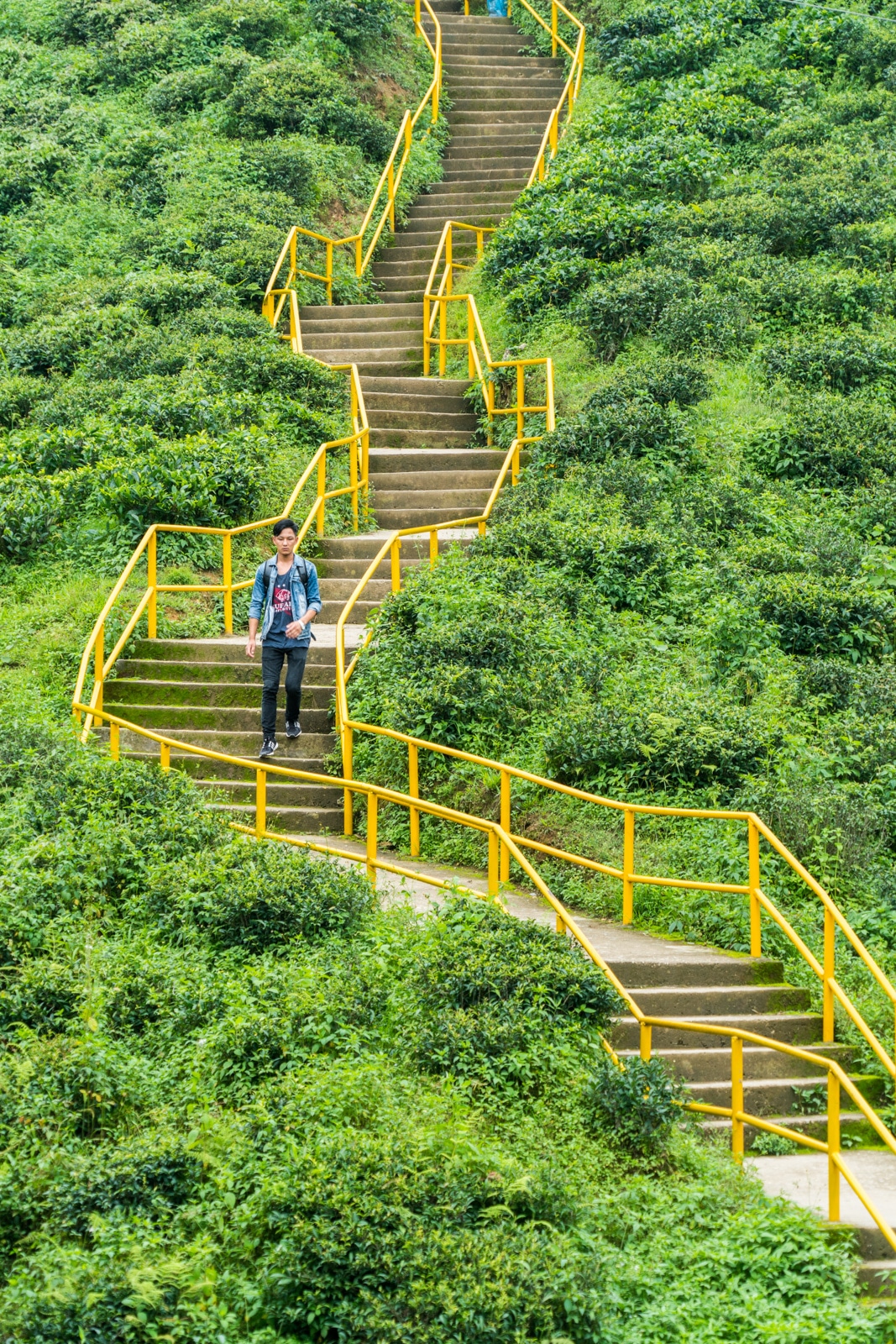
We whiled away the cloudy days sipping tea, reading, and trying out Nepali food! This meal, dal bhat, is found everywhere in the country, and usually includes rice, lentils, some vegetables… and whatever else is available! Most people tire of it quickly, but I fiend for rice—I could (and did) eat it all day errday.
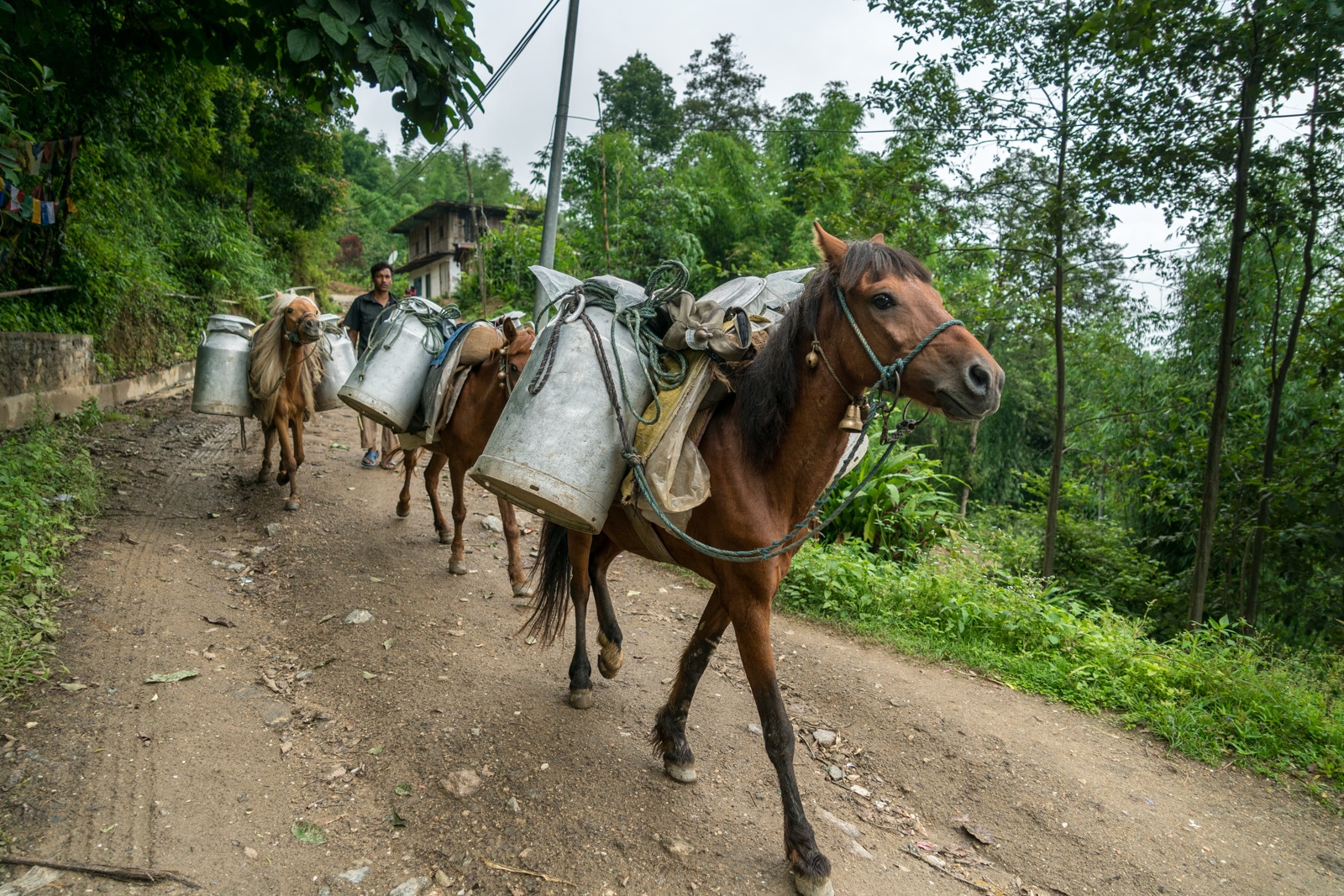
We ran into these pack horses while trekking to Mai Pokhari lake, a holy place about 15km from Ilam. I’d share photos of the lake… but we don’t have any! It poured—and I mean poured —rain for hours right before we reached the lake. We were soaked beyond the bone, and it was way, way too wet to even think about taking a camera out. #monsoon
The dusty streets of Kathmandu
We took a bus to get from Ilam to Kathmandu, Nepal’s capital… but it was not as easy as it sounds.
The bus ride from Ilam to Kathmandu is supposed to take about 14 hours. Monsoon, however, is another story.
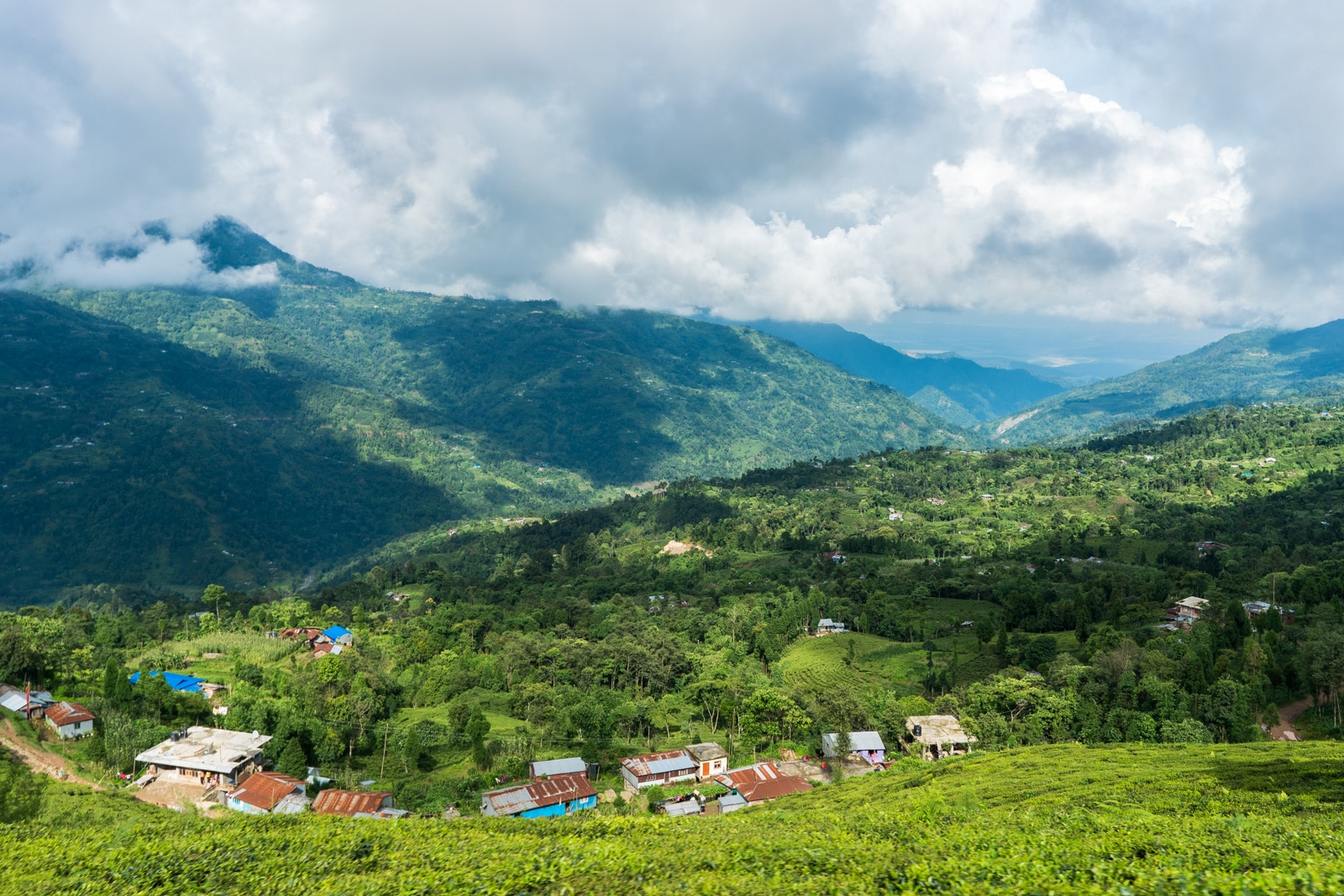
Epic views on the road from Ilam to Kathmandu
During monsoon, landslides are incredibly common. Many of Nepal’s roads are already in poor condition, and when a landslide occurs, traffic can stop for hours while people wait for someone to come and clear out the rubble.
Our 14-hour bus ride ended up taking 27 hours ; a long, sweaty, and generally unpleasant ordeal. (Our feet also looked like balloons by the time we emerged like sticky swamp monsters from the deep in Kathmandu, an amusing first for us!)
Luckily, despite thick clouds of dust from rampant construction, Kathmandu proved to be a fascinating city to get lost in.
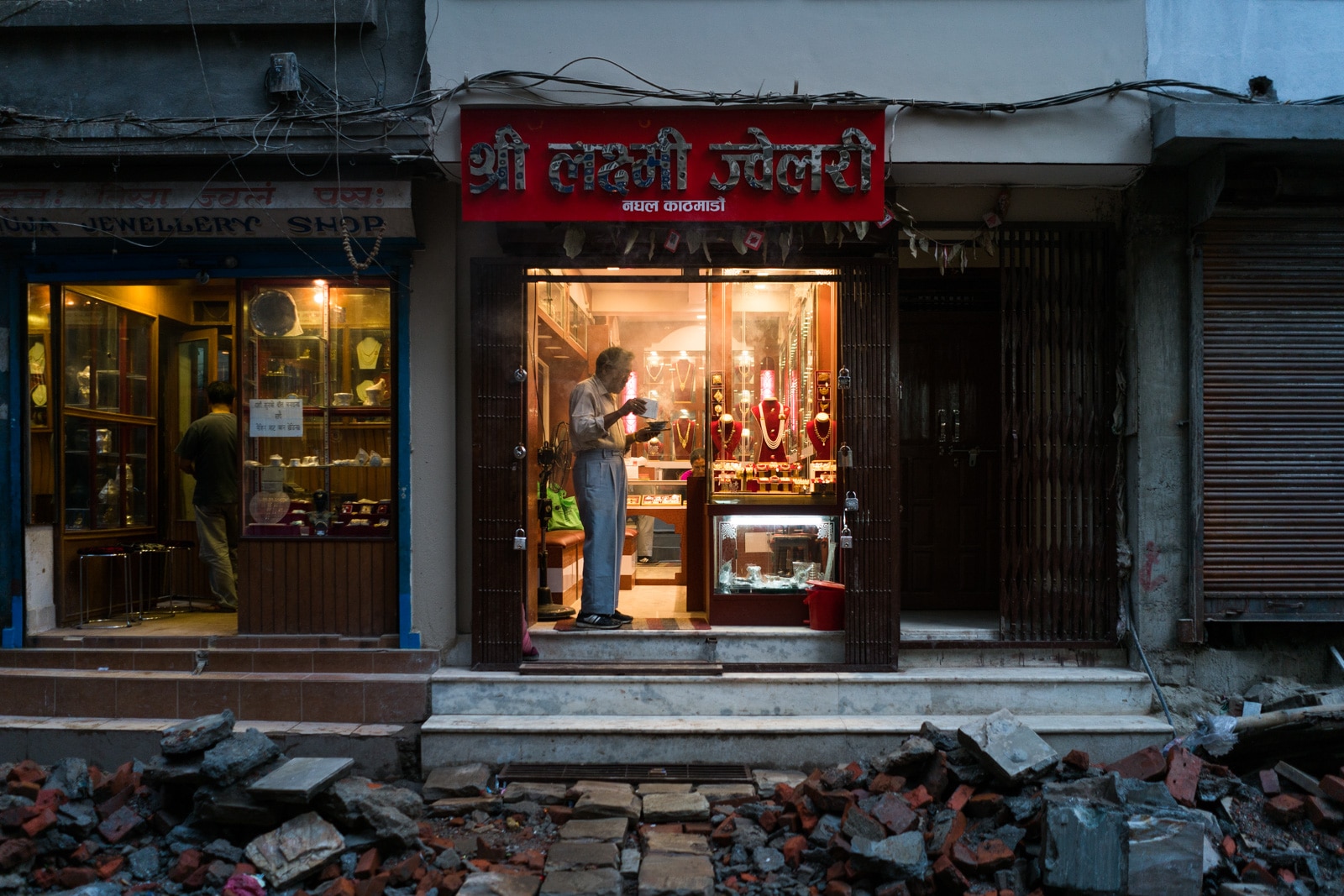
Nepal’s streets can be a struggle at times, but there’s more than enough going on to keep you distracted from it!
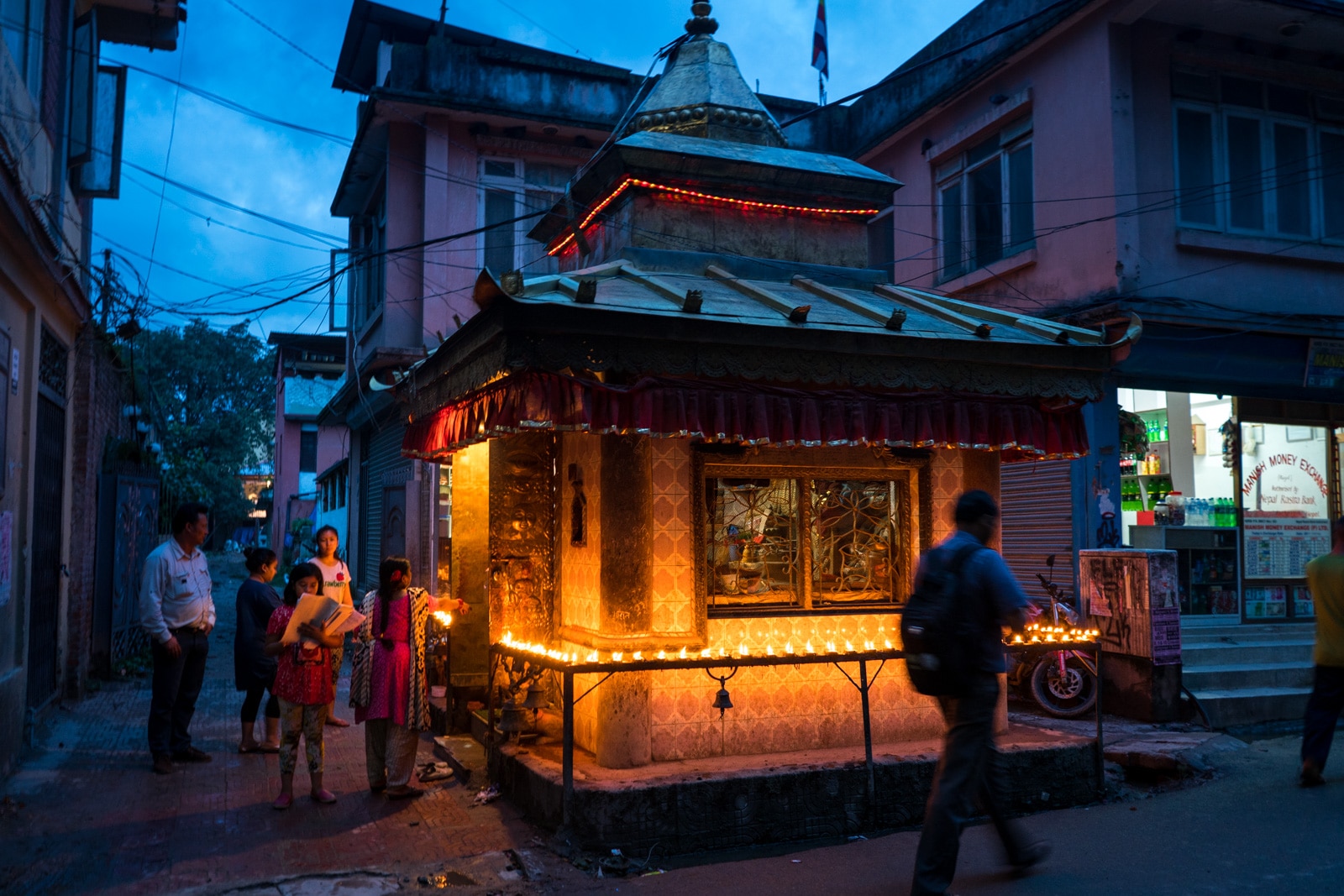
… like these tiny Buddhist shrines found all throughout the city! Though clouds may make for flat photography during the monsoon days, nights in Kathmandu are certainly atmospheric enough to make up for the daytime drab.
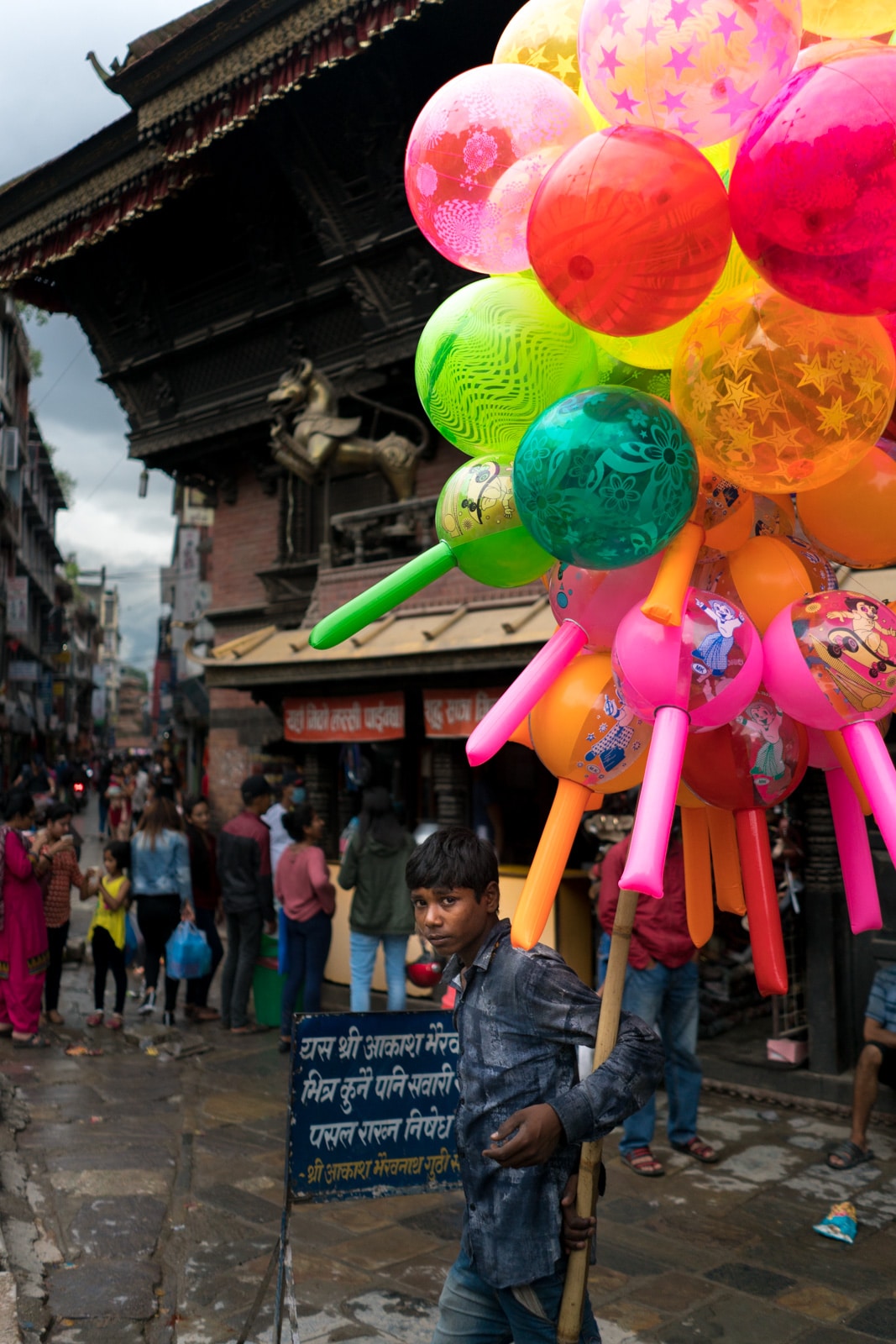
Night falls on the massive Hindu Pashupatinath temple on the outskirts of Kathmandu. The UNESCO temple complex feels a bit like Varanasi, India—colorful pilgrims, a holy river, burning funeral pyres.
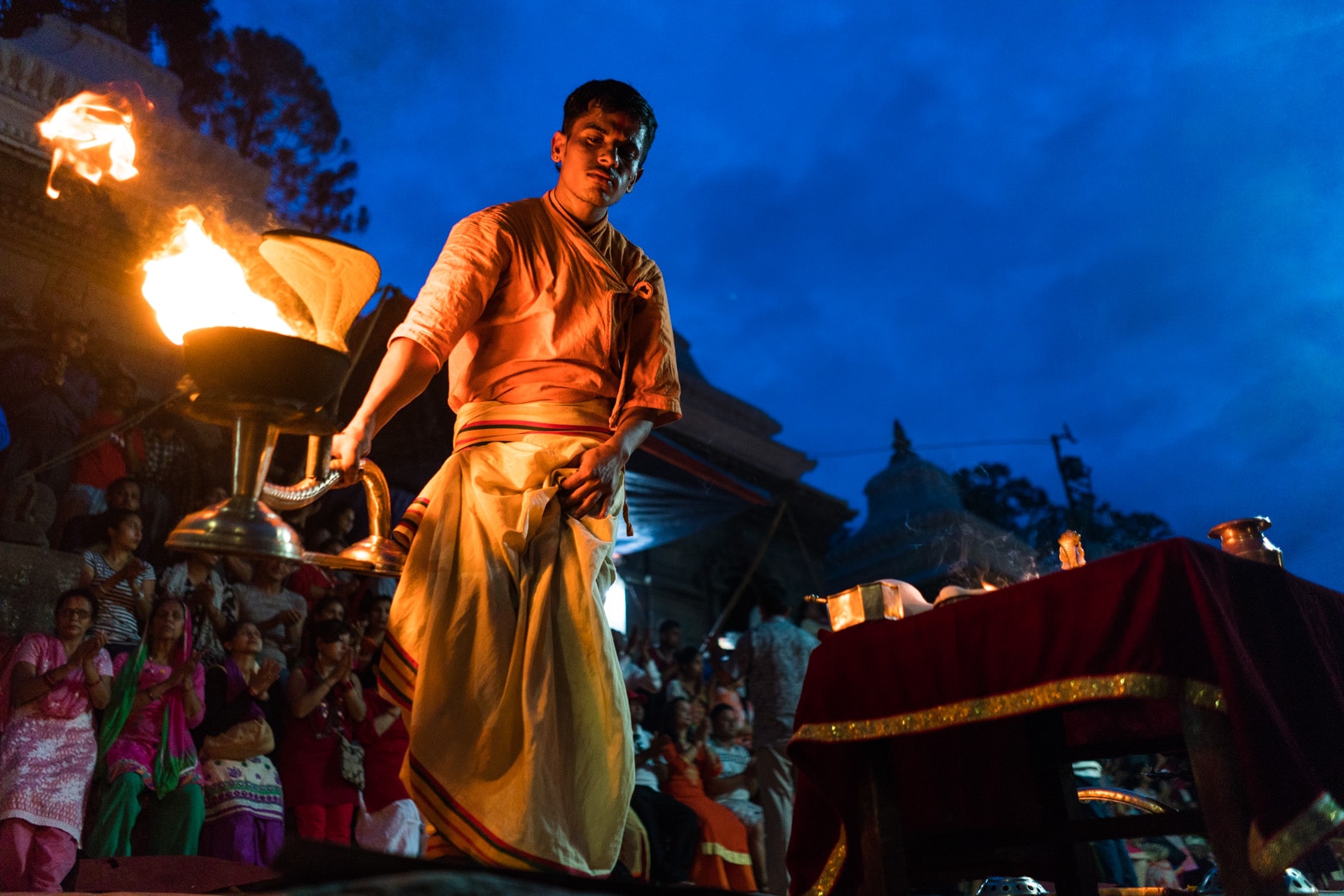
Every evening around 18:00, visitors can watch and participate in the Bagmati Aarti , a ritual where the light of oil lamps is offered up to the gods by the priests of the temple.
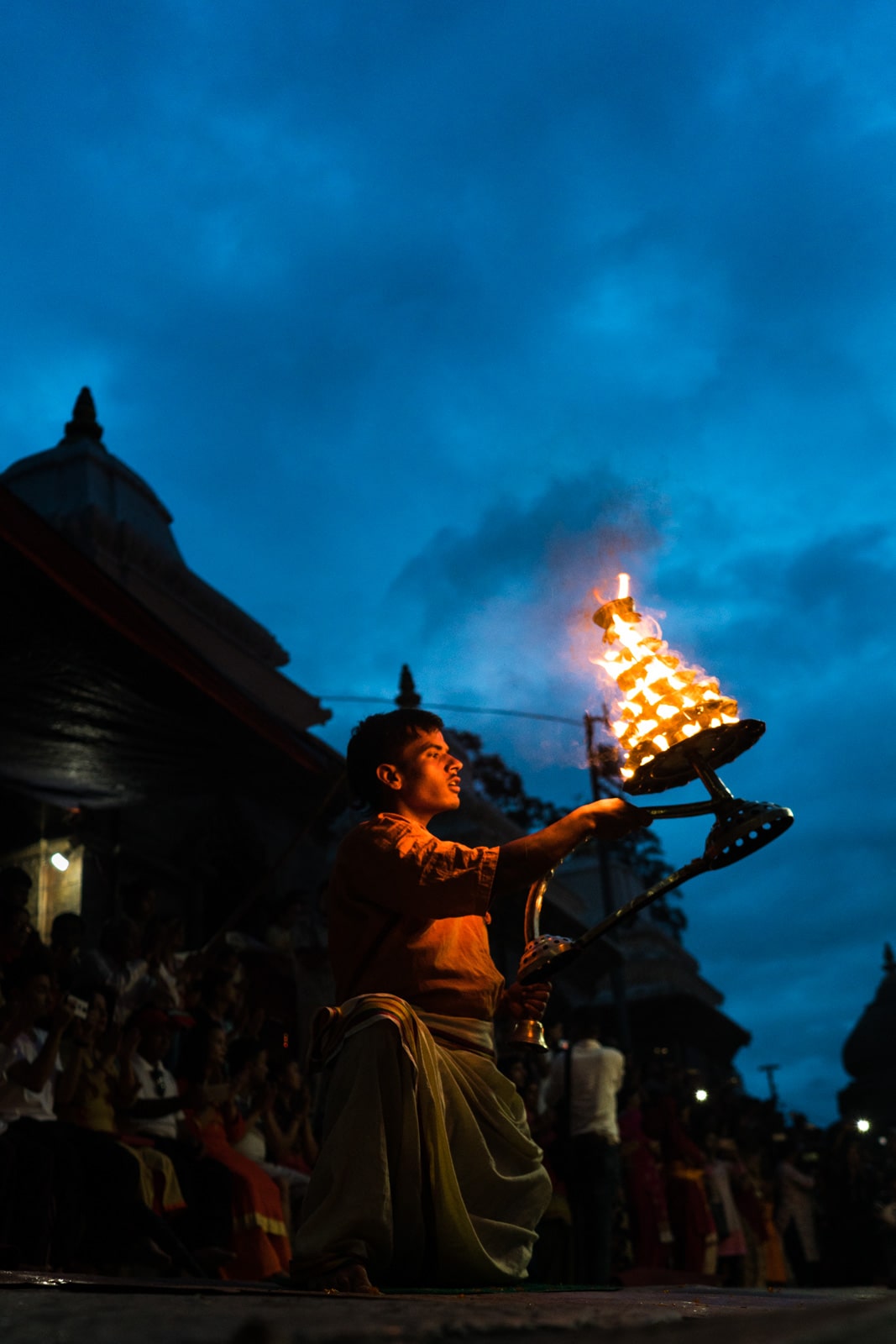
Hundreds of temples are scattered throughout Kathmandu… and there are even more places with the “temple” moniker. Swayambhunath is a towering Buddhist stupa overlooking Kathmandu more commonly known as…
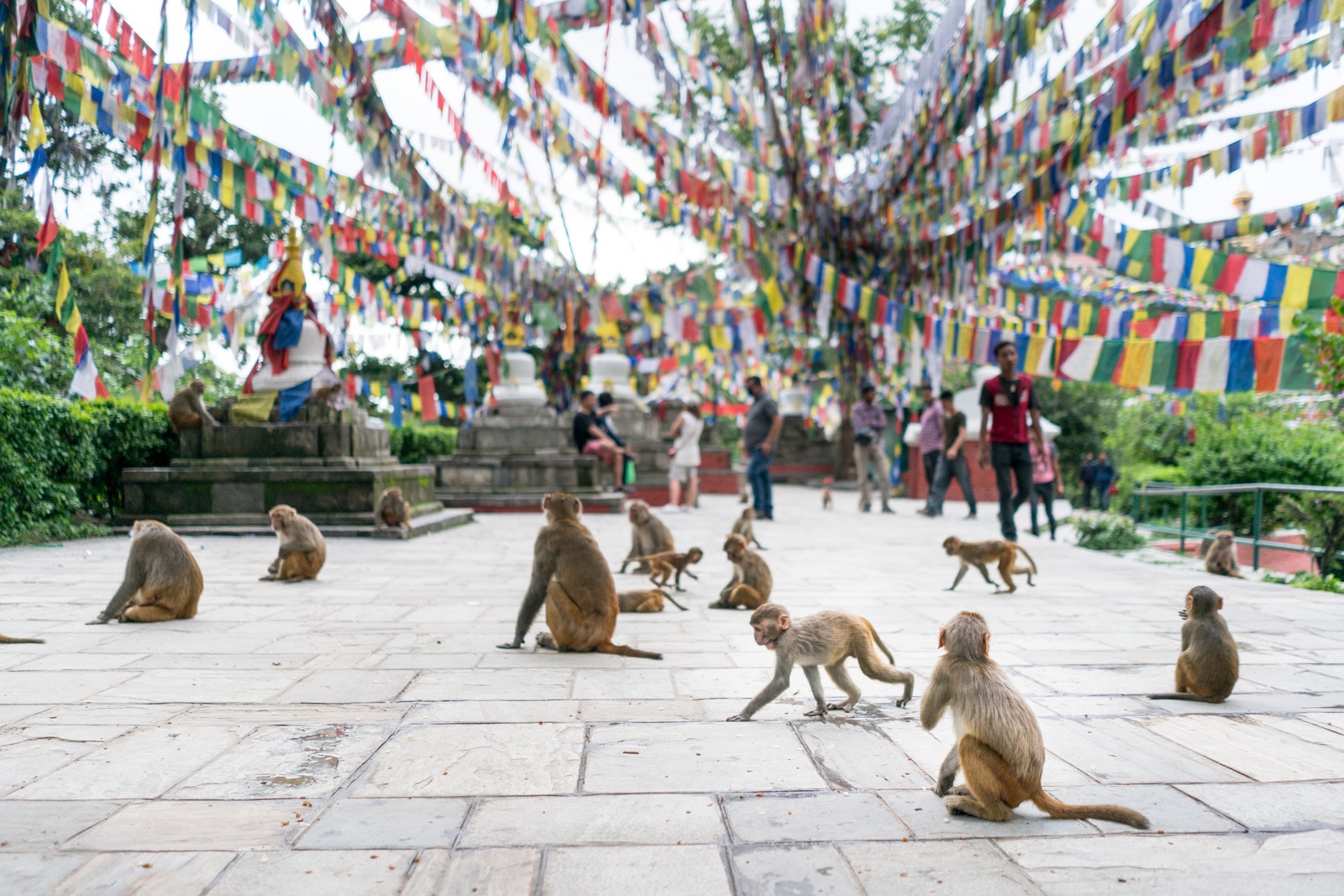
… the Monkey Temple! Hundreds of cheeky rhesus monkeys live amongst the mountaintop stupas. Devious (and sometimes aggressive) as they are, you can’t deny the cuteness as they swing around on the prayer flags and scamper across the stones.
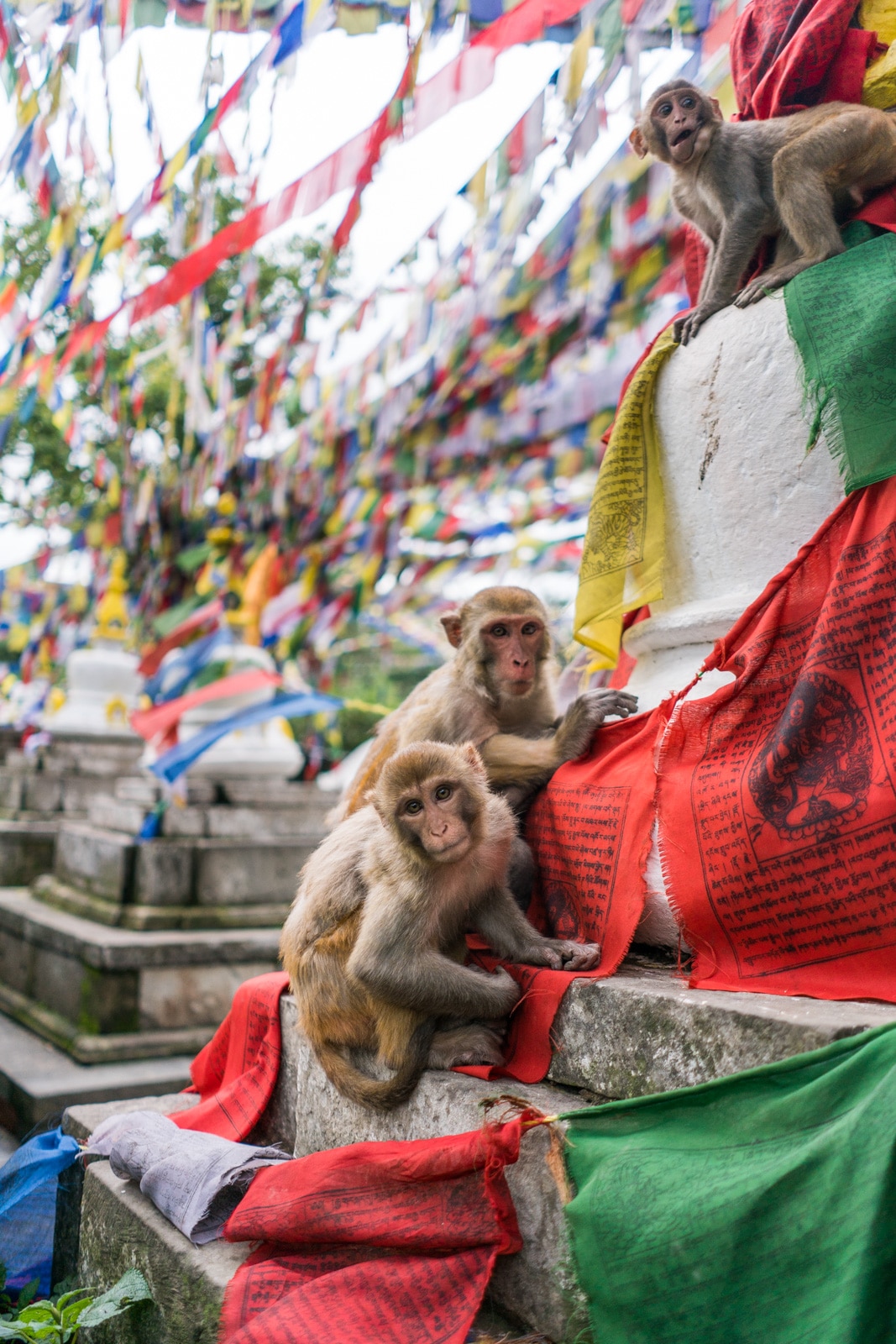
We could see the Monkey Temple from our hotel on clear days—see that tiny pointy building atop the hill? Though days were mostly cloudy, we were treated to a couple of nice sunsets while in Kathmandu.
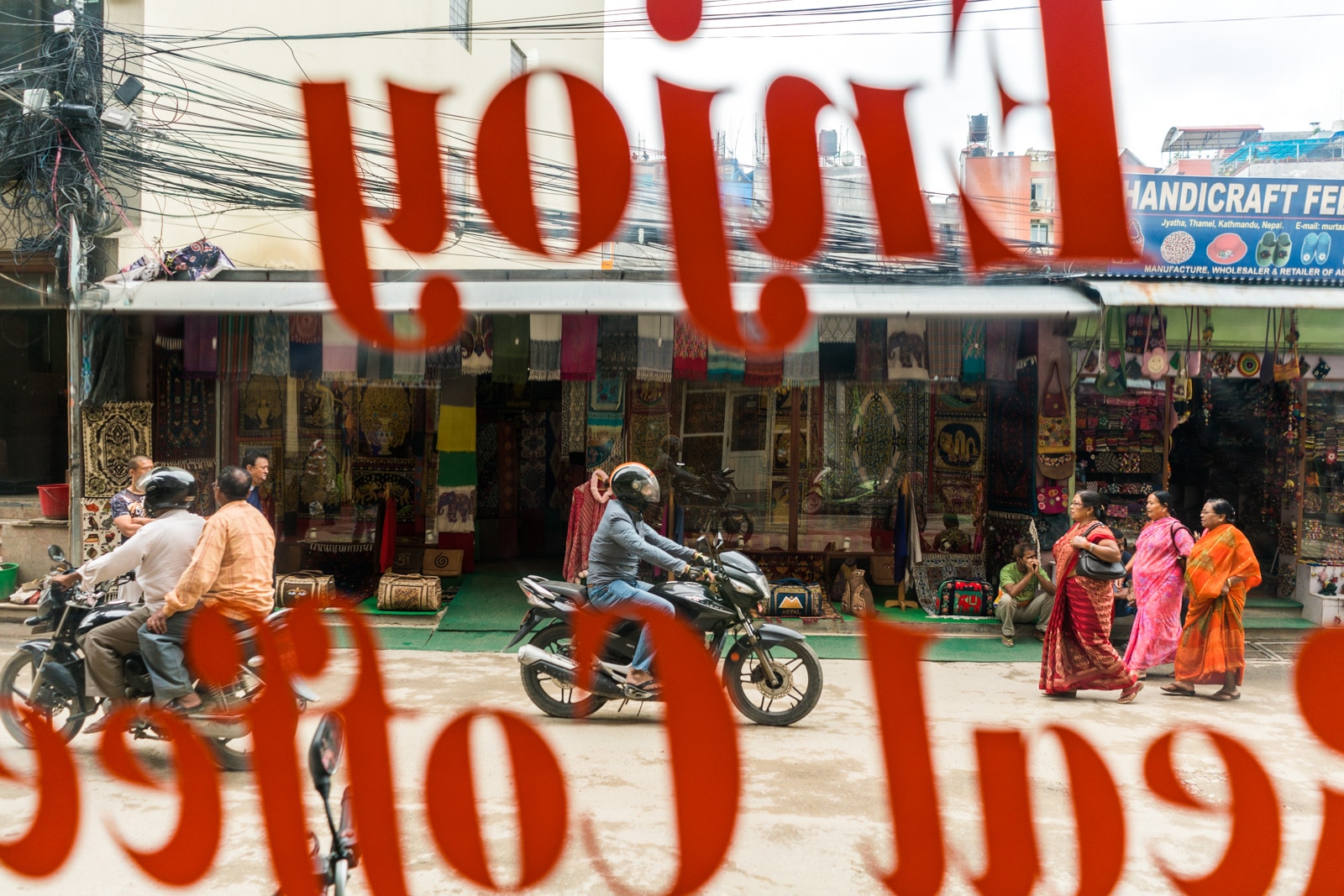
Watching the world go by over cheap—and delicious—coffee from Chikusa Cafe in Thamel, the backpacker area.
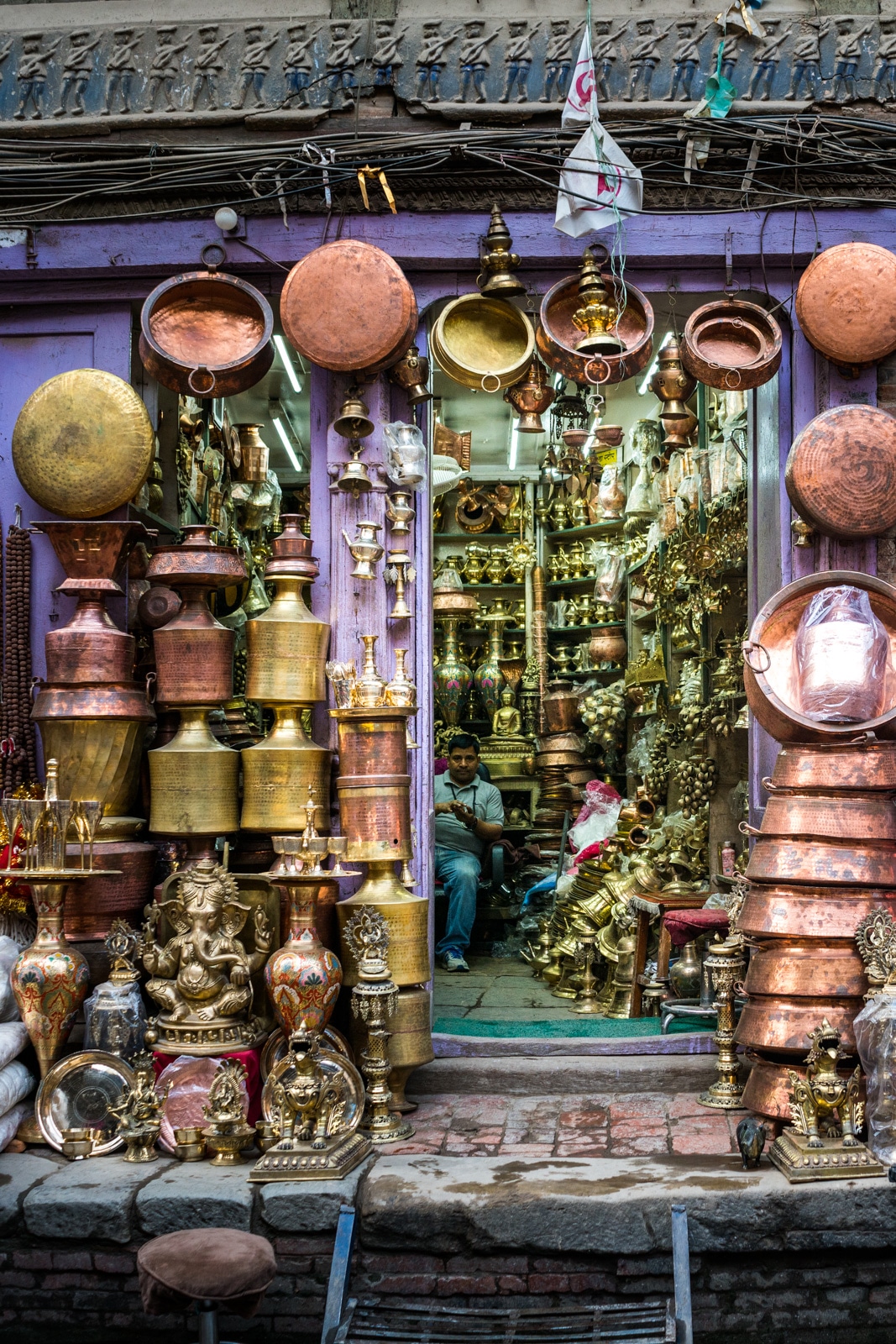
Boudhanath stupa is one of the largest stupas found in Nepal, and a UNESCO World Heritage site. It was one of the last sites we visited, and we were treated to a few hours of clear afternoon skies before the rain kicked in!
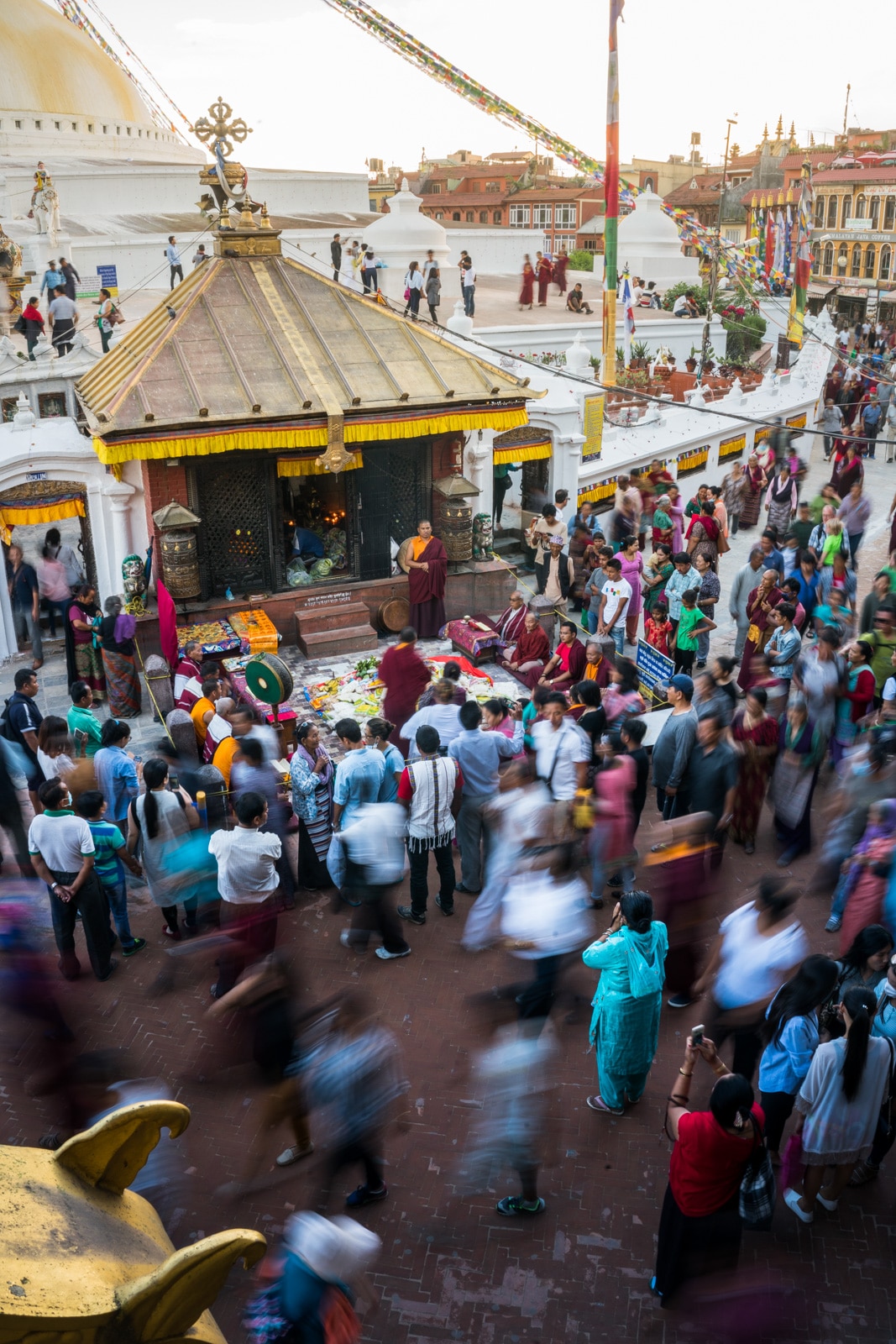
We arrived on a holiday commemorating the change of the “winds of dharma”. Pilgrims were donating all kinds of food, form popcorn to biscuits to rice. Around sunset, after a bit of fanfare and music, all of the food was redistributed to needy people in the crowds.
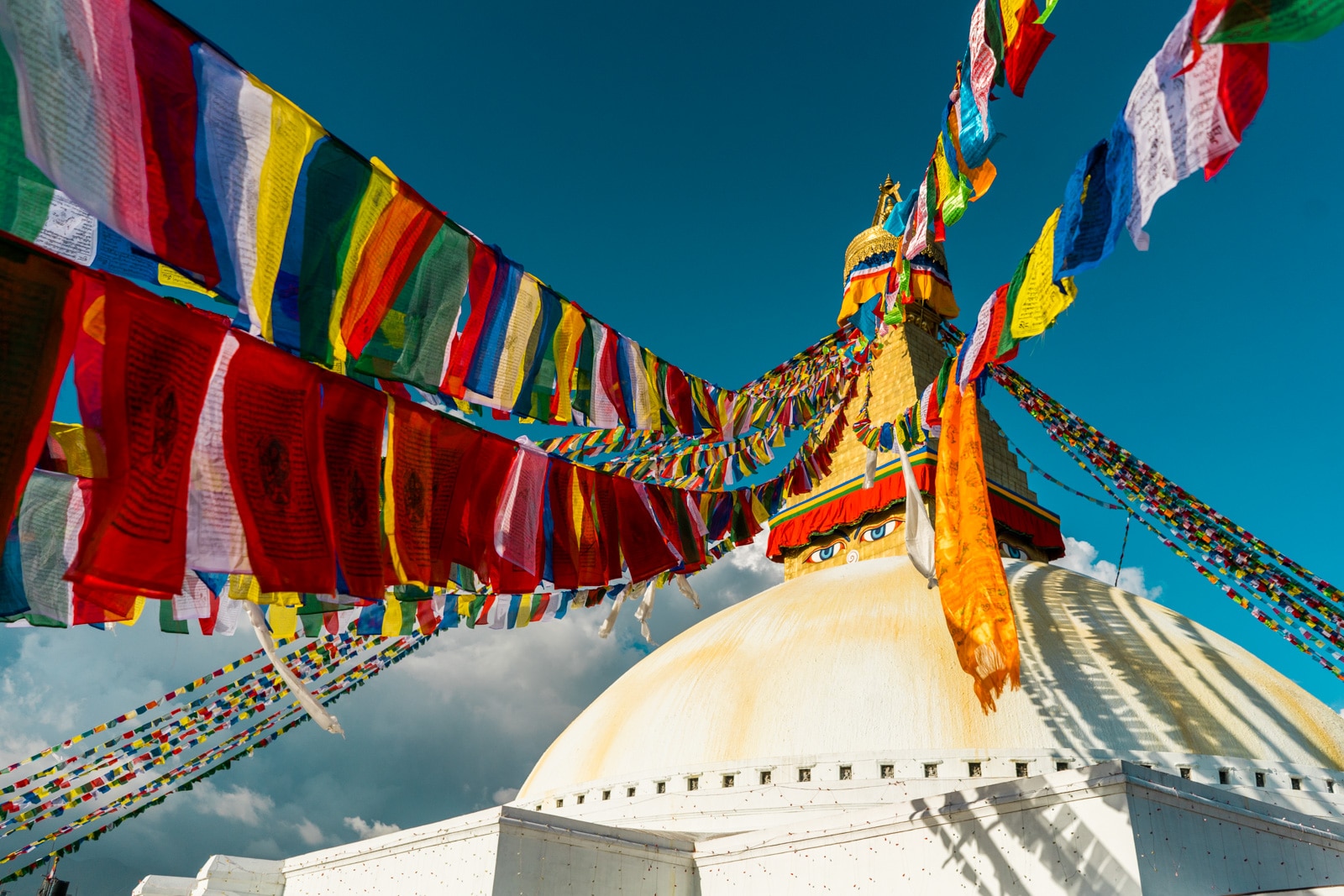
Boudhanath stupa suffered massive damage from the 2015 earthquake, but has since been completely rebuilt—the first tourist sight to do so! It’s a powerful sign of Nepal’s ability to stand strong, come together, and rebuild after the catastrophe.
The picture-perfect lanes of Patan
Despite endless the surprises of Kathmandu, we eventually grew tired of Thamel, the backpacker area where we stayed. Strolling through streets of overpriced (and fake) trekking gear, crappy bakeries, and pizza places gets old, thrilling as it may sound.
To shake things up a bit while waiting for our passports to return, we migrated over to Patan, locally known as Lalitpur. Though it’s officially a separate city, you’d be forgiven for thinking it’s just another district of Patan—it’s only 30 minutes’ driving (one hour in traffic) from the center of Kathmandu, and there’s no departure from urban landscapes during said drive.
However, Patan overall felt much more relaxed than Kathmandu. Illogical yet charming alleys wind their way around the old buildings of the city, and there’s a hair less traffic than hectic Kathmandu.
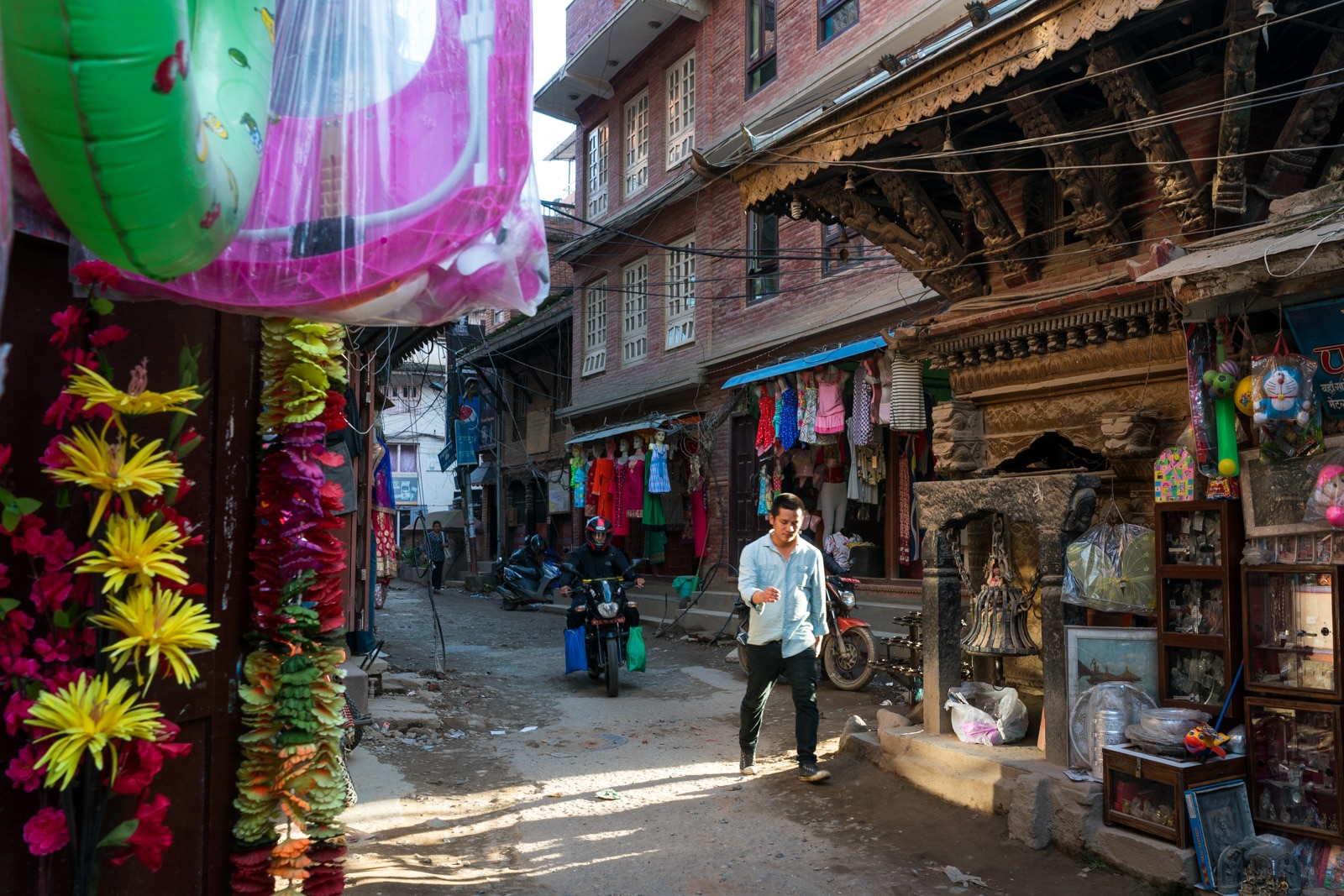
A bit of peace and some good afternoon lighting made us happy campers in Patan! Generally, the days were sunny until the mid to late afternoon, at which the clouds would start rolling in.
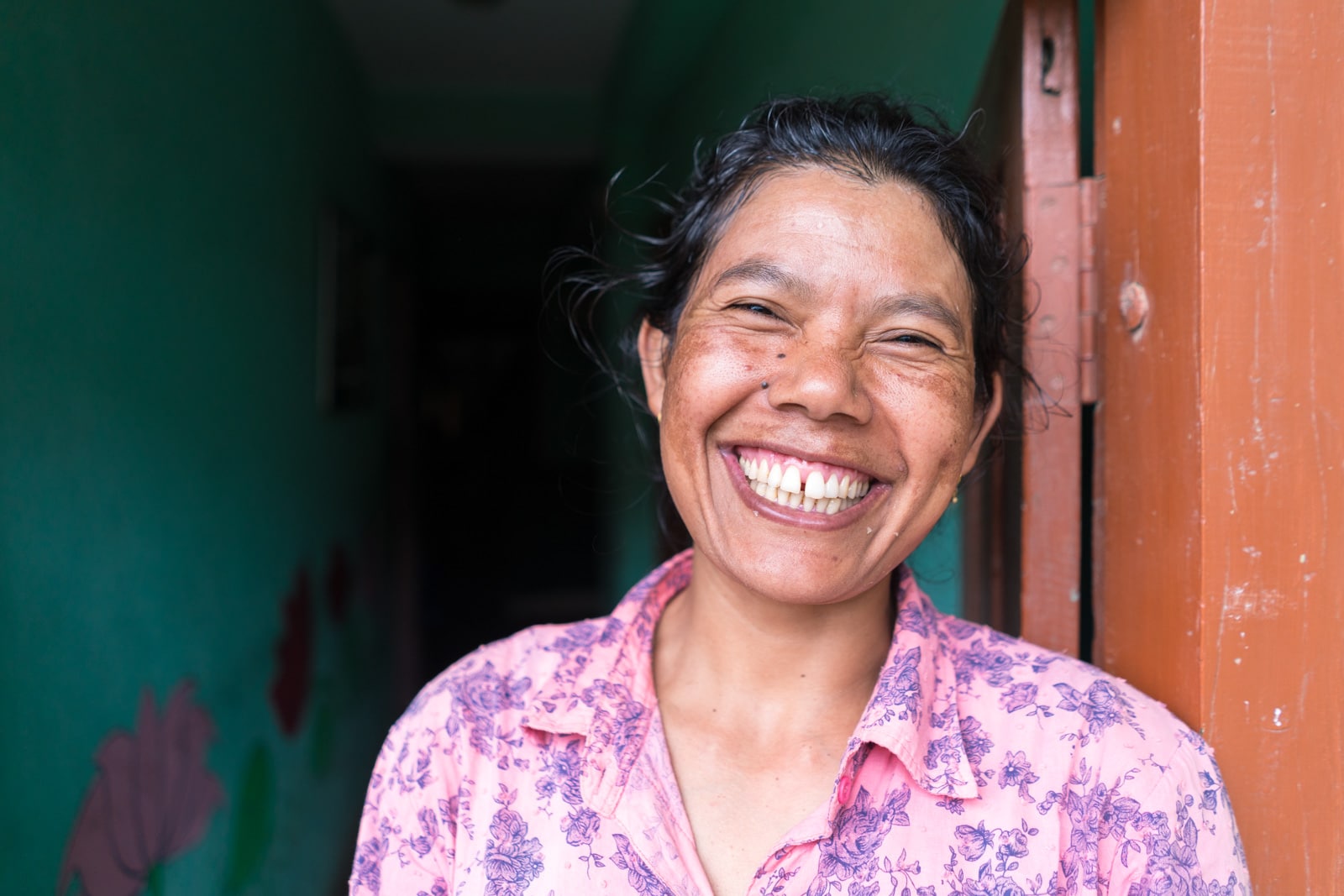
Our stay in Patan was made infinitely better by our lovely homestay host, Sarita. Her blinding smile, endearing personality, and dee-licious vegetarian cooking won’t soon be forgotten! If you’re heading to Nepal, do allot a couple of days to stay at Sanu’s House , her homestay.

I got to tag along with Sarita one cloudy morning as she went out to pick weeds from her family’s nearby rice fields. Yes, you read that right—there are rice paddies to be found within Patan city!
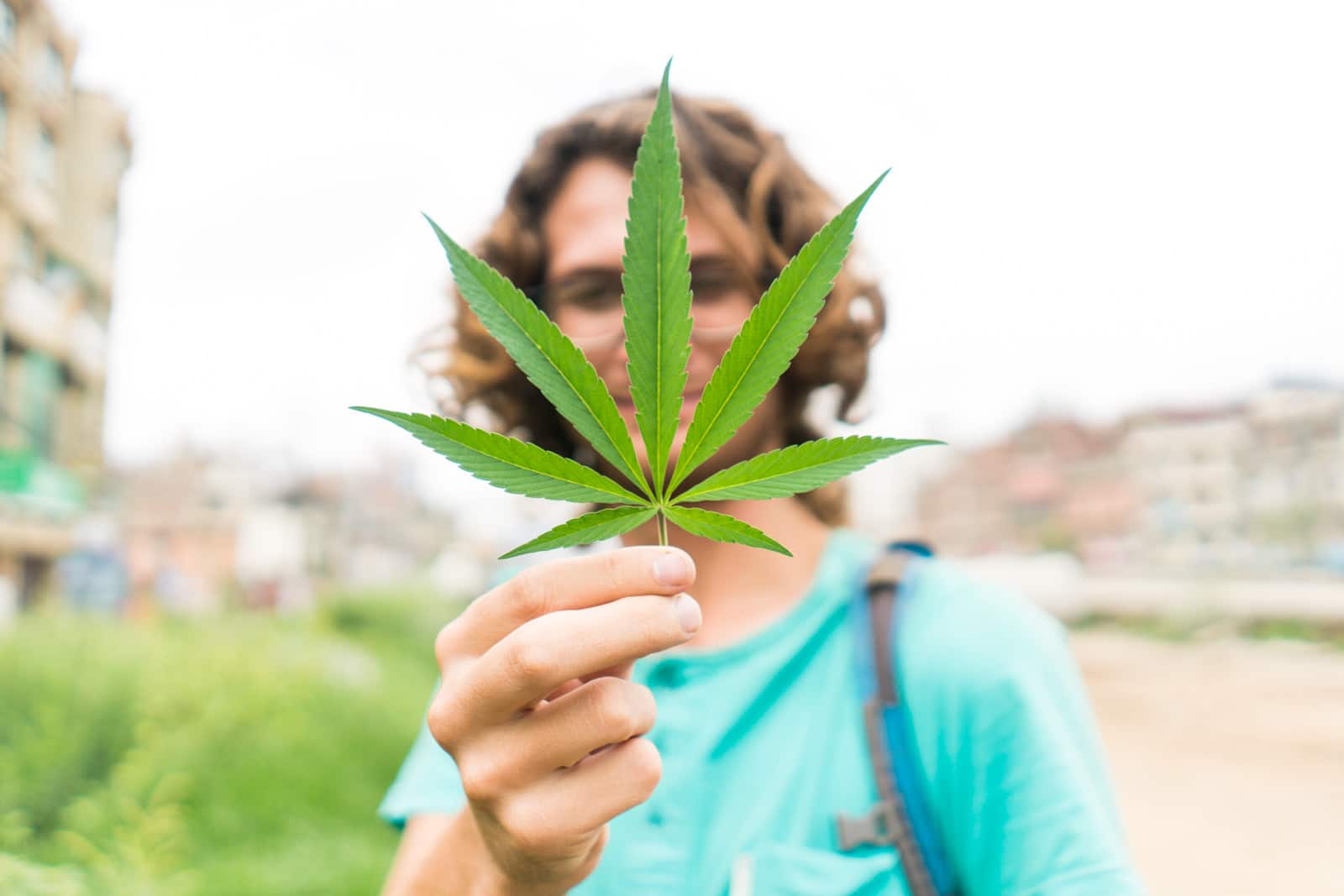
And just for funsies: there’s a massive weed plant growing outside Sarita’s house. A truck driver who often parks near the house proudly proclaimed it was his plant. A work of love!
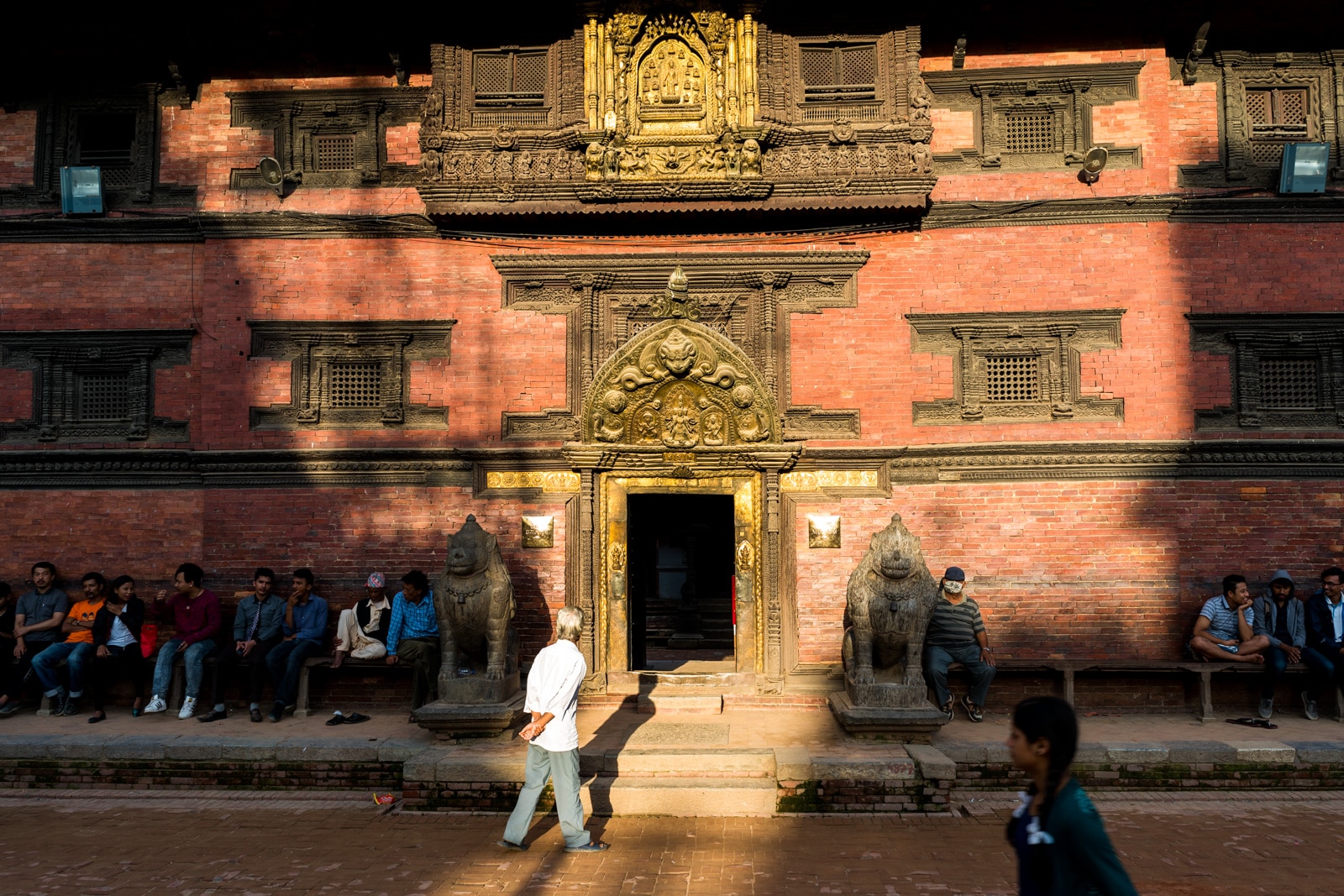
Aside from Sarita’s charm, another big plus point from Patan is its Durbar Square. Unlike Kathmandu’s Durbar Square, which was horrendously affected by the 2015 earthquake, Patan’s square is relatively intact, and far more atmospheric than its Kathmandu counterpart.
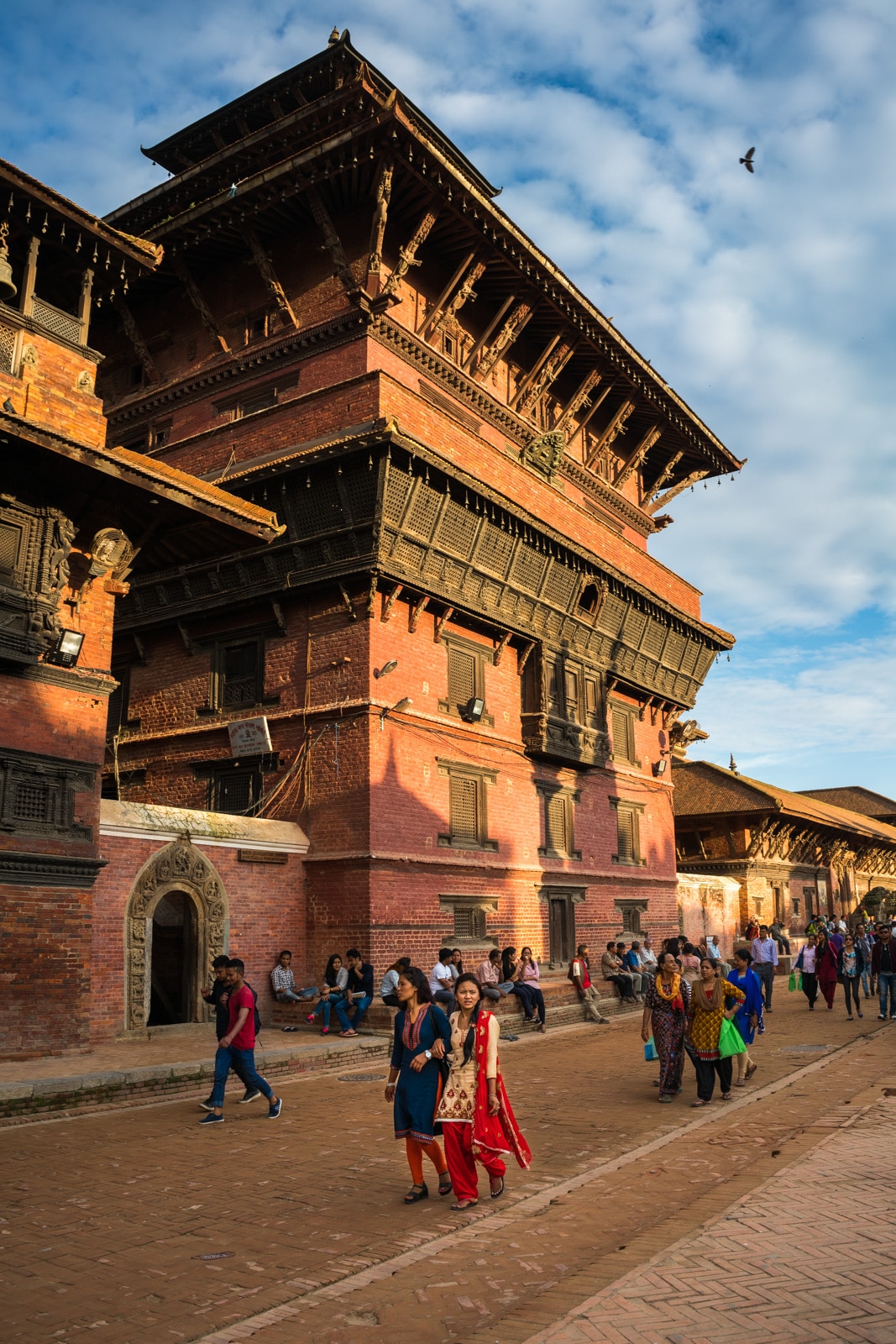
#PatanAndChill
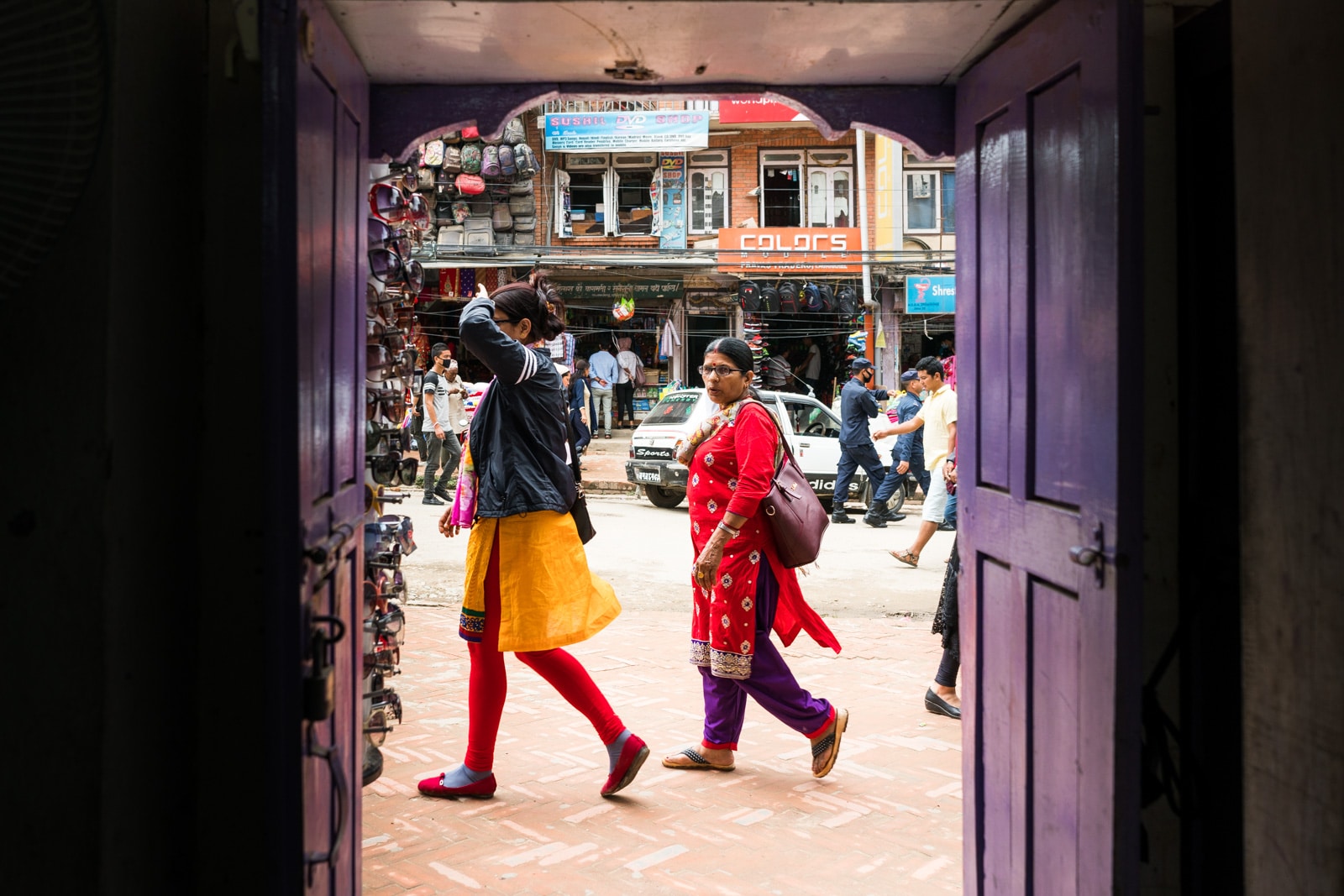
Another photography tip: if the skies above are gray, look to the streets and the people to find splashes of color! Get creative enough, and you won’t find yourself missing blue skies… too much.
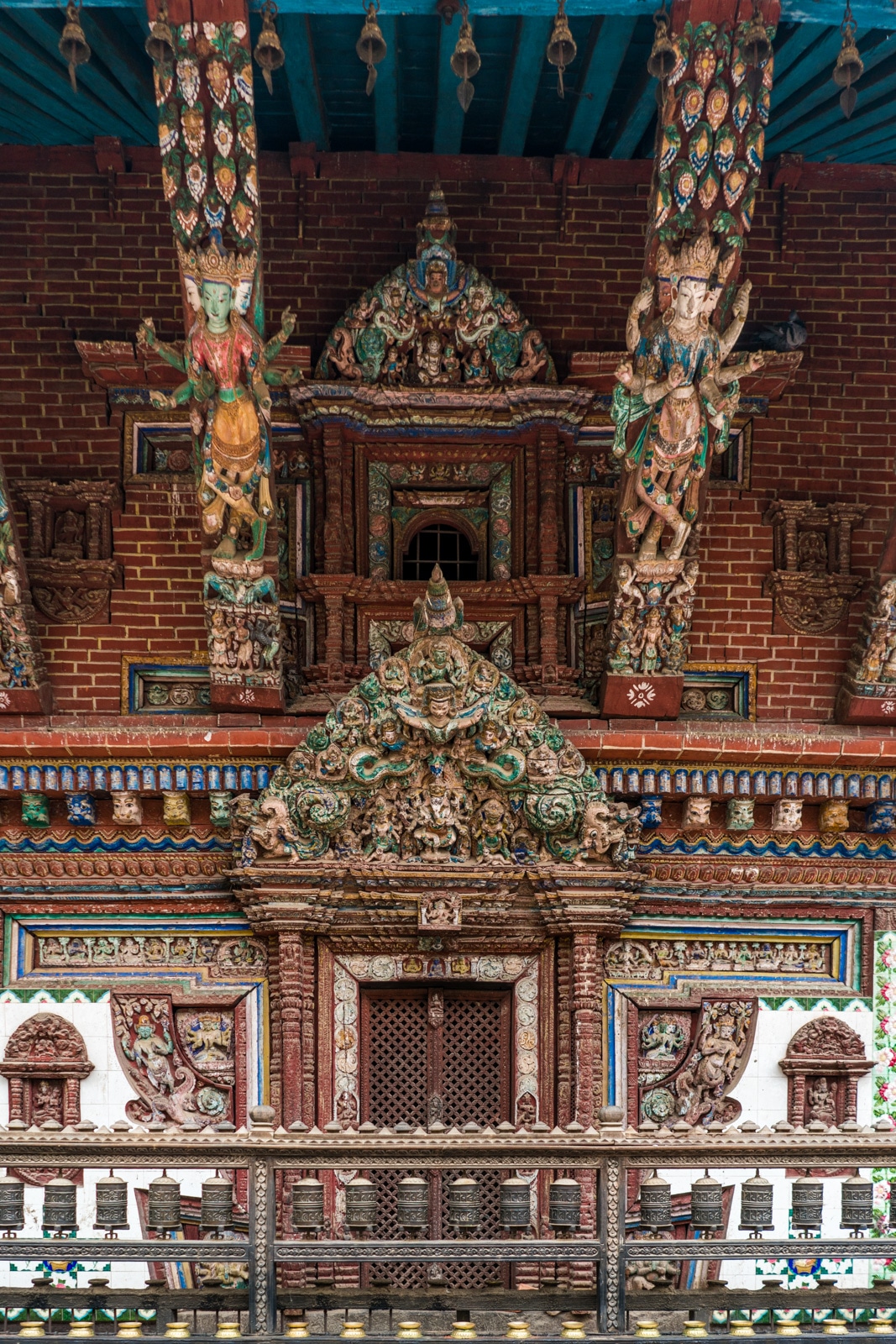
Though Durbar Square gets all the attention, the Hiranyavarna Mahavihara (AKA Golden Temple) was my favorite building in Patan. Virtually unscathed by the earthquake, the Buddhist monastery is hidden in a peaceful little block of Patan, well away from impatient honking and floating dust clouds.
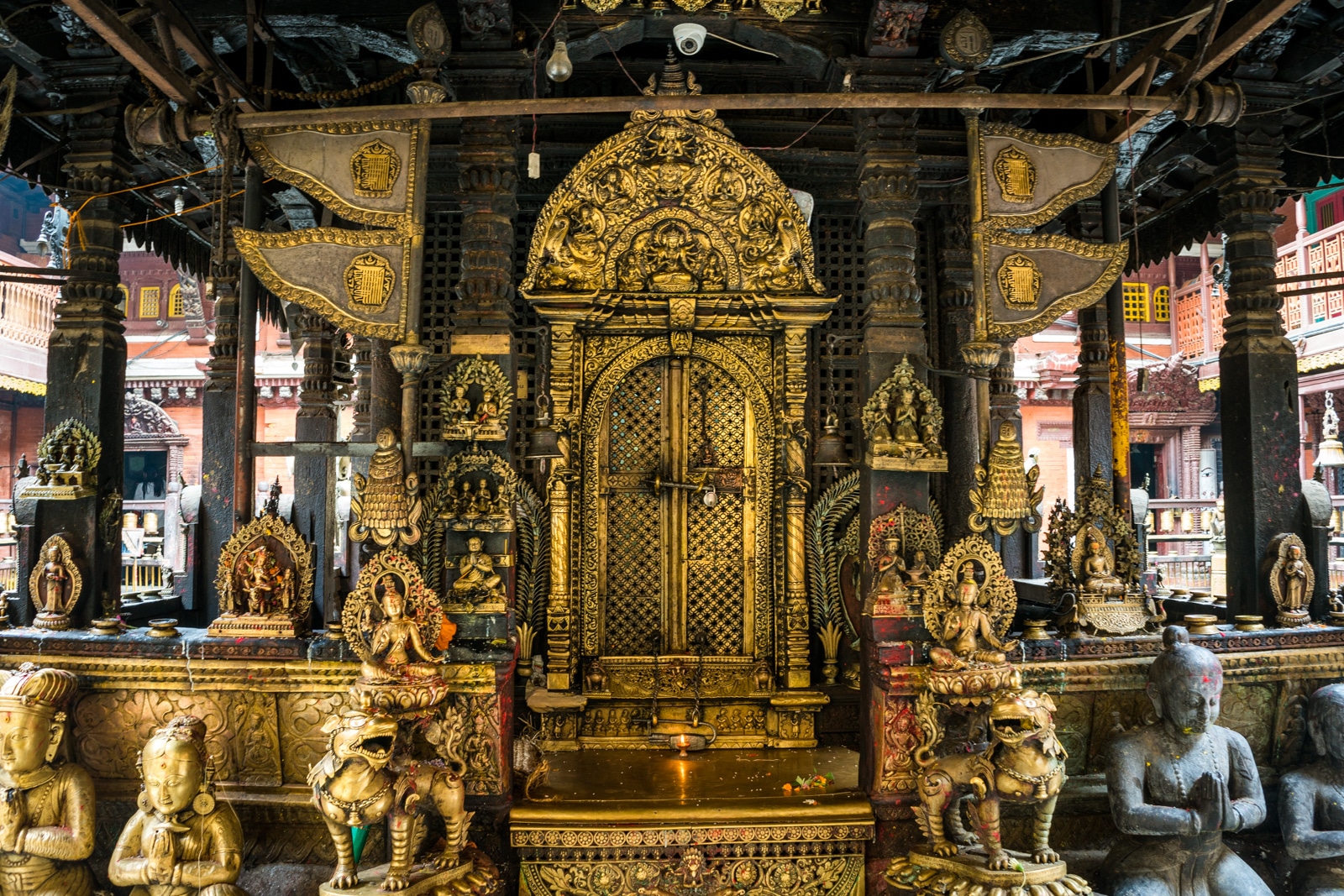
No rush, no hassle—only the sound of quiet chanting and whispering in the background, the perfect soundtrack for taking some time to explore the million and one bedazzled decorations all throughout the monastery.
Still waters and heavy heat in Pokhara
Time passed, the number of days until our Nepal visa expired grew ever smaller, and still our passports were stuck in customs. Wah!
We continued to work during the days, and venture out to explore in the cooler evenings. But, after almost two weeks in Patan, we began to grow restless. Needing yet another change of scenery, we headed to a destination many had raved about: Pokhara, one of the most popular tourist destinations in Nepal .
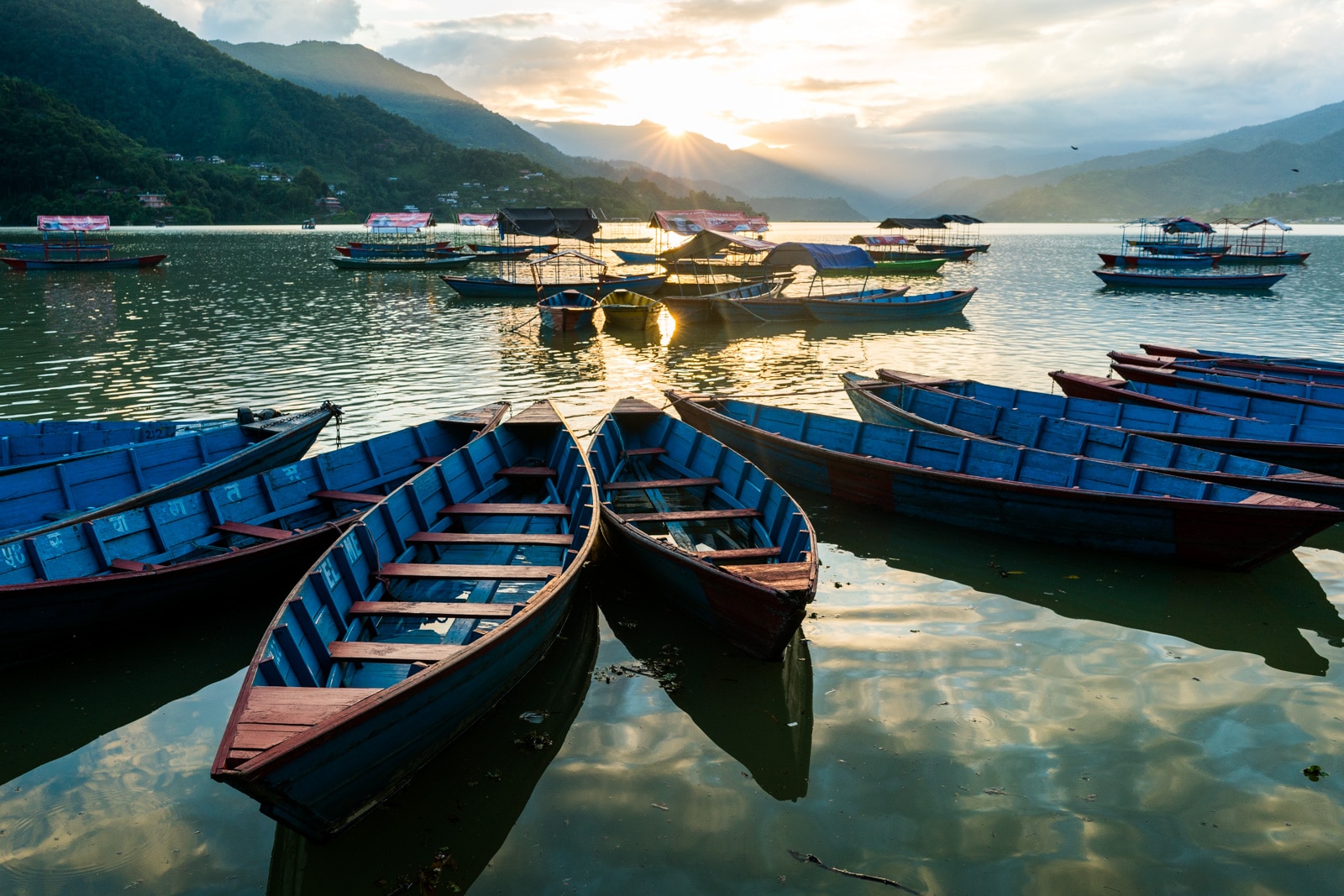
The quintessential blue boats of Pokhara.
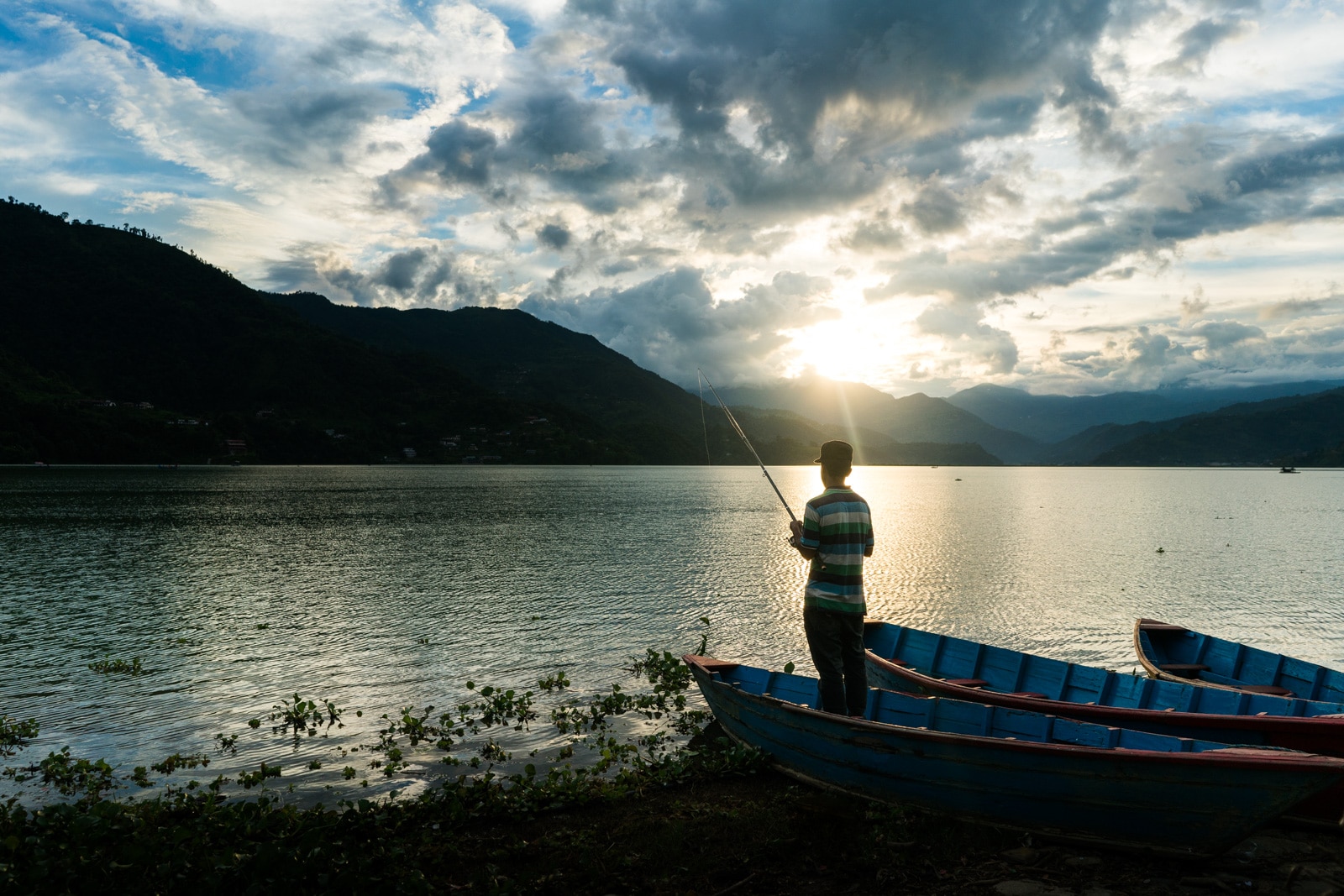
A boy fishing on Phewa Lake, Pokhara’s most famous attraction.
It was a classic case of expectations not meeting reality. People made Pokhara out to seem like a quaint little lakeside town, filled with colorful houses and chill vibes. In reality, the tourist district Pokhara is not much better than Thamel in Kathmandu… perhaps even worse because tourist prices in Pokhara are at least 20% higher than in Kathmandu! (And the wifi is much worse. How is a digital nomad to survive?)
However, most people will visit Pokhara in Nepal , so it’s a great place to make friends and meet trekking buddies.
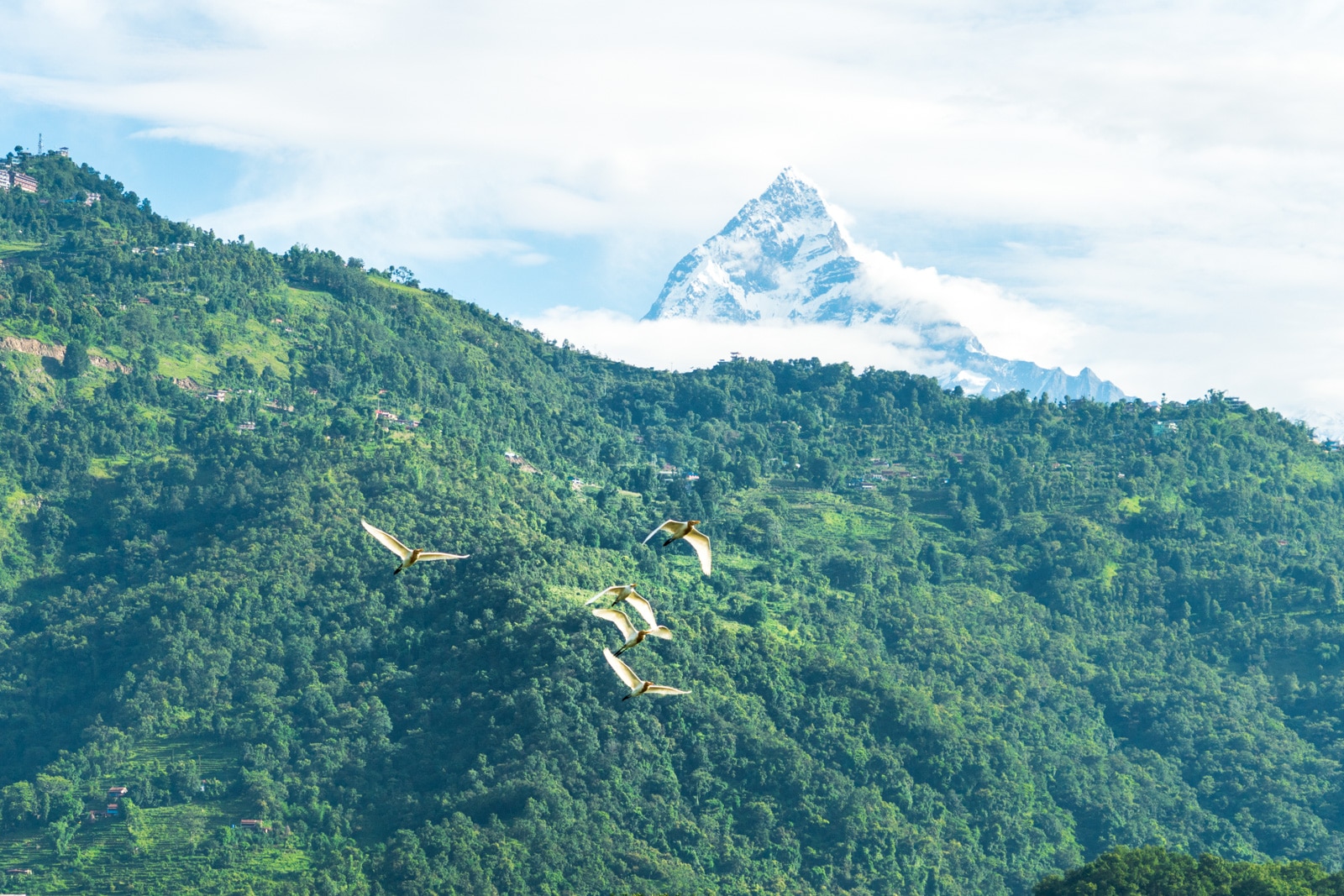
But on the bright side, we finally got a clear view of snowy mountains! The mountains were usually visible in the early morning, but would be covered with clouds by about 9:00.
The first few days were a letdown. Monsoon in Pokhara means high temperatures (around 35°C) and humidity during the day, and heavy cloud coverage in the evening. It didn’t actually rain particularly hard during the days, but I assure you, there was enough moisture to go around in the air itself.
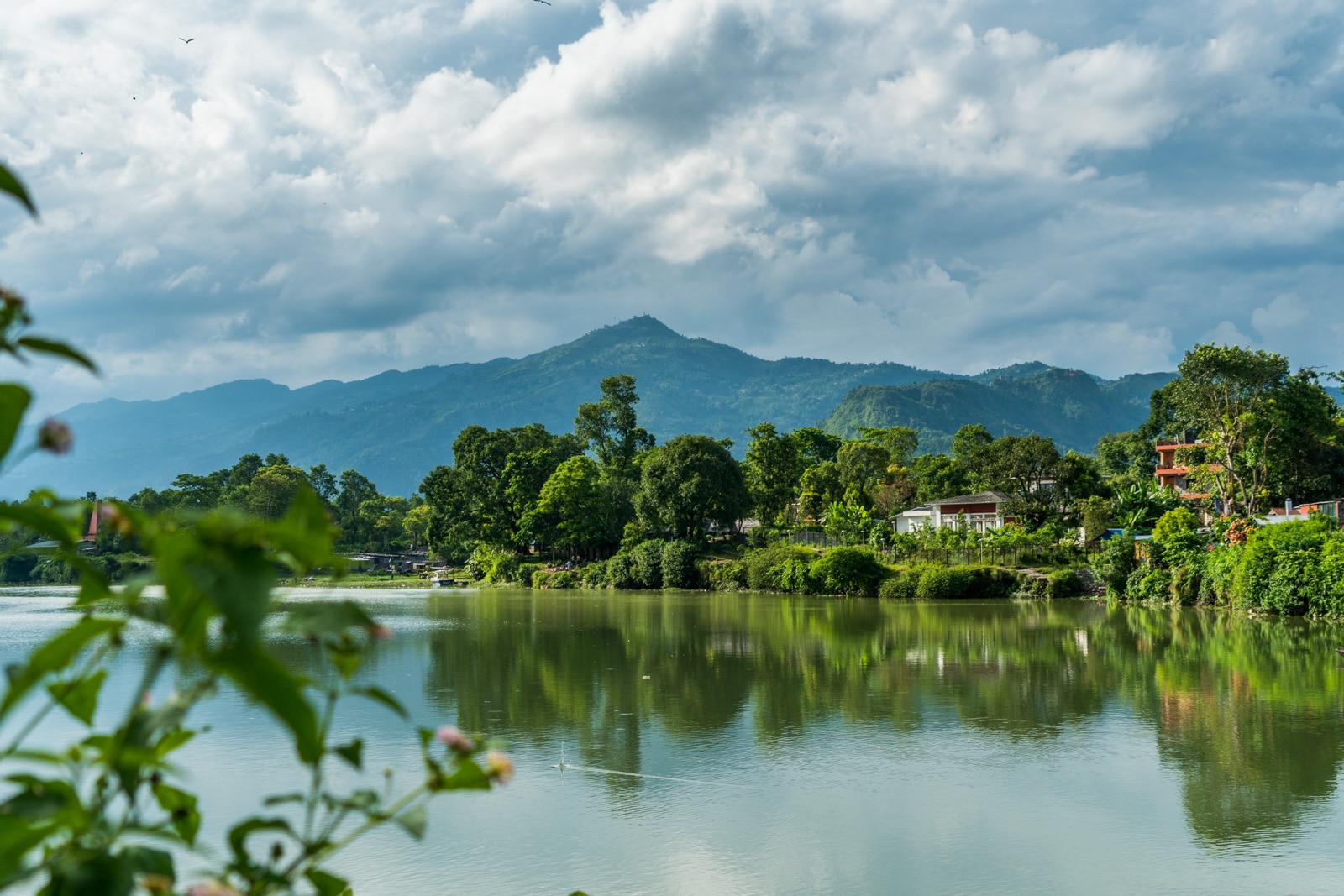
Eventually, though, we made it to the outskirts of Pokhara, where we were treated to fresh(er) air, gorgeous views, and a significant reduction in signs advertising happy hours and German pastries.
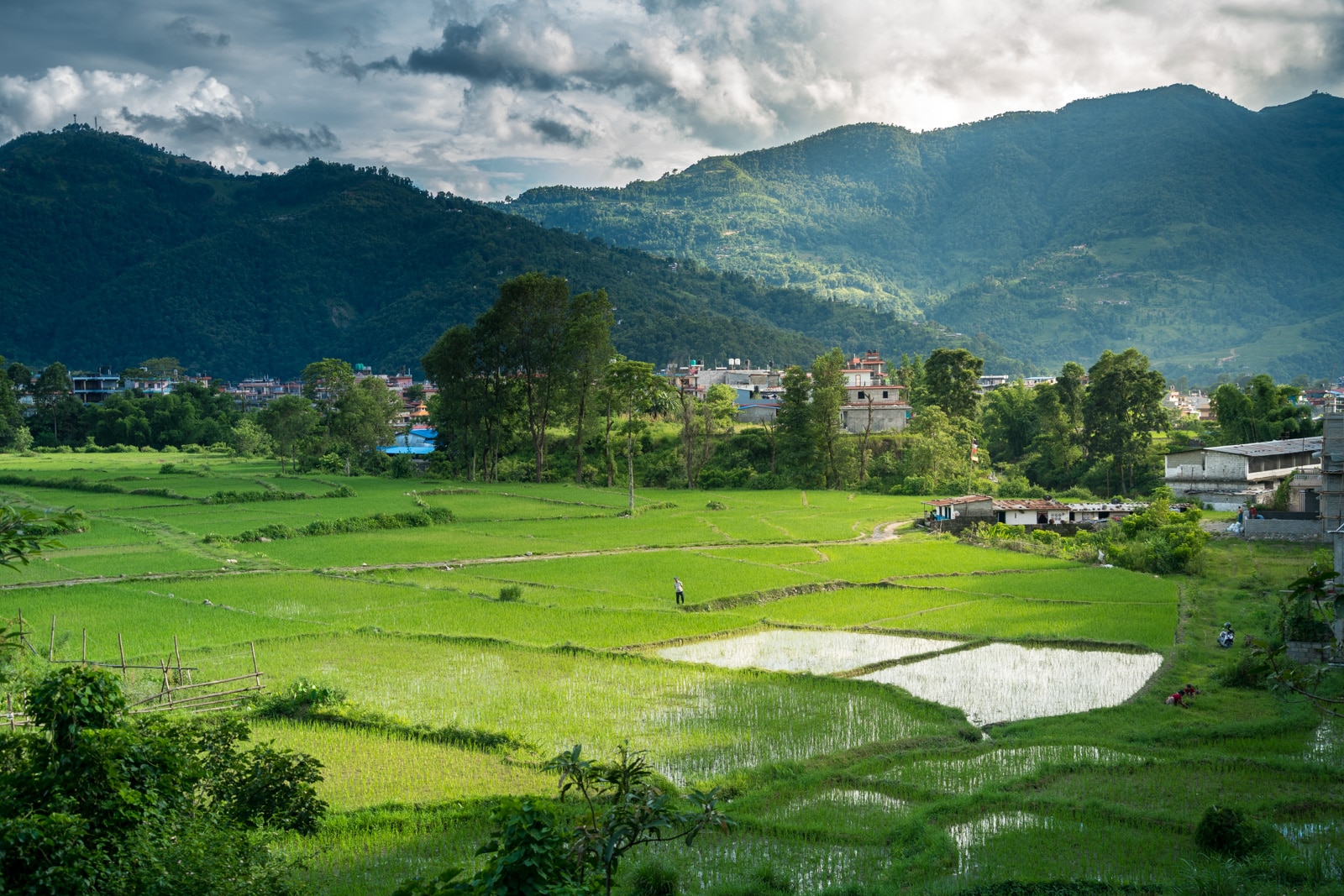
An entirely different world.
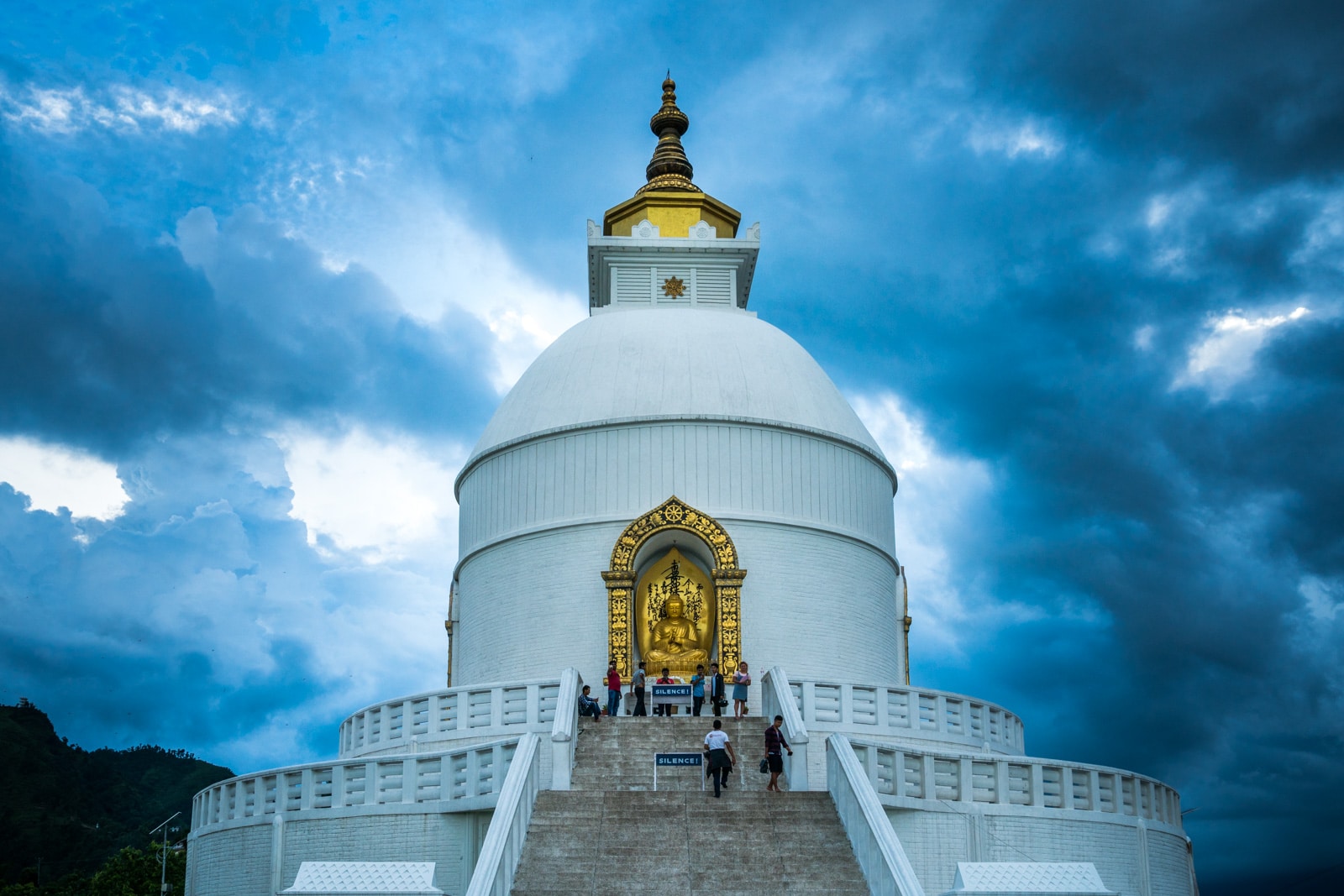
The World Peace Pagoda sits atop a small mountain overlooking Pokhara. Clear skies and sunshine warmed us as we began the climb, but at the end of the two hour trek, the entire sky was totally obscured by heavy clouds and rain! Such is monsoon travel in Nepal. (But on the bright side: ominous clouds are sexy.)
So… should I travel in Nepal during monsoon?
If you have the luxury of traveling at a different time, we strongly recommend you try to plan your trip outside of monsoon season. Unless you have a serious cloud or rain fetish, that is.
But, if there’s no other option, you might as well! On the bright side, prices are much lower in the off season, and tourist numbers are cut in half. No need to worry about finding a bed anywhere!
Trekking in Nepal during monsoon
If you’re looking for more information about trekking in Nepal during monsoon, we found these posts helpful (despite not being able to actually apply their advice):
- Best Nepal treks during monsoon
- Nar-phu Valley and Annapurna Circuit in August
- The Annapurna Circuit during monsoon season
Whatever you choose, the best of luck to you, and safe travels!
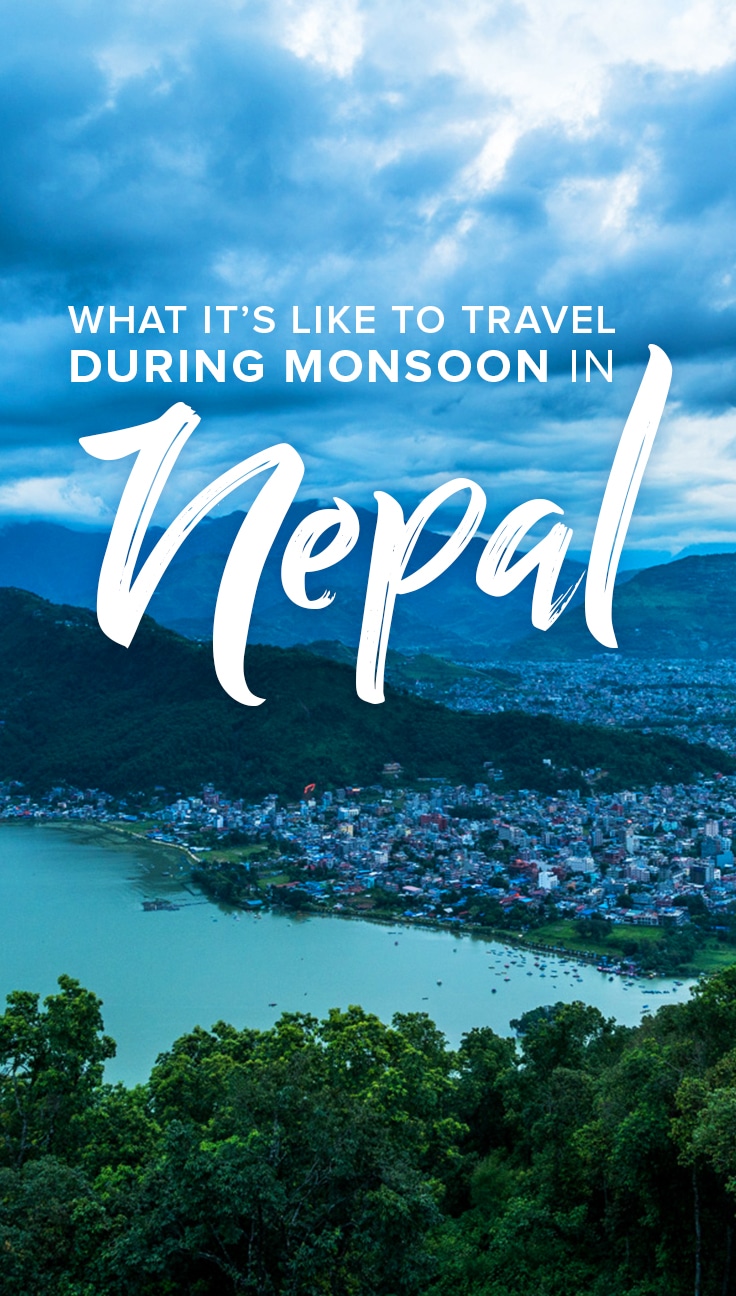
Yay transparency! There are affiliate links in this post. If you buy or book something using our links, we’ll make a wee bit of change at no extra cost to you. Think of it as supporting our blog!

Alex Reynolds
20 thoughts on “ monsoon in nepal: visa quests, failed plans, and coffee addictions ”.
Where did you go to get out of the tourist areas in Pokhara? The photo is beautiful
Thanks for visiting in Nepal, we hope other people also inspire to visit Nepal after seeing your this photo blog. Nice blog. Great information. Nepal is one of the best place to travel with your family. It gives you a lifetime experience.
Will be traveling too during monsoon season argh???? Not a good season, but we’ll try to make the most of it???????????? Thanks for sharing your photos and experiences; I enjoyed reading your article.
Leave a Reply Cancel reply
Your email address will not be published. Required fields are marked *

- Privacy Overview
- Strictly Necessary Cookies
This website uses cookies so that we can provide you with the best user experience possible. Cookie information is stored in your browser and performs functions such as recognising you when you return to our website and helping our team to understand which sections of the website you find most interesting and useful.
Strictly Necessary Cookie should be enabled at all times so that we can save your preferences for cookie settings.
If you disable this cookie, we will not be able to save your preferences. This means that every time you visit this website you will need to enable or disable cookies again.
Top 10 places to visit in Delhi during monsoon
Jul 8, 2024
Qutub Minar
To enjoy the breezy season, you can visit Qutub Minar. The rain brings out the vibrant colors of the red structure, making it appear even more majestic.
Image Source: PTI
Lodhi Garden
Lodhi Garden transforms into a verdant oasis during the monsoon. The surrounding greenery is a sight for sore eyes, especially after a gentle shower. The refreshing breeze are precisely what one yearns for during the monsoon season, making this the perfect place to be!
Whether it's a sunny day or a rainy one, India Gate is the perfect go-to spot to chill. But during monsoon season it becomes more enchanting.
Buddha Jayanti Park
During the monsoon season, Buddha Jayanti Park comes to life with a refreshing breeze and lush greenery.
Connaught Place
Connaught Place, located in the heart of Delhi, offers a delightful experience for everyone looking to spend quality time together during monsoon.
Image Source: ANI
Hauz Khas Village
When considering places to visit in Delhi on a rainy day, Hauz Khas often comes to mind first. Whether it's the allure of the Hauz Khas fort complex or the temptation of savoring delicious coffee and food at the nearby cafes, Hauz Khas is an ideal destination during the monsoon season.
Image Source: TNN
You may also like
Nehru Park can be an ideal spot to visit during the rainy season as the trees and gardens are rejuvenated by the showers. Take a pleasant stroll and enjoy the weather.
The gentle breeze and sound of rain enhance the magical vibe of this place. The monsoon adds a captivating charm, making it even more enchanting.
Safdurjung Tomb
One of the most impressive monuments in Delhi, renowned for its stunning Mughal architecture, shines even brighter on a rainy day.
Humayun's Tomb
This location becomes stunningly beautiful during the rainy season. It is the ideal time to explore this site and enjoy a serene experience.
Thanks For Reading!
Next: Rs 17,930 crore Bengaluru-Chennai Greenfield corridor: Countdown to a landmark launch

IMAGES
VIDEO
COMMENTS
View the more most famous tourist places to see in Nepal. 2. Kathmandu Valley. The best place to spend your monsoon vacations in Kathmandu is the valley. It is fun to visit the valleys of this stunning Himalayan region during the monsoon season. The region is home to many attractions and exciting places.
Best Things to Do During the Monsoon Season in Nepal. 1. Trek in the Rain Shadow Region of Nepal: Mustang! Mustang is in the rain shadow region of Nepal, this means that it does not (or rains less) here during monsoon. Jomsom in Lower Mustang can be reached by bus from Pokhara.
Starting around mid-June, peaking in July and August, and winding down in early September, the monsoon brings rain, humidity and an increase in temperatures across most of Nepal. True — mountain views are often obscured by cloud, temperatures get uncomfortable, it rains daily, and yes, there are leeches. But this is still a great time to trek and here are our best tips for going about it.
Nepal experiences a peaceful period for tourist activity during the monsoon season. However, despite the rain, numerous activities and tours remain accessible for enjoyment. A key benefit of journeying through Nepal at this time is the lower tourist presence, affording the chance to explore and relish the surroundings in tranquillity.
We have prepared a list of top Monsoon-friendly tour places in Nepal. Let's see why the after-rain time makes these the best places to visit in the monsoon in Nepal. 1. Nagarkot. Nagarkot is the nearby hill station from Kathmandu, which offers panoramic views of mountains like Mount Annapurna, Ganesh Himal, and Mount Everest.
Here are some of the best places to visit in Nepal during the monsoon season, each offering its own distinct allure. Pokhara: A Serene Retreat. Highlights: Phewa Lake, World Peace Pagoda, Davis Falls, Sarangkot viewpoint. Pokhara, known for its peaceful lakes and stunning mountain views, becomes even more magical during the monsoon.
Challenging Adventure. Annual Monsoon (Rainfall) in Nepal with a chart. The chart shows the annual precipitation of Nepal (Kathmandu) Recommended 10 Best Monsoon Treks in Nepal. Annapurna Circuit with Tilicho Lake (10 days) Nar Phu Valley Trek via Kang La Pass (12 days) Upper Mustang Trek with Luri Gumba (16 days)
Things to do in Nepal in Monsoon. May 21, 2024; Danu Giri; From June to August, traveling to Nepal during the monsoon season unveils a vibrant and lush side of this beautiful country, often overlooked by typical travel itineraries.
Modified on Jul 11, 2024; The Monsoon Trekking Season in Nepal runs from mid-June to September, bringing around 80% of the country's annual rainfall that lasts for almost 105 days. This season is also known as Wet Summer due to heavy rainfall and high humidity because of the monsoon winds from the Indian Ocean.
Safety Measures and Guidelines for Trekking in the Monsoon Season: List of the Top 10 Monsoon Treks in Nepal. Upper Mustang Trek. Key Highlights and Attractions: Lower Dolpo Trek. Key Highlights and Attractions: Nar Phu Valley Trek. Key Highlights and Attractions: Annapurna Circuit Trek.
Things you can do during monsoon season in Nepal. Visit heritage sites throughout the Kathmandu Valley! All heritage sites are open and safe during the monsoon season in Nepal. Visit Kathmandu Durbar Square, take a heritage walk in Kathmandu, or visit Bhaktapur, Patan and visit Panauti, Kritpur or Thimi. It's all easy and feasible.
Planning tip: Visit Chitwan in late January or early February, when locals clear the long elephant grass and the wildlife hiding within becomes more visible. 8. Ilam. Best for tea fields and Mt Kanchenjunga views. Often overlooked by travelers because it's a bit out-of-the-way in eastern Nepal, Ilam is the center of Nepal's tea-production ...
The Upper Mustang region of Nepal is located in the rain shadow of the Himalayas and thus is completely sheltered from the rain and unaffected by monsoon. It is also known as the desert of Nepal for the same reason that it experiences little to no rainfall. Therefore, the Upper Mustang trek is the best monsoon trekking destination.
Trekking is still possible during monsoon season, but due to increased cloud cover you are unlikely to catch the majestic Himalayan views you're envisioning. The Pokhara region - famous for its world-class trekking options and stunning views - receives some of the heaviest monsoon rain in all of Nepal.
Day 1: Kathmandu to Pokhara by drive or flight (822m./2697ft.) Day 2: Pokhara to Ulleri by Drive Jeep, Ulleri to Ghorepani Trek (2874m./9430ft.) Day 3: Morning Sunrise in Poon Hill Return to Guest House- Breakfast and Trek to Tada Pani (2630m./8630m) Day 4: Trek to Ghandruk Village, Lunch, and Drive to Pokhara.
Most of these hikes have mild walking trails that can be done in nontime. Some of the best monsoon treks in Nepal that can be easily accessed are as follows. 1. Annapurna Circuit Trek. Annapurna Circuit Trek looks utopia all year round but things spice up a little bit more during monsoon. The season evokes nature like anything else, putting a ...
Located in western Nepal's Tanahun district, Bandipur is one of the most popular tourist destinations to visit during the monsoon. Aside from the 18th-century houses that have been turned into restaurants, the place also has temples, caves, amazing valleys, and forests, along with natural views of green hills.
Upper Mustang and Upper Dolpa are the best places to trek in monsoon. Trekking in July and August can be best for botanical keens. Wilderness Excursion offers 7 best following monsoon and summer season treks for 2024 and 2025. Find below some packages listed as monsoon treks that can be done through June, July, and August.
There is something rather charming about tour and trekking in Nepal during the monsoons. Fall might be the most popular season, and it also gets a lot of footfall ... Why tour and Trek During the Monsoon Season in Nepal ? ... When is the best time to visit in Nepal 2025 A GUIDE TO BEST PLACES TO VISIT IN JANUARY / FEBRUARY/ MARCH 2025 IN NEPAL ...
Gosaikunda Lake, nestled in the Rasuwa district within Langtang National Park, is a revered religious site surrounded by the towering peaks of the Langtang m...
Jun 5, 2024; Rupak Parajuli; Nepal, a paradise for trekkers, transforms into a mystical wonderland during the monsoon season.While many associate trekking in Nepal with the dry, post-monsoon months, the rainy season brings a unique charm to the Himalayan trails. Monsoon trekking unveils lush green landscapes, thriving flora, fewer crowds, and an intimate connection with nature.
Here are some suggestions of great coffee shops: Kar.Ma Coffee: Gyan Mandal, Jhamsikhel, Lalitpur. Himalayan Arabica Beans: Saat Ghumti Marg, Thamel. Himalayan Java Coffee: Locations throughout the valley, including two branches in Thamel, one at the Kathmandu Durbar Square and one at Boudhanath. Café Swotha: Patan.
Places to Visit During Monsoon in Nepal. Kathmandu, Nagarkot, Dhulkhel, Ilam, Pokhara, Bandipur, Chitwan National Park, Bardia National Park, Lumbini, Tansen, Kakani, Upper Mustang, Humla Limi Valley, Siraichaur are some places to visit in Monsoon. Administrator Leave a Comment on Monsoon Season in Nepal 0.
During monsoon, landslides are incredibly common. Many of Nepal's roads are already in poor condition, and when a landslide occurs, traffic can stop for hours while people wait for someone to come and clear out the rubble. Our 14-hour bus ride ended up taking 27 hours; a long, sweaty, and generally unpleasant ordeal.
Top 10 places to visit in Delhi during monsoon TNN. Jul 8, 2024. Qutub Minar. To enjoy the breezy season, you can visit Qutub Minar. The rain brings out the vibrant colors of the red structure ...